

San Pedro de Atacama: Ultimate Guide To Exploring The Atacama Dessert
The Atacama Desert is one of the driest and inhospitable places on earth. But with stunning landscapes and these amazing things to do in San Pedro de Atacama and the Atacama Desert, a journey here is an experience that you won’t soon forget.
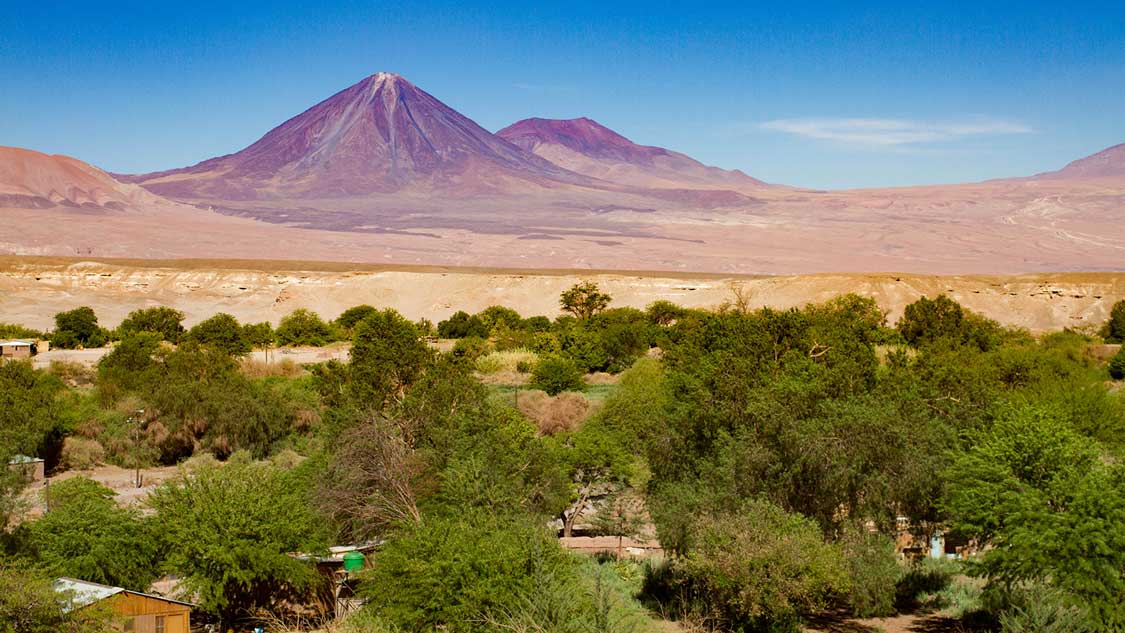
The small town of San Pedro de Atacama in the Antofagasta Region of Chile seems like an unlikely place for life-changing experiences. But a trip to this remote and desolate town in the Atacama desert reveals a wealth of hospitality and natural beauty that draws thousands of visitors year after year. In fact, explore the amazing things to do in San Pedro de Atacama was one of my favorite experiences while traveling through Chile.
With nearby experiences including the Valley of the Dead, the Moon Valley, flamingo-filled salt lakes, towering mountains topped with geothermal steam baths, and a local food scene that serves up incredible flavors that, alone, might make the journey to San Pedro de Atacama worth it, this town has a wealth of offerings.
The town is nearby to pre-Columbian ruins and alien landscapes that might make you feel as though you’re walking through a science fiction movie. And the nearby oasis nestled into the sheltered surroundings of a high plateau is something that all visitors must experience.
What To Do In San Pedro de Atacama
Table of Contents
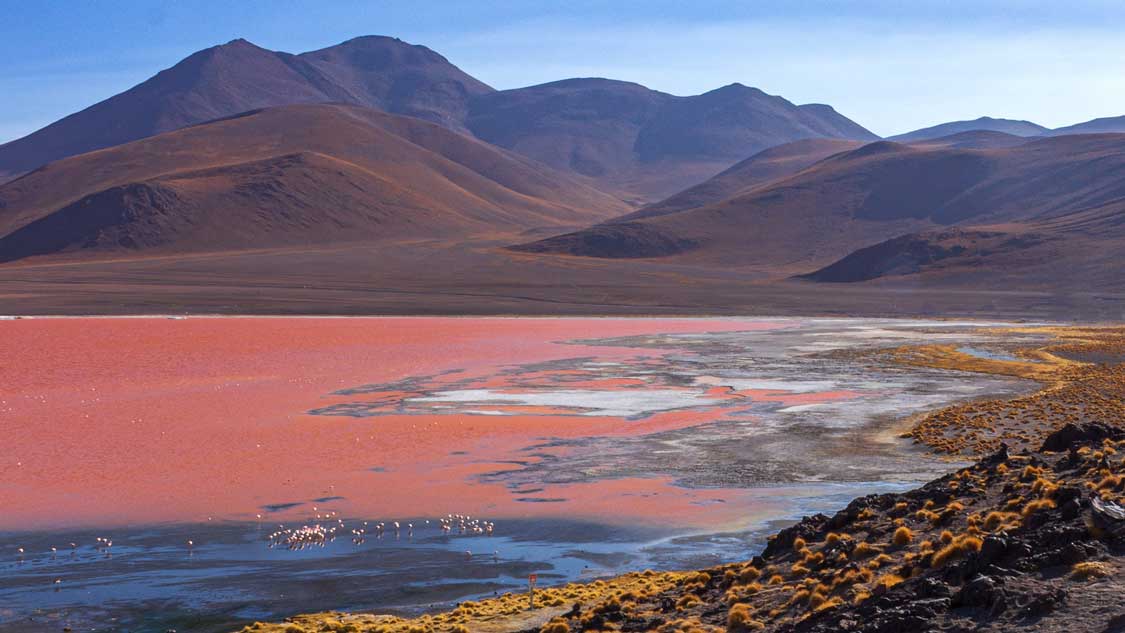
There are a LOT of questions when traveling to San Pedro de Atacama, and I promise we’ll get to those. Christina and I had an unforgettable time in the town as a side-trip from our big adventures through Santiago, Valparaiso, and ultimately on to Easter Island .
Back when Christina still had time to write for our little website, she shared her experience of being barefoot and pregnant in the Valley of the Dead . That’s right, when we traveled to San Pedro de Atacama, she was six months into the journey that would bring us our first son. So, does that mean that we traveled to San Pedro de Atacama with kids ? Well, not quite, but we still tell C that he made the journey.
It was inspiring to witness Christina tackle the epic hikes and altitudes of the Atacama desert and Altiplano plateau while pregnant. And, while it did affect her ability to enjoy some of the more intense things to do in the Atacama Desert there were some experiences that tuckered her out more than others.
Valle de la Luna (Moon Valley)
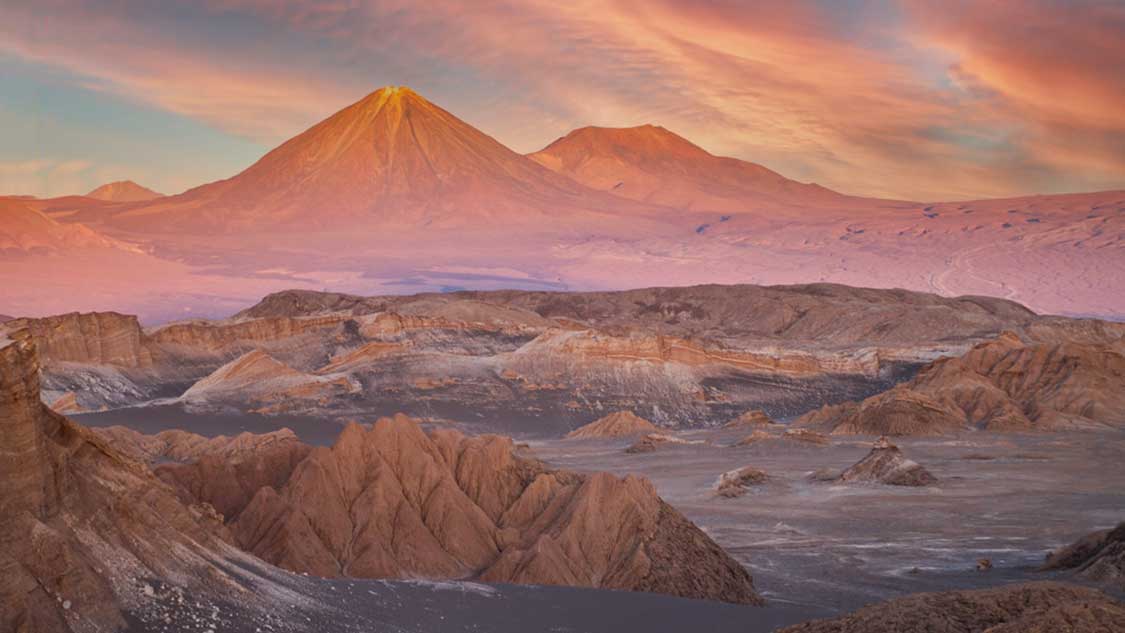
Not far from San Pedro de Atacama is the accurately-named Valle de la Luna , or “ Moon Valley ” for us anglophones. Valle de la Luna is one of the most popular places to visit in San Pedro de Atacama . This is not only due to its proximity and easy access but also because it is stunningly beautiful.
Although this is one of the most popular attractions in the Atacama Desert , don’t let that fool you into thinking about crowds. A traffic jam in the Atacama would be three vehicles within a mile of each othe r.
Some of the most popular tours of Atacama’s Moon Valley include hiking tours, c ycling tours, and road trips that take you to various parts of this beautiful place. You can also easily access the park independently by bicycle or by renting a car.
Valle de la Luna is a place where visitors are free to roam and explore . You’ll find dried-up riverbeds, sand dunes, and rock ridges that will take your breath away.
For a real treat, head to the tall dunes just outside of town (any local can point you in the right direction). It’s here that you can catch one of the most beautiful sunsets that you’ll find anywhere in the world.
You can check out the Valle de la Luna tour prices below:

Pukara de Quitor (Quito Fort)
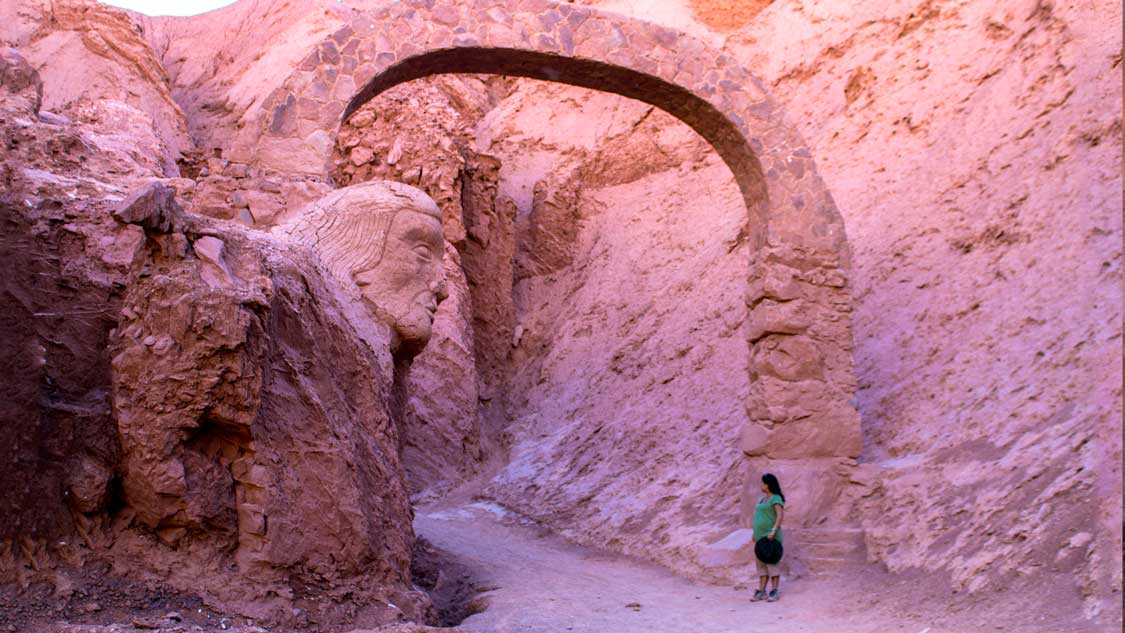
The ancient fortress of Pukara de Quitor was a site that I didn’t even know existed when I did my travel to San Pedro de Atacama. Christina and I stumbled on it while exploring some of the landscapes just a couple of miles from town. And it wasn’t until talking to some locals that we learned what we had stumbled upon.
Dating back to the 12th Century , Pukara de Quitor is one of the most incredible and ancient man-made attractions in San Pedro de Atacama . These pre-Columbian ruins are the remains of a fortress built of stacked stones and defensive walls and offer up a jaw-dropping view of the Atacama oasis.
At the time of our visit, it wasn’t open to outsiders, but that has now changed. You can reach Pukara de Quitor by heading north along the Rio San Pedro from town.
Salar de Tara
While they don’t have the same vast expanses as the salt flats in Bolivia, the Salar de Tara is still a stunning example of the earth’s changing dynamics.
These massive salt plains spread for miles in every direction. This is a magical spot filled with contrasting colors as the water seeps from the mountains and streams and collects on the plains creating beautiful reflections .
It’s large enough that you can play with the same fun depth-of-field photos that make visiting the Salar de Uyuni so famous. And it takes only a f ew hours to drive to it from San Pedro de Atacama . So, it’s relatively easy to get to as well.
Don’t be surprised to see hundreds of flamingos skimming the waters for the salt-rich brine that they love to dine on.
Tours of Salar de Tara are often combined with a few other areas of the Atacama Desert . You can check those out below:
Valle de la Muerte (Death Valley)
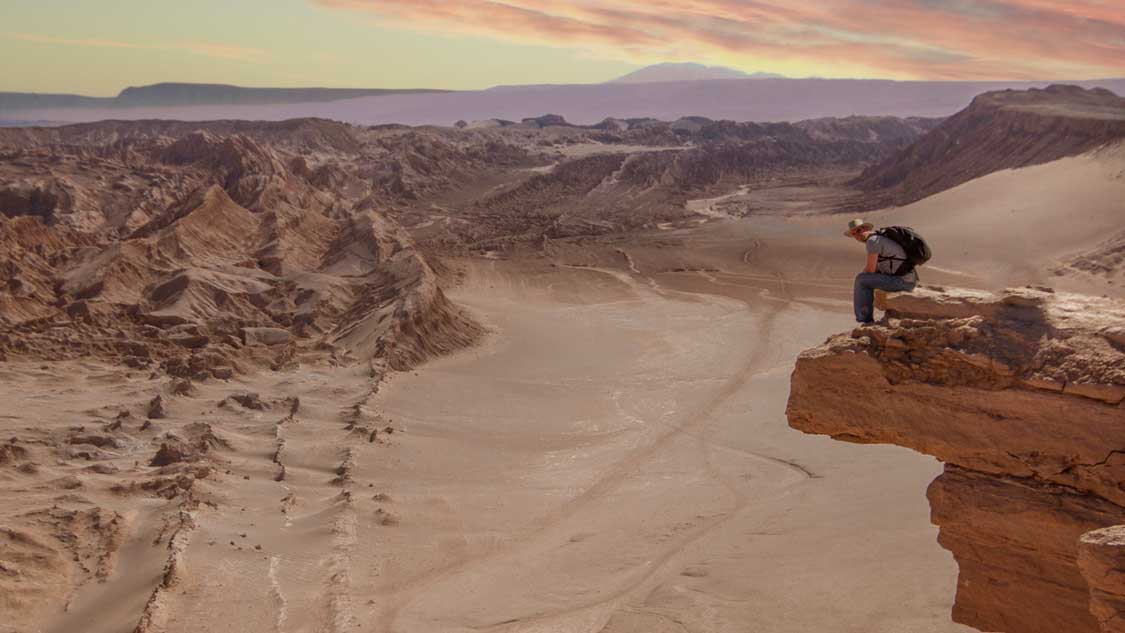
Although it shares the same name with a similar desert region in California, the ominously named Valle de la Muerte is a completely different experience. The valley is full of f laming red rocks and raw terrain that makes the story behind its name easy to understand.
Death Valley in the Atacama is located not far from the Moon Valley. And it’s easy to see why it has been the l ocation of many sci-fi movies set on Mars. Similar to other red sand destinations such as Wadi Rum in Jordan, the iron-rich sand and rock has been oxidized turning the landscape into the current gorgeous rusty-red.
The Valle de la Muerte is a popular a dventure destination for horseback riding, mountain biking, hiking, and more . You can read more about our time in the Valley of the Dead here.
Valley de la Muerta tours are often combined with Valle de la Luna tours . You can check those prices out below:
El Tatio Geysers
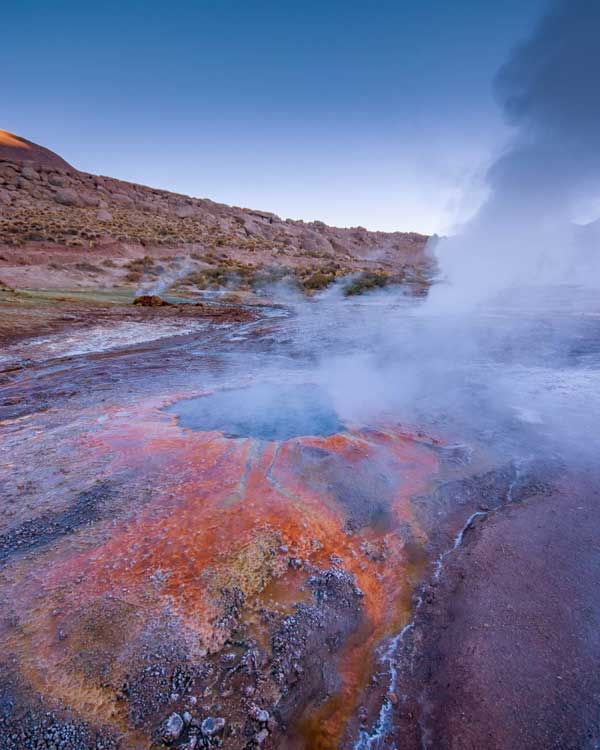
Located at a breathless altitude of 14,173 feet (4,320 meters) and requiring a winding drive up steep mountain paths has not stopped the El Tatio Geysers from becoming one of the most popular places to visit in the Atacama Desert .
I know that “alien landscapes” tend to be a trope in this guide to the Atacama Desert, but honestly, it’s true for the El Tatio geysers as well. It’s just a ridiculously wild place to be .
Most tours to the El Tatio Geysers begin very early for the slow, 55-mile (89 km) journey up the steep mountain passes. The best time to visit El Tatio is first thing in the morning when you can take in the brilliant sunrise over the mountains . This is when the hot water from the geothermal pools steams up magnificently into the air.
You can self-drive to El Tatio. But be warned that the roads up are very steep . Even many of the tour buses struggle along some of the sections. You will be stuck in traffic and you’ll want an engine with a bit of oomph to counteract the lower oxygen levels and steep inclines.
Alternatively, you can book an organized tour to El Tatio from San Pedro de Atacama and rest for the journey. You probably won’t be running on much sleep anyway as most tours begin between 3-4 o’clock in the morning .
Bring a bathing suit and a towel, as some of the geothermal pools are safe to swim in . And you won’t want to miss the experience of having a natural bath at the top of the world. You can read about our time in the El Tatio Geysers here .
Tours to the El Tatio Geysers are usually stand-alone tours . Although ambitious travelers can often add an afternoon tour in as well.
Laguna Cejar
Throughout our travels, we’ve floated on the salty waters of the Dead Sea in Jordan and lazed about in the salt ponds of the Siwa Oasis in Egypt . But, there is something so extraordinary about floating on mineral-rich salt ponds at the high-altitudes of the Atacama Desert.
The peaceful surroundings and brilliant blue waters of Laguna Cejar make for a destination that is hard to tear yourself away from. You can easily spend a few hours floating effortlessly upon the waters. Although I recommend bringing some jugs of fresh water to rinse yourself off afterward . You’ll thank me when your thighs don’t chafe.
Laguna Cejar tours are normally only offered as part of a larger, multi-day package that includes many of the best sites to see in the Atacama Desert. You can check those out below.
Lagunas Miscanti y Miniques
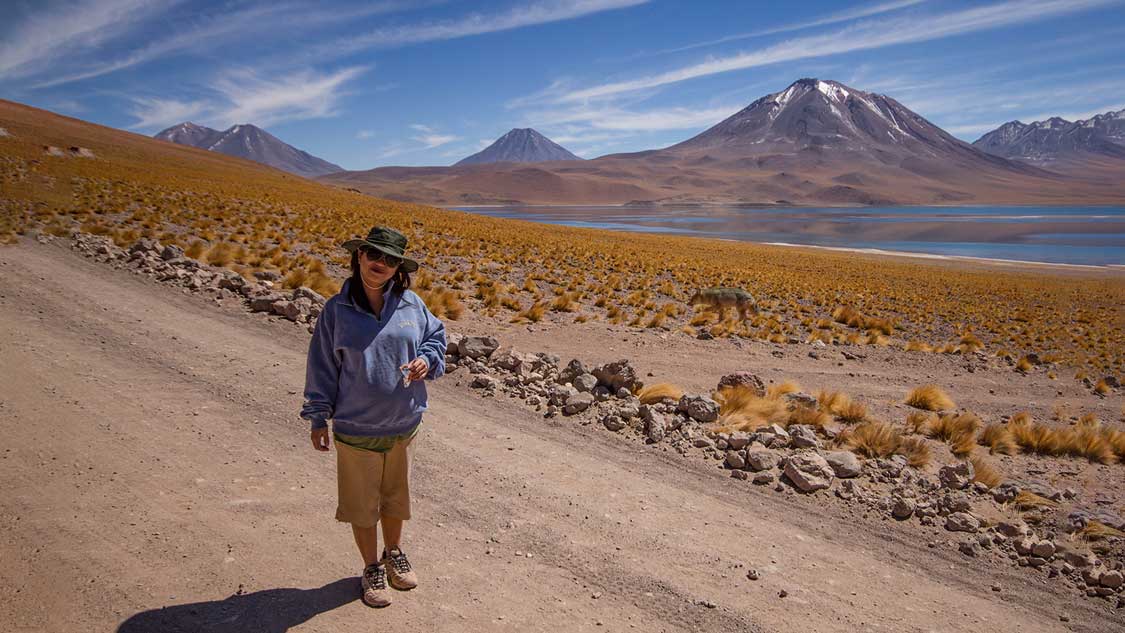
The brilliant blue waters of Lagunas Miscanti y Miniques belie the desolate surroundings of the arid Atacama landscapes. At a quick glance, everything surrounding the Lagunas Miscanti y Miniques seems dry and dead. But a closer look shows off the brilliant yellows, reds, and browns that make up the flora surrounding the waters.
This is also where Christina was followed for nearly an hour by a curious fox . We think the fox must have smelled that she was pregnant and curiously tailed us along the paths, even sitting a safe distance off while we rested for a while near the parking lot.
It’s worth the drive out to Lagunas Miscanti y Miniques for the brilliant colors and views of the lagoon. And if you see the fox, make sure to say hi for us.
Lagunas Miscanti y Miniques is typically combined with a full-day tour from San Pedro de Atacama that covers many of the Atacama places to visit. You can check the prices out below:
Piedras Rojas (Red Rocks)
This popular Atacama attraction, about 100 miles (160 km) from San Pedro de Atacama towards the border with Argentina , can be a bit of a confusing drive . But there are plenty of Piedras Rojas tours due to the popularity of the experience. These tours usually include Laguna Chaxa as well as the towns of Socaire and Toconao .
The rocks here are a brilliant shade of red and the surrounding landscapes offer dramatic contrasts of yellows and browns combined with the brilliant blues of the high-altitude skies that make Piedras de Rojas a marvelous sight to behold.
The site sits at 13,123 feet (4,000 meters) above sea level . And the region is ringed with snow-capped volcanoes . If that alone doesn’t make the journey worth it for you, visiting the friendly desert towns along the way sure will.
Piedras Rojas tours are usually combined with a full-day tour from San Pedro de Atacama . You can check out the prices below.
Termas de Puritama and the Valle de Jere
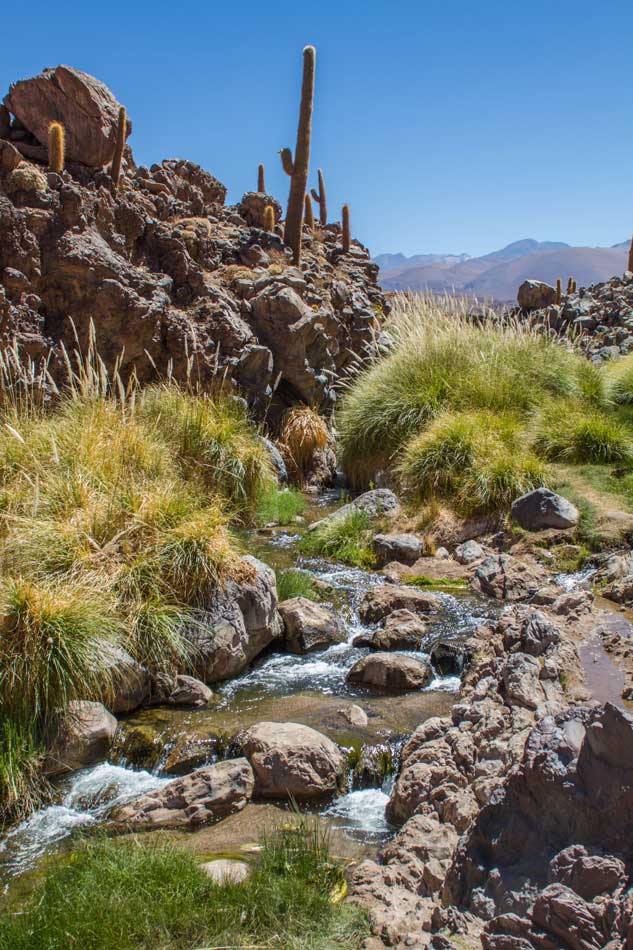
The eight connected geothermal pools that make up the Termas de Puritama were one of our favorite parts of exploring the Atacama Desert in San Pedro de Atacama.
The flowing stream that connects the pools and waterfalls is a popular spot on the tours that explore the salt flats and mountain villages. They have been used for centuries by the Atacama people due to their comfort, beauty, and healing properties of the mineral-rich water.
You can easily spend the whole day relaxing in the warm waters and bathing in the beautiful mountain surroundings.
Tours to Termas Puritanas and Valle de Jerre can be combined with full-day Atacama tours or done as a stand-alone tour that includes nearby villages.
ALMA Observatory
With the perfect combination of high altitude, remote location, and brilliant dark skies, the Atacama Desert is one of the best places in the world for stargazing .
Because of this amazing combination of factors, astronomists have built one of the world’s leading observatories in the Atacama desert . The ALMA Observatory works in harmony with other observatories such as the ones on Mauna Kea on Hawaii’s Big Island and Haleakala on Maui to help scientists paint ever-more accurate pictures of the Universe that surrounds us.
There are few places on Earth where you can see as many stars with the naked eye as you can in the Atacama . The ALMA Observatory is the largest and most powerful observatory that is open to the public .
The guided tours will give you a glimpse into the life and science behind the observatory. And, of course, a glimpse into the universe as well.
Observatory tours are o ften paired with night sky viewing and astromony tours in San Pedro de Atacama . You can check out the prices below.
Town of Tocanao
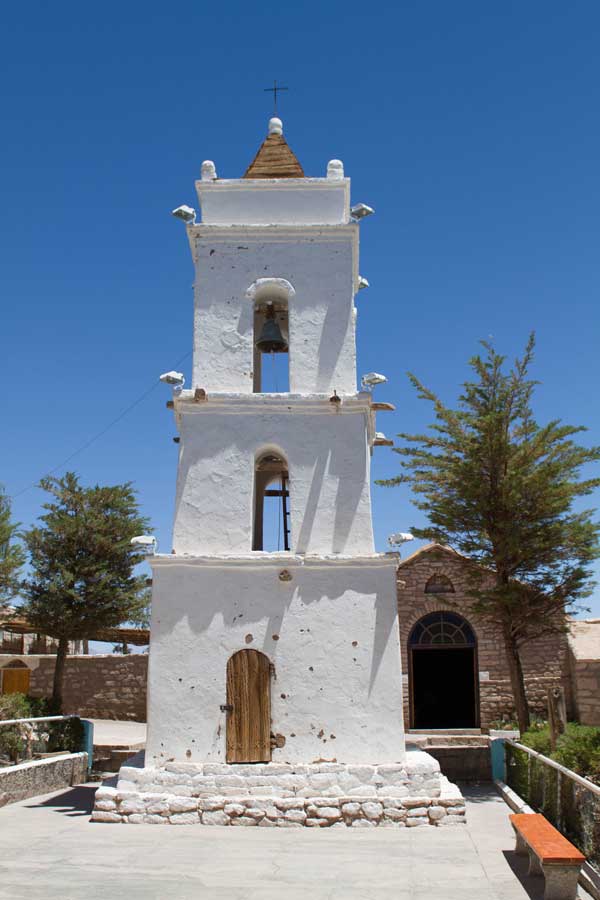
Located just 24 miles (38 km) south of San Pedro de Atacama is the quaint town of Toconao . This quiet village is a prime example of the mud and brick architecture that has been a staple here for centuries.
In the center of town is a tall church bell tower that dates back to 1750 . You’ll also find delicious homemade local food and snack stands alongside rustic washrooms that are a welcome sight after long days in the desert.
A visit to Toconao is often paired with a tour of the Atacama salt flats . You can check those prices below.
Laguna Chaxa
The salty waters of Laguna Chaxa are one of the best places in the Atacama to see massive flocks of pink flamingos . In fact, there are three different species of flamingo that spend much of the warmer months wading and feeding in the massive salt lake that glitters under the blue skies.
Flat footpaths meander through the rocky salt fields and mirror-like ponds that make up Laguna Chaxa. It’s especially beautiful at sunset when the colors bounce off the clear waters.
Tours of Laguna Chaxa are often combined with a visit to the salt flats and Pedra Rojas. You can check those prices below.
Explore The Town of San Pedro de Atacama
You can’t experience the best things to do in San Pedro de Atacama without talking about the town itself. This charming village in the remote desert is a wonderful place to be.
The mud and brick buildings and dusty dirt roads harken back to a simpler time . Walking around San Pedro de Atacama may make you think that you’ve hopped into a Delorean and time traveled a few centuries into the past .
The streets are lined with vendors selling handmade trinkets and clothing. And it’s not rare to see a herd of sheep wander down the road . Modern services such as WiFi and electricity can be scarce in the town. Most of the accommodations have them, but it’s not rare for restaurants and shops to be lit by candles.
In the town, you can rent cars and bicycles to explore. Or just wander the shops and restaurants and enjoy the slow pace of life.
Where To Stay In San Pedro de Atacama
San Pedro de Atacama isn’t a place you’ll want to travel for a day trip . It’s remote and beautiful. And you’ll want to spend at least a few days exploring all the things to do in the Atacama desert.
Luckily, there are some great places to stay in San Pedro de Atacama for all price ranges and comfort levels. You’ll find budget hostels to mid-range guesthouses and even luxury resorts .
San Pedro de Atacama Airbnb and VRBOs
Without a doubt short term (or long-term) rentals are among the best ways to experience life in San Pedro de Atacama . Chances are that you will be spending at least a few days exploring the Atacama Desert, and a rental will give you the flexibility to explore at your leisure .
Here are a couple of gems that we love.
Charming Dome With a Treehouse Feel
Just a 10-minute walk from San Pedro de Atacama town center , this funky two-story dome surrounded by native trees offers a unique stay for those looking for something funky . The kitchen has everything that you need to make yourself at home and you’ll have a mple access to hot water and WiFi . You’ll even have shared access to bikes, hammocks, bbq, and a washing machine .
The two-story dome-style accommodation stands out from many of the other places to stay in San Pedro de Atacama due to its unique architectural style.
You can find the latest prices and availability below.

El Otro Huertillo
This new cabin is situated in a charming garden just a 1 5-minute stroll from town . The cabin can comfortably house 3 people in 1 Queen and 1 Twin bed . It includes a fully-equipped kitchen, hot water, electricity, and WiFi . Please note that there is an additional charge of $25 for a 3rd guest.

Best Hotels in San Pedro de Atacama
This might be a small town, but if you’re looking for some beautiful San Pedro de Atacama hotels , you’re in luck! The remote location hasn’t deterred locals and businesses from setting up shop here to create some true accommodation gems . Here are a few of our favorites.
Tierra Atacama Hotel & Spa
If you’re looking for luxury accommodations in San Pedro de Atacama , Tierra Atacama Hotels should make your list.
This gorgeous property has a s wimming pool, spa, and on-site restaurant in case you’re too tired from exploring the Atacama all day to make the short trip into town. You’ll also have access to WiFi, hot water, air conditioning, and electricity .
All of the rooms also have private patios and four-poster beds to add additional luxury to your stay. Plus, you’ll have access to a continental breakfast of traditional and Chilean food .
You can check the rates and availability below.

Hotel Desertica
With free bike rentals, WiFi, electricity, hot water, and a superb central location , Hotel Desertica checks off all of the boxes for great places to stay in San Pedro de Atacama. But these basics are just the start.
Hotel Desertica is located just a quarter-mile (400m) from the San Pedro Church right in town. So you’ll have easy access to restaurants, shops, and car rentals. Each of the unique rooms features private bathrooms, toiletries, and access to an a la carte and buffet-style breakfast .
You’ll also have access to an outdoor pool, garden, and lovely walking paths . It’s no surprise as to why this is one of the most popular San Pedro de Atacama hotels .
You can check out the prices and availability below.
Tips For Visiting San Pedro De Atacama
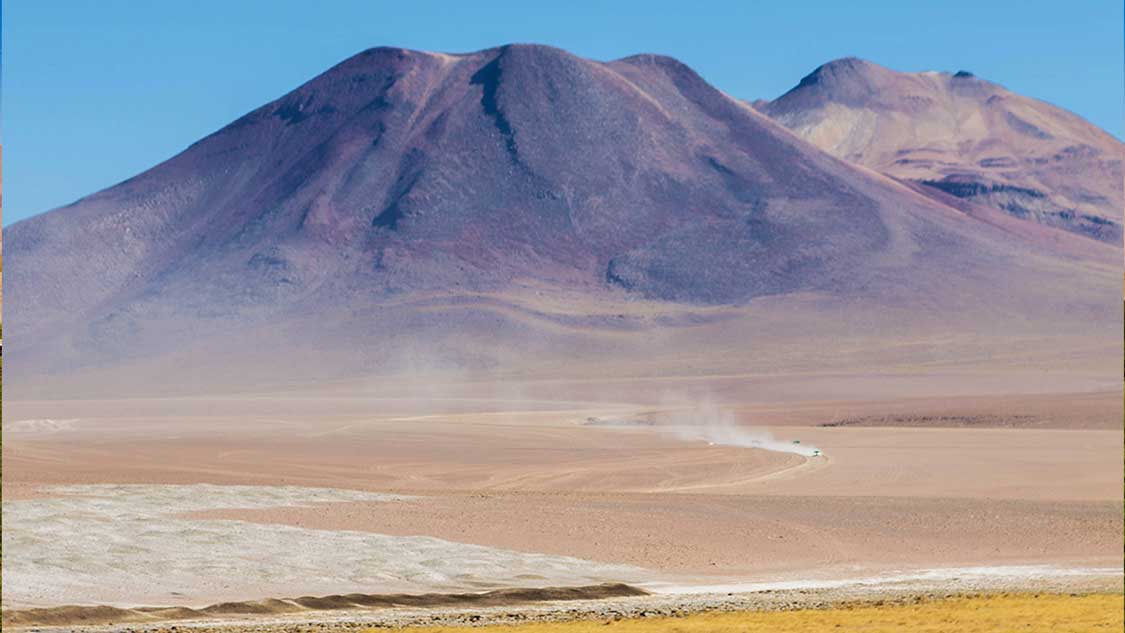
Visiting San Pedro de Atacama with Kids
San Pedro de Atacama and the Atacama Desert are lovely places to visit with children . It’s quite remote and raw, so it can often scare off adults who aren’t comfortable with these types of destinations. But those who travel with kids to the Atacama Desert usually love their experience. However, there are a few things to know before you go.
- Whenever you’re dealing with kids and elevation, be prepared. Kids aren’t always great at understanding the signs of altitude sickness . If they get queasy, lightheaded, or lethargic, head down to lower altitudes immediately.
- Some tours may not accept children due to safety or insurance issues. Some of these places, such as Valle de la Muerte aren’t dangerous by our standards, but tour companies have to work within their own rules. Consider renting a car and doing a self-drive for these experiences.
- You will not have cell reception in most areas of the Atacama . And when you do, don’t expect it to be consistent.
- If you’ll be making your own food at your hotel or accommodation, consider buying groceries in Calama . There are not many options in San Pedro de Atacama itself.
How Do You Get From Santiago To San Pedro de Atacama?
Getting to Santiago from San Pedro de Atacama or vice-versa can be a challenging experience. San Pedro de Atacama is remote and transit can be complicated. But, if you do it right, traveling from Santiago to San Pedro de Atacama doesn’t need to be stressful.
Flying to San Pedro de Atacama
The distance between the Santiago and San Pedro de Atacama is 1,000 miles (1,629 km) . And the fastest way to travel between Santiago and San Pedro de Atacama is by plane from Santiago to the city of Calama . From there, there is a shuttle bus that can take you to San Pedro de Atacama for a fee. You can also hire a private transfer, get a taxi, or rent a car .
Driving to San Pedro de Atacama
If you choose to drive to San Pedro de Atacama from Santiago , you’re looking at a drive time of about 17-18 hours without breaks . But, driving to San Pedro de Atacama from Santiago allows you to take in popular attractions such as Capiapo, Bahia Inglesa, and Antofagasta .
Route 5 , which is what you’ll take for the majority of the trip is a well-maintained road and you won’t have to deal with too many complications until you reach the stretch from Calama to San Pedro de Atacama.
As you’re driving through the desert, remember that the shoulders, especially around the Valle de la Luna, can be VERY soft . I pulled over to take a photo and ended up spending two hours digging my truck out of the sand while my poor, very pregnant wife reminded me that I had been told many times to not pull onto the shoulder ( always listen to locals ).
Luckily, we were saved by some locals who were able to tow us out at the cost of one tow strap and a little bit of sweat.
Bus to San Pedro de Atacama
Busses in South America are on a level that we just won’t appreciate when coming from North America. We learned this on our 9-hour bus ride from Cusco to Puno, Peru .
T hey take the same route as most cars , but you’ll have on-board snacks and drinks, access to washrooms , and of course, air-conditioning. For a long drive like this, I recommend s pending a few extra pesos for the salon-cama, or lounge bed . These are nearly lay-flat seats that will let you doze away comfortably.
How Many Days Should You Spend in San Pedro de Atacama?
To make the most of your visit to San Pedro de Atacama and the Atacama desert, you’ll want to spend at least four days exploring . But, i f you can stretch your visit to a week , you’ll be able to experience all of these things to do in the Atacama Desert at a much more relaxed pace.
How do you get around San Pedro de Atacama?
Getting around San Pedro de Atacama is a breeze. Walking, biking and driving are the main ways to explore . The town itself is tiny and walking anywhere in town rarely takes more than 10-15 minutes.
Cycling is one of the most popular ways to get around. You’ll find San Pedro de Atacama bicycle rentals all over town . And having a bike handy will make exploring the Moon Valley and Death Valley much more efficient.
Renting a car allows you to do a DIY San Pedro de Atacama adventure . You won’t need it in town, but getting to the El Tatio Geysers, or Valle de la Muerte will be much more convenient and less expensive than booking a tour.
Can you drink tap water in San Pedro de Atacama?
Unless you have spent a significant amount of time in rural Chile, I’d recommend avoiding tap water . In the north, heavy mining has led to some arsenic and heavy metals leaching into the water. And then there is the fact that sometimes, stomachs just don’t adapt well to water in other countries. It might not be bad, but your stomach might not agree.
But, if you bring one of these filtered water bottles , you can take advantage of the tap water or even fresh stream or lake water (not saltwater though) and have fresh clean water wherever you travel. We never leave home without ours.
What Is The Altitude of San Pedro de Atacama?
San Pedro de Atacama sits at an altitude of 7,900 ft (2,408 m). The Andes Mountains, which winds through the Atacama Desert reach heights of well over 13,000 ft (4,000 m), with some towering heights of 20,000 ft (6,000 m).
What Is The Best Time To Visit the Atacama Desert?
Summer is the high season in the Atacama Desert . From December to February you’ll find the most pleasant temperatures and warm nights that make stargazing and nighttime hikes a popular experience. The t emperatures during the summer months can hit highs of 81°F (27°C) during the day and 61°F (16°C) at night .
The low season in the Atacama is during the winter from June-August . You’ll generally find lower-cost accommodations . However, access to some of the more remote experiences might be cut off due to winter storms. Temperatures during this time can reach highs of 72°F (22°C) during the day and lows can reach 28°F (-2°C) at night .
Shoulder season covers the other parts of the calendar. Spring shoulder season is from September to November while Fall shoulder season runs from March till May . These are excellent times to visit as the prices are generally lower and the crowds much less busy, but you’ll still get relatively comfortable temperatures.
Have You Ever Visited San Pedro de Atacama or the Atacama Desert?
If you love wild, natural landscapes and quaint towns like us, you will absolutely be in heaven in San Pedro de Atacama. If you’ve been to this magical place, drop a comment below and tell us about your experience. Or, if you love to travel with kids, head over to our Family Travel Facebook Community and share your tips. We would love to hear your ideas.
You May Also Like To Read:
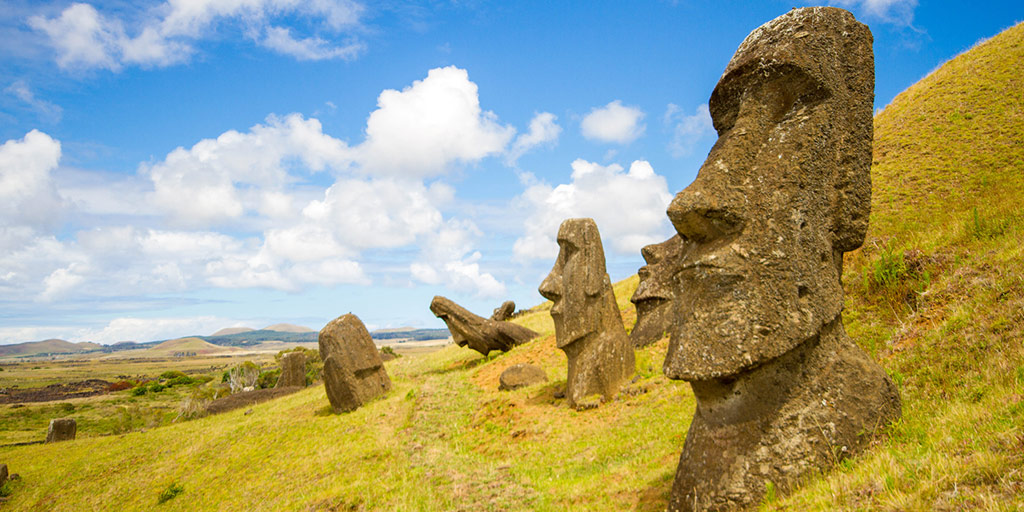
Pin This Post For Later:
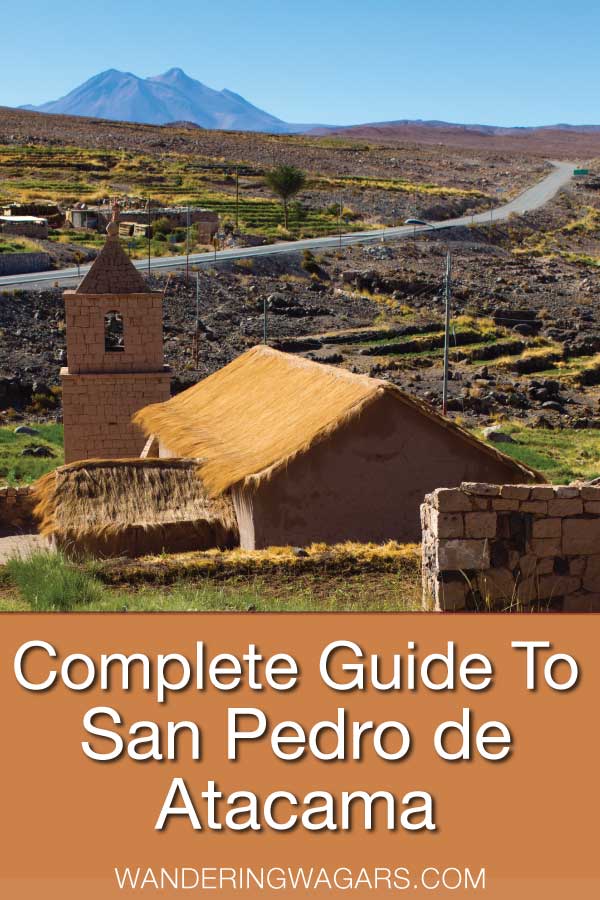
Privacy Overview
Plan your perfect visit to San Pedro de Atacama
Popular travel plans
Featured activities
Valle de Jere
The streams flowing through the Valle de Jere create an unusual oasis, where the people of Toconao cultivate crops including peaches, plums, and pomegranates. Take a hike up the gorge to see it all!
Quebrada Guatin
Quebrada Guatin offers a trek of about 5.5 km (with a more challenging option of up to 19 km), where hikers can see centuries-old cactus that grow in the gorge.
Lagunas Escondidas de Baltinache
Visitors can take a dip in the crystal clear turquoise waters of these hidden lagoons, located in the desert between San Pedro and Calama. The water in the lagoons is high in minerals, especially salt, which means that you float!
¿Eres operador de tur?
Lagunas Altiplánicas
Piedras Rojas
Volcán Licancabur
Garganta del Diablo
Petroglyphs
Volcán Láscar
- How to get to San Pedro de Atacama?
- What are the best activities in San Pedro de Atacama
- Where to eat in San Pedro de Atacama?
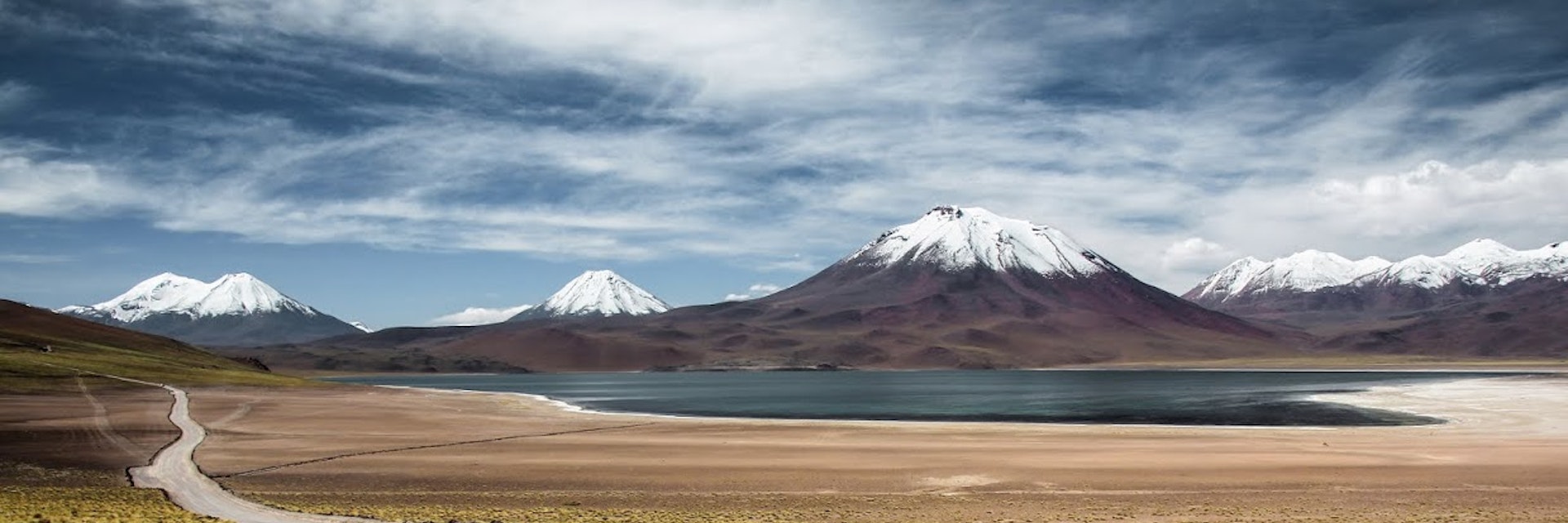
San Pedro de Atacama
It is said that the high quantities of quartz and copper in the region gives its people positive energy, and the good vibes of northern Chile's number-one tourist draw, San Pedro de Atacama, are sky high.
Attractions
Must-see attractions.

Iglesia San Pedro
The recently restored Iglesia San Pedro is a delightful little colonial church built with indigenous or artisanal materials: chunky adobe walls and roof,…
Plan with a local
Experience the real Chile
Let a local expert craft your dream trip.
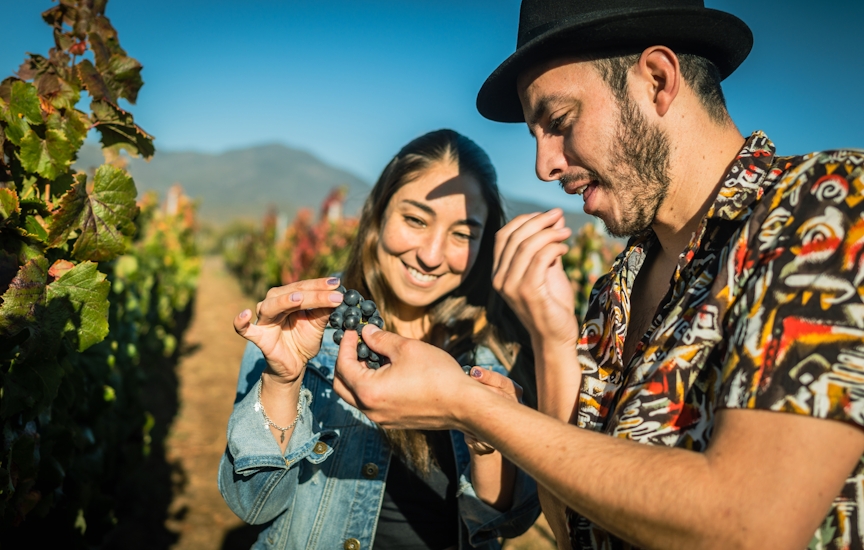
Latest stories from San Pedro de Atacama
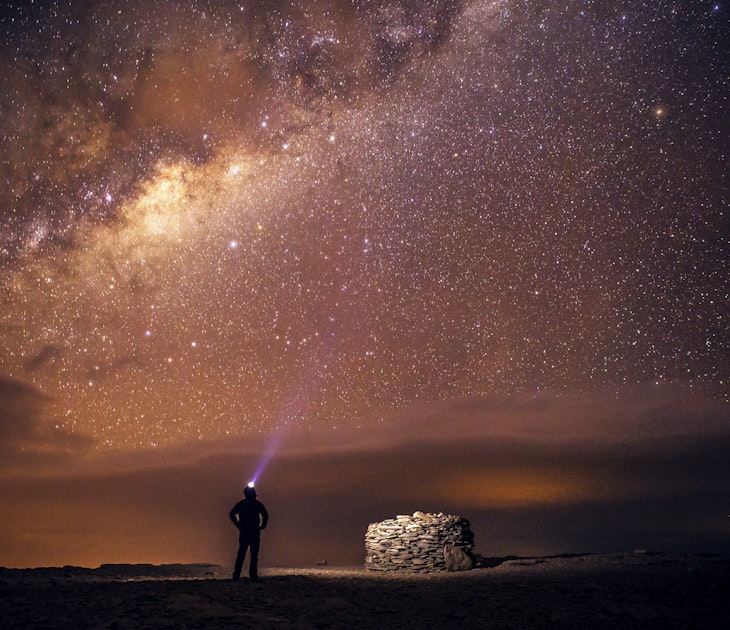
Astrotourism
Jan 8, 2022 • 6 min read
Make the most of your stargazing trip to Chile’s Atacama Desert with these top tips.
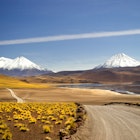
Jan 5, 2022 • 6 min read
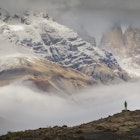
Oct 31, 2017 • 12 min read
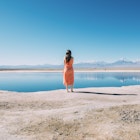
Jul 3, 2017 • 5 min read
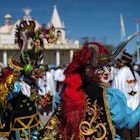
Oct 14, 2014 • 5 min read
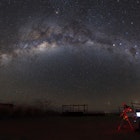
Sep 30, 2014 • 3 min read
in partnership with getyourguide
Book popular activities in San Pedro de Atacama
Purchase our award-winning guidebooks.
Get to the heart of San Pedro de Atacama with one of our in-depth, award-winning guidebooks, covering maps, itineraries, and expert guidance.
- +56 2 2570 8620
- Contact us!
San Pedro de Atacama

Where to go
Recommendations, where and what to eat.
San Pedro de Atacama, also known as "The archaeological capital of Chile" is a small town full of history and color that is located in one of the oasis' of the Chilean Highlands in the 2nd Region.
It is famous for its attractive landscapes, among which we find some of the highest summits of the Andes Mountains, like the Licancàbur volcano (5290 meters high), Làscar volcano (5592 meters high) and Cerro Quimal (4270 meters high), as well as the famous Valle de la Luna (Valley of the Moon), surrounded by high dunes and rock formations shaped from the desert winds.
Apart from its amazing views, San Pedro de Atacama is the birthplace of the civilization of Atacama, which established its settlement in the highland regions and desert cliffs. You can find traces of this town in (pukarás) and villages that surround the area.
It has all the necessary services and it is one of the most preferred places for foreign tourists, who provide an international and cosmopolitan feeling to the streets of San Pedro.
Map de San Pedro de Atacama
San Pedro de Atacama was the birthplace of the Atacama people, creators of the Culture of San Pedro which was developed in the area over 11,000 years ago. This village is spread across the Highlands and Atacama Desert, establishing itself especially in the oasis like San Pedro.
In this territory the agriculture was developed, making crops with a terrace system on the slopes of the mountains, fertilizing the soil with Llama guano. They harvested quinoa, figs, pumpkins, corn, cotton, beans and potatoes, among other vegetables. They also devoted themselves to livestock, domesticating alpacas and llamas, from which they obtained milk and meat, as well as means of transportation.
Another particular feature was the development of painted pottery, basketry, weaving, wood carving and works with bronze and copper.
When the Inca Empire came to their land, they adopted their customs and pukaras were constructed, which are great walls around the city, as a form of protection, as well as sun worshipping.
In 1963 The Archaeological Museum of San Pedro de Atacama was inaugurated, with a collection of objects that they managed to collect from the Atacama people, including ceramics, textiles, metals, and even mummies.
San Pedro de Atacama is famous for a great number of places that you can visit to see the surroundings, culture or enjoy the landscapes of this oasis in the desert.
Valle de la Luna: (Valley of the Sun)
This Sanctuary of Nature is located 13 kilometers west of San Pedro de Atacama and is part of the Reserva Nacional Los Flamencos (National Flamingo Reserve).
It forms in a depression surrounding the Orbate sierra, which is part of the Cordillera de la Sal. It was produced by erosion from wind and water that over thousands of years has molded its soils and forests with interesting shapes like spikes, craters, mounds and hollows, which gives it the resemblence of a lunar landscape.
Some of the most famous formations of the Valle de la Luna (Valley of the Moon) are the Tres Marias, the Amphitheatre, the Gran Duna (Great Dune) and the Cavernas de Sal (Salt Caverns), among others.
It is located at 2500 meters above sea level, it has a desert climate with great temperature difference between day and night, and so, warm clothing is recommended if the tour extends beyond the sunset.
In the geography of these unique landscapes, activities such as hiking, horse riding and cycling are performed, among others.
Valle de la Muerte: (Death Valley)
It is located in the Cordillera de la Sal and has huge sand mountains, where sand boarding and trekking are practiced.
Besides this, it allows you to observe strange stone shapes, shaped by the desert wind erosion over thousands of years.
Salar de Atacama: (Salt Flats of Atacama)
It is located at 2305 meters above sea level, 55 kilometers north of San Pedro de Atacama. It is the third largest salt flat in the world, with more than 3000 km2.
Inside you will find the Chaxa lagoon, habitat of various species of water birds like flamingos, Andean seagulls, harriers and (parinas), among others. In its surroundings you can also find animals like the red fox, the tuco tuco rat and other species of reptiles of the area.
Géiseres del Tatio: (Tatio Geysers)
It corresponds to the highest geomagnetic field in the world, located at an altitude of 4200 meters, with 80 geysers where water boils at a temperature of 86° C and lets off fumeroles of over 70 centimeters.
The ideal time to observe them is during the morning between 6 A.M. and 7 A.M. which is the time that the highest number of fumarolic activity occurs. Also, it allows you to observe the large quantity of wildlife inhabiting this territory such as rheas, (vicuñas) and (vizcachas), among others.
Together with the Tatio Geysers, you can enjoy hot springs directly in nature, allowing you to submerge into the pleasant pools and recover from the cold environment. It is therefore recommended to do this tour with proper warm clothing, good hydration and to not eat too much in order to avoid the symptoms of altitude.
Termas de Puritama: (Puritama Springs)
These hot spring pools are found surrounded by mountains with beautiful natural scenery. They are located just 28 kilometers from San Pedro de Atacama and the water temperature does not exceed 33° C.
They feature comfortable wooden walkways to travel and observe the surrounding vegetation.
This small town is located northeast of the Salar de Atacama (Salt Flat of Atacama) and it's an oasis that provides pure water and all kinds of fruit crops, which stand out for their high content of ascorbic acid (vitamin C), because of the close presence of minerals of the flats.
Among its attractions we find the national monuments Iglesia y Campanario de San Lucas (the Church and Bell Tower of St. Lucas), which were built in the eighteenth century.
Its buildings are all of stone liparite, which maintains its buildings at good inside temperature and as well as the making of crafts carved from volcanic stones.
Ruinas de Tulor: (Tulor Ruins)
These correspond to the concentric ruins of an ancient town of Atacama of over 3000 years that was found buried in the desert sands.
Pukará de Quitor:
It is found 3 kilometers away from San Pedro de Atacama, on the Cerro de Quitor (Quitor Hill). It is a fort built by the ancient inhabitants in the twelfth century, and reused by the Incas following their occupancy. It was used as a fortress to defend themselves from other towns.
Lagunas Altiplánicas: (Highland Lagoons)
The altiplanic lagoons of Miscanti and Miñiques are located more than 4000 meters above sea level. They provide wonderful colors reflecting the sky of the highlands. They are located on the edge of the Salar de Atacama (Salt Flats of Atacama), about 6 hours away from San Pedro de Atacama.
Museo Arqueológico Padre Gustavo Le Paige: (Archeological Museum Padre Gustavo Le Paige)
This museum contains the collection of the Jesuit Belgian priest who after years of studies managed to get a sample of objects showing the evolution and development of the life of the Atacama towns during its 11 thousand years of development.
In San Pedro de Atacama the first thing you should do is take a walk around town, where you can see some landmarks such as the Archaeological Museum Padre Le Paige, the Church of San Pedro, the Municipality and Caracoles street, areas in which you can find the highest commerce and craft fair, with products made from local materials such as llama wool, stone carvings, cactus, leather, among others.
After, you can tour around the area by foot or by renting a bicycle. Some nearby places are Pukará Quitor (3 kilometers north) where in addition to appreciating the ancient ruins you can see the Lincancabur volcano and some caverns.
Also, another part of the tourist circuit of San Pedro de Atacama is the Valle de la Luna (Valley of the Moon) and Valle de la Muerte (Death Valley), which can be travelled by trekking, biking or horseback riding. To enjoy the beauty of the desert landscape, especially when the moon comes out, we recommend visiting both places near dusk and take beautiful pictures of the sunset from the dunes.
Another unforgettable trip is to see the Salar de Atacama (Salt Flats of Atacama), part of the Los Flamencos National Reserve. Inside you will find the Chaxa lagoon, an ecosystem of Andean birds, such as flamingos and various kinds of flamingos (parinas), among others.
Within the Salar de Atacama (Salt Flat Atacama), we find the Cejar lagoon, of emerald waters and high salt concentration, allowing a pleasant floating sensation when you submerge in it. You should always wear sandals when entering these waters because of the rocky terrain in the bottom of the lagoon and never open your eyes under water.
After going in the Cejar lagoon, it is possible to remove excess salt by bathing in the Ojos del Salar, two freshwater springs that are found near the lagoon, known as Tebinquinche.
In the northern zone of the Salar de Atacama (Salt Flats of Atacama), we also find la Aldea deTulor, an ancient village built in the years 100 and 300 AD, formed by circular houses that were buried under the desert sand and are now administered by the Atacama community of Ayllu de Coyo, featuring exhibition rooms and interpretation to learn about the flora, fauna and history of the place.
You can also visit the Salar de Tara (Salt Flat of Tara), located towards the border with Argentina, taking the road “Paso Internacional Jama”, within Los Flamencos National Reserve. It provides an impressive spectacle of salt flats, rock formations called "cathedrals", lagoons and rivers, along with a vast diversity of native fauna, migratory birds, llamas and (vicuñas).
One of the most important attractions of San Pedro de Atacama, is to see the Géiseres del Tatio (Tatio Geysers), located more than 4300 meters above sea level, making it the highest geothermal field in the world.
Here you can see the impressive hot water fumaroles and hot steams that can reach 7 meters high and are released by geysers especially in the morning. That is why for this tour you must start at 4 in the morning from the village, where they begin the 90 km climb to the geothermal field. During the trip you can see all kinds of native fauna such as llamas, foxes, rheas and local flora.
The Geysers complex, known as Tatio Mallku, is administered by the indigenous communities of Toconce and Caspana and an entrance fee must be paid. While in this place, it is recommended to bring plenty of warm clothing, walking only on the marked trails and at a slow pace in order to avoid discomfort caused by the altitude.
Another recommendation is to eat light, drink lots of water, get proper rest and take chachacoma infusions (teas), a medicinal herb that is obtained in San Pedro de Atacama, which is drunk to help you get accustomed to the cold and altitude.
Here also you can find thermal pool of Tatio, where visitors who dare to challenge the cold environment will be able to experience a nice bath.
Upon returning from a visit to the geysers, you can visit the village of Machuca, where ancient traditions of the Atacama people such as grazing and agriculture are still conserved. In the surrounding area you can see a swamp (wetland), which is characterized by its huge giant cactus and a habitat for water birds such as Andean seagulls, flamingos, and ducks, among others.
In addition to Machuca, some walking tours allow people to explore the towns of Lasana Chiuchiu and Caspana, which include museums, old buildings, churches and traditions of the people of Atacama.
At the end of the trip, nearly 50 kilometers from San Pedro, we find the Termas de Puritama (Puritama Springs), a nice place to relax in the warm healing waters of its eight natural pools that are connected by wooden walkways to facilitate movement. The water temperature does not exceed 33° C and both have healing and rejuvenation properties.
There are plenty of exchange offices in San Pedro de Atacama where you can exchange dollars and euros into Chilean pesos.
It is recommended to review the indicators for exchange rates and then choose the place where the exchange is most convenient.
Transportation:
To get to San Pedro de Atacama, you have to take a flight to El Loa de Calama airport and from there travel the 100 kilometers (90 minute drive) that separate the town by bus, public or private transportation.
You can also get to San Pedro de Atacama by bus from Santiago. The trip lasts 20 hours and covers more than 1600 kilometers.
In San Pedro de Atacama it is possible to rent a car to tour the area and also use public transportation, rent bicycles and walking.
Communications
Chile's international code is 56 and the code of San Pedro de Atacama is 55. To call from abroad you must dial the country code, city code, plus55, and the telephone number.
In San Pedro de Atacama the ancient traditions of the Atacama food are used, corn and wheat being the base of the kitchen, which were grown in different varieties in the area, as well as llama meat. The typical dishes are plentiful, spicy and high in protein.
Some of the most famous are the patasca, el locro de trigo (wheat soup), frangollo, carbonada and humitas, most of them made with corn and wheat. Bread is also prepared with flour, wheat or corn and cheese from sheep and cows (vacuno).
Among the most traditional drinks is the corn chicha and (aloja), and chicha of algarrobo.
In addition to these traditional foods, there are several restaurants that have joined the old recipes with new flavors, with preparations as chorrillana, a popular Chilean dish prepared with potatoes, eggs, fried onions and meat in San Pedro de Atacama.
There are also "picadas" or lower-priced restaurants where you can enjoy home cooking and taste the native flavors of the area.
Recommended Tour in San Pedro de Atacama

Why book with us?
Best price without complications, best quality guaranteed, passenger service available 24/7, tours and experiences selected by experts, industry leader, 18 years of experience, tulor village, hornito beach, puritama hotsprings, antofagasta city, salt mountain rage, lluta geoglyphs, tatio geysers, parinacota church, putre church, socaire church, san pedro de atacama church, chaxa lagoon, tara lagoon, miscanti and miñiques lagoons, chuquicamata coppermine, portada natural monument, calama archaeological museum, gustavo le paige museum, paranal hill observatory, nevado tres cruces national park, pan de azucar national park, isluga volcano national park, cavancha beach, chinchorro beach, rinconada beach, puerto viejo beach, lasana pucara, quitor pucara, san lorenzo pucara, vicuña national reserve, los flamencos national reserve, atacama salt, maricunga salt, mamiña hotsprings, moon valley, licancabur volcano.
SUSTAINABLE ADVENTURES AND BUDGET-FRIENDLY TRAVEL TIPS
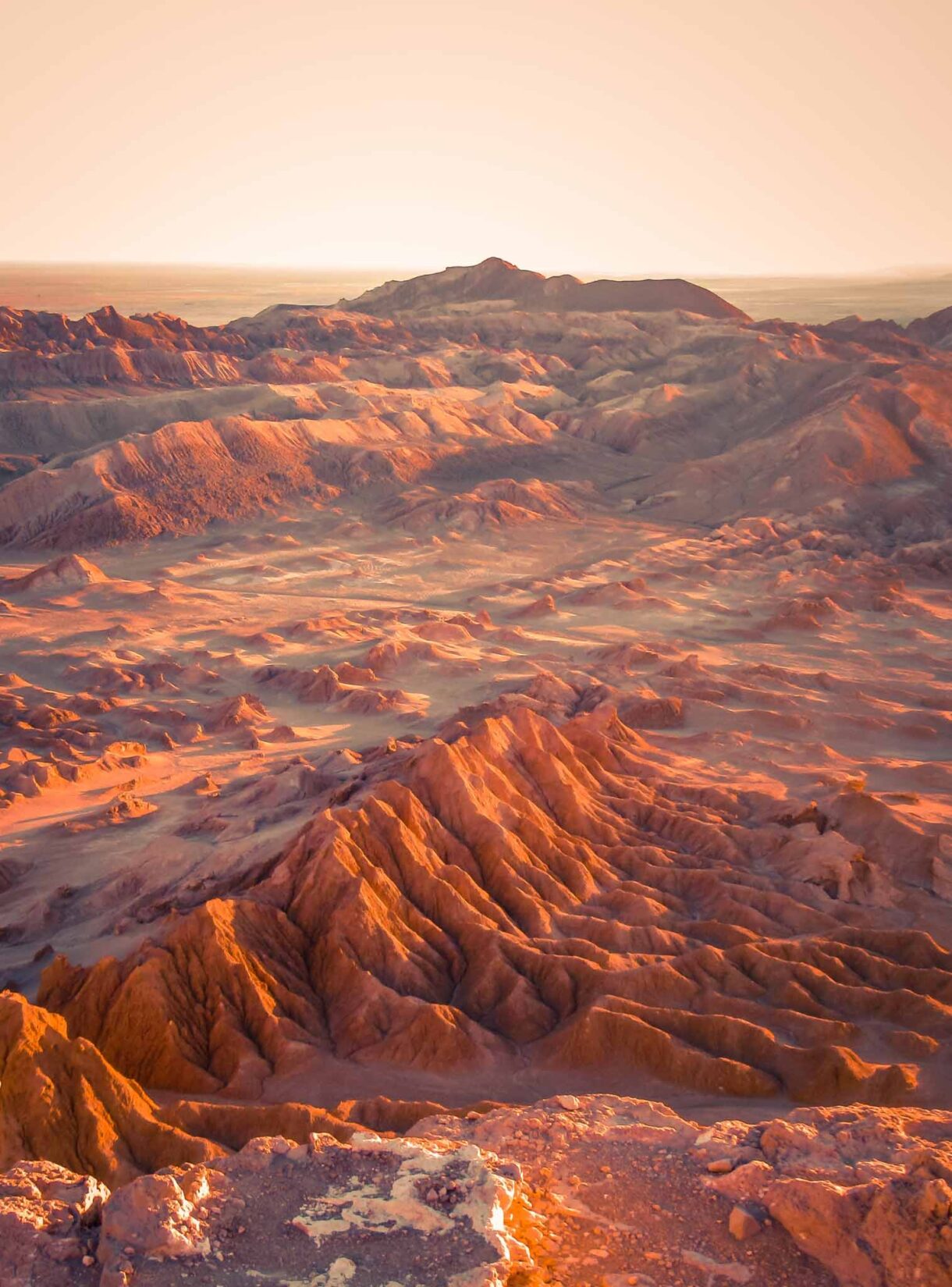
San Pedro de Atacama: the ultimate guide to the world’s oldest desert
Welcome to San Pedro de Atacama, a small desert town located in northern Chile , known for its stunning landscapes, ancient cultures, and outdoor adventures . There’s a myth that the high mineral levels in the Atacama make people happy, spreading good energy and positive vibes. Whether that’s true or not, the Atacama region of Chile has such a great atmosphere and we really enjoyed our time here.
If you’re planning a trip to San Pedro, there are plenty of things to do and see, from hiking to hot springs to stargazing. In this blog post, we’ll highlight some of the best activities and sights in the area, as well as provide information on how to get there and the cost of each activity.
Where is San Pedro de Atacama?
- What is there to do in San Pedro de Atacama?
Do I have to take a tour in San Pedro de Atacama?
- When is the best time to visit San Pedro de Atacama?
- How to get to San Pedro de Atacama?
Where to stay in San Pedro de Atacama
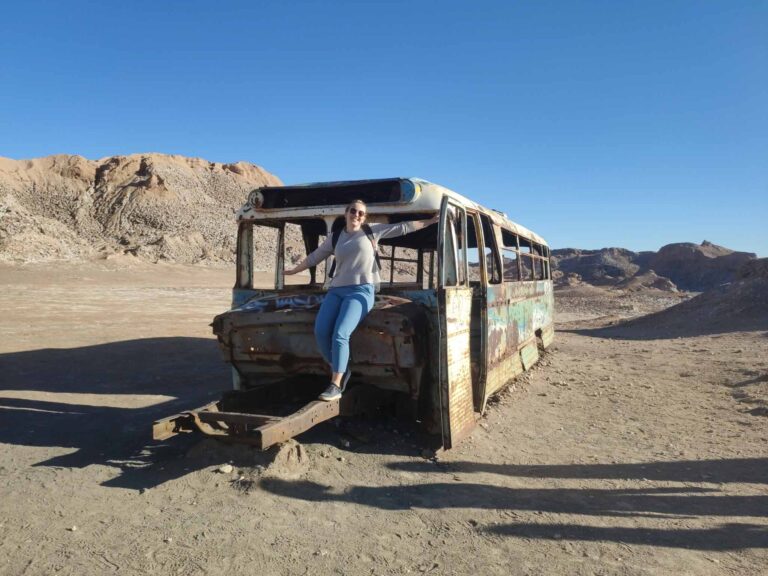
La Valle de la Luna (Moon Valley) tour
San Pedro de Atacama itself is a small, chilled-out tourist town in the north of Chile . The town itself built on an oasis in the middle of the Atacama desert. It’s bursting with cute cafes, colourful souvenir shops, and tour companies. We think it’s the best place to base yourself if you want to explore the Atacama region!
The town is also fairly close to the Bolivian and Argentinean borders . This makes it a popular stop-off point for travellers who want to get a taste of Chile without trekking all the way to Patagonia .
What is there to do in San Pedro de Atacama?
#1 valle de la luna (moon valley).
Valle de la Luna, or Moon Valley, is one of the most popular attractions in San Pedro, and for good reason. This otherworldly landscape features unique rock formations, salt flats, and sand dunes that are reminiscent of the moon’s surface. The orange rocks against a blue sky are absolutely stunning at sunset.
How to get there: Most people choose to take a tour of Valle de la Luna. You’ll be driven around all the best sights of the desert, and end your trip with drinks and snacks. Cheers to that!
Cost: Tours cost £15-£30 GBP ($20-$35 USD) per person. You can also rent a bike and ride there yourself (~£8 GBP/$10 USD per day).
Interested in making your adventures mores sustainable? We’re experts on that!
#2 LAGUNA CEJAR (CEJAR LAGOON)
Laguna Cejar is a beautiful saltwater lagoon that’s perfect for swimming and floating. The lagoon’s high salt content makes it easy to float on the surface, and the surrounding scenery is breathtaking. Be warned though, although the temperature is warm, the lagoon certainly isn’t!
How to get there: Again, the easiest way to get to Laguna Cejar is on a tour. You could also hire a car and drive yourself, but this is unlikely to work out cheaper.
Cost: Tours cost £25 GBP ($30 USD) per person. Shop around a bit to get the best price!
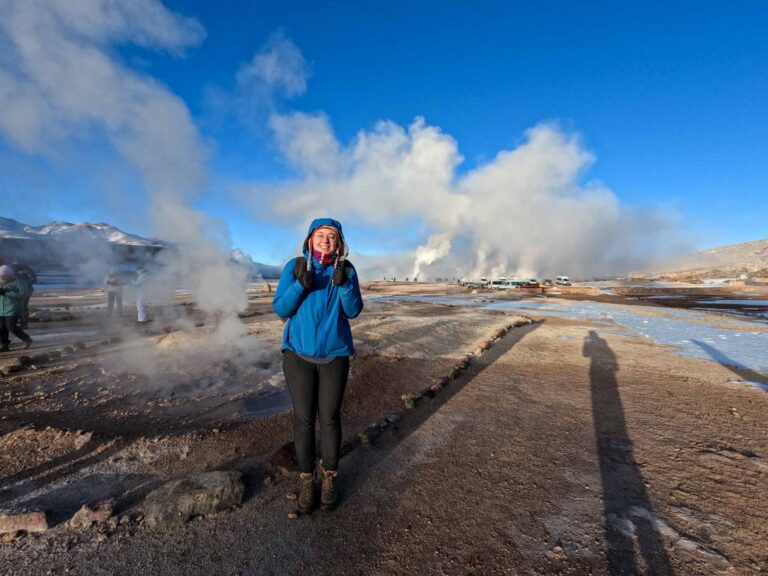
El Tatio Geysers: the coldest I’ve ever been (-17°C)
#3 GEYSERS DEL TATIO (EL TATIO GEYSERS)
The El Tatio Geysers are a must-see for anyone visiting San Pedro de Atacama. At an altitude of 4’300 metres, these geysers are one of the most original (and in my opinion, coolest) things to see in the Atacama
Top tip: At 4320 metres (14,170 ft) altitude before sunrise, it’s absolutely freezing! Wear ALL your clothes. I’m not being dramatic when I say that this was the coldest I’ve ever been! It was -17°C (1.4 ° F)!
How to get there: To get to the Geysers del Tatio, you have to take a tour. The geysers are most active in the early morning, so you’ll likely set off very early. It’s ~2 hours on some very windy roads but the views are insane .
Most tours will get you to the geysers right on time for sunrise when they are at their most active. After visiting the geysers, our van pulled over away from the crowds for breakfast with a view! We feasted on hot cocoa, bread, cheese and avocado. On the way down, we stopped off at a couple of viewpoints to see flamingos and other wildlife. Even though a lot of tour companies offer this trip, it still felt like a really special and personal experience , which I loved.
Cost: We paid around £40 GBP ($50 USD) per person, which was organised through our hostel!
#4 TERMAS DE PURITANA (PURITANA HOT SPRINGS)
After a few days of sightseeing, there’s nothing better than taking it easy. Soaking in the natural hot springs at Termas de Puritama is the perfect way to relax. The pools are located in a beautiful canyon and are surrounded by lush vegetation and mountain views. Temperatures are between 28°C and 31°C (82°F to 88°F) – not boiling, but comfortable!
How to get there: The hot springs are only 60 miles (100 km) out of San Pedro town via Route B-245. However, there’s no public transport in the region. Tours are easily organised in San Pedro town, or by your hostel. If you’re renting a car you could also drive there yourself.
Cost: Tours cost ~£30 GBP ($35 USD) per person. Tickets to the hot springs might cost extra, depending on what time of day you visit.
#5 STARGAZING TOURS
San Pedro de Atacama is one of the best places in the world for stargazing , thanks to its high altitude, clear skies, and lack of light pollution. There are several stargazing tours available, which typically include transportation, a knowledgeable guide, drinks, snacks, and the use of telescopes.
Top tip: Organise your stargazing tour during a new or small moon. A full moon is so bright that you won’t be able to see as many stars! And wrap up warm, the desert cools down a lot as it gets darker.
How to get there: You really need a tour for this one. Your tour company will drive you out to the spots with the darkest skies. They’ll also bring and set up telescopes, and understand how to use them so that you can get the most out of your experience. T ours leave at approximately 8pm from San Pedro de Atacama town and come back at about 11pm.
Cost: Tours start at £40 GBP ($50 USD) per person
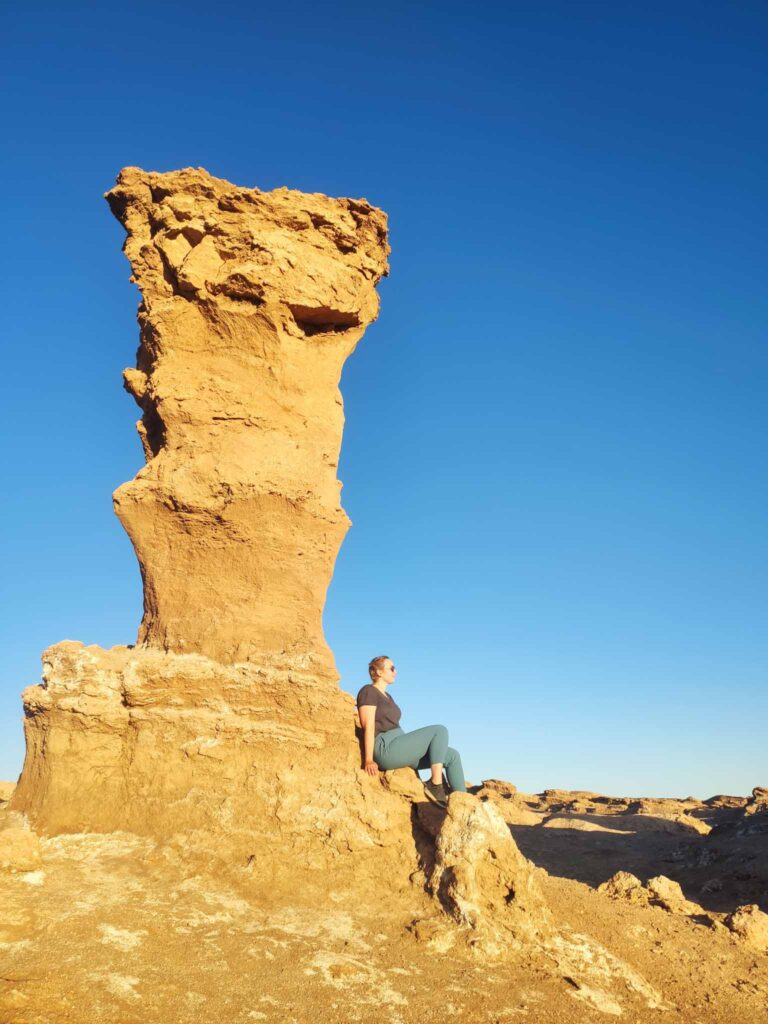
Golden hour in the desert
You’ll see we’ve mentioned tours a lot in this post. Much more than we usually would.
We aren’t huge fans of organised travel as we prefer to see things at our own pace and away from the crowds. But sometimes, when tours are the ONLY way to see something, you have no choice but to join the masses.
Unfortunately there’s no public transport around San Pedro de Atacama . You can get a bus in and out of the town. But to get between San Pedro de Atacama and the best sights, you’ll need to go with a tour company (or hire your own car).
San Pedro is bursting with tour companies that know they can profit from this. It’s e asy to organise any tour last minute. However, they are not cheap . If you’re coming from other countries in South America (like Peru and Bolivia ), you’ll likely be shocked by just how expensive Chile is.
And the worst bit? You’ll often have to pay entry fees on top once you get there, which, depending on the attraction, can be anywhere up to £15 GBP / $23USD per person.
B udget travel tip: Choose your tours carefully to save money. Ask yourself what a ‘must-do’ is, and what would be ‘nice-to-do’. If you’re travelling through Bolivia on a Uyuni tour , you’ll see epic geysers and bathe in hot springs on your way to San Pedro de Atacama. You could consider skipping El Tatio Geysers and Puritama Hot Springs in favour of other trips, like La Valle de la Luna.
Find out more about the Uyuni tour here!
When’s the best time to visit San Pedro de Atacama?
We’re firm believers that there’s no ‘best time’ to visit a destination. All seasons are beautiful and bring something a little unique and special that makes no two adventures the same.
San Pedro de Atacama has pretty consistent weather year-round. It’s a little hotter in the summer (December to March) and a little cooler in the winter (June to October). No matter when you visit, you can expect warm, sunny days, with the temperature plummeting at night.
Outdoor activities, such as hiking, stargazing, and visiting the many natural wonders in the area, are available year-round too. If you’d like to try stargazing, we recommend visiting during a new-moon, as the sky will be much darker.
If you’re looking for something unique, you could visit in the rainy season (December to February). When the rains come, the desert flowers bloom, flooding the dry, orange landscape in a sea of pink and purple flowers . This phenomenon is rare and incredibly beautiful, but maybe you’ll get lucky?
Need help packing for those desert extremes? Here’s our travel packing list for the Atacama (and the rest of Chile too!)
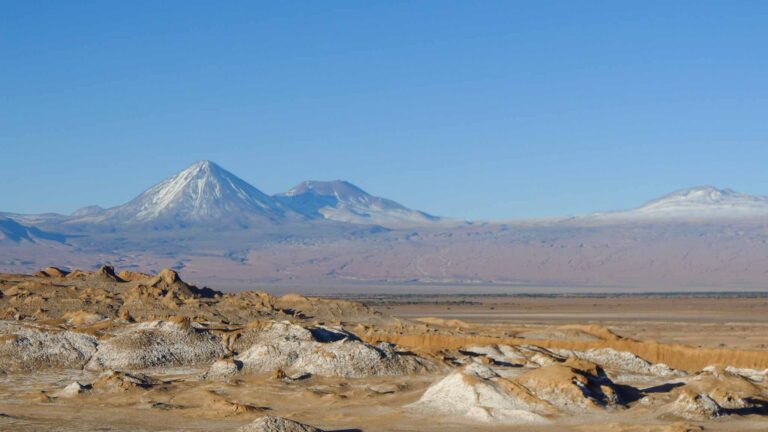
Licancabur Volcano, which straddles the Chile-Bolivia border
How to get to San Pedro de Atacama
So, you’re sold on a trip to San Pedro? Here’s how to get there by air and overland
HOW TO GET TO SAN PEDRO DE ATACAMA BY AIR
We usually suggest overland travel in South America (and worldwide, in general). It’s far more sustainable and you often get to have unique and special experiences you’d otherwise miss out on.
But distances in Chile shouldn’t be underestimated. Unless you’re on an extended South America trip, flying directly to San Pedro de Atacama from Santiago is usually the most time-effective option
FLY FROM SANTIAGO TO CALAMA
Travel Time: 3 hours
Frequency: Several times daily. Calama is an industrial city and many locals travel by air between Calama and the capital.
Cost: Between $49,000 CLP (£50 GBP, $60 USD) and $180,000 CLP (£180 GBP, $220 USD) each way. As usual, book early to secure the cheapest fares.
Onward Travel: From Calama airport, you can take a shared or private transfer to San Pedro de Atacama. A shared transfer costs around £8-£12 GBP ($10-$15 USD per person, while a private transfer can cost upwards of £50 GBP ($60 USD) depending on the number of passengers.
HOW TO GET TO SAN PEDRO DE ATACAMA OVERLAND
Overland from santiago.
Travel Time: ~22 hours
If you prefer to travel by land, you can take a bus from Santiago to San Pedro.
Frequency: Several times daily from Santiago
Cost: The cost of a one-way ticket can vary between £25-£60 GBP ($30-$80 USD) depending on the bus company and the class of service.
Onward Travel: From Calama, you can take a shared or private transfer to San Pedro de Atacama, as mentioned earlier.
Heading south to Patagonia? Here’s everything you need to know.
OVERLAND FROM BOLIVIA
If you’re on a longer trip in South America, and you’re already in Bolivia, you can get to San Pedro de Atacama overland. A Salar de Uyuni tour is the most popular (and easiest) way to do this.
This trip is seriously awesome , and such a budget-friendly option (compared to the day trips in San Pedro de Atacama!). We really recommend it. You can find out more about the Salar de Uyuni tour from San Pedro here .
Travel Time: 3 days
Frequency: Daily from Uyuni
Cost: Our 4-day round trip Salar de Uyuni tour, which started and finished in San Pedro de Atacama, cost around £150 GBP ($180 USD)
It’s worth noting that the border crossing between Bolivia and Chile can be time-consuming. The opening hours don’t run to any fixed schedule, so you might have to wait for a border guard to show up. If you need to get a visa on arrival, that’ll take some time too.
The route reaches around 4,910m (16100 feet) in altitude and in the winter the snowy weather can lead to road closures. When we were crossing into Bolivia, the border guards had actually gotten stuck in the snow! We had to give them a lift!
There are no public buses that do this route for those that don’t want to take a tour. However, you might be able to arrange a one-way ride with a tour guide heading from Uyuni. Their vehicle will likely be empty as they drive to the Chilean border to pick up a new group – many will be happy to drop you off at the border for a small fee.
Travelling overland to Bolivia? This is the best way to do it.
OVERLAND FROM ARGENTINA
You can also get to San Pedro de Atacama from Salta, Argentina by bus. This is a great way to see the stunning moon-like landscapes of northern Argentina and Chile.
Travel Time: ~10.5 hours
Frequency: This route is offered by two bus companies and there are departures several times a week. Check the websites of Pullman and Andesmar for more information and tickets.
Cost: The journey costs upwards of £60 ($70 USD)
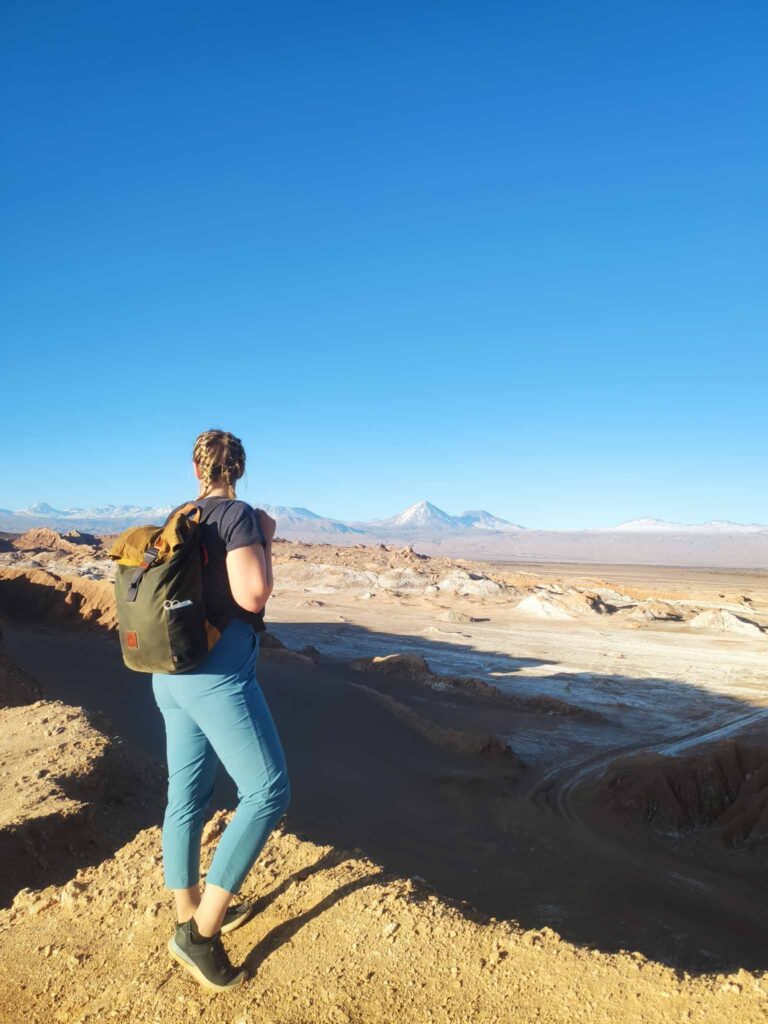
Views all the way to Bolivia form La Valle de la Luna
San Pedro is a tourist oasis, and there’s no shortage of places to stay. From cute and quirky hostels, to something a little more upmarket, you’re bound to find something to suit your budget and travel style
We stayed in Hostel Mamma Tierra ! The name translates to Hostel Mother Earth, which is is definitely the kind of vibe that we like! We took a small double room, which was reasonably priced and really cute. There were hammocks to relax in, and the team even made pancakes for breakfast (or sent us off with a pack-up breakfast if we had an early tour) which were delicious! If you’d like options, we also heard good things about Casa Voyage from another traveller
If you’re looking for something a bit more luxurious, we’ve heard good things about Hotel La Casa de Don Tomás and Terrantai Lodge . Both of these are taking extra steps towards sustainability, which is another reason to consider them.
Q: WHAT TO DO IN SAN PEDRO DE ATACAMA?
A: We hope we’ve covered that above! Scroll back up and have a read, and feel free to reach out if you’d like any more ideas or information.
Q: IS THE ATACAMA DESERT WORTH VISITING?
A: Yes, the Atacama Desert is definitely worth visiting! It’s unique and crazy beautiful. It caters to tourists, so you’ll be able to meet other travellers. It’s also much cheaper than visiting other regions of Chile ( such as Patagonia !)
Q: WHAT TO PACK FOR SAN PEDRO DE ATACAMA?
A: San Pedro is warm during the day but temperatures can plummet at night. Layers are key, you might be wearing shorts during the day but you’ll want long trousers and a jumper at night. We’ve written a full guide to what to pack for each region of Chile here if you’d like more detail.
Q: IS THE ATACAMA DESERT SAFE?
A: Yes, the Atacama Desert and San Pedro itself are generally safe for travellers. The region is well-developed for tourism, and there are many reputable tour companies that offer a variety of excursions and activities in the area. San Pedro is also a really small town, that mostly caters to tourists, which means there’s always someone around. We didn’t feel unsafe here at all (especially compared to Santiago/Valparaiso).
Q: WHAT IS THE ELEVATION OF SAN PEDRO DE ATACAMA?
A: San Pedro de Atacama is situated at an elevation of around 2,400 meters (7,900 feet) above sea level. If you’re coming from lower altitude (Santiago, Patagonia) it’s a good idea to spend a few days in San Pedro before travelling to higher altitudes, such as El Tatio Geysers or a Salar de Uyuni tour.
Q: CAN YOU DRINK TAP WATER IN SAN PEDRO DE ATACAMA?
A: It’s not recommended to drink the tap water in San Pedro de Atacama. The tap water has a high mineral content and can cause stomach upset. Many hotels and restaurants in San Pedro de Atacama offer purified water. Or just get a travel filter bottle and you’ll be able to safely drink any non-salty water .
Q: WHAT'S THE VOLCANO NEAR SAN PEDRO DE ATACAMA?
A: San Pedro de Atacama forms the northern chain of Chile’s ‘Ring of Fire’ and is surrounded by volcanoes. Some of the most popular ones include; Lascar Volcano (active, 70km away, 5,592m high); Licancabur Volcano (dormant, on the Chile-Bolivia border, 5,916m high); Tatio Volcano (extinct, 80km away, 5,704m high) and Sairecabur Volcano: (dormant, on the Chile-Bolivia border, 5,971m high). If you’re feeling up to it, you can even climb some of these for stunning views, but it’s important to go with a reputable company and be wary of altitude sickness.
Follow our daily adventures on Facebook and Instagram
This post may contain affiliate links (yay for transparency!) This means that I will earn a small commission, at no additional cost to you , if you click the link and choose to buy the product. I only link to stuff I have personally bought and found useful and never endorse crap. Your support helps keep the site going, thank you!
Alice is a UK travel blogger who advocates sustainable travel and being more eco-conscious on a budget. She loves coffee, her houseplants and summiting mountains.
You May Also Like
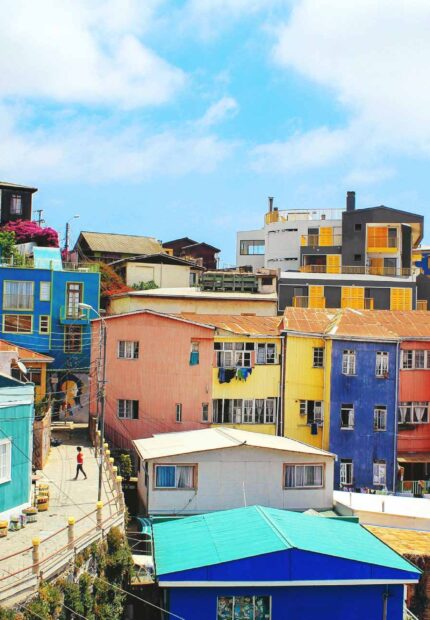
What do things cost in Chile?
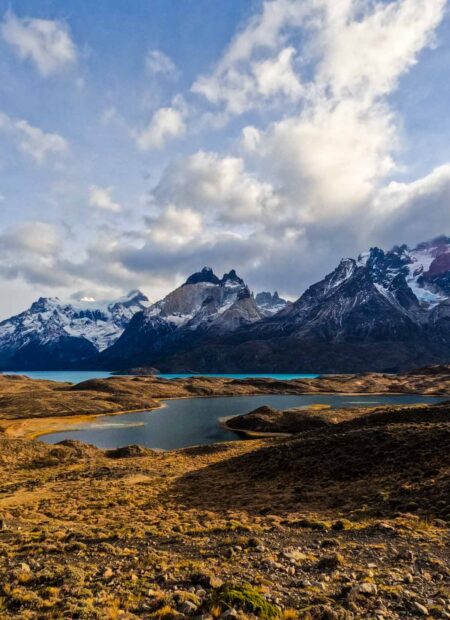
The Journey is the Adventure: How to get to Patagonia from the rest of Chile by Bus, Boat and Plane
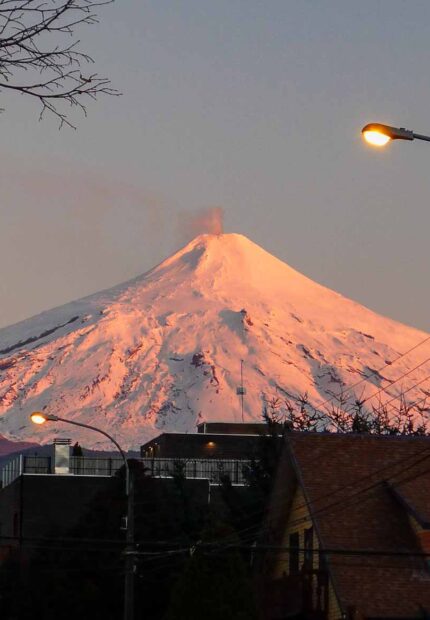
Everything you need to know to hike Volcan Villarrica
Leave a reply cancel reply.
Your email address will not be published. Required fields are marked *
Hello! To provide the best experience we use technologies like cookies to store and/or access device information. Consenting to these technologies will allow us to process data such as browsing behaviour or unique IDs on this site. Not consenting or withdrawing consent, may adversely affect certain features and functions.
San Pedro de Atacama
- 1.1 San Pedro vs. Uyuni
- 2.2 By plane
- 2.4 By thumb
- 3.1 On foot and navigation
- 3.2 By bicycle
- 3.4 By tour
- 4.1 Geysers del Tatio
- 4.2 Valle de la Luna
- 4.3 Lagunas Altiplanicas
- 4.4 Laguna Cejar
- 4.5 Salar de Tara
- 4.6 Valle del Arcoiris
- 4.7 Sandboarding
- 4.8 Puritama
- 4.9 Archaeological Tour
- 4.10 Star Tour / Tour Astronómico
- 4.11 Mountain climbing
- 4.12 Other destinations
- 4.13 Tours, prices, times and schedule
- 6.2 Shopping
- 7.2 Mid-range
- 7.3 Splurge
- 8.2 Locations
- 9.1 Camping
- 9.2 Lodging
- 11 Stay safe
- 12.1 Altitude
- 12.2 Solar radiation
- 12.3 Other health concerns
- 13.1 When to go
- 13.2 Tours and companies
- 14.1 Salar de Uyuni (Bolivia)
San Pedro de Atacama is a town of 3,899 (2012) in Northern Chile . San Pedro is a very popular destination among Chilean tourists and international visitors. Visitors come in large numbers, to use the town as a stepping stone to the amazing landscapes around it. Most attractions are part of the Los Flamencos National Reserve , perhaps Chile's most varied and amazing national park.
Understand [ edit ]
Prices in any of the laid back bars and restaurants fare well against Santiago 's. Still, it's a fairly expensive location, as it's one of Chile's three most popular destinations, along with Torres del Paine and Easter Island .
San Pedro vs. Uyuni [ edit ]
As many people head for San Pedro to continue their travel into Bolivia doing the popular Salar de Uyuni tour, it is important to note that many sights found around San Pedro have similar equivalents on the Bolivian site. Hence, instead of paying twice, it is worth thinking about skipping some tours offered in San Pedro and saving the money. This is also what many travellers that did both countries agree with and recommend to other. In fact, the sights along the Salar de Uyuni tour are equally or even more beautiful and impressive than what can be found around San Pedro, e.g. 1) Geysers del Tatio: 2 hr from the border you will visit a smaller but much more versatile site with mud pools, loud steams and geysers, and shortly after that a nice warm thermal pool with magnificent views which easily tops the semi-warm thermal pool at the Geysers del Tatio. And you do not have to get up at 5, freeze your bottom off, and get hassled along the way due to the limited time. 2) Lagunas Altiplanicas: Already the first stop after the border at the Laguna Verde (or the Lagunas on the second day) and the Laguna Colorado at the end of the first day top this tour, with much more flamingos and more versatile views, not to mention the value of Salar de Uyuni over Laguna Chaxa. 3) Astronomic tour: This can easily be realised in the middle of nowhere on the Salar de Uyuni tour with no lights whatsoever around. 4) Salar Tata: The diversity of the sights along the Salar de Uyuni tour is immense and also covers this tour.
Nevertheless, the Valle de la Luna is a must when in San Pedro and cannot be skipped for anything along the Salar de Uyuni tour. Likewise, the Laguna Cejar, and a bicycle, hiking or sandboarding tour around San Pedro are not substitutable. Furthermore note that the tours in San Pedro are a good way to acclimatise against altitude sickness. The Salar de Uyuni tour almost touches the 5,000-m mark. So, the Piedra Rojas tour for instant might actually be a good thing, because at the Lagunas Miscanti and Miñiques you will cross the 4,200-m mark.
Get in [ edit ]
By bus [ edit ].
- -22.913554 -68.194737 1 Terminal de Buses , Tumisa Road ( Inside Craft Village, about 1 km southeast of the city centre. ). ( updated Apr 2023 )
Several buses per day connect the town with Calama (see Calama#Get in for schedules), operated by TurBus, KTUR, Frontera del Norte, Atacama 2000, and Intertrans. The trip takes about 1½-2 hr, and costs 3,000-5,000 pesos . Other buses like TurBus travel also from Antofagasta (4 hr, 9,000 pesos), Iquique , Arica (12 hr, 22,000 pesos), and Santiago . It is best and cheaper to transfer in Calama, because it is easy to get there with regular national buses (because of the airport and the mine), and between Calama and San Pedro more frequent and cheaper regional buses operate.
Also, buses connect San Pedro with Salta and San Salvador de Jujuy in Argentina.
There are also regular buses from Uyuni, in Bolivia (30,000 pesos). But skipping the Salar de Uyuni Tour between the Chilean border and Uyuni for a simple bus is not recommended—it is one of the most impressive and most inexpensive tours you can do in South America. Nevertheless, cross border bus passes are available from Green Toad Bus which allow you to travel to San Pedro from Argentina, Brazil, Peru, Bolivia and the rest of Chile. Or just ask at the tourist information or one of the booking offices in town.
By plane [ edit ]
No airlines fly direct to San Pedro. The nearest commercial airport is Calama. Most flights are direct, and connect Calama with Santiago, but a few also fly to Antofagasta and Iquique. LATAM (has the most flights, and the best support, but isn't always the cheapest), Sky Airline (terrible website, better service than LATAM), PAL and JetSMART fly to Santiago from US$12 one way. To get from the airport to Calama, take a taxi. From Calama to San Pedro is about 90 min by bus (2,500 pesos). Transvip and Licancabur run minivan transfer to hotels in San Pedro de Atacama for 10,000-12,000 pesos. No need to reserve: you can buy tickets at their airport booth.
Be very careful when you are looking for WiFi at the airport. The restaurant Bakery & Co., located on the main departures level, would scam you by telling you that there is working WiFi in their premises; but once you have purchased your food and beverages, they would tell you that they have just discovered that their WiFi is not working. For reliable connection, go to Costa Tacora Restobar on the balcony (upper floor) of the departures level.
By car [ edit ]
At the Calama airport you may rent a car. Car rentals are fairly expensive, however, for Calama is Chile's largest mining hub, and therefore rentals offer mostly medium pick-up trucks. You will need an international driving permit if your license is not in Spanish. However, travellers have reported their German license to been accepted. Rentals are cheaper in Antofagasta, but most likely you will have to return the car there. Most popular destinations are fairly easy to reach with a good map, but driving high in the Andes should not be undertaken by beginners in the area! Roads off the popular trails are often in terrible condition, not signaled at all, there's no cell phone signal, and acute mountain sickness is a real threat. Getting stuck in the less-traveled roads of the "altiplano" can be a death sentence, since some aren't used at all, and see perhaps a car every two months. That said, travelling on the frequented roads used by the tour providers in San Pedro is straight forward and can even be done with a car without 4WD.
Always travel with a full tank, since the only gas station in the area is in San Pedro. You can find illegal fuel vendors in some of the smaller towns, like Toconao, but they charge outrageous prices. Also, remember that fuel consumption increases dramatically with rising altitude. Check the condition of all tires, even the spare; flat tires aren't at all unusual on the many dirt roads that lead to points of interest.
By thumb [ edit ]
Chile is well-known as a hitchhiker's paradise. Getting to Calama from any other point in the country is simple enough, but reaching San Pedro is a bit trickier. The best chances are to be had at the Topater monolith ("Monolito de Topater"). From there, walk south, beyond the underpass, and hitch a ride to town. You might have to wait for a while, but traffic to and from Calama is fairly consistent. Sometimes, even the vans of tourist agencies might pick you up; it all depends on your luck.
Get around [ edit ]

On foot and navigation [ edit ]
Once in the town, nearly all points of interest, restaurants, services, are within walking distance, with the exception of a few outlying hotels. Downtown comprises twelve small blocks, between the streets Domingo Atienza and Toconao from west to east, and Licancabur and Caracoles north to south. This last street is the main one, a pedestrian zone.
Outside of town you can even reach Valle de Marte on foot. Also, there are many hiking trails north and northwest of town. For reliable trails and GPS navigation in this desert region, consult OpenStreetMap , which is used by many mobile Apps like OsmAnd or Mapy.cz . Or just download the according GPX or KML files through Waymarked Trails for such trails on OpenStreetMap. (Note, you just need to change the OpenStreetMap relation ID to download the GPX or KML files through the same link.)
By bicycle [ edit ]
Bicycles can be rented in town: 3,000 pesos for 6 hr, 6,000 pesos full day. The rental usually includes warning vest, helmet, lamp, first aid kit, and pump. Bicycles can be a great and inexpensive way to explore the surroundings of San Pedro, like Valle de la Luna, Valle de Marte, Pukará de Quitor, Aldea de Tulor, and even Laguna Cejar (see below ). Reliable tracks can be found with OpenStreetMap (see previous chapter).
It is now illegal to ride a bike in the centre of San Pedro. If you look gringo enough, chances are the cops will let you slide — but it's advised not to try. They're fond of ticketing cyclists in the evening.
This is the most authentic, least stressful and , depending on the number of people, the cheapest way to do San Pedro and its sights . It is also far easier than you might believe. In 2 days you can cover most of the common and picturesque sights on your own time, even the Tito geysers. Most roads are good in good shape and suitable for regular cars. Also, when you travel along the common routes, there will always be traffic along the way in case you break down (nevertheless, always carry enough water and very warm cloths for the night. Also, be aware of the altitude issues. Do not think, just because you have a 4WD, you are less prone to the dangers of the road. This attitude can be fatal!). As you will require a reliable map, see the comments in the first chapter above.
Going on you own, visiting times will probably vary from the tour companies, i.e. there will be fewer people around when you are at the sight and take pictures. To get a good idea what is to see (even little sights) and which are possible schedules, go around in the centre of San Pedro and ask the booking offices what a trip to this and that sight will look like, what is included, and how much the entrance fee will be.
Rental prices per day in San Pedro for a 4WD truck with space for 5 people start at US$106 (70,000 pesos as of Apr 2018), if booked online or if you ask for a discount with -22.910703 -68.205771 2 Europcar on sight. But doing the maths against the tour prices, you will see that this is fair and easily cheaper, especially if you camp and go in a group. You might even consider renting a car in Antofagasta or Calama where rental prices are much cheaper (~40,000 pesos) and you will also get regular cars—the extra distance you will have to do with a bus anyhow and mostly the extra time is easily covered by the much lower rental prices. To find people to rent a car together with, ask around in your hostel or use the various travel groups for Chile and South America on Facebook.
By tour [ edit ]
All important sights around San Pedro can be visited with a tour offered by one of the 150 booking offices in town. However, please see #Cope to get an understanding of the ups and downs of this decision. While tours can be a convenient choice for some people, they can be the horror to others. Basically, if you never had issues with packaged tours, this is the way to go. Otherwise, if you already know what the last point was about, you will probably know that you are not the packaged tour guy/gal—if you always hated tours, you will certainly also let be down by the tours offered in San Pedro.
See [ edit ]
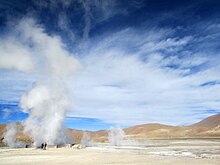
In the following the essential places to visit around San Pedro. The description takes emphasis on the tours offered from San Pedro, but the sights can also be visited without a tour. For the entrance fees of just the sites, see the table at the end of this chapter. To keep track of the changing prices, opening times and closures of certain sites, San Pedro tourism office keeps a list outside of its doors.
Geysers del Tatio [ edit ]
Directly after the geysers you will most likely visit the hot springs, which are not that hot and at 0 °C or most likely less, it requires some convincing to strip you cloths and to get into the water. On the way back, it's typical to find wild vicuñas, an endangered Andean camelid that's highly protected in Chile. They were rescued from the verge of extinction thirty years ago. Vicuñas in the area are accustomed to human presence, and will tolerate tourists coming to some twenty meters away-any more, and they're likely to flee. Be extremely respectful of the regulations, for many guides and drivers might even react in an aggressive manner if you bother the animals in any way.
A common stop is the fording of the Putana river, a spectacle that for some even surpasses the geysers themselves. Many different bird species inhabit it, and it's perfectly possible to get very close to them-giant coots ( fulica gigantea ) are especially indolent. Winter has the most birds, with over ten different species cohabiting the place at peak migration, but temperatures are harsh . There's also the possibility of seeing a vizcacha or two ( lagidium viscacia ), a funny mix between a bunny, a squirrel, and a kangaroo. They're very shy, though, and if you don't get there among the first visitors, they'll have usually disappeared. In the background, to the east, lies the Putana volcano, an active mountain that boasts seven small fumes.
Afterwards you will visit Machuca, an abandoned altiplanic village that lived from the mining of sulphur. Most regular tours stop here. Nowadays, you'll find a few locals there, roasting anticuchos made of llama meat. Teas, soft drinks and empanadas are also available. The meat is of questionable origins, with some wild theories as to its origin floating around. Ask your guide for a laugh. It's fairly safe to consume, though, as sanitation's decent. Just after exiting Machuca, it's common to see llamas grazing on a beautiful pasture. After that pasture lies a micro-sized salt pan, where vicuñas and James' flamingos can be seen (the latter only in summer, though).
If you plan on going, please consider the following things:
- Temperatures can be terribly cold : -15°C is common through June to August, while in summer it rarely dips below -5°C. It's paramount to wear gloves, a cap, and preferably two layers of socks, along with a very warm jacket. After sunrise, the cold quickly subsides, and it gets bearable. Once you get to Machuca, the heat can be stifling. Prepare accordingly.
- The altitude , coupled to a steep and winding road, can easily cause altitude sickness. Almost all agencies claim to carry an oxygen bottle on board; this is false. They do bring a can with air compressed to one atmosphere, but it does little other than acting as a placebo. See the section 'Cope' for advice on preventing and ameliorating the sickness.
- You can also take your own car . Nowadays, the gravel roads to the geyser are of proper state, and it is hard to break down here. Follow the convoy of cars that go up north by Guatín village at around 05:30-05:40. Many people use regular cars without 4WD to visit the geysers, and even most tour companies just have regular vans. However, you need a good map (use OsmAnd or Mapy.cz) and driving skills on gravel. At one point you will pass 4,400 m, take your time if AMS shows up. The geyseys themselves are at 4,100 m. You'll have virtually no communication with the world at all unless you carry a satellite phone, and even then the signal's sketchy. Nevertheless, if you travel along the road that every one takes, even if you break down, it will be easy to find help. Every year there are lethal accidents on that road often with tourists, so beware and be cautious.
Valle de la Luna [ edit ]
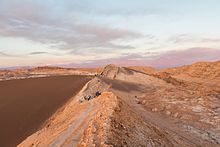
It's perfectly possible to ride a bike there and see the many sights, but you should take your time. Although only 8 km (5.0 mi) away from San Pedro, the road's steep and sinuous. When biking, it's advised to travel early (7-8AM) in the morning, for afternoon temperatures can be suffocating year-round. Thus, you lessen the possibility of heatstroke and the sights won't be filled with tourists. Also, it's easier to find someone to rescue you if you get in trouble. If you rent your bicycle longer than 6 hr (6 hr is 6,000 pesos, whole day is 10,000 pesos), you can even enjoy the sunset in the evening from the top near the highway to Calama. You should get a flashlight especially if you want to watch sunset (the road can be dangerous when dark) but also because there's a cave you can visit and it's pitch black in there. Mostly bicycle rentals will include a light (or use your smartphone), which you can use for this purpose, but make sure the bike also has a tail reflector, a helmet, an emergency kit and you got a map of the valley.
If you plan on going, please consider the following:
- It can get cold immediately after sunset, especially in winter. Bring something warm to wear and even gloves to enjoy the show to its fullest.
- Carry water! This is vital. You probably won't notice you're sweating; moisture evaporates at an alarming rate in the Atacama desert. This means you actually sweat more. Most agencies do not include water in the price and there are no shops along the way.
- Tours usually include long treks. So, wear appropriate shoes. There'll be lots of sand, too, which can be excruciatingly hot, and many sharp rocks, so flip-flops are a no-go.
- Since some people will head out by bicycle early and return in the early afternoon, you can ask for their ticket to head out with the bicycle late to see the sunset from the top viewpoint.
Lagunas Altiplanicas [ edit ]
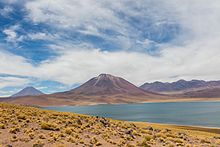
- Be wary of the salt pan, as it reflects sunlight in the way that snow does. Wear pants and long sleeves, carry a hat, and wear sunglasses, unless you enjoy the prospect of developing blindness and skin cancer.
- Miscanti and Miñiques are usually very windy. The wind can easily bring perceived temperature down to 0ºC; bring a good jacket at the very least. Also, follow the guidelines closely, for both park personnel and agency employees are strict about them.
- Again, carry lots of water.
- The meals in Socaire are deceiving, in that they'll usually leave you feeling quite full. The quality's good; most visitors find them remarkable. Don't forget to try the home-baked bread with pebre , a typical Chilean sauce made with tomatoes, onions, coriander, and a bit of chili (ají). It comes included in the meal. It's spicy, but nothing unmanageable.
- Look for the Tropic of Capricorn marker. There's one on both of the roads usually taken by tours. On the main road lies a strange white cross that indicates not only the Tropic, but also the Inca road that used to traverse the area. Most guides ignore this fact (intentionally or not), so you'll have to keep your eyes open.
Laguna Cejar [ edit ]
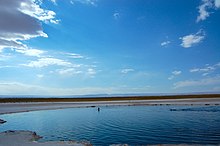
-23.05776 -68.21798 4 Laguna Cejar . This is one amazing location in summer! Set in the northern tip of the Atacama salt pan, this location offers a splendid panorama of the Andes, and the possibility to bathe in waters as salty as those of the Dead Sea, meaning you can float in the without drowning, even if you cannot swim. The landscape's also remarkable. It usually ends with sunset, along a simple cocktail with pisco sour . The tour sets off at variable times (since Chile follows daylight saving time), but always in the afternoon between 15:00 and 16:00. Besides the Cejar and Piedra lagoons, excursions usually stop by the 'Ojos del Salar' (Eyes of the Salt Pan), two freshwater eyes very close together, and lake Tebenquinche, a water mirror that offers the absolute best sunsets in the whole area-imagine the mountains slowly changing colors, from yellow to pink, and that same image reflected on the lake's perfect surface! The entrance for the site (not the tour) is a staggering 15,000 pesos . ( updated Oct 2022 )
You can get there by bike: 50 km for the round-trip, with the sun burning your scalp without any mercy. There are shorter paths, but the safest is the main road; to get there, just ask where the customs ('aduana') are, and then travel south until you see a sign that reads 'Laguna Cejar'. The road is paved, and drivers are accustomed to see bikers on it. Wear bright clothing (red, blue and yellow work best), just in case. You should not have any trouble locating it, for there are other signs along the way. If you'd like to visit the other lagoons, besides Piedra and Cejar, you can try asking the employee at Cejar's entry. Use OpenStreetMap (used by OsmAnd and Mapy.cz) to find the way south, and again, bring a flashlight .
- Sun protection is a must. Cejar's environs are of a pure, perfect white, which tends to obscenely reflect light.
- The water is cold . From October to March, this will be quite welcome, but not so much in winter. There is an upside to traveling in the latter season-some birds, like flamingos, migrate there (June-August).
- As with the Dead Sea, swimming in such salty waters is different. Always swim on you back! Swimming on your front can be surprising and people have died due to the unsuspecting behaviour of their body and suddenly panicking.
- Always ask whether freshwater's included in the fee. Virtually all agencies carry some, but ask the guide and driver again, just in case. It's necessary to remove the coating of salt that will cover your body after taking a plunge. If not removed, it can cause an unpleasant itch. When desperate, you can always try swimming in the Ojos del Salar.
- Be careful with the pisco sour ! Normally, agencies send just enough for two glasses per visitor, but sometimes it can be more. As it's sweet and sour, it can be very misleading: the usual liquor used for this has between 35 and 40 proof alcohol. Unsurprisingly, tourists are quite chatty on the way back to San Pedro.
- Due to the expensive entrance fee to Cejar, tour companies have started offering an alternative which is similar but just has a 10,000 pesos entrance fee, the Laguna Escondidas .
Salar de Tara [ edit ]
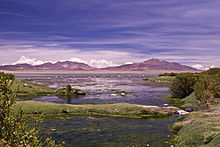
You'll be feeling shortness of breath almost at once. If you plan on going, please consider the following:
- Altitude! The highest point of the excursion is almost 4,900 m above sea level.
- The same nasty winds of Miscanti can be present here, with a vengeance; take warm clothing along.
- It's not uncommon to get stuck in the sand, particularly when the driver's not really acquainted with the path. It can be fun to push the van out of the mire, though.
Valle del Arcoiris [ edit ]

-22.640977 -68.241003 6 Valle del Arcoiris ( Rainbow Valley ). It features three different parts, all of them interesting
The "Hierbas Buenas" petroglyph site is the first, featuring over a thousand ancient stone carvings from the ancient "atacameño" people. They're from all time periods, from the first caravaners to the Incas. Most tours just visit sites 1 and 2, but that should be enough to afford a pretty nifty panorama of these ancient people's history. The other four sites are of difficult access.
Then you've got the village of Matancilla, which is only habited according to season. If you go there in winter, be assured you'll find it deserted. The inhabitants grow a variety of crops, which are easily distinguished all through autumn. Dead wild donkeys are all too common, on the side of the road, while goats and llamas are harder to spot.
Finally, you've got the namesake for the place: the ever-stunning Rainbow Valley, a series of hills that display countless colors, from white to black, from blue to red. Usually, all tours visit two of the four roads available, where the best views are to be had: The "cathedrals" and the great valley. Next to the former, to the left side, are some ever-mysterious buildings, made partially of serpentine, which gives them a light green color. They're well-camouflaged, so you'll have to climb to actually see them. On the way back from these "cathedrals", there's a beautiful hill that displays a wealth of colors; if the guide doesn't offer you to walk down the slope, ask for it! It's certainly worthwhile.
You can watch a similar spectacle in Argentina, on the "Cerro de Siete Colores", but you'll miss the petroglyphs. It might be worth it to rather book a tour in San Pedro, especially since most tourists are completely oblivious of the Rainbow Valley's existence, so you'll most likely be alone when you visit. Most of the advice given for other excursions applies here.
Sandboarding [ edit ]
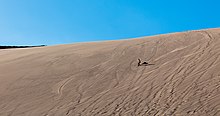
-22.9016 -68.2204 1 Valle de Marte ( Mars Valley ). Like most deserts, Atacama has its share of dunes and sand-banks. The most popular is located here. All sandboarding tours will take you there. The dune is almost 100 m in height; still, the typical track is barely a fraction of that. Some of them offer also to watch sunset in the Moon Valley-but be aware that you won't visit any of its spots, except the Great Dune or the Cari Viewpoint. ( updated May 2018 )
Like before and especially due to its closeness to San Pedro, this can also be done by bicycle. You can rent a board for sand-boarding in town, you just need a proper backpack to carry the board on the bicycle. The entrance to the valley is just 1.5 km out of town, from where you need to go another 3-4 km. The way is very taxing, though, so keep that in mind.
- If the moon is full, or close to, and rising early, it might pay to ride there later-skipping the unforgiving sun can be of great advantage, especially during warmer months (from October through March).
- If you're cycling there with a tour company, the traditional axiom is: one board per three people. Remember that there are no lifts in Valle de Marte, which means you've to climb the sands by foot. This will be tiring and frustrating! Three people can share one sandboard with ease; while one toils away, the other two can relax and rest. Of course, this assumes you've lots of time, which might not be the case.
- Many agencies will take you there on a van, and include a board per person in their fare. This leaves you more time and energy to sand-board, plus they'll usually include watching the sunset, and maybe even a photo album of the experience. Depending on your schedule and interests, this could be far better.
- Sandboarding is absolutely forbidden in Valle de la Luna (Moon Valley)! Expect to be fined if you even try.
Puritama [ edit ]
The layout of the place is as follows: there are eight artificial pools, cleverly made with volcanic rocks, so that they mesh perfectly with the scenery. Guides and drivers typically recommend the fourth and fifth ones; unless you're there early, forget about them. Go for the seventh. The water's just a little bit colder, but the pool's very large, and has sizable waterfall that doubles as a hydro-massage. If you plan on going, please consider the following:
- If you're traveling there from El Tatio, you'll be arriving later than the dedicated tours, meaning the place's going to be crowded. In summer, it's not uncommon for the place to simply close down once there's too many people in. Therefore, be careful when visiting between December and February.
- Also, visitors who take the Geyser route will be forced to follow a stringent schedule; if you want to spend a few hours there, better look for an alternative.
- Guests at Hotel Explora don't need to pay to enter Puritama.
- Useful tip: Get there after 14:00. They'll only charge half the entrance fee from that time onwards, and you still have three hours to soak in the crystal-clear water. No tours leave at that time, though, but a taxi can get you there, and even be less expensive that a typical excursion! Consider this alternative if you have time, and are traveling with at least another person. Consult with the hotel staff.
Archaeological Tour [ edit ]
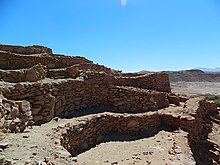
In Spanish, it's called 'Tour Arqueologico'. It usually comprises three destinations: -22.89121 -68.21494 8 Pukará de Quitor , -22.968056 -68.2425 9 Aldea de Tulor , and the -22.91 -68.19969 10 R.P. Gustavo Le Paige archaeological museum . Pukará de Quitor is an ancient fortress, most likely built in the tenth century. It's 4 km from San Pedro. The view from the summit is breathtaking. Aldea de Tulor is the oldest village in the Atacama basin, approx. 3,000 years old, and kept in pristine condition. It's part of the Los Flamencos national reservation, and has small exhibits on archeology (worthless) and local flora and fauna (worth a visit). Last, but not least, is the museum. It holds a decent collection of original atacameño pieces, along with some acquired by the ancient inhabitants of San Pedro through trade-these are most exotic. The main exhibit is only in Spanish, though, but you can hire a guided tour in Spanish, English and French. The schedule for these is published in the museum — take a look around. Special, private tours are also available in Italian, German, and Portuguese; you must reserve these at least two days before. The guides are very capable. The museum also sports a small, but well-stocked souvenir store. They carry some of the finest hand-crafted pieces to be had in San Pedro, plus an interesting assortment of specialized books in Spanish and English.
You can visit these places by cycling, or even on foot. The museum's right by the Plaza de Armas , the main square. Most bike rentals will give you a map of the area; it should clearly point out where the Pukará is. Getting to Tulor, however, is a tad tricky. You must look for signs in the most unlikely places: wall graffiti, stuff hung from trees, and street names.
- The so-called 'mummies' were removed from the museum years ago, by request of the indigenous community. If you're obsessed with desiccated corpses (you sicko), there's a nice assortment of them in Salta, Argentina, and La Serena (500 km north of Santiago). The La Serena museum of natural history even has a collection of 'cabezas de jibaro' on display, which are miniaturized cranial skins (they're reduced to the size of an orange-go figure!).
- The hike to the top of the Pukará de Quitor is strenuous, but well worth it.
- A taxi is a viable alternative to visit these attractions, especially if you're short on time.
Star Tour / Tour Astronómico [ edit ]
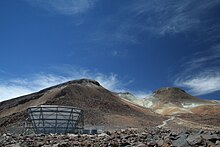
Finally, Atacama desert is one of the best place on Earth to see the sky. Space Star Tours offers a unique experience in watching them. The tour starts with a explanation of the naked eye sky: what is a constellation, how to learn them, how to read a sky map and recognize the main stars. They explain you why are there different coloured skies etc. On the second part, there is the largest park of telescopes of any public observatory in south America. So it is possible to see Saturn, other galaxies and a lot of other phenomenons out there. The tours ends with a warm drink and an explanation about astronomy. The tours last two hours and a half. The schedule varies during the year (later during the summer, i.e. January and February). There is a Spanish and an English tour, the former starts at 21:00 and the latter at 23:30.
- You are in the desert and the nights are very cold, so take warm clothes with you, especially warm socks or multiple layers of socks. If you are still cold, they can provide you with warm jackets.
- Opinions on the tour vary. And many people would agree that you could just take a blanket, lie in the desert and find out the zodiac signs by yourself.
Mountain climbing [ edit ]
The environs of San Pedro de Atacama sport a large variety of mountains to climb, catering to many levels of difficulty. Many can be done self-catered, others require the experience of professional guides. Should you attempt any mountain climb, in any case, you ought to be well aware of the potential risks. There's a few specialized agencies that offer this kind of service; be sure that they provide all necessaries, not only asking the clerk, but also the driver and guide! An oxygen tank and climbing rods are the least you should expect.
The easiest mountains to climb are -22.9463 -67.7753 2 Cerro Toco (5604 m) and -23.368 -67.7273 3 Volcán Lascar (5510 m) . They're fairly popular, and take no longer than a day to complete. Higher in difficulty are -23.29243 -67.61811 4 Cerro Acamarachi/Pili (6064 m) , and -22.719 -67.8903 5 Sairecabur (5971 m) . All these have proper trails, which can be followed, visible on OpenStreetMap—see above .
The beautiful -22.8337 -67.8834 6 Volcán Licancabur , which towers over the town, is a real challenge; although only 5916 m high, it takes at least three days to complete, not counting an exacting preparation period. Another choice is the Kimal mountain (4276 m); even when its altitude is not that impressive, it's surrounded in myth and legend. According to local folklore, the "princess Kimal" is extremely jealous, and enjoys snatching adventurers away. There's even a supposed season for climbing her, when she's more pleasant; of course, no agency will tell ever you this beforehand. Take the chance at your own risk.
Other destinations [ edit ]

There's still much more to be found in the San Pedro area. From the secluded national reservation at Aguas de Quelana, to the ghastly surface of the Salar de Ascotán, to the most advanced radio-telescopes in the world at ALMA, there's enough sights for half a lifetime. If you are a returning visitor, or someone who loves to see what almost no one else has seen, and you get offered a visit to somesuch place, then take it! Albeit being a tourist attraction for thirty years, San Pedro de Atacama is still full of mystery and wonder.
Tours, prices, times and schedule [ edit ]
In the following a summary of what mostly all of the booking offices in San Pedro offer. The price range is the price that can easily be haggled and the price that is officially advertised. Most booking offices will give you a price somewhere at the upper end, but the lower end is actually the maximum you should intend to pay or even less.
Do [ edit ]
- Exploring San Pedro by bicycle can be an authentic and less stressful way to travelling. Valle de la Luna (in off season you can visit the -22.9141 -68.3199 7 western part for free and there are -22.91674 -68.25374 8 two upper sunset viewpoints , at only one the ticket needs to be shown, use OpenStreetMap ), Valle de Marte (cycling right at the Cordillera de la Sal sign before entrance is free), Pukará de Quitor, Aldea de Tulor, and even Laguna Cejar can also explored on a bicycle instead with a tour. Other destinations, such as Piedra de la Coca, Catarpe, Garganta del Diablo, and Quebrada de Tambores can even be accessed only on a bicycle (or rented car), as they're not part of the regular tours. If you're planning to go there, then, by all means have a proper map—see #Get around . If you do a full day tour, pick up the bicycle the night before, leave early before it gets hot and return it in the afternoon. Bring lots of water. Biking on the dirt roads here is safe, cars drive slowly past you, and the scenery is stunning. Be prepared to bike hard and get out of the sun before late afternoon.
- Hiking north of San Pedro and even into Valle the Marte (which is the closest sight from the town) or Pukará de Quitor can be a great alternative to discover the hills and views of the region. Just check out OpenStreetMap , which has many trails marked.
- Canyon trekking near -22.760514 -68.071919 1 Guatín along the Cañón de Guatin is an impressive experience with great skies during the night for excellent star gazing. Heading north for about 5 km from Guatín, the canyon gets deeper and deeper. And just 45 min south along the canyon from the village, great places for camping can be found. If the trail is well, you can trek back to San Pedro along the river. Try hitch-hiking to Guatín, there is a lot of local transport going there.
- There is a free walking tour in San Pedro itself on offer. It starts at 10:00 and 15:00 from the centre of town and takes 2 hr.
- Horse riding in the area. There are plenty of agencies that offer this service; La Herradura is one of the best. While riding on horseback is not the fastest way to travel, it can be one of the most fun. One you shouldn't miss is the Moon Valley: The horse track around it will take you to places inaccessible to other kinds of tourism, and has enough thrill to send you home satisfied! If you've done the usual circuit, and are ready for some more, then take it in the morning. Watching the sunrise between salt-ridges is a unique experience.
Buy [ edit ]
Money [ edit ].
San Pedro is an expensive town. So, you will need cash. There are four places with ATMs in town: Banco Estado, in front of the museum, Banco BCI (Caracoles-Vilama streets intersection, close to the plaza), Atacama Connection (they have two offices; the one with the ATM is on the intersection of Caracoles and Calama streets), and a last one at the western end of Caracoles, which only accepts international Visas. As of Mar 2018, withdrawals of 280,000 pesos were possible at Banco Estado. However, on Sunday evenings money at BancoEstado and BCI can run out, even in off-season. So, make sure you head for the ATM early enough. If an ATM refuses to give you money due to supply shortage, you might try with a different amount. For instance, if you wanted 35,000 pesos, round it down to 30,000, or even 20,000 pesos, and withdraw money twice (or a higher amount, which actually makes more sense). However, considering the fee you pay with withdrawals such small amounts should generally be avoided.
Despite rumors to the contrary, exchange rates in town are decent. Try Toconao Road south of Caracoles Road. The dollar's very appreciated, and you can routinely get better rates there than in banks. Be mindful, though, that one-dollar and damaged bills won't be accepted. The euro rates are terrible, though, while other currencies' can be found somewhere in the middle. Again, they only accept larger euro bills, and only in mint condition. This is also the best place to get Bolivianos for your Uyuni tour. Ask several office, there rates sometimes vary.
Shopping [ edit ]
- Due to the Major's policy in the village, you'll find virtually no indigenous arts and crafts. Whatever you see at the handicrafts markets, you'll find much cheaper in Peru or Bolivia, even Ecuador! The few really local pieces, namely those of cactus-wood, are actually a crime against nature. The wood comes from a severely endangered species of cactus, the Cardón ( Echinopsis atacamensis ), which has been subject to extreme predation by locals. While a novelty, and sure to bring curious glances from everyone, it's not worth it: In all likelihood, whatever piece you bring back home will be detained at your customs. Be a conscious tourist, and avoid that trap!
- If you want something really local, visit the museum's store. Even if you don't actually want to visit the exhibit, or have already done so days ago, the people at the entrance will let you go in there freely. They carry plenty of books and woven pieces, plus a few curious souvenirs, that were actually made by the community. Some of the books they have are virtually impossible to acquire anywhere else!
- Be careful with the peddlers of archaeological finds! There are a few of them. You can be assured that whatever they're selling is the real deal; you can also be assured that whatever you buy will get you in jail. Chilean law punishes the theft of archaeological pieces with hefty fines and a stay behind bars. Do yourself a favor, and avoid them. And, if you're still unconvinced, ask a few locals about the curses that befall those who desecrate burial sites.
Eat [ edit ]
Most restaurants have a set meal, called Menú . This is, almost always, the cheapest and best alternative, wherever you go. Only lower-end locales do not carry this.
Chain restaurants can be found on the main street, Caracoles, and are very popular.
Budget [ edit ]
The carritos , at the northernmost end of the handicraft market (away from the main square), are your cheapest option. These are decent, though a bit unsanitary.
- -22.911557 -68.199441 1 Estrella Negra , Caracoles 363 . ( updated Mar 2023 )
- -22.909444 -68.199691 2 Restaurant Tara , Calle Licancabur, Licancabur . ( updated Mar 2023 )
- -22.910076 -68.201197 3 Los Gor2 , Tocopilla 359 . ( updated Mar 2023 )
- -22.910927 -68.201211 4 La Picada Del Indio , Tocopilla 418 . ( updated Mar 2023 )
Mid-range [ edit ]
- -22.91173 -68.200683 5 Tierra Todo Naturale , Caracoles 271 . Vegetarian restaurant. The food's excellent, as is the service. They can be a bit sluggish, though, and the whole restaurant's a non-smoking area. ( updated Mar 2023 )
- -22.911089 -68.201866 6 Solcor , Calama 443 ( close to the main street ). A bit overpriced, but offers a quiet and secluded atmosphere, along excellent food and competitive prices for beer. ( updated Mar 2023 )
- -22.911285 -68.201006 7 Sol Inti , 130, Tocopilla . Has a mixed clientèle: half of them will be locals, the other half being lucky tourists. This restaurant has the best salads and sandwiches in all of San Pedro. Their spaghetti with mushrooms is also remarkable. If they offer meat on the Menú, expect it to be top-notch. The prices are not the cheapest, but more than justified. The waiters are slow, though, so it may pay to press the cashier into sending someone your way, and paying him/her directly. ( updated Mar 2023 )
Splurge [ edit ]
- -22.911626 -68.201387 8 Adobe , Caracoles 211, Antofagasta . caters especially to younger people; expect it to be chock-full at the evening, as its customers prepare to party later. ( updated Mar 2023 )
- -22.911806 -68.201951 9 La Casona , Caracoles 195 . carries typical dishes from Chile's center. It's expensive, but will also give you some insight to the best Chilean "parrilladas", the local grill. Expect cow's tongue, blood sausages, and more. ( updated Mar 2023 )
Drink [ edit ]
Rules [ edit ].
- Due to local regulations, no business selling alcohol may open beyond 23:30 on weekdays and Sundays or 02:00 on Fridays and Saturdays. This applies to both restaurants and liquor shops. So, if you're planning to drink the night away, be sure to stock up beforehand! There are a couple of illegal places to buy alcohol later at night, but the prices are outrageous.
- While no discos or actual pubs can be found in San Pedro, the closest to the latter are Café Adobe, Café Export, and 6º Grado. Sometimes, illegal parties (called "clandestinos" or "fiestas clandestinas") are thrown in the houses of locals, empty lots, and even Valle de Marte. To find out if and where the action will take place, your best bet is to hang out at any of the aforementioned places. Usually, even the waiters can tell you whatever clandestinos will be open that night. They usually start at the time the restaurants close. Drinks in them are expensive, though! And of course, you're barred from bringing your own booze, as the parties are thrown for profit. If you decide to go, be prepared for hordes of drunk locals, frosty outside air, and unreliable conditions-power almost always comes from a gas-run generator, and drinks are brought beforehand by the organizing people; both are susceptible to running out, which normally kills the party. Also, the cops might rear their ugly heads, which can bring the event to a premature end.
- There are also legal parties, thrown by the City Hall or other organizations, called informally "mambos". These are, however, mostly frequented by the indigenous people ("atacameños") and are to be avoided. The indigenous men are known for drinking in excess, and staging bar fights, which sometimes evolve into riots. Foreigners (and other Chileans) are much disliked by the atacameños; it's not uncommon for them to be assaulted by gangs of drunken Indians and given a sound beating. Of course, not all of them are this way, and it's perfectly possible to visit such parties without harm. If you're absolutely convinced that you must attend a mambo, then the following advice will save you lots of trouble: Get there early, don't bother with the drunken fistfights, stay away from the indigenous women, and leave early. If provoked into a fight, leave! There might be just a lousy drunkard in front of you, but as soon as a fight breaks out, all of his friends will come to the rescue.
Locations [ edit ]
- Chelacabur , Caracoles 212 ( a few blocks west from Caracoles y Vilama, on the right side ), ☏ +56 55 851576 , [email protected] . Beer pub; no other drink is served there. Friendly and warm atmosphere. 2,500 pesos for a liter of Escudo or Cristal .
Sleep [ edit ]
Camping [ edit ].
There is a huge desert around, which is especially convenient if you go around by car or on foot. Just make sure you got really warm cloths and sleeping bag, temperatures can easily be around 0 °C.
Lodging [ edit ]
Be careful of giving your credit card details over the phone to "guarantee" a reservation.
The hostel situation in San Pedro is vibrant with new places popping up all the time. You are best off checking online reservation websites for best deal and price.
- -22.9049 -68.2047 1 Hotel Altiplanico , Domingo Atienza 282 ( situated at a 10-minute walk from town ). This walk at night is usually very dark, but safe; bring flashlights. The hotel has excellent rooms with very good bathrooms, plenty of hot water. There are safes in each rooms but they are small. Good early breakfast, lunch and dinner. There is free Internet available in reception although somewhat slow. The staff was extremely cordial and very helpful. Laundry on the premises within 24 hr. Outdoor swimming pool.
- Hostal Terracota , Tocopilla 517 . A good place with affordable prices and friendly owner. All rooms have private bathrooms.
- Hotel Licancabur . Lack of amenities makes it unfavorable. Private rooms, some with private bathrooms. Hot water was rare, even when requested specifically; water altogether was sometimes inexplicably absent.
- Eden Atacameño , Toconao 592 ( from Plaza de Armas' southeast corner, walk 300 m south, the hotel is on the right side ). Check-out: 11:30 . Pleasant courtyard with hammocks, free Internet, usable if not fantastic kitchen, shared showers not great, but decent value for San Pedro. Accommodation in matrimonial, twin and triple rooms, with or without bathroom. Bedrooms slightly chilly at night in the winter. The manager could be friendlier, but you cannot really get picky at this price. Single/double/matrimonial/triple without bathroom: 10,000/16,000/20,000/24,000 pesos; with bathroom: 20,000/40,000/40,000/56,000 pesos .
- Hospedaje Casa de Guias , Calle Ignacio Carrera Pinto 658 . A small, simple, budget, clean and warm-hearted place to stay. Accommodation in matrimonial, twin and triple rooms, with shared bathroom. Kitchen facilities on request. Bilingual staff (Spanish and English).
- Residencial Casa Corvatsch , Calle Gustavo Le Paine . Free, slow Internet in the lobby. Outdoor, basic kitchen. No breakfast. Staff are extremely rude and unhelpful and enforce a number of strict rules including kitchen closing times at 20:30 and internet shutdown at 19:00 making the stay uncomfortable. They do not store luggage which is very unconvienient for those with evening buses. Not recommended if you plan on visiting the geyers and leaving San Pedro on an afternoon or evening bus that same day. Television in communal reception only available to the child of the family. Dorm bed 5000 pesos .
- Hostel Rural , Calama 257 . Check-out: 11:00 . A quiet hostel with a large central courtyard, small and nice dorm rooms. Includes hammocks, small kitchen and free internet. Lack of water at night time - common in Atacama - and no possibility to store your luggage after checkout, nor stay in the hostel premises. Kitchen closed before 08:00 and after 21:00, no hot water early in the morning. The people working there are polite and helpful. Dorm 8000 pesos .
- La Casa del Sol Naciente , Tocopilla 310 ( From the bus terminal, located on the main street Licancabur, head towards the west or north entrance of town, turn down the street cross Tocopilla Licancabur, to the north side and go 100 steps to the intersection, here you will find the hostel. ). Super friendly atmosphere. One of the cheapest places in town but helpful staff (not overly fluent in English though). They organize asados (barbecues) from time to time and at most times there are people playing music and having a good time. Kitchen is kind of basic. They have a camping too. Most of the time there's hot water. Wifi speed is decent. 5000 pesos for dorm .
- -22.907744 -68.147355 2 Backpackers San Pedro , Pasaje Portal del Inca No. 486 , ☏ +56-055-42 47 83 , [email protected] . Very friendly backpackers atmosphere. There's music, hammocks, and a picnic table in the common area and usually people to chat with in the evenings. WiFi works well and there are two computers for public use. The employees are very friendly and helpful too.
Connect [ edit ]
- Internet access -at least 5 or 6 Internet cafés (called "cibercafé") can be found around downtown, and charge competitive rates for use. However, the town seems to be rather poorly linked to the national network, and past experience has shown that the connection speeds are often frustrating. One exception is Apacheta , located right by the Plaza de Armas. They have decent equipment, and offer a variety of services, such as transferring pictures to DVD, bike rental, and book exchange.
- Telephone -there are a number of "locutorios", places sporting phone booths, that offer decent prices for calls home and abroad. Ask for the fare beforehand, in any case. Also, there are public pay-phones in the plaza and aduana (customs), but they're often out of order.
- Mail -called "Correos de Chile", and not "Posta" (that's a medical facility), their office is located in Le Paige street, very close to the museum and the plaza. There's also a courier service, Chilexpress, that has an office in Caracoles street, to westernmost end of it. Don't expect any mail to be delivered swiftly, though, since San Pedro is quite isolated from the country's main communications line. Sending a letter or package to Santiago, for instance, takes at least three days.
Stay safe [ edit ]
You can rest assured that there's virtually no violent crime in San Pedro. However, the theft of bicycles and cars happens every once in a while, so take the normal precautions in that regard. Despite being poorly lit at night, the town is safe to walk around at all times-use your common sense if you see something suspicious. You might hear locals say that the only danger in town are stray dogs (leading even to the nickname "San Perro de Atacama"; perro means dog in Spanish), and this is true. San Pedro boasts a huge population of them; most are friendly and harmless, but a few will attempt to bite passing cyclists. Cases of rape aren't unheard of, but most of these happen at parties, with heavily intoxicated females as the victims. In any case, they're rare.
Stay healthy [ edit ]
Altitude [ edit ].
First of all, always remember that the altitude of San Pedro de Atacama is 2,400 m (7,900 ft) above sea level. Some of the tourist attractions are well above 4,000 m (13,000 ft). Therefore, if you have any kind of heart or lung problems, consult with your physician before booking a trip. If you get AMS (acute mountain sickness) , expect no cure, except heading to lower ground. The symptoms are fairly easy to recognize: dizziness, nausea, headaches, shortness of breath. The best way to ameliorate the condition is to throw up first (seriously), then take an infusion of chachacoma , a local plant that also works quite well to ease headaches. The drink stinks, but actually has only a mild, bitter taste. A packet of chachacoma leaves costs one dollar, and can be found at the handicrafts market at the plaza. An alternative are coca leaves, but remember that you have to drink tea or chew on them at least four times a day, two days before going up! Also, the way to chew them is to put them inside your cheek, and letting them get wet with saliva, not actually biting them! This will release their juice all at once, which is terribly bitter.
Solar radiation [ edit ]
The sun in San Pedro can often emit dangerous levels of UV rays! Especially in summer, using sunblock, sunglasses, a wide-brimmed hat, and long sleeves is essential. In winter, the radiation levels are more tolerable, and you can actually sunbathe. In summer, however, don't attempt it at all! Especially if your skin's white. The bare minimum SPF for sunblock lotion is 45, 60 and upwards being much better. Always remember to reapply it after an hour or so.
Other health concerns [ edit ]
San Pedro only has a Posta, a small medical facility with an ER and some assorted doctors. There is a well equipped pharmacy in central San Pedro. If you become seriously ill, or suffer a major lesion, expect to be transferred to Calama, or even Antofagasta, at great expense! While there are no major hazards in the area (such as lethal diseases, poisonous animals, and so on), take twice the care you normally would when hiking, cycling, and doing any other activity outdoors. This applies even more to the geysers, where burn-related injuries aren't that uncommon; the place is virtually disconnected from the world, so be extremely cautious when visiting!
Cope [ edit ]
When to go [ edit ].
It seems that San Pedro is much less crowded during the weekdays. While the place is busy during the weekend, you will wonder what happened to all the people on Monday. However, this can give you great discounts on the tours.
Furthermore, to see flamingos there are good and bad seasons during the year, check the information on the Internet. In April for example you can barely see a dozen, while at other times, the lagunas are overloaded. On the Bolivian side this topic does not seem such a big issue.
Tours and companies [ edit ]
If you can identify with the statement under #By tour , please prefer the inexpensive alternatives mentioned in the #Do and #Get around sections of this article instead of the inauthentic and inflexible tours offered by the booking offices in town. Please read the following to understand the situation better:
- Always, demand an English tour. Chilean guides can be quite cold and unbearable, especially if you want to take a picture that is not part of the schedule. So, it is best to have someone with at least a little understanding of your culture or a tourist's needs.
- The booking offices in the centre constantly lie. The only truth they provide is the tour price and main destinations. The rest is gibberish and marketing techniques to get tours sold, as you can see by reading the following. It is also almost impossible to pick between a good and terrible tour, as you will also notice in the following.
- Most booking offices claim they are a tour provider where actually they are just booking offices. It is easy to recognise that when you book a tour and then end up in a car that states a completely different company. This can be a way of finding an authentic tour company—ask whether the car and guides documents will state the same name as the one where you do the booking. Often at that point they will back down and tell you the truth, or they come up with something "we work together with this other company".
- It is common practice that booking offices in the centre shuffle people among the numerous tour companies depending on their number of people and a company's capacities. Many will claim that they have their own tour company or even work together with geologists. But this can barely be verified and often if you dig deeper ("Will the tour van carry your logo?"), it will turn out that they lied to you. But this is just the way business works here.
- Offered tours by tour companies are mostly the same; same tour times and same destinations. This is also why the just explained system works so well or basically the proof that the shuffling around of travellers is the truth.
- Nevertheless, each tour company differs slightly in their schedule and order of sights. This is also why they will never give you an exact schedule, but say it depends on the weather conditions and guides decision—actually they just have not yet figured out the company you going to travel with. If you demand a fixed schedule with times—they cannot give it to you.
- When you are on the tour, ask the other travellers. You will find out that people booked the tour with different booking offices—4 or so is common considering there are 150 booking offices in town.
- Due to this system, most tours only differ by 10-20% in price and all have similar pick-up and drop-off times. Some booking offices want to make you believe that the extra 2,000 pesos compared to others booking office is due to better quality. But in light of the just mentioned system that can hardly be verified or true for that matter. It is very hard from the tour price to tell the quality. It might be a good tour, or the booking office just makes a bigger cut from you. Even with the cheapest booking office you can end up on a decent tour ( speaking from experience ). If you are really looking for a different tour, with more flexibility and authenticity, three things must fit: 1) prices will most likely be considerably higher, 2) itinerary will be different and more flexible, and 3) tour times are off the regular ones constantly advertised by booking offices. But it is unknown whether such tours exist.
- The reason why times are so tight (half-day tours) is because this way you are able to book another tour the same day and thus spend more money, leaving a bigger cut for the booking offices. However, the results are obvious, (often) stress along the way by the tour guide and no time for extra picturesque stops or even the common sights.
- Actually, the quality of these tours often depends on the guide. However, companies have several guides, and guides often work for different companies. Also, tours depend on the dynamic of the group, some people are very forgiving when the guide puts time pressure, and other people take their time and often overspend sights, leaving more time for everyone. Hence, another two reasons why it is nearly impossible to pick the right tour beforehand.
- Online ratings, advise from other travellers or even the complaint book provided by the tourist information in town are pointless because they rate the unknown tour company and not the booking office people booked with. Also people do generally not distinguish between the booking office and the tour company, because they think it is the same. So, even if you find a great rating, you can never be sure whether your consequently chosen tour will be good. And as explained before, expectations of people vary widely and so does the final judgement of the tour.
- The truth : Booking the right tour is a hit and miss game. Accept it or leave it.
Go next [ edit ]
- Calama – As of April 2022, the timetable according to the sign at the bus terminal (incl. bus company) was the following:
- Toconao – As of April 2022, the timetable was the following:
- Argentina – The most common way of traveling are three bus lines: Geminis, Andesmar, and Pullman Bus. The prices float around 30,000 pesos, and all of them leave from San Pedro three times per week. Other choices can be found in Calama, but it might defeat the point a little, since you'll go through San Pedro again, in any case.
- Uyuni , Bolivia – Going this way can be done only from Calama; the fares are cheap, though, sometimes as low as 8,000 pesos.
Salar de Uyuni ( Bolivia ) [ edit ]
Mostly all booking offices in San Pedro offer the 3 days, 2 nights tours to Uyuni. It does not really matter who you book with, as they mostly join forces (at least in low season) and fill up their Land Cruisers with people from other agencies—see #Tours and companies to understand how the system works. You will mostly go with 6 people in the car, even if they say 4-6, because only one car will be with less than 6 people, the one company/car that is filled last with people. The prices (see above ) are some 30-40% higher here than in Uyuni , even though the itinerary is identical, only reversed. The advantage though is there there are usually only a few Land Cruisers at each site since you see things at different times of the day to the tours originating in Uyuni, where there can easily be a hundred tourists at each stop. There's also the possibility to return to San Pedro a day later, included or for a surcharge of US$20—bargain hard!
There are two routes on offer, one includes Árbol de Piedra and one Villa Mar . Shop around in San Pedro and you will see the differences in the itinerary. Travellers prefer the western route. It is essential to get a written itinerary from the booking office (mostly they will have a printed leaflet anyhow), specifying all the sights in the order they are to be visited, and also accommodation (whether shared or not) and meals. Mostly, tour companies provide drinks during the meals and some even say, water is available all the time, but the situation is sketchy. Ignore them when they tell you it is easy to buy drinks on the journey, it is not, and you are better off bringing some water either way from San Pedro (at least 2 l per person per day). Also, bring some toilet paper, it is not worth the discussion. All tours will stay in the Ho(s)tel de Sal on the second night, which are actually several different ones that all share the same name. Your booking office might try to sell you a private room for the second night for US$100-150 extra, but actually often the second night will be in private rooms anyhow. So, do not fall for this trick. The first night is a shared accommodation either way.
Accommodations are quite basic, with frequent lack of (hot) water and electricity. Bolivia gets very cold at night, so bring warm cloths or even your own sleeping bag. Meals are filling but vegetarians may find themselves a little lacking in protein. Also, bring bottle(s) of wine, your luggage is carried anyhow and you will certainly have a nice group dynamic. Evenings are quite early, even though so are the mornings, but it is just nice to lay back and remember the day.
Some costs may not be included: Bolivian immigration, entry fees for national parks and museums. E.g. right after entering Bolivia there is a Bs. 150 fee for the national park, then the thermal pools are Bs. 6. WiFi and warm shower fees at the first night are Bs. 15 each. A hot shower on the second night is for free. Otherwise toilet fees generally range from Bs. 2-5. The booking office generally recommends to bring Bs. 250, which can be exchanged in one of the exchange offices in San Pedro . Mostly this will be far more than you need, but the intention is also to leave some tip for the driver, even though he is well paid. However, Bs. 200 seems a more reasonable estimate, if you do not need WiFi or the hot shower at the first night.
The first night is spent at Laguna Colorada, at 4370 m, so it is advisable to spend several nights in San Pedro, to acclimatize before taking the trip. Even then, AMS is a considerable risk-take the usual precautions, and if you have any reason to be particularly worried about altitude consider taking the tour from Bolivia instead, where you will have far more opportunities to acclimatize to high altitude beforehand.
As of April 2018, Luna Dorada (just south east of the plaza in San Pedro) and its Bolivian sister company, Jhoeva Tours ([email protected]), seem to be a reliable pick. But only go with them if they are inexpensive and you will actually end up in a Jhoeva vehicle.
- Has custom banner
- Has map markers
- Has mapframe
- Drink listing with no coordinates
- Sleep listing with no coordinates
- Guide cities
- Guide articles
- City articles
- Has Geo parameter
- Northern Chile
- All destination articles
- Pages with maps
Navigation menu

Perfect San Pedro De Atacama, Chile Itinerary: With & Without Car
by Mark and Kristen Morgan
Published: February 10, 2020
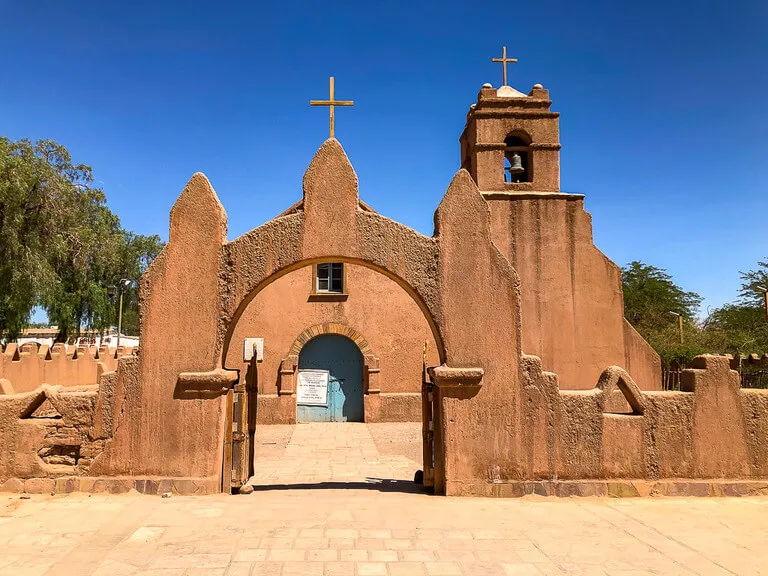
Surrounded by unimaginably stunning vistas, volcanoes, lagunas and salt flats lies the beating heart of tourism in the Atacama Desert: San Pedro de Atacama. And we have the perfect itinerary for your visit.
Whether you intend to hire a vehicle or book entirely with tours, you will be blown away by unique landscapes you never knew existed on our planet.
No matter how you plan your itinerary (and we will help you in this article), one thing is for sure: the curious adobe village of San Pedro de Atacama will be your base.
Imagine our solar system as the planets orbit the Sun. In the Atacama, San Pedro is the Sun and the planets are all of its attractions (except they’re not moving!).
Using an astrology reference here was by design, because as you will discover, the Atacama is famed for its extra-terrestrial topography and has some of the best stargazing on our own planet, Earth.
Are you planning a visit but can’t make your mind up about hiring a car and DIYing it? Or do you plan to book a tour to take the stress off? How many days do you actually need in San Pedro?
What about following the Atacama with a legendary Bolivian salt flats tour from San Pedro to Uyuni?
We have all of these answers. In addition, we have crafted some example itineraries for visiting with or without your own vehicle.
Getting To San Pedro De Atacama
Calama airport.
Calama El Loa is the major airport near San Pedro.
If you’re traveling North up the continent from Patagonia, you’ll need to fly from Punta Arenas to Santiago and change flights there. From Santiago, you can fly directly into Calama airport. If flying South from Lima, Cusco, La Paz, etc., you might have to fly to Santiago first and then back up to Calama.
Chile is a very expensive country to travel in South America when compared to the likes of Bolivia. However, that does not include flying!
There are airlines that offer incredible value on flights (we flew from Santiago to Calama for under US$15 each). Check out SKY, Latam and Jetsmart.
Easier yet, jump on Skyscanner and let the search engine do the hard work.
Top-tip : Check each airlines baggage policy carefully. If you’re backpack is borderline too big for the ‘carry on’ basket, pre-pay to check it and save your money.
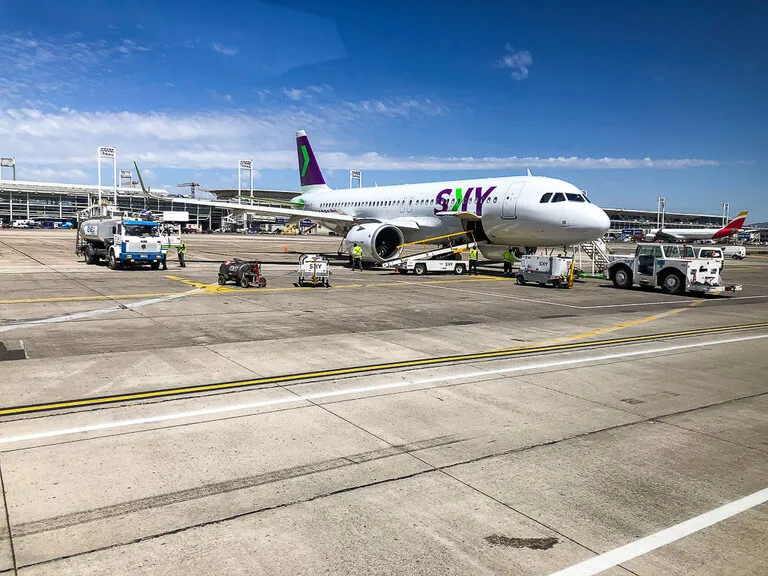
Once you arrive at Calama, you have 3 main options:
1). Pick up a hire car immediately at the airport
2). Take a bus to Calama town then pick up a hire car
3). Take a bus service directly from the airport to San Pedro if you don’t intend to hire a car. This was the option we chose. You can buy bus tickets right inside the terminal on arrival. There are a few bus companies so be sure to compare prices.
You can hire a car in San Pedro but we wouldn’t recommend it, keep reading to find out why.
A popular route is Salta to Atacama by bus. The journey takes around 12-13 hours and remember you will have to cross a border. Also, the altitude will reach around 4,200m at the Paso de Jama so be aware of altitude sickness.
Here’s the Andesmar website to check times/prices.
Already been on your Bolivia salt flats tour as a roundtrip in Uyuni, Bolivia and now want to get down to San Pedro? There’s a 12 hour bus you can jump on that leaves twice a day.
This is the Tickets Bolivia website for more info.
If you really don’t like flying (there are some thermals up in the Atacama so it can get a bit rocky) then you could take a 22 hour bus from Santiago instead.
The bus is more expensive than flying and takes a lot longer but it’s an option nonetheless. Check out Busbud’s website for details.
There are also less painful buses from much closer Antofagasta and Iquique (which may require a change in Calama).
If you’re driving around Northern Chile, Antofagasta is a 3h 40m drive and Iquique is 5h 50m from San Pedro de Atacama.
Hire Car San Pedro De Atacama
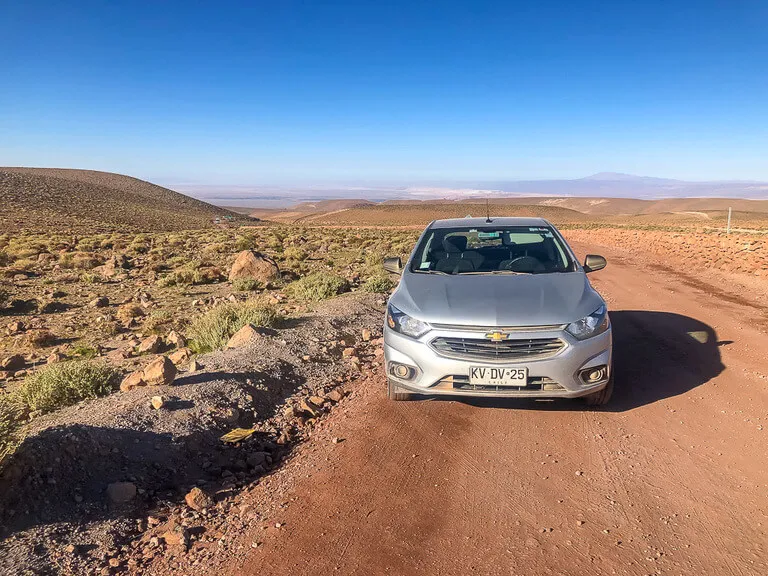
If you are thinking about hiring a car when you visit San Pedro de Atacama, our advice is to decide as early as possible. We know it’s not always easy to plan in advance but you will save money if you do.
There are one or two car hire places in San Pedro itself (like Europcar ), but your best bet is to hire at Calama airport. There is more availability (ie choice of vehicle) and more competition which keep the prices down.
Alternatively, you could take a short bus from the airport to town and hire a car in Calama. ACE, Econorent, Avis, Hertz and Europcar are some of the car rental companies available between the airport and town.
We would suggest looking online at car rental search engines such as rentalcars.com a month or so before you intend to arrive.
If you leave this decision any later, you risk no 4×4 or 4×2 trucks being left; or worse, no availability at all (especially in high season, December – February). Unfortunately, we know from experience!
We’d been hiking in Patagonia for 2 weeks, then recovering (read: eating and drinking, a lot!) in Santiago for 4 days. Mistakenly, we neglected planning the Atacama as thoroughly as we did Patagonia.
This resulted in hire cars costing in the region of US$ 1000 for a week at Calama airport in February.
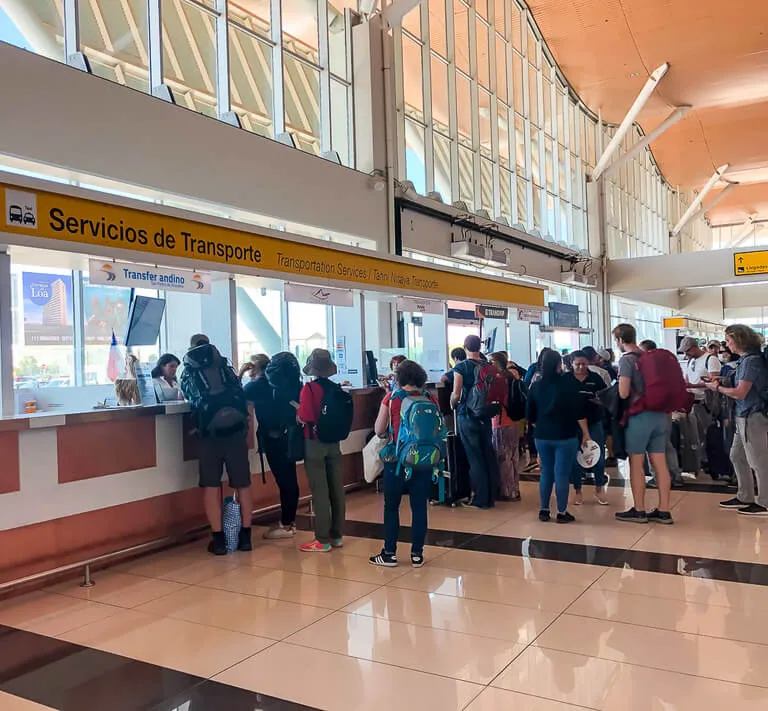
Things to Remember:
1 – You will save money by shopping around and being flexible with your dates. 2 – Only rent a hire car if you are a confident driver. Most roads are fine, but it is a desert after all. 3 – San Pedro town is a pain in the ass to drive around. It’s full of one way streets. No one has a clue. 4 – Not a fan of manual/stick? The earlier you book, the more chance you have of picking up an automatic. 5 – If you plan on hiring mountain bikes or sand boards, select a car with enough room for those bad boys! 6 – When you leave Calama and/or San Pedro, make sure you fill the tank up. Extra fuel will never hurt.
Camper Van Hire San Pedro De Atacama
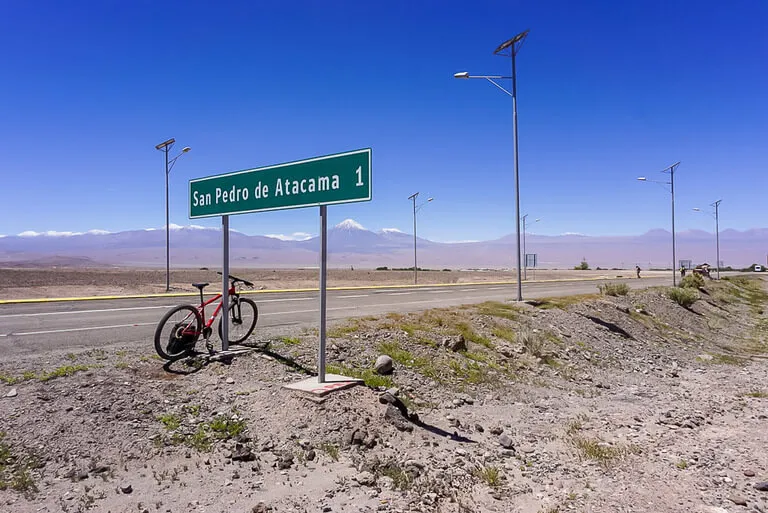
One of the more popular ways to visit the Atacama Desert is to scrap the idea of a hire car and tours altogether. By hiring a camper van, not only do you have your own transportation to see the top sites, but you also have accommodation checked off the list.
And let us tell you, accommodation is not cheap in San Pedro. You will be able to explore the region at your own pace and sleep anywhere you want, underneath one of the best night skies in the world. Pretty damn adventurous!
Wicked campers are the most popular in the region. We saw a few but not as many as we expected. You have the option between 2, 3, 4 and 6 seater campervans with Wicked.
However, there is a bit of stick directed at Wicked for sometimes using profane artwork on the exterior of the campers.
Alternatively, you can ask locals or fellow travelers in other parts of South America for independent companies who run smaller camper rental enterprises.
We met a few people in San Pedro who were offered good deals in Santiago. It pays to ask. It also means supporting local businesses, which is always a winner.
Downsides? They are expensive! Be careful with basic entry level campers, they might not have AC (which would be DEFCON 1 level bad) or they could be in shitty repair.
No one wants to break down in the middle of the driest desert in the world, do they? Think about comfort, do you think you can cope with the heat of day and cold of night for 4 or 5 days?
Honestly. Where will you shower? We toyed with the idea but ultimately plumped for the comfort of a hotel room with AC and bathroom.
San Pedro De Atacama Without Vehicle
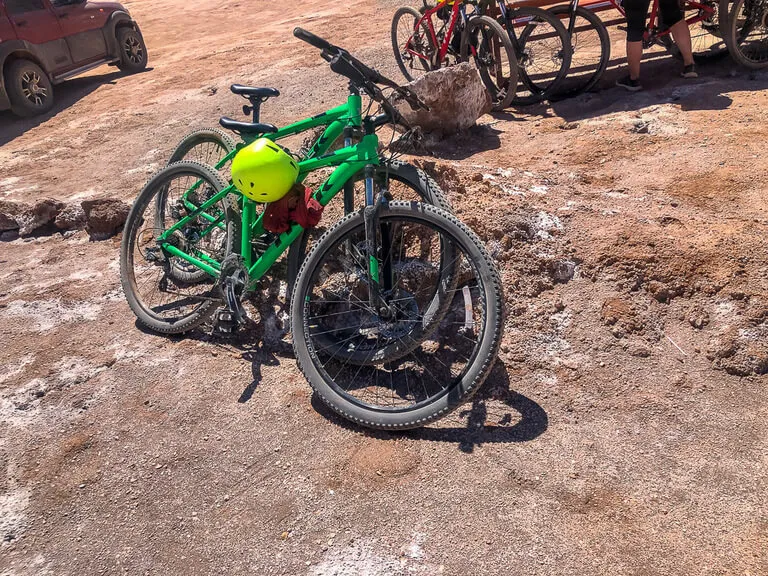
Your third option is to book tours and use the power of your legs. We ended up doing it this way because we were too late trying to rent a hire car and the price was exorbitant.
We also were lucky that we met a great couple at our hotel and toured around in their hire car with them (Hi Sam and Anthony!).
By going this route, you’ll need to jump on the bus from Calama Airport to San Pedro. It’s 12,000 CLP (US$ 15) one way or if you intend to go back to Calama Airport after San Pedro, they have a return for 20,000 CLP (US$ 25) both ways.
Think about which places you really want to visit in the area an d try to be a little organized if possible to make the most of your time.
We were wrecked after hiking in Patagonia for 2 weeks so we dropped the ball a bit, which is very rare for us. San Pedro is expensive. Don’t waste money by being unorganized like we were .
Here’s one way of looking at things: If you drop US$ 300 on a hire car or (a lot) more on camper, you will feel like you need to make the most of that money, right?
So, you’ll be running around on a crazy ticking off spree.
By scrapping the expensive vehicle, you can take it a bit easier and cover all the sites properly. If you would be happier just chilling and jumping on a few tours, this is your option.
San Pedro de Atacama Tours
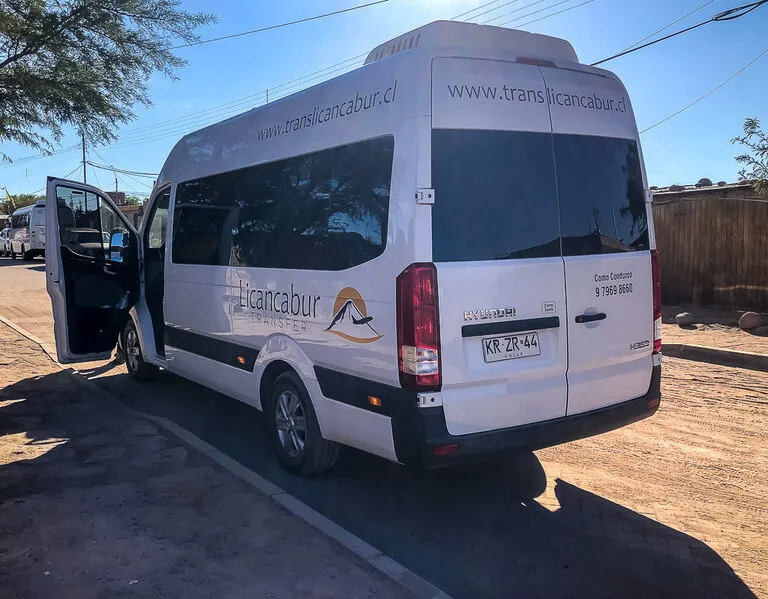
The drawback with this option is you are bound by tour times and schedules. Before you arrive, accept that you will have to book some tours.
As a result, it will make parting with your cash easier (and less begrudging)!
It’s impossible to successfully tick off every place on your San Pedro de Atacama itinerary without booking tours if you don’t hire a vehicle. There are only a few attractions within cycling distance.
As part of our San Pedro de Atacama itineraries, we will make suggestions for tours that you should consider. You can either book ahead or book when you arrive in town.
Honestly, there’s not much difference and it’s completely pot luck how a tour turns out.
You could end up with a conscientious responsible driver with other awesome tourists on board. Alternatively, you could look for hours at reviews, pick the best looking one, inevitably pay more and then have a tour from hell.
It’s pot luck. Unfortunately, we have experienced both here.
It might feel like we’re coming in hot with tours on this itinerary, but they are included for your benefit. Use the tours that we suggest for information. Look through the schedule they provide.
You don’t have to book any of them but at least use them to piece together an itinerary for your trip. Our suggested itineraries are suggestions only, but also use them as guides to help build around your preferences.
How Many Days In San Pedro De Atacama?
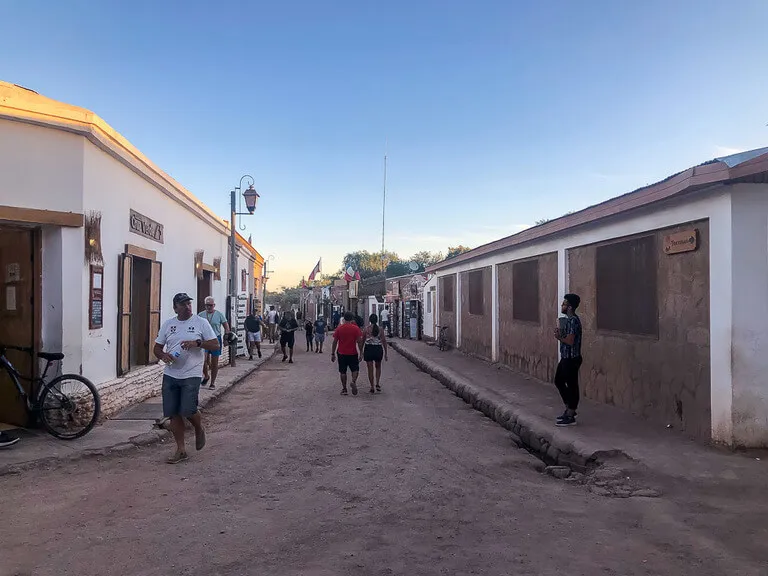
This is a good question with a whole host of answers. It depends on factors such as your budget, how much you want to see, whether you intend to go on a Bolivia salt flats tour (or already have) and whether you have a vehicle.
Taking all things into consideration, we would suggest 3 full days as the optimal amount of time to spend in San Pedro.
Why? Because attractions, accommodation and food are expensive.
Like, almost Patagonia level expensive. We couldn’t believe how much of our budget San Pedro crushed. Therefore, the longer you stay, the more money you subtract from your budget.
If you have a vehicle, you can get busy as a bee and nail most of the attractions in 3 days.
Seeing the sites with tours means you’ll miss a few things in 3 days, so if you’re desperate to see everything, it might be worth stretching to 4 days.
However, if you’ve already been on (or plan to go on) a Bolivia salt flats tour, you will see / have seen similar salt flats and Altiplanic landscapes (not exactly the same, San Pedro has some unique vistas).
That’s not to take anything away from the Atacama, it’s just something to bear in mind for those on a budget.
Two days isn’t nearly enough time to see much in the area. Only the super efficient people who can function with little sleep would have a chance making it worth the visit.
Spreading your visit to 5 days means you’d get to see more plus slow down and enjoy being in the desert, without being on a ticking off mission. But you’d need a hefty wallet depth.
In addition to the itineraries below we have written a separate article simply to discuss each fantastic thing you can do in the Atacama Desert in far greater detail. Be sure to check out our 20 Best Things To Do In San Pedro De Atacama article .
San Pedro De Atacama Town
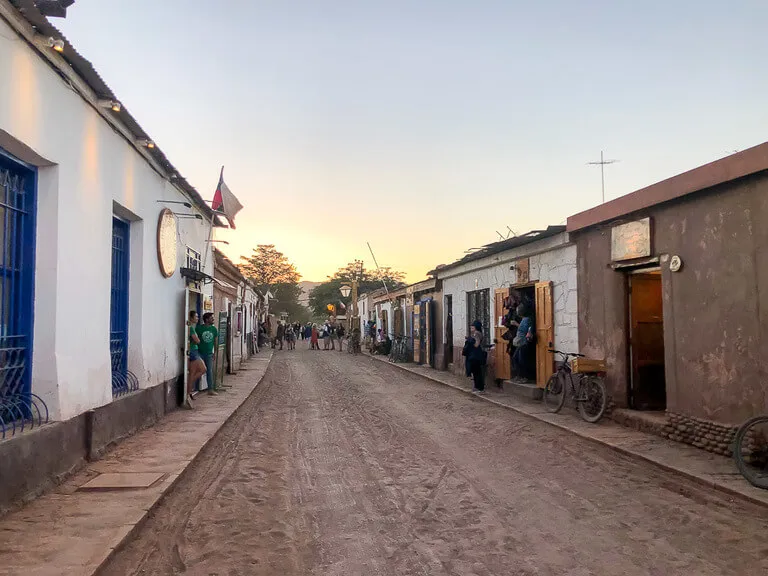
What can you expect from the epicenter of activity in the desert? Well, don’t expect a stereotypical oasis. San Pedro is far from lush green trees encircling a turquoise pool, surrounded by silky smooth and golden sand dunes.
You will find a once ancient town filled with Atacamenos, transformed to a modern day tourist-centric theme park. It has the feel of Interlaken in Switzerland, except you’re surrounded by sand and dust instead of trees and snow.
What do we mean?
Both towns are saturated with an eclectic mix of international tourists who will only be in town for a few days before moving on.
San Pedro’s town is based around one Main Street, Caracoles . The terrain is quite rocky, which means the roads are made from mud. The white, dusty, one story buildings often turn to orange and brown as the dust is kicked up by cars and bikes.
You will be amazed by how many tour agencies are on Caracoles. More than your country has names in its phone book .
So why the popularity?
Because visually stunning Altiplanic Lagoons, Salt Flats and Geyser fields all within a short drive of the hub that is San Pedro. Moreover, the town is flanked to the East by towering snow capped volcanoes.
And despite the hordes of tourists, San Pedro has managed to retain some of its charm. There are hidden gems if you look hard enough. An example is Emporio Andino empanada cafe, the best empanadas in South America.
San Pedro’s major drawback? It will burn a deep hole in your pants. A very big hole.
Accommodation In San Pedro De Atacama
On a tight budget? It’s tough to find cheap places in San Pedro but here are a few of the lower priced hotels, with private bathroom!
- Hostal Ayni
- Hostal Ckamai
- Guesthouse Diaguitas
Prefer more comfort without breaking the bank? Here’s some of the best mid range hotels in town.
- Hotel Jardin Atacama
- La Casa de Mathilde
- Hoteles Pueblo de Tierra
Here are the most luxurious hotels in San Pedro de Atacama. Enjoy!
- Terrantai Lodge
- Alto Atacama Desert Lodge & Spa
- Tierra Atacama Hotel & Spa
Where Did We Stay?
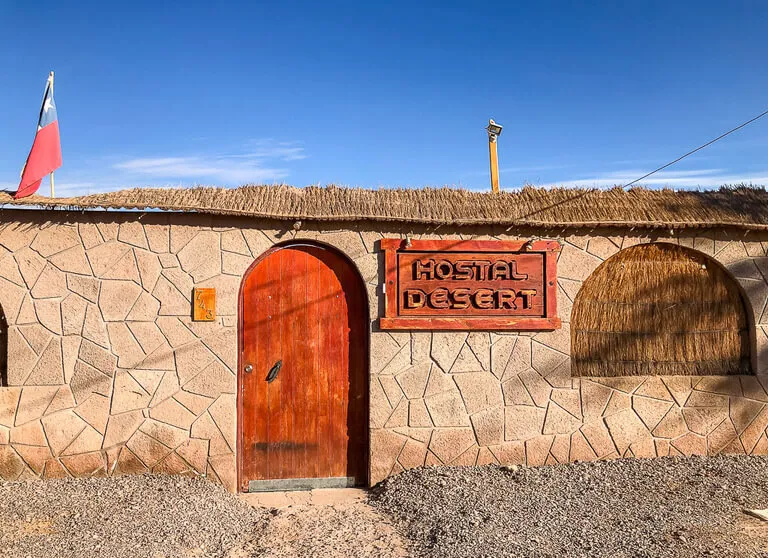
We stayed at Hostal Desert . Like all accommodation in San Pedro, it was expensive!
We were backpacking South America for a few months and couldn’t believe how much money we spent here .
The hotel was great, nice bed and private bathroom. It had a lovely outdoor patio / courtyard with benches and hammocks to relax on.
They also had a small kitchen with appliances to cook food, and provided breakfast items like eggs, tea and coffee for guests free of charge.
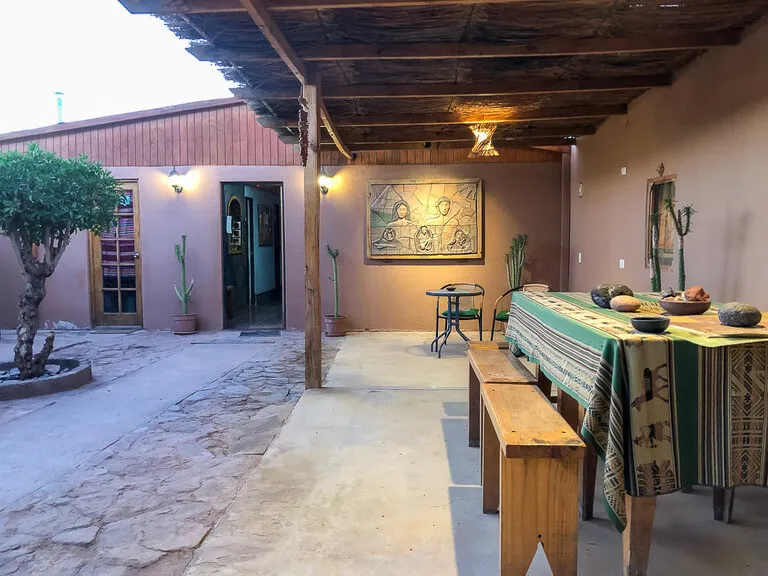
The major downside (other than it not being a luxury hotel with pool & spa!) was that it’s a bit of a walk out of town. It probably took us 10 minutes to walk to the East of Caracoles Street.
For a town the size of San Pedro, we found that quite frustrating. Other than that, our stay was brilliant. We booked late and this was the best place we could find with private bathroom along with an 8.8 / 10 rating on booking.com.
Book your stay at Hostal Desert
San Pedro de Atacama Itinerary With Hire Car / Camper
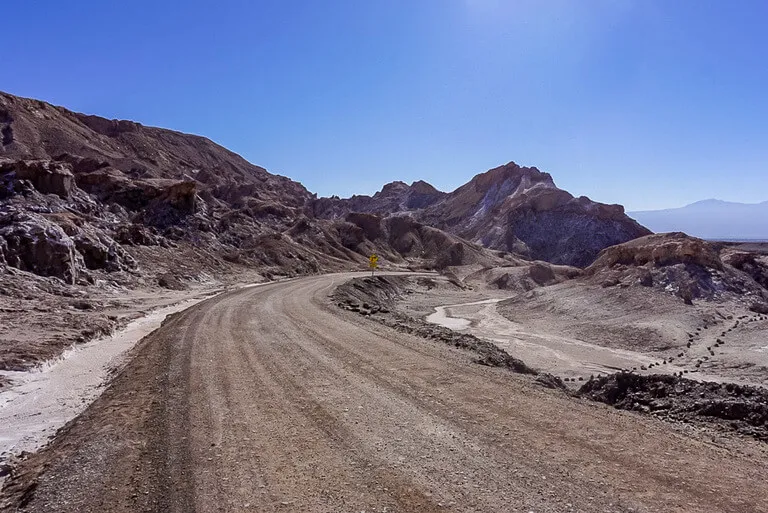
The major benefit to having your own vehicle means you can set off and return when you want. The following is a suggested 3 day itinerary and assumes that you have arrived from Patagonia/Santiago.
Heading straight up into the Altiplano wouldn’t be a good idea, give yourself a few days to acclimatize. That’s why we will begin the itinerary around San Pedro de Atacama (and at similar altitudes).
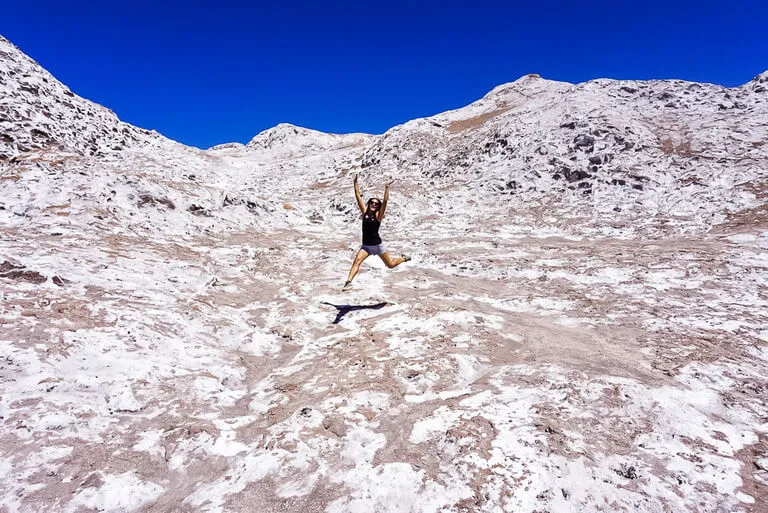
Ready to start your San Pedro de Atacama itinerary? Let’s go! Get an early start, grab a quick breakfast, and be on your way. Drive 1 hour South to Salar de Atacama and Laguna Chaxa.
The early bird catches the worm, right? Wrong. The early bird catches burnt orange hues illuminating the sky over mesmerizing volcanoes and Andes mountain peaks to the East. You’ll have clear views with no obstacles. Wow!
But, you’re not just there for sunrise. Early morning is the best time to see the various species of Flamingo at Laguna Chaxa feeding on small sea monkeys (shrimp) which gives them their pink color.
Spend some time walking around the area enjoying the views over the Salar before heading back towards San Pedro, taking a left shortly after Los Pantanos.
This will lead you to Lagunas Tebinquiche, Cejar and Baltinache. If you’re not planning to do the Bolivia Salt flats AND the ground is completely dry, make the extra effort to reach Tebinquiche.
You’ll get chance to see those famous salty hexagons. Otherwise choose between Lagunas Cejar and Baltinache to go for a dip! Cejar is more expensive and will be busier so we would recommend Baltinache.
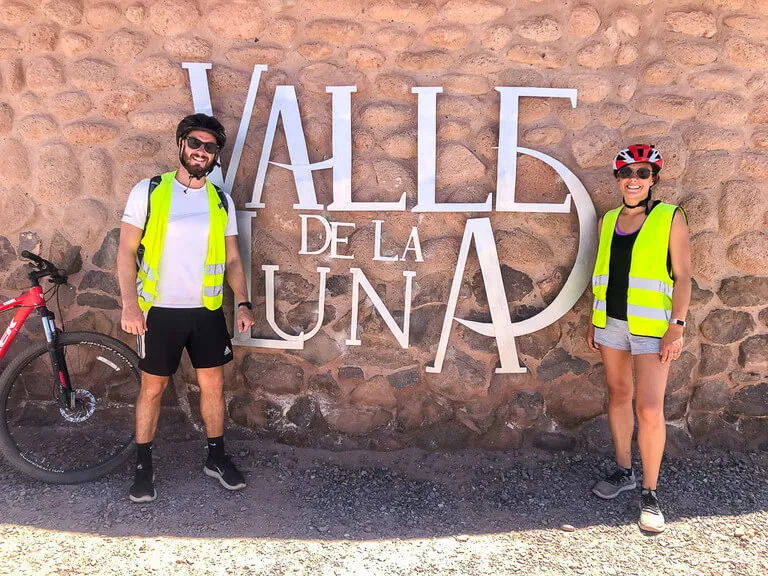
Afternoon / Evening
When you’ve finished floating in the (extremely) salty water, wash off thoroughly (otherwise you’ll turn into a piece of cardboard!) and head back to San Pedro town for a bit of admin.
Pick up an empanada or 10 at Emporio Andino (first building on the West of Caracoles Street) and refresh with a fruit smoothie. Next, make your way East along Caracoles to the Sandboard hire place.
Stick a few of those in the car/camper – they’re for Day 2, but you’ll have an early start in the morning. One last thing while in town, book your stargazing tour for Day 2 at SPACE (all the way to the East of Caracoles).
It’s time to take one small step for man, one giant leap for mankind at Valle de la Luna. Now, even though you do have a vehicle, we would recommend you hire a mountain bike for 6 hours (we rented from Los Alpes, 6 hours for 3,000 CLP / US$4).
It will take you 6 hours to ride in, explore the area, have your mind blown by the landscape, watch one of the best sunsets you’ll ever see and then ride back to town.
Not up for cycling? No problem!
Drive over, explore, watch the sunset and head back to town. That’s the end of Day 1, time for dinner.
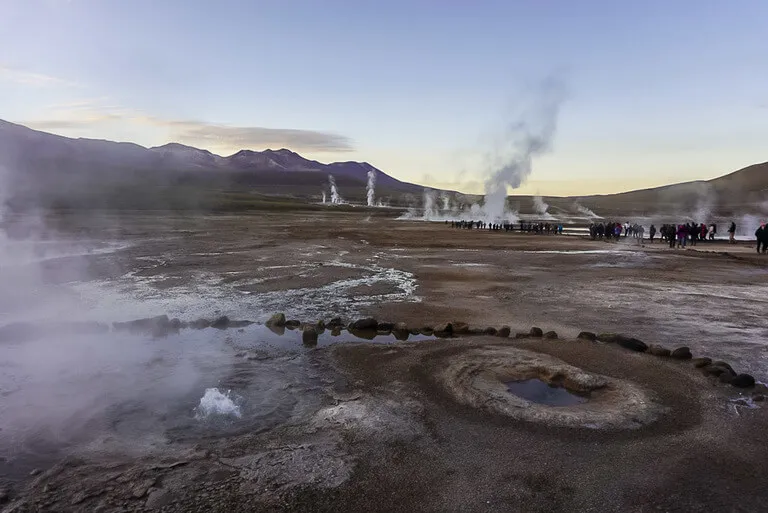
If you found the early start yesterday tough, today won’t be much better! You’re making your way up to see the sun rising across the third largest geyser field in the world. It’s a 50 mile (80km) drive and will take you around 1h 30m to 1h 45m.
Check sunrise times the night before and set off at least 2 hours before that time. Why 2 hours? Because it’s pitch black, the roads are windy and are little more than dirt tracks at times. You also need time to pay at the entrance before making your way onto the geyser field.
Download the route to your phone before you set off. The service isn’t great. However, it’s hard to get lost, just follow the B-245 (and the tour buses!). Check sunrise times throughout the year.
Make sure you take some extra warm layers, it will be cold up at 4,200m (13,800 feet)! Plus don’t forget to drink plenty of water to combat the effects of altitude sickness.
It’s worth sticking around for a few hours on the geyser field, wait for the sun to rise fully and warm up. When you’re ready to leave, it’s time to warm up properly!
Drive slowly back the same way, take in the scenery (it’s amazing what you miss when you drive in the darkness!) and when you get to Guatin, take a left turn that’s almost like doing a U turn.
The road here gets pretty sketchy so drive slowly and carefully. After about 3.5 miles (6km) you will reach the car park for Termas de Puritama.
Spend the rest of the morning relaxing in 8 Atacama thermal pools of varying temperatures. There are changing rooms on site so don’t forget your swimsuits! Find the first pool with a little waterfall, it’s the best spot.
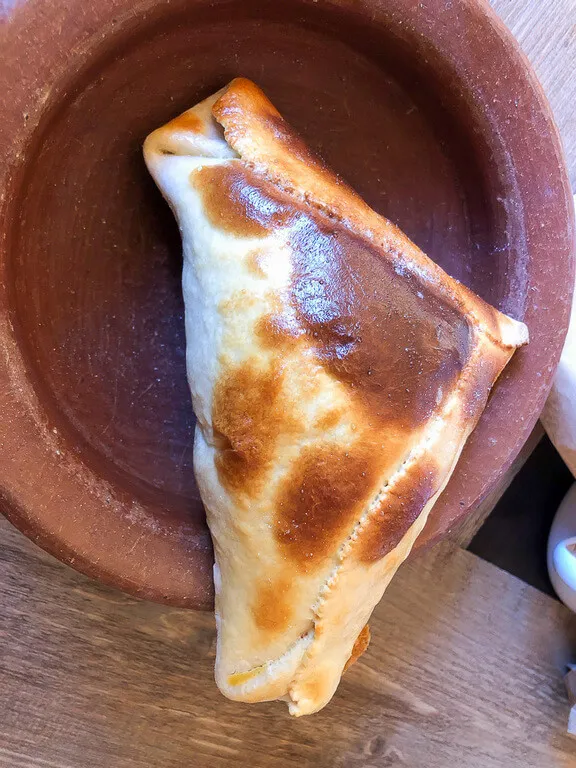
Replenished and ready for more Day 2 action? Drive back to town, grab lunch (we challenge you not to go back for more empanadas!), then take road 23 West as though heading back to Calama and turn right at B-207.
Half an hour later you will arrive at Valle del Arcoiris, or rainbow valley. There a few hikes here taking you around the display of unusual colors in the rock and ground.
A few miles South you will reach Yerbas Buenas petroglyphs. Reviews of the petroglyphs are fantastic as they are spread over quite a large area and feature a range of animals.
Drive back to towards San Pedro but stop at Valle de la Marte just before town. It’s time to put those sandboards to good use (you could go into town to hire them now rather than pay for the extra day, just a bit less convenient).
Walk around Mars Valley, enjoy the colors of the red rocks as the sun becomes low in the sky … and then crush some dune boarding!
If sand boarding is not your cup of tea, quickly walk around Mars Valley (it won’t take long) and drive a short distance to Pukara de Quitor for some education and culture.
Grab an early dinner and meet for your stargazing tour on the corner of Caracoles and Ignacio Carrera Pinto. The tour was one of our favorite parts of visiting the Atacama.
You’ll see the stars like you’ve never seen them before (and learn all about the universe!).
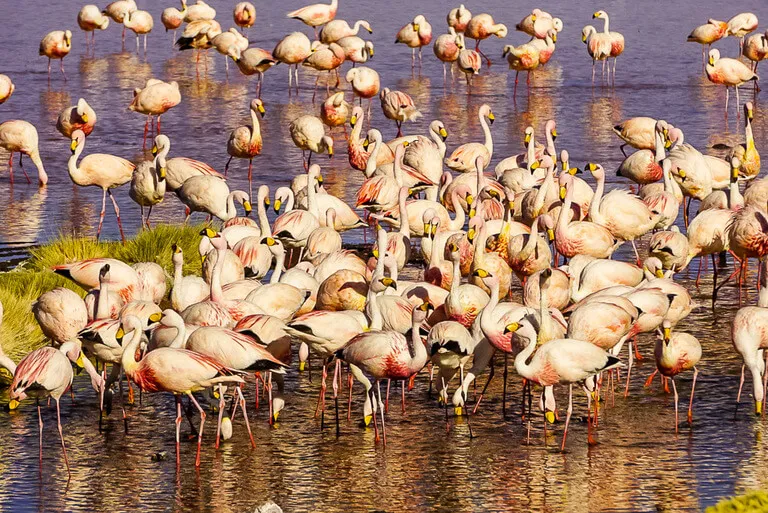
You’re entitled to a sleep in on Day 3. But you’re not getting one! You have a 2h 45m drive to get on with! It’s going to be another long day. Take road 23 South and don’t stop until you reach Piedras Rojas, which is the gateway to Salar de Talar.
Although you can no longer go on the red rocks, it’s still worth taking the trip to see the salt flat surrounded by volcanoes at 4,000m (13,000 feet). The colors on the salt flats and surrounding geological formations are special.
A little further on is Laguna Tuyajto, which not many tours go to. It could be a good place to escape the crowds and watch Flamingoes again.
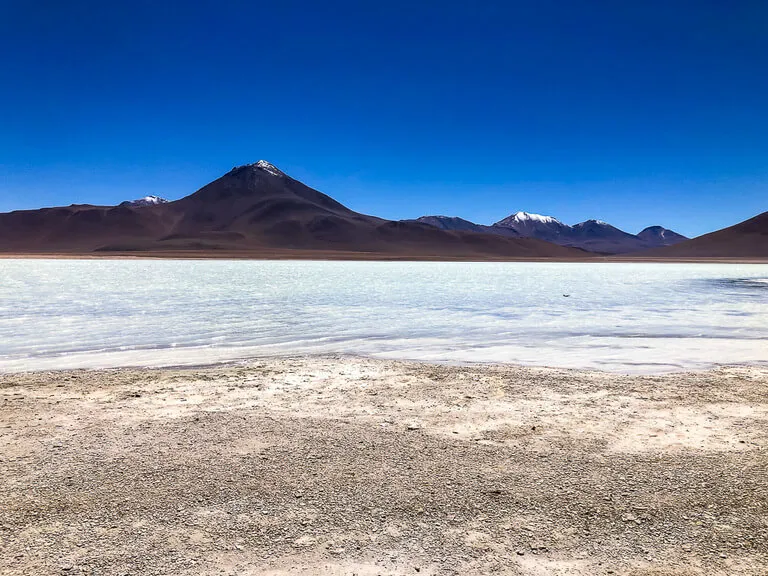
Start back up 23 North, this time stopping off at the stunning Altiplanic Lagunas Miscanti and Miniques. This is another awe inspiring landscape that fools you into thinking you must be looking at a giant screen with a science fiction movie showing.
This is the last stop on your San Pedro de Atacama itinerary. The drive back should only take an hour, but you’ll be exhausted!
Remember these Lagunas are really high and you’ll need to take precautions against altitude sickness. It would be a shame to drive all the way up and have to leave early.
An alternative to this day would be to head East on road 27 instead. This will take you to Salar de Tara / Aguas Calientes, which is equally as beautiful as the other places on Day 3.
Research both places before you head out to see which looks more up your street.
San Pedro De Atacama Itinerary Without Hire Car / Camper
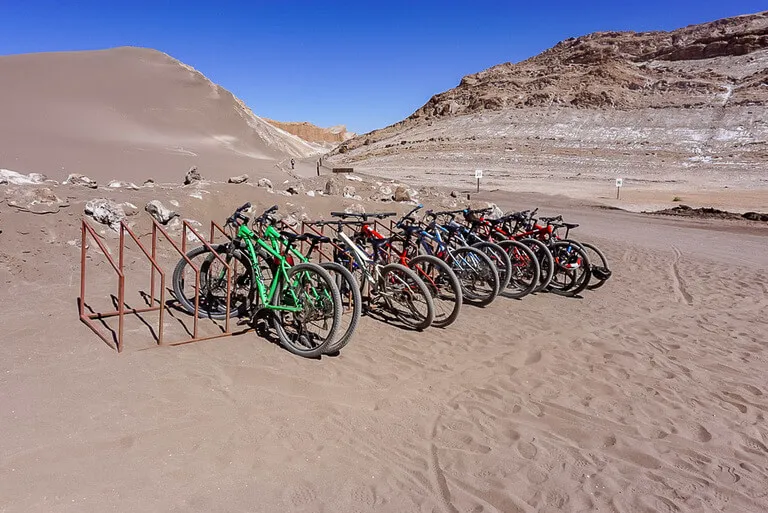
Okay, so what if you don’t want to hire a car? It is expensive after all. And maybe you prefer to be selective about exactly what you want to do.
As we mentioned, when you’ve dropped US$300 on a car for 3 days, you will push yourself to get the most out of your money and that can be exhausting.
Well, you can relax. Only pay for the tours you really want to go on. The downside is that there’s not much you can do without taking a tour, unless you meet some awesome people who have a car, like we did!
Take your budget into consideration. San Pedro is one of the most expensive places you will visit in South America. It won’t always be this expensive.
If you’re concerned about blowing your budget on paying for tours, we suggest you spend fewer days in town but go on more tours with the money you will save. Accommodation and food are expensive, while tour prices are pretty good value.
Here’s an example of what you can do in 3 full days around San Pedro.
Remember we will be firing tour suggestions at you, use them for information to sculpt your own San Pedro de Atacama itinerary. You can book none, just a few, or all of them depending on your budget and what you hope to see!
If you’re an active and adventurous traveler who likes to keep fit when traveling, hire a bike and cycle around the Valley of the Moon! Check out our extensive guide Valle de la Luna: Orbit by Apollo Mountain Bike !
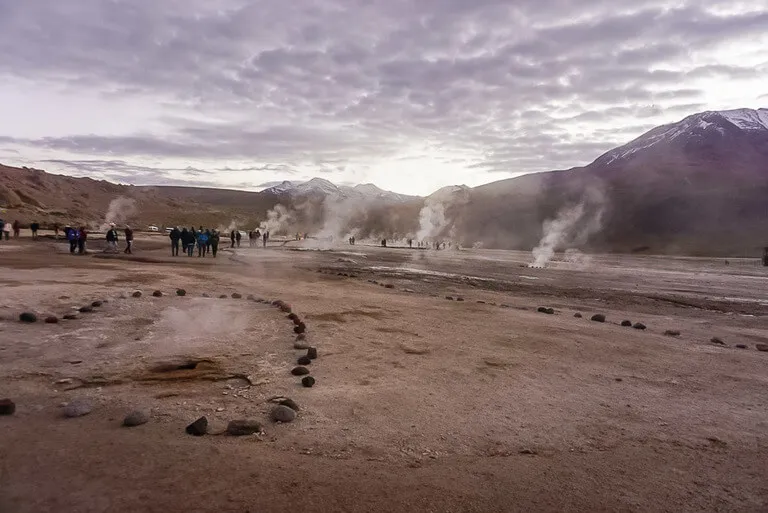
Rise and shine for a 4.30am pick up! Take the early tour up to El Tatio Geyser field. This would obviously need to be booked in advance online (or in San Pedro if you arrive the night before).
The tour will only cost around US$ 20-25. Keep in mind, you will still have to pay the 10,000 CLP (US$12) entrance fee. In truth, $20 to be picked up from your hotel and dropped back in town is pretty good value.
It saves you driving the hour and a half plus the time back. You’ll also see the roads aren’t in the best shape.
This 7 hour tour includes hotel pick up and drop off, swimming in a thermal lake on the geyser field, flamingo spotting in a lagoon, a bonus waterfall hike and most importantly – breakfast!
This is the perfect alternative to hiring a car and driving the 2,000m altitude gain. But it means heading up into altitude sickness territory on Day 1. Drink plenty of water and chew on the coca leaves!
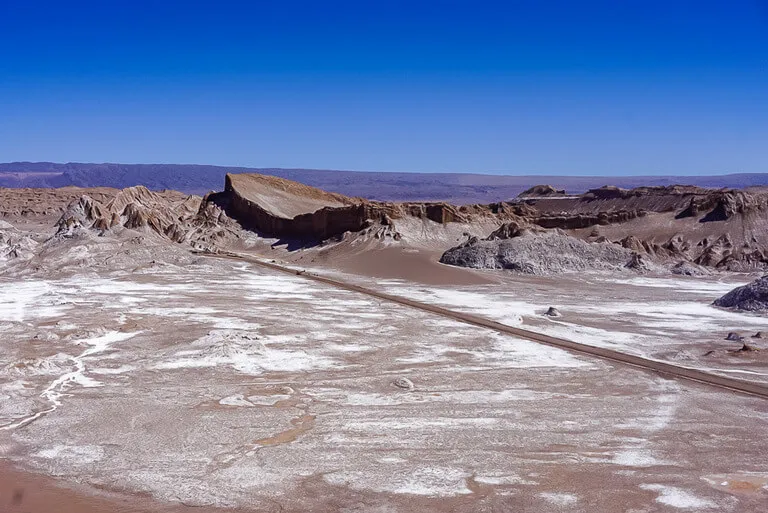
Once you arrive back to San Pedro, treat yourself to a visit to Emporio Andino and the best empanadas this side of the Sun. Don’t worry, you can burn the calories straight off by hiring a mountain bike and cycling over to Valle de la Luna.
You won’t have trouble finding bike hire, just make sure you try the bike out first. Check the gears and brakes, listen to the chain. If it it squeaking? Be sure to get another bike!
This is one of the only things you’ll be able to do by yourself without a tour. The journey is hard but damn, is it worth the effort.
If you’re not a huge fan of that idea (it’s probably scorching hot!), go ahead and book this tour to Valle de la Luna for the evening. You’ll spend time inside a salt cave (in fairly tight spaces!) and see an old disused mine.
The tour will leave San Pedro around 3pm. Any guesses for the hyped about crescendo here? Watching the sunset atop Duna Mayor.
Views from the top are extraordinary, you just can’t miss it. If you’re only going to book one tour, make it Valle de la Luna. It’s easy to get to and won’t cost you an arm and a leg.
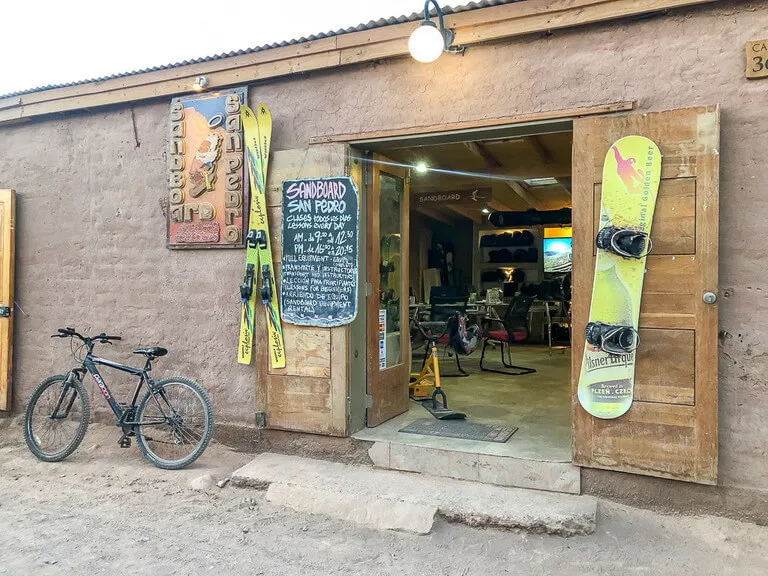
Day 2 depends on your budget and your interests.
Have a more relaxing and budget friendly day. Pick up a Sandboard in town, hire a bike again for 6 hours at 3,000 CLP and cycle over to Valle de la Marte.
You can slide the Sandboard between your backpack straps. You can even walk to Mars Valley in 30 minutes.
For the travelers who have FOMO (fear of missing out) like us, your best bet is to take t his tou r for 7 hours which includes the postcard perfect Altiplanic Lagunas Miscanti and Miniques, Salar de Atacama and Laguna Chaxa.
It does not include Salar de Talar (where the red rocks are – but they were closed at the time of writing) and could (it will be tight) get you back for an afternoon tour.
However, if you’d prefer to just book one huge day tour with no worries of missing the afternoon tour, book one leaving early and lasting most of the day.
A 10 hour tour like this one includes the all of the sites on the 7 hour tour, but also includes Salar de Talar (red rocks). Loads ticked off in one hit.
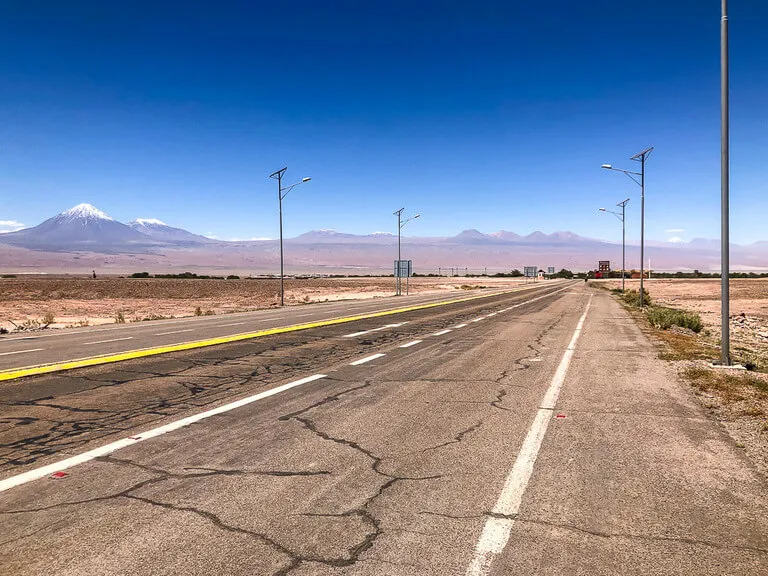
After a chilled and cheap morning, jump on a tour to Lagunas Cejar and Tebinquiche leaving at 2.30pm and lasting 5 hours. The tour takes you to Laguna Cejar, where you float in salt water (be warned, it’s cold!).
Your surroundings?
Flat desert land and native vegetation, leading to salt plains then eventually mountains and volcanoes on the horizon. These special views will add even more relaxation to your already relaxed mind as you float about.
You will then be taken 30 minutes further South to Tebinquiche where you will watch bright pink Flamingos feeding in the evening, just in time for one of the best sunsets in the Atacama.
If you book the 7 hour Salar and Altiplanic Lagunas tour , your day isn’t over yet. You should be back in time to quickly transition onto the Lagunas Cejar and Tebinquiche tour leaving in the afternoon.
Mention that you want to do morning and afternoon tours on the same day when booking. Others will be doing more than one tour a day too.
After a 10 tour you’ll be wrecked and you’ve missed the afternoon tours. If you have the energy, this would be the perfect time to hit the sand dunes with a board at Mars Valley. But leave enough time for an early dinner.
However you decide to spend your day, you have some of the best stargazing in the world to attend to tonight. Book at SPACE on Caracoles, or if you’d like to book in advance onto a different stargazing tour, consider this one .
We can’t recommend a stargazing tour enough, whichever you do will be fantastic. The sky is unbelievably clear here. The Milky Way looks like someone has just etch-a-sketched it into the sky .
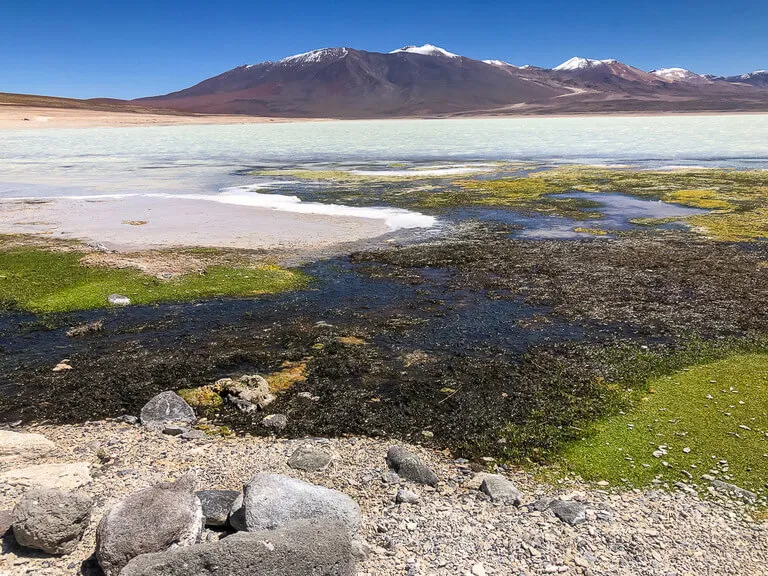
Go out with a bang on your last day in San Pedro by booking this tour to picturesque Salar de Tara . The tour includes hotel pick up around 7am and lasts a total of 8.5 hours. Salar de Tara is one of the more beautiful landscapes in the whole region.
The salt flat is encircled by towering volcanoes and Andes mountain peaks. If you stay long enough you will see the colors of the mountains and salt flats change as the position of the Sun moves from East to West.
If another long day touring doesn’t sound like much fun, an alternative is to go on this tour to Rainbow Valley and the Yerbas Buenas petroglyphs .
The tour only lasts 3.5 hours and leaves San Pedro around 8am so you get a bit more of a sleep in. By taking this option, you leave your afternoon available.

If you took the Salar de Tara tour, you won’t be back to San Pedro until late afternoon / early evening. We can rule out any more activities for Day 3. To be honest, you’ll be all toured out by now anyway.
But if you decided to see rainbow valley and the petroglyphs instead, you have options for the afternoon. You could make the Lagunas Cejar and Tebinquiche tour if you haven’t already and don’t want to miss floating on salt water.
Or you could book onto the afternoon slot for the Puritama hot springs tour . Much like the geysers, this one is just transport and doesn’t include entrance fee of 15,000 CLP (US$ 19).
Although a little pricey, we really enjoyed the hot springs. It’s quite a surreal feeling to be in hot springs on a hot day in the driest desert (non-polar) in the world, but still be freezing cold when moving between the 8 pools. It’s the damn wind!
Alternatives For Your San Pedro de Atacama Itinerary
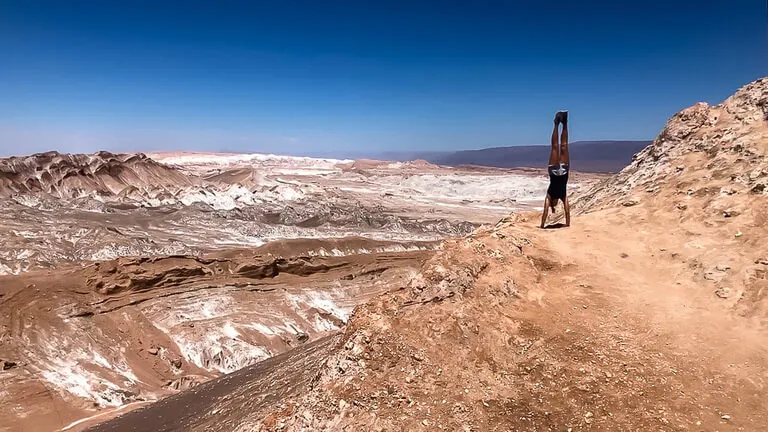
We’ve made the itineraries as logical and efficient as possible. But you might not like the order, or maybe you prefer to do all of your top places first to guarantee you don’t miss out. That’s fine!
There are plenty of other activities to consider on a San Pedro de Atacama itinerary.
We didn’t include takin a hot air balloon over the Atacama Desert. You could add this into your itinerary for one of your mornings in place of what we listed above.
The balloon launches before sunrise so you get an incredible spectacle when the sun eventually rises to the East over the Andes.
Are you a big fan of astrology? Or do you just have more interest than the average person about the stars in the sky? If you are in town on a Saturday or Sunday morning, you could book yourself onto a FREE tour of ALMA observatory .
This is where the largest radio telescope in the world scans our Universe for forming stars and the birth of new planets. How. Cool. Is. That. And it’s free!
Read More About Chile …
- Valle De La Luna: Orbit Moon Valley By Apollo Mountain Bike
- The 20 Best Things To Do Around Awesome San Pedro De Atacama, Chile
And that’s the perfect San Pedro de Atacama itinerary !
Did you visit San Pedro de Atacama? Which itinerary did you go for?
If you need any help planning your trip to San Pedro de Atacama or Chile, please just let us know in the comments below.
Happy Travels ,
Mark and Kristen
Like This Post? Pin It For Later!
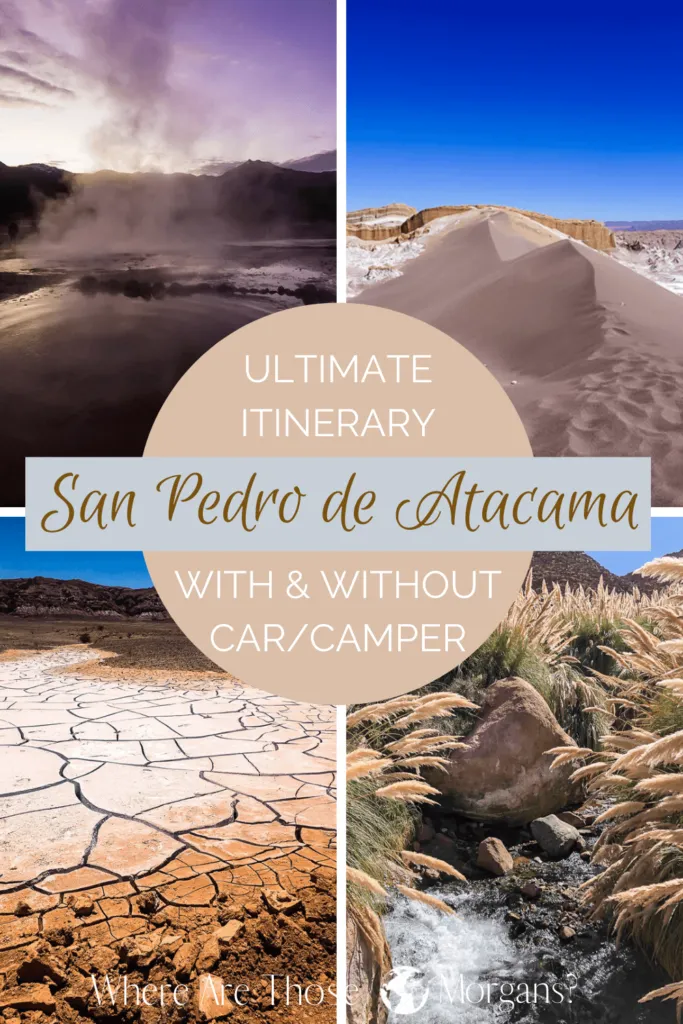
Note : This article contains affiliate links. When you make a purchase using one of these affiliate links, we may earn a small commission at no extra cost to you.
All Rights Reserved © Where Are Those Morgans, LLC. Republishing this article and/or any of its contents (text, photography, maps, graphics, etc.) in whole or in part is strictly prohibited.
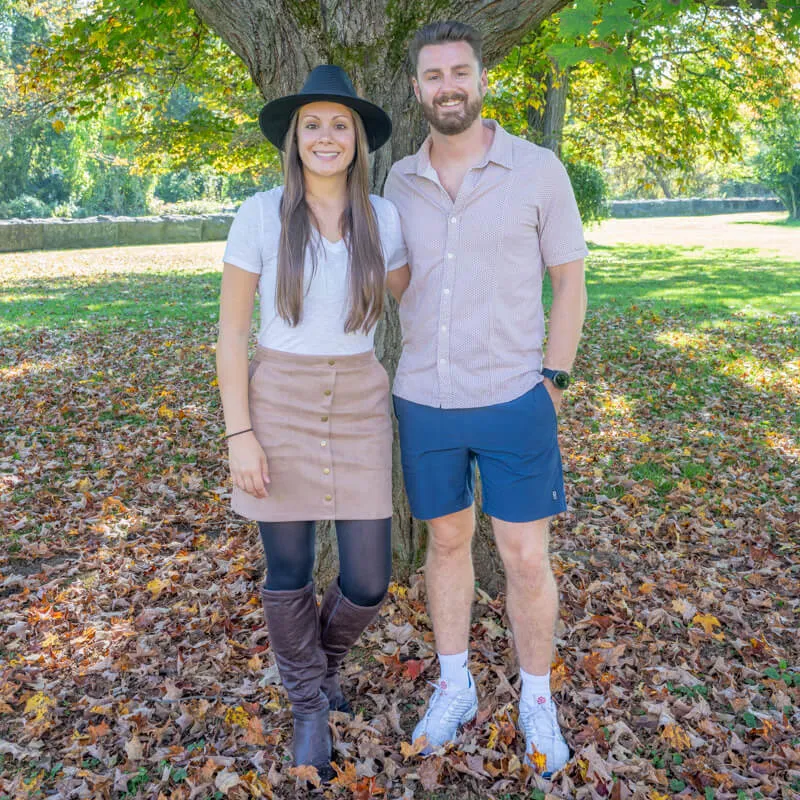
Mark and Kristen Morgan are travel, hiking and photography experts. Over the last 6 years traveling full time, they have explored more than 40 countries and 30 US states.
Where Are Those Morgans has been featured in USA Today, Gestalten, Get Your Guide, CityPASS and Condé Nast Traveler along with various other publications. Read more about us .
4 thoughts on “Perfect San Pedro De Atacama, Chile Itinerary: With & Without Car”
If we are planning to do the Salar de Uyuni tour, which SPA tours are similar and can be skipped? And what is really unique and should be seen even though we are doing Salar de Uyuni?
Hi Charlie, it is worth doing Valle de la Luna and El Tatio Geysers, plus the Stargazing Tour if you are interested. Some of the lagunas that you can swim in (like Baltinache) are worth it because you won’t do that on the Salar de Uyuni tour. Hope that helps and have a great trip to San Pedro de Atacama!
Would you be able to offer the name of tour operators you used in SPA? I am particularly interested in day tours, not multi day. Thanks
Hi Jacob, we rented a car and drove around San Pedro de Atacama ourselves so we don’t have an exact tour to recommend. However, there are many tour operators right in town so you have plenty to choose from when you arrive. The only tour we took was SPACE Stargazing which we would recommend if you are interested in the night sky!
Leave a Comment Cancel reply
Subscribe to our newsletter
Get the latest in travel straight to your inbox
Click here to subscribe

9 Things To Do & Places To Visit in San Pedro de Atacama
San Pedro de Atacama, at 2,400 meters (7,800 ft) of altitude, is a small town in northern Chile, near the Bolivian border. With about 2,500 inhabitants, the city is located in the Altiplano region of Chile, from which you can see some of the highest peaks of the Andes.
Nowadays, San Pedro holds the title of the Archaeological Capital of Chile. The incredible landscapes that surround it, make it the base city to explore the charms of the Atacama Desert.
While the town that acts as a host to exploring the area is quite small, a desert oasis if you will, the area is massive with loads of nooks and crannies to explore. We spent 5 days there and truly feel that we only scratched the surface of all that is on offer.
It’s an extremely fascinating part of the world and when you look at all that is available, an incredibly diverse piece of our planet.
Don’t leave home without: Lonely Planet Chile & Easter Island (Travel Guide)
9 Reasons to Add San Pedro de Atacama to Your Bucket List
Table of Contents
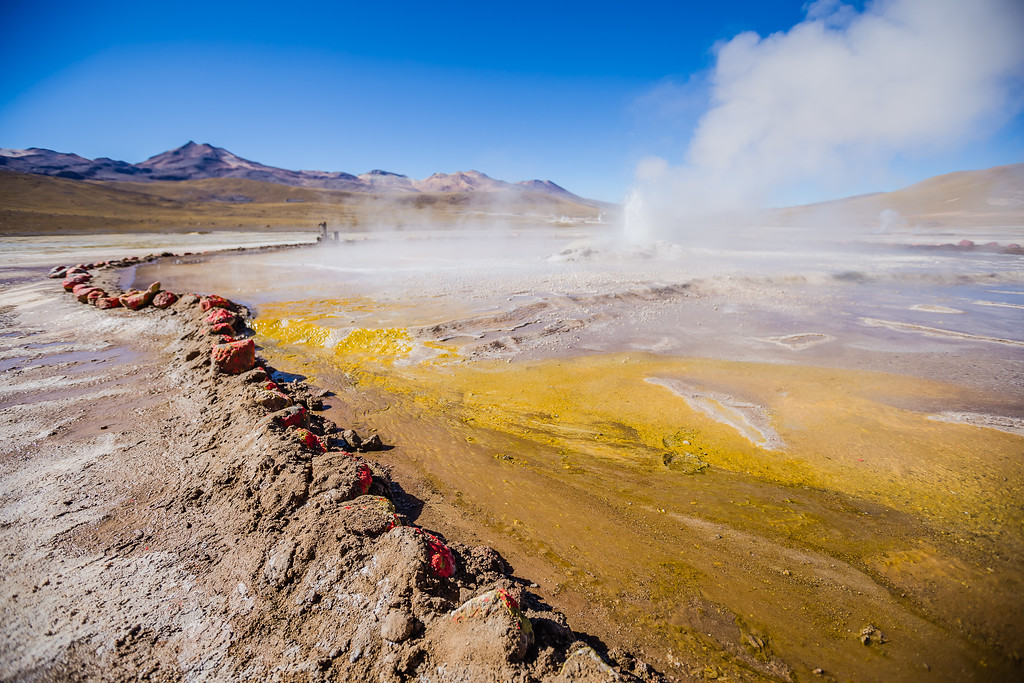
1. Termas de Puritama (3500m/11,500ft)
Here it’s possible to take baths in the warm waters of the Putama Volcano. The eight thermal baths are about 40 minutes from San Pedro de Atacama. It is worth going down and looking at each of the pools until you find the emptiest.
This way, you have more privacy to relax and enjoy. If you have time for a walk, you can venture with Guatin Trekking to get to the thermal baths. This trail takes approximately 3 hours to cover 4 miles of cactus trail.
Simplify transportation logistics between San Pedro de Atacama and the Puritama Hot Springs by booking this guided tour to the popular natural attraction . Hotel pickup and drop-off ensure peace of mind as you travel between destinations, letting you relax and fully enjoy the hot springs experience.
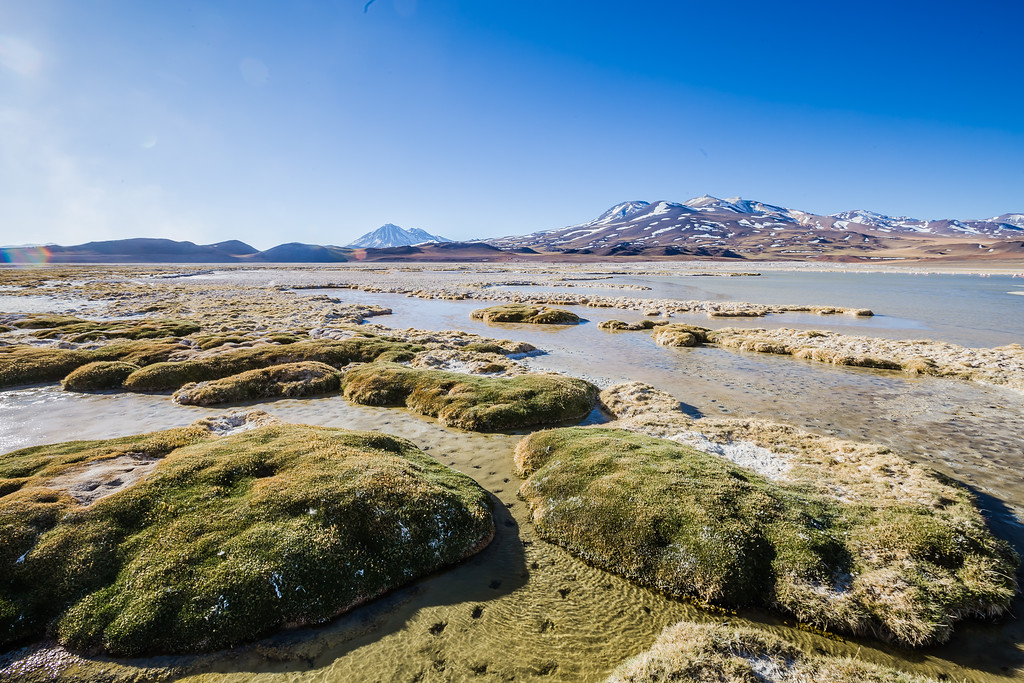
2. Lagunas Altiplanicas (4200m/13,800ft)
This is a tour that starts very early. The first tip for tours that start early is to dress in layers because the desert gets very cold in the mornings. As the sun goes up the temperature will rise, ranging from 5°C to 30°C (41F to 86F).
The Lagunas Altiplanicas is 2 hours from San Pedro de Atacama and the scenery is simply fantastic. The lagoons reflect the design of the numerous volcanoes that surround them.
In this tour, only some lagoons are visited. Laguna Miscanti and Laguna Miniques are connected and receive water from the underground infiltration of rains and hot springs. Some tours also include visits to the Laguna Tuyajto and Laguna Aguas Calientes.
The latter is where the Piedras Rojas is located. These stones have a unique color because of the mineral iron in its composition, which in sunlight, turns red.
From San Pedro de Atacama, it is also possible to visit the less crowded Lagunas Escondidas de Baltinache. The experience is extremely fun since you are allowed to swim in some of the lagoons and it’s impossible to sink due to the high levels of salt in the water.
Book this trip to the heart of the Salar de Atacama, where you’ll see different types of flamingos and Andean birds, in a small guided trekking trip . You will be at the tropic of Capricorn, and two majestic lagoons called Miscanti and Minhique that are nested in the foothills of the volcanoes that bear the same names.
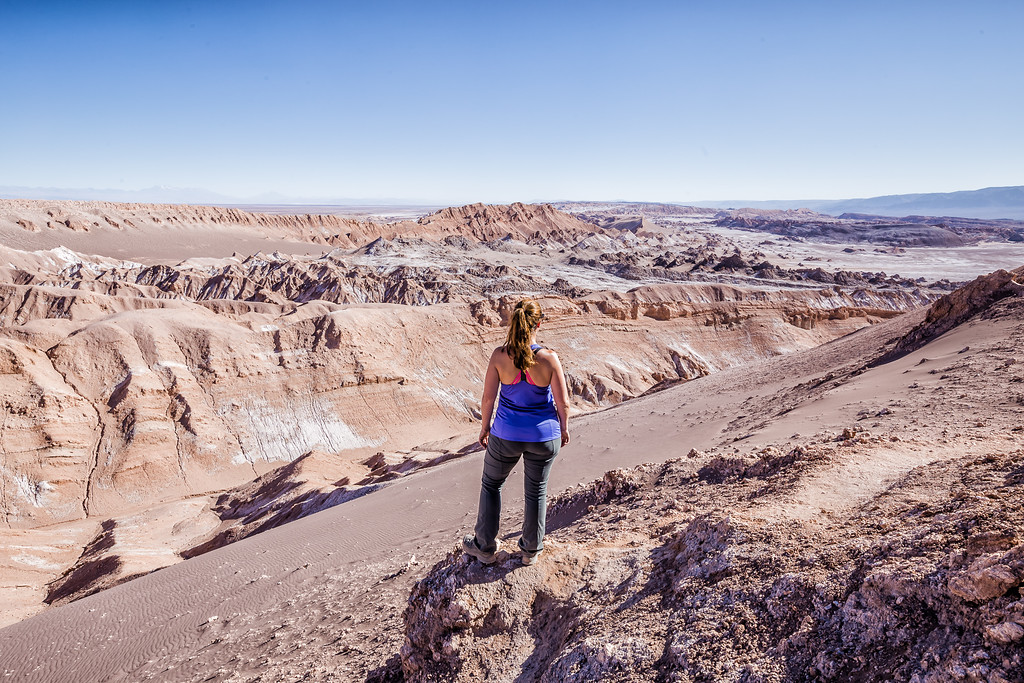
3. Salar de Tara (4,500m/14,700ft)
The Salar de Tara is located 2 hours from San Pedro de Atacama. The region is surrounded by large volcanoes, as well as Laguna Tara and Laguna Negra, covering an eroded area, rolling terrain, and unique vegetation that characterizes the Atacama.
The scenery is beautiful and shows an immensity of the endless desert of Salar de Tara. On the way there, you can observe the stunning landscape and colors. What is most impressive are the monks of La Pacana de Salar, which are high scattered rock formations.
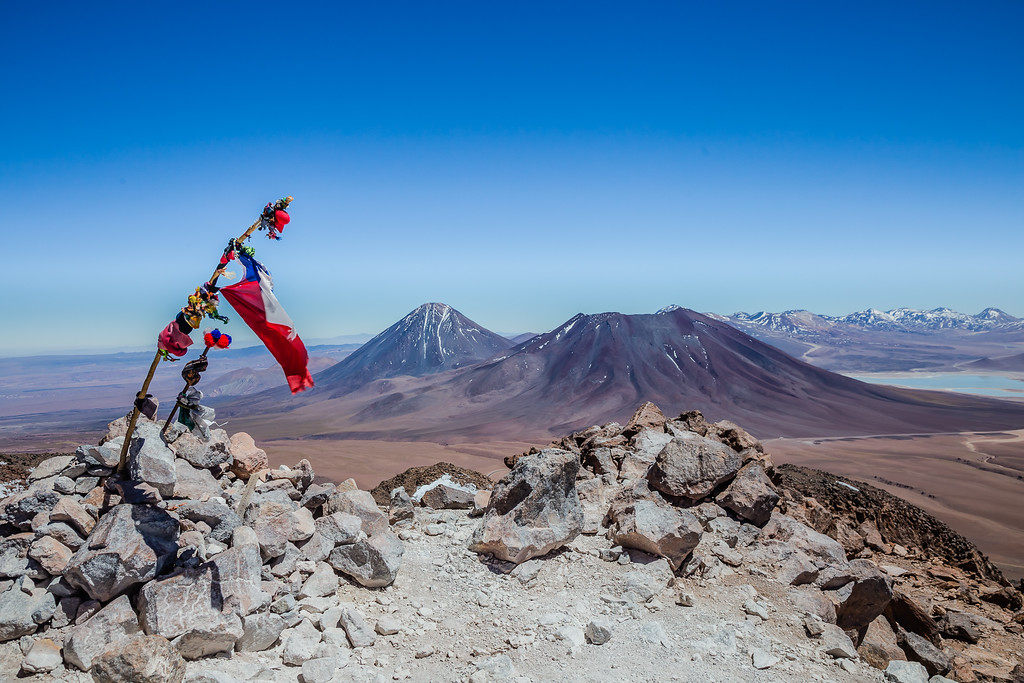
4. Cerro Toco Volcano (5,600m/18,300ft)
Lascar Volcano is considered the most active volcano in northern Chile and can be seen from several points of the Atacama, including San Pedro de Atacama. The climb to the Lascar Volcano is considered an easy level but demands good acclimatization.
At the beginning of the walk, there is an exciting surprise that lights up with the sunrise, Laguna Lejia. The path to the top takes an average of 3 hours and changes as the trail progresses. There are even areas covered in ice depending on the time of year. The reward is an indescribable view of the immense crater beneath you.
Day Trips around San Pedro de Atacama

5. Salar de Atacama (2500m/8,200ft)
Salar de Atacama is the 3rd largest salt flat in the world (behind Salar de Uyuni in Bolivia and Salinas Grandes in Argentina). Within this Salar, there are several attractions, among them is the Laguna Chaxa, the perfect place to see flamingos (it is part of the Los Flamencos National Reserve).
It is also possible to take walks along the open paths in the middle of an immense salt flat. One tip is to be there in time to watch the sunset at the Salar de Atacama. Another amazing attraction is the Laguna Cejar, which is said to have a salt concentration higher than that of the Dead Sea.
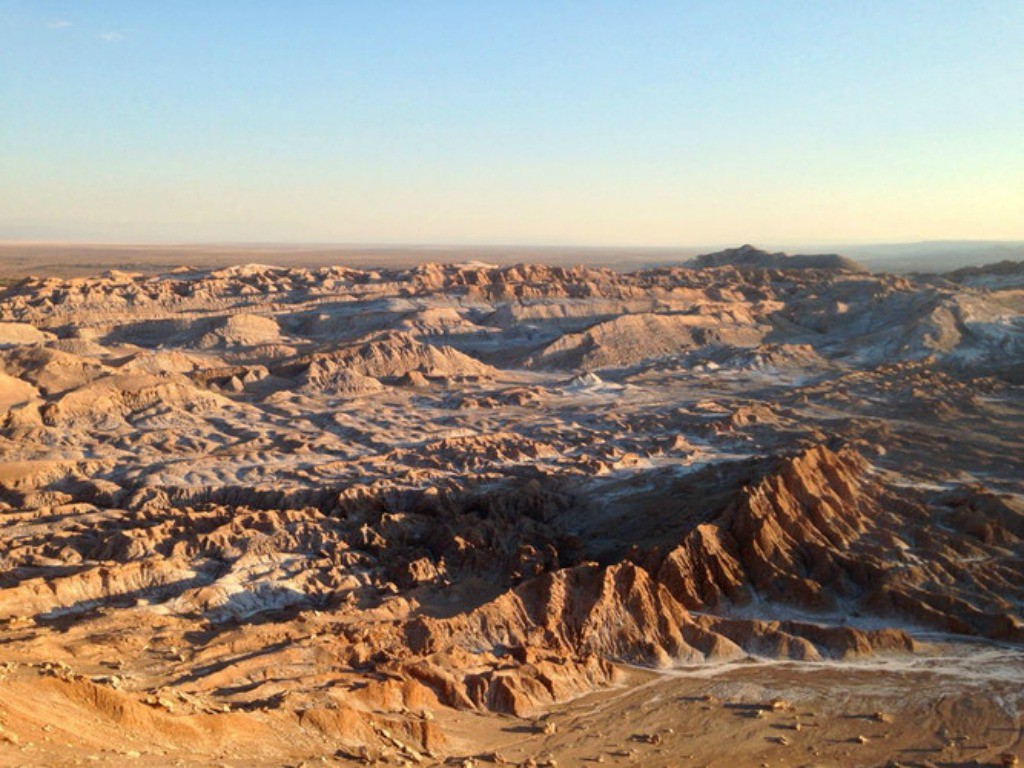
6. Valle de la Luna and Valle de la Muerte (2500m/8,200ft)
This is one of the most well-known tours of the Atacama. Valle de la Luna is a reference to the rugged lunar surface, because of its immense salt walls and giant dunes. This dry landscape, which changes day after day, was unbelievably covered by glaciers in the past.
During this tour, you will witness some amazing geological formations, such as Cordillera de Sal, Duna Grande, Anfiteatro, Tres Marías, Cueva de Sal, and the iconic Piedra del Coyote.
This walk definitely reveals the immensity of the valley. The tour ends at Valle de la Muerte, formerly known as Valle de Marte. Its surface resembles Mars, especially at sunset, when it shows reddish colors and super interesting contours.
Marvel over the startling topography of Chile’s Valle de la Luna (Valley of the Moon) on this 4-hour afternoon tour from San Pedro de Atacama . Keep your camera close to hand as you journey through the desert, past unique rock formations and mesmerizing multi-hued cliffs.
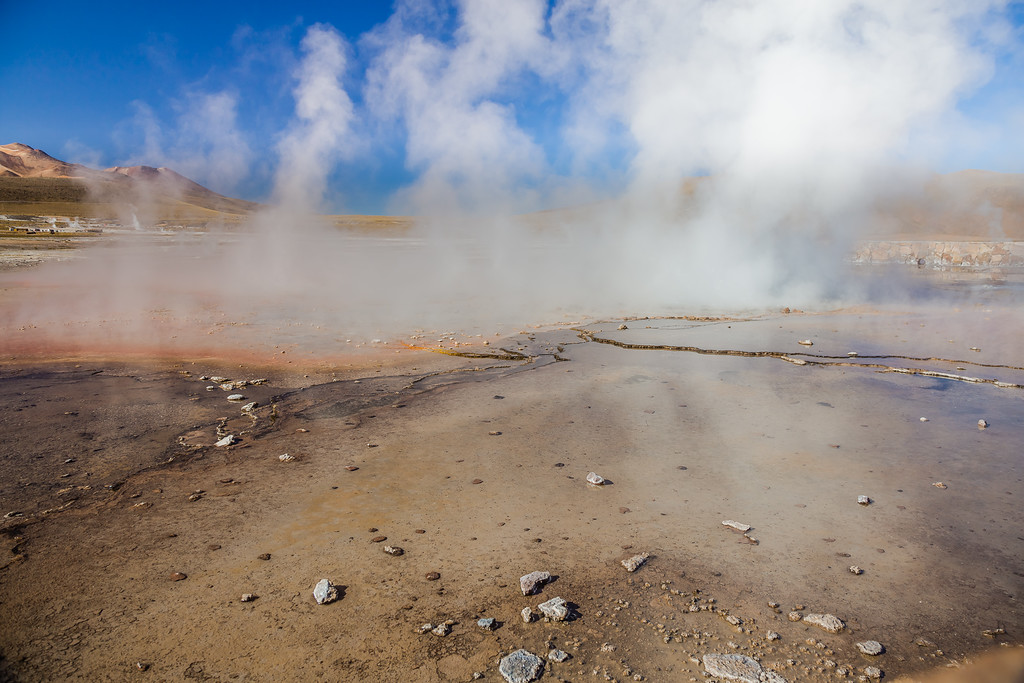
7. Geysers El Tatio (4500m/14,700ft)
Two hours away from San Pedro de Atacama, there are more than 40 geysers and 70 smoke sources. The site is surrounded by mountains and volcanoes making the smell of sulfur very strong.
Discover the unearthly geysers of the world’s driest desert on an early morning tour to El Tatio geyser field from San Pedro de Atacama. Gaze in wonder at over 80 spouting shoots of steam as you watch an enchanting sunrise in the desert. Enjoy a traditional breakfast before soothing your bones in the warm waters of natural hot spring.
The tour starts bright and early in the morning since the phenomenon can only be appreciated between 6 and 8 o’clock.
To get there, you will pass Vilarejo de Machuca and Laguna Putana, both are worth a pit stop for photos.
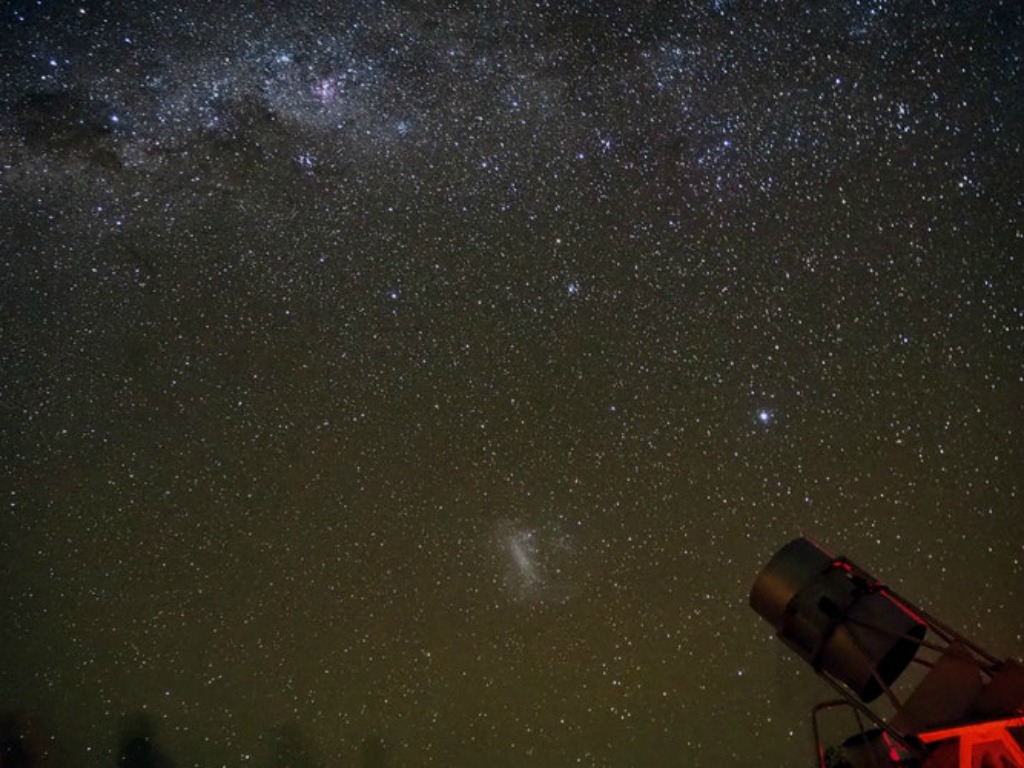
8. Astronomic Tour
The Atacama has the cleanest sky on Earth, for three reasons: altitude, the absence of light pollution, and the absence of clouds. So, it is the best place in the world to observe the stars, the moon, and other planets.
There are several telescopes in the Atacama and they allow visitors to learn more about the mysteries of the sky. A great tip is to go on a full moon night to get even more incredible visibility.
The Space Agency is the best-reviewed for the Astronomical Tour , hosting a few tours each night. It is recommended to book in advance and carry a jacket to avoid getting cold.

9. There Are Amazing Things to Do in San Pedro de Atacama
It is not difficult to understand why the Atacama Desert became so famous among tourists from all over the world. The amazing photos you have seen on Instagram, magazines or travel blogs do not represent half of what there is to see here.
Some of the special landscapes you might witness include salt flats, valleys, mountains, snow, dunes, volcanoes, geysers, stars and flamingo populated lakes. All of which, make you feel as if you are on Mars or the Moon.
Other than the traditional day trips and hikes around the Atacama Desert, there a few other activities available in San Pedro de Atacama. Such as wine tours, bike tours, horse tours, and balloon rides!
San Pedro de Atacama Travel Planning Tips
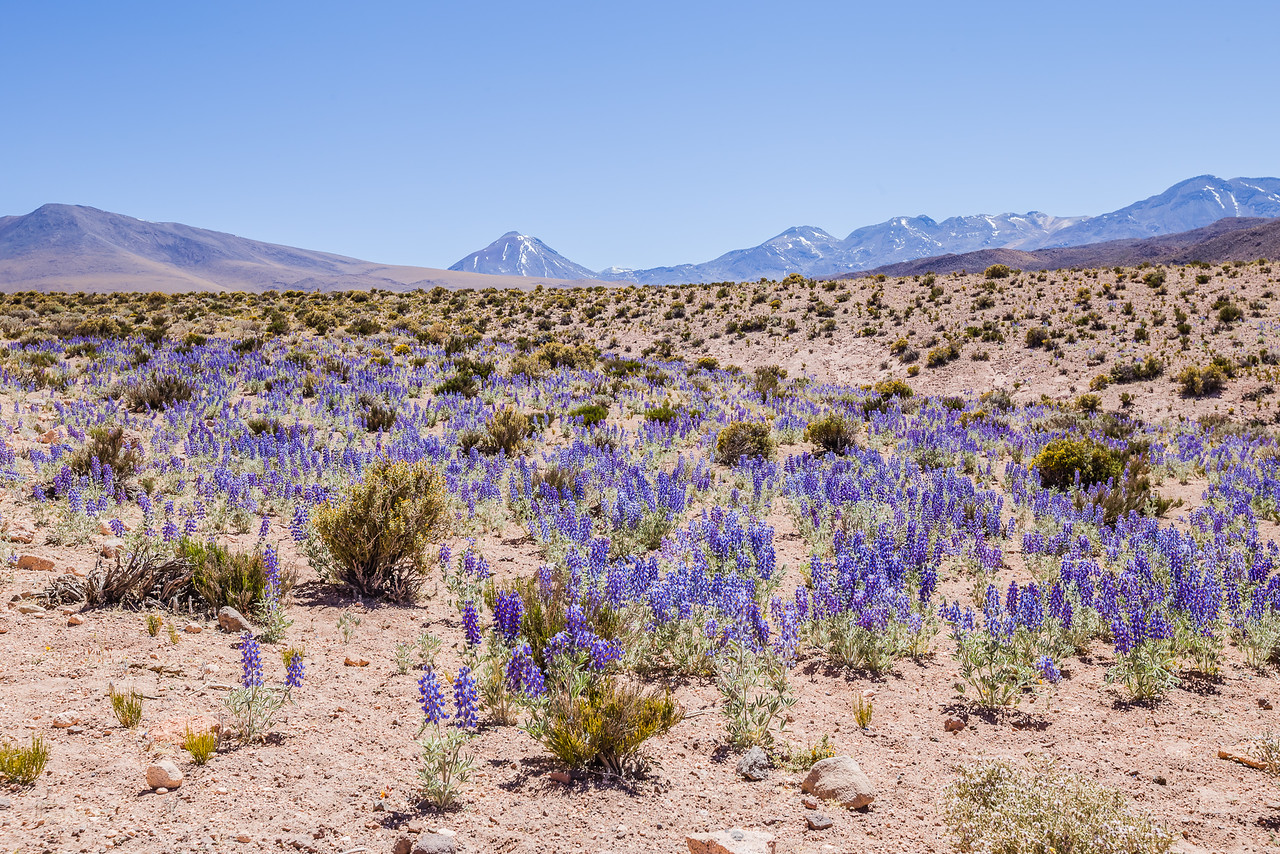
Best Time to Visit San Pedro de Atacama
The Atacama Desert is considered the highest desert in the world and also the aridest (dry), as there are some areas where it has not rained for hundreds of years. This super arid region lies further south.
However, the environment of San Pedro de Atacama is considered an oasis and receives heavy rainfall mainly in the summer.
The rainy season is from December to March and for those who do not like cold weather, this is the best time because it gets quite warm. From April to May, as the rainfall rises, the salt on the ground becomes completely white! The low season is during the middle of the year.
In conclusion, the best months to go to San Pedro de Atacama are those of transitional seasons: autumn (March to June) and spring (September to November).
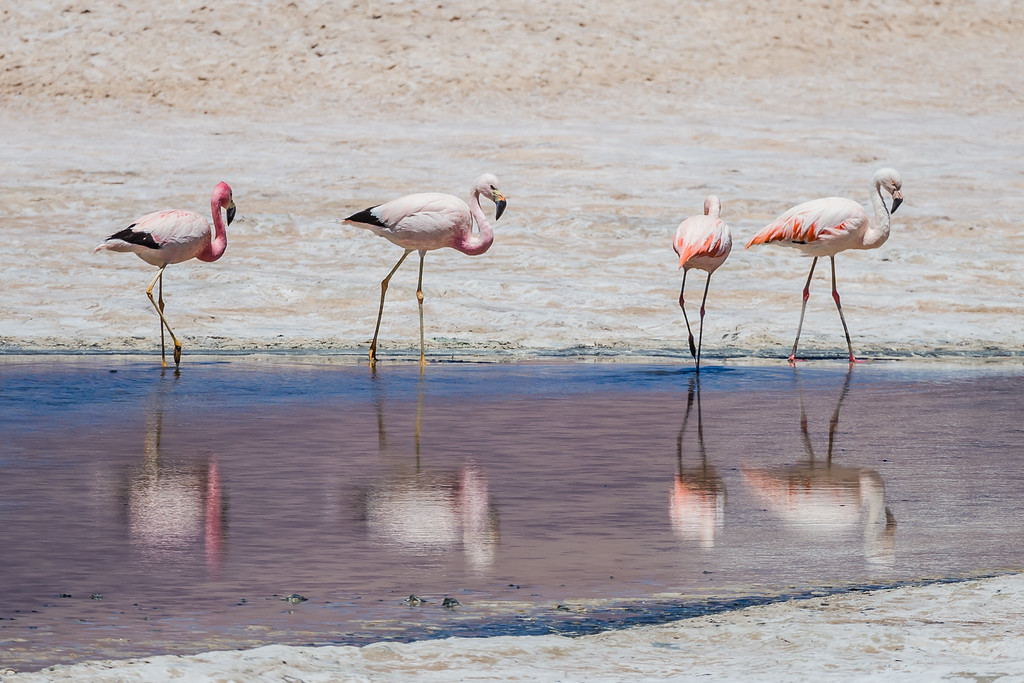
How to Get There
The easiest route is to fly to Santiago and then go to Calama, the city with the closest airport to San Pedro. The Santiago-Calama flight lasts about 2 hours and you will arrive at El Loa Airport. Once in Calama, you need to cross a stretch of road by car to San Pedro de Atacama.
The route lasts around 1:30 hours and you have three main options of how to get there.
The cheapest option to travel between San Pedro de Atacama and Calama is to take a taxi from the airport to the city center of Calama, specifically to the Calama bus station.
From there take a bus straight to the San Pedro bus station. The bus companies that offer this service are Tur Bus, Buses Frontera and Buses Atacama.
Several companies operate the stretch between Calama and San Pedro de Atacama, such as Licancabur and Transandino. It is worth booking in advance as well as your accommodation. Many hotels also provide the option of picking up their guests at the Camala airport, but generally, they charge much more.
The third option is to rent a car in Calama. The road between the two cities is extremely safe and simple to navigate. Just follow Route 23 in the direction of San Pedro de Atacama and you should arrive safely.
Read reviews and check prices with our Hotel Search Engine , that gives you the best hotel deals found on the web. Our search engine pulls results from all of the major booking places, including Expedia, Hotels, Booking and more. All the options, all the deals, all in one place and just for you.
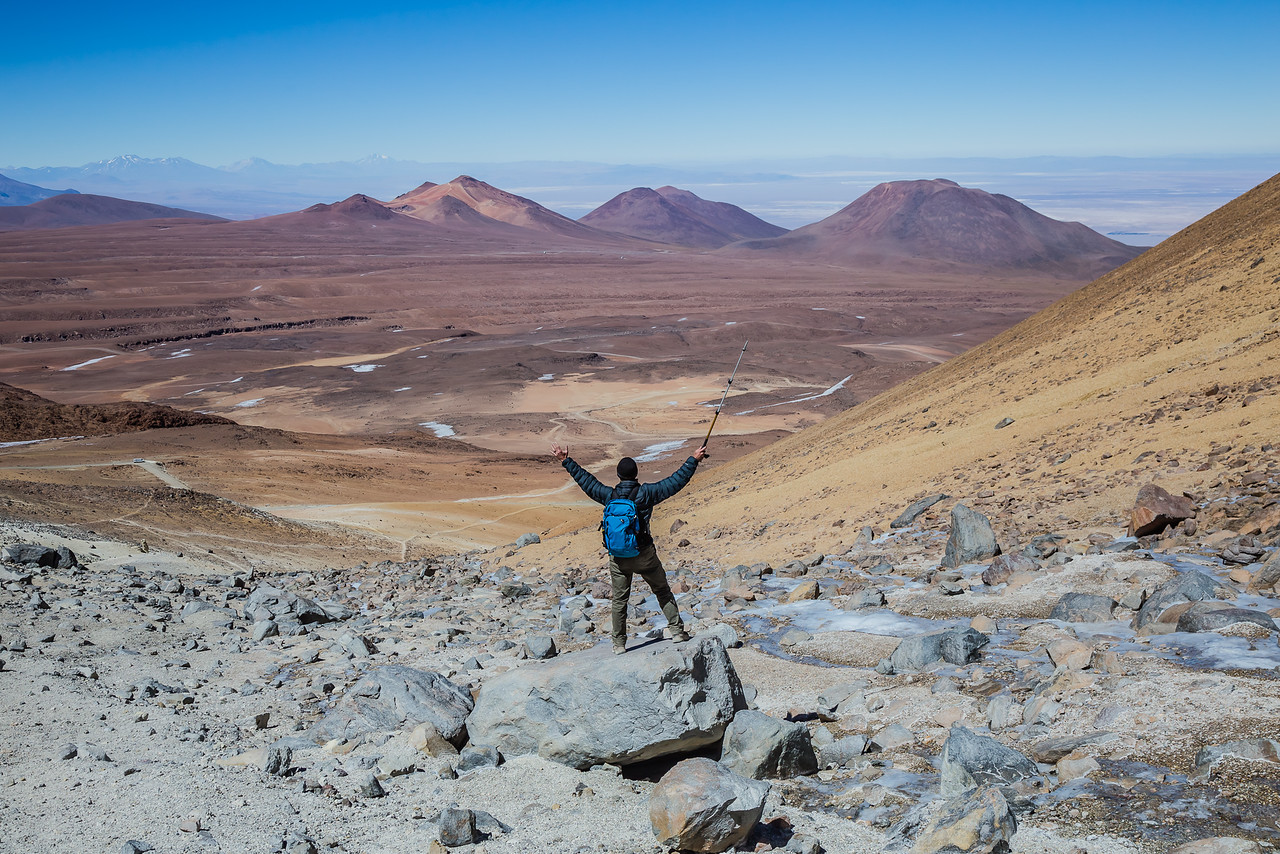
Dealing with Altitude Sickness
Soroche, also known as altitude sickness, is the main consequence of altitude changes in our bodies. It is a result of low air pressure and rarefied air. Possible symptoms include headaches, dizziness, fatigue, difficulty breathing, cardiac acceleration, among others.
Therefore, it is recommended to drink a lot of water while visiting the Atacama Desert.
One very important item that must be taken into account when choosing the day trips (and their order) is acclimatization. Because this area is a zone of high altitude, the body has to adapt. You achieve this by starting with activities that are at lower altitudes and leave the higher altitudes until the end.
If you’re open to exploring local traditions and culture, you will quickly find that chewing dried coca leaves or brewing them into a tea while at altitude will significantly reduce the side effects you get from the thin air.
We’ve spent a lot of time traveling in high parts of the mountains in South America , across various countries, and never turn down coca leaves when they are offered to us. They really do help.
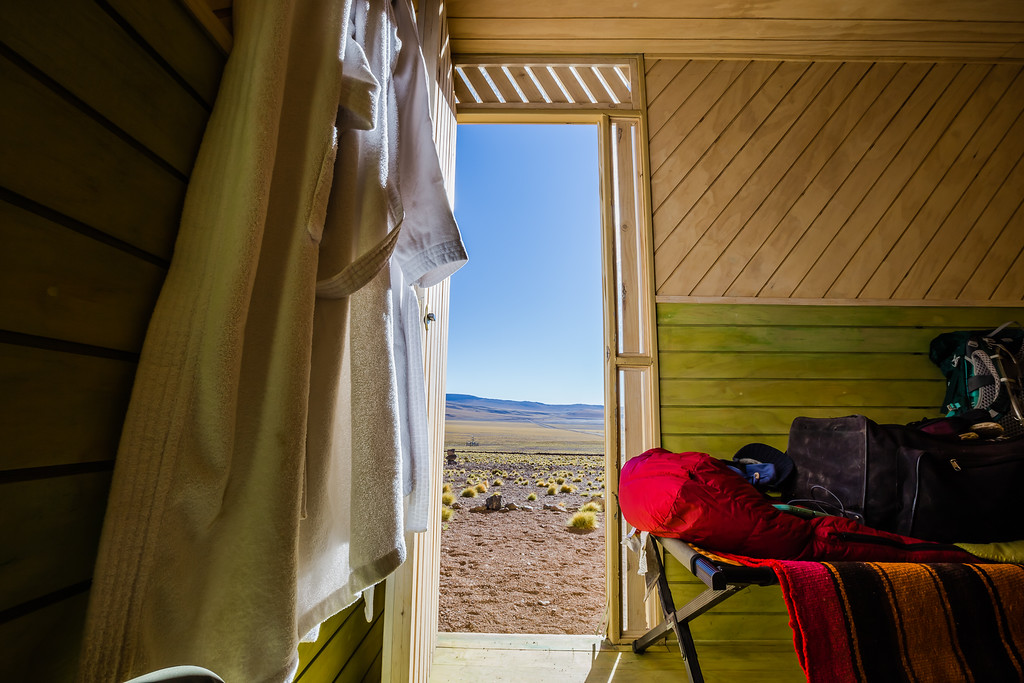
Best Places to stay in San Pedro de Atacama
When we visited San Pedro de Atacama, we stayed with Explora for three days on part of our 9-day overland trip from Salta, Argentina to San Pedro . Explora runs one of the top luxury properties in San Pedro de Atacama. Their property is unlike others in the area.
Located in the oasis of San Pedro de Atacama their 17- hectare property offers a true feel of the Atacama desert, the Andes highlands, and its surroundings.
Click to read about our experience: Adventure Meets Luxury on the Explora Travesia
By day enjoy epic adventures of the Atacama and by night come back to luxury. Their adventures are as amazing as their property. There are personal experiences, where you will go where no other tourist go. That’s the magic of Explora, they go above and beyond.
All programs are included with accommodation so there’s no need to hold back on exploring the Atacama and its surrounding areas. Once back on the property enjoy a bit of luxury with a glass of wine, soaking in one of the two hot tubs, or take a dip in one of the four heated pools. Maybe after a long day of hiking enjoy a message? I know we did.
You will truly have a magical experience with Explora . However, we understand if Explora is not in your budget or how you like to travel. Below we have listed out what we recommend for top luxury hotels, mid-range hotels- Lodge Andino Terrantai , budget hotels- Takha Takha Hotel , and hostels- Hostal Lackuntur in San Pedro de Atacama.
More on Chile & Argentina:
- How to Get to Easter Island: Essential Planning Guide
- Rapa Nui National Park: Moai of Easter Island
- Perito Moreno Glacier: Everything You Need to Know
- 5 Days of Hiking in Patagonia: Basecamps Trek
- 34 Amazing South America Adventure Experiences
Did you like this story? Share it!
Travel planning resources, about lina stock.
Lina is an award-winning photographer and writer that has been exploring the world since 2001. She has traveled to 100 countries on all 7 continents. Member: SATW, NATJA, ATTA, ITWA
Leave a Comment Cancel reply

26 Fun Things to Do in San Pedro de Atacama, Chile
Adventurous Kate contains affiliate links. If you make a purchase through these links, I will earn a commission at no extra cost to you. Thanks!
San Pedro de Atacama is a small-town oasis surrounded by one of the driest places on the planet. People come from around the world to experience the Atacama Desert, and there are plenty of fun things to do in San Pedro de Atacama, the gateway to exploring this otherworldly setting.
Planning your trip to San Pedro de Atacama last minute?
San Pedro is a small town and most popular tours and hotels book up fast. Book ahead to avoid disappointment!
🔭 Top Experiences and Tours in San Pedro de Atacama:
- Stargazing Tour with an Astronomer (Absolute must!)
- Puritama Hot Springs (My favorite thing I did!)
- El Tatio Geysers Tour (Better on a tour than on your own)
🛌 Top-Rated Hotels in San Pedro de Atacama:
- Cas a Lickana B&B (I stayed here and loved it!)
- Hotel Desertic a (Upscale + great location)
- La Casa del Pueblo Hostal (Great budget option)
🚗 Renting a car from Calama Airport near San Pedro? Find deals on car rental rates here.
My husband Charlie and I chose to visit Atacama Desert on our monthlong Chile-Argentina-Uruguay honeymoon. Why? Volcanoes, salty lakes, erupting geysers, giant sand dunes, and bizarre rock formations — not to mention the flamingos, guanacos, and vicuñas!
Right away, we knew San Pedro de Atacama would be the best base for exploring the Atacama Desert in Chile. A small town with a bohemian feel, sitting at 2,400 meters above sea level and surrounded by the Andes mountains, San Pedro is full of character (and characters) — a fun place to return after exploring the desert each day!
Here are the best things to do in San Pedro de Atacama — gateway to some of the most visually striking places in Chile, a country that punches above its weight in terms of natural beauty.
This post was published in February 2024 and was co-written by Adventurous Kate and Hannah Cooper.
Table of Contents
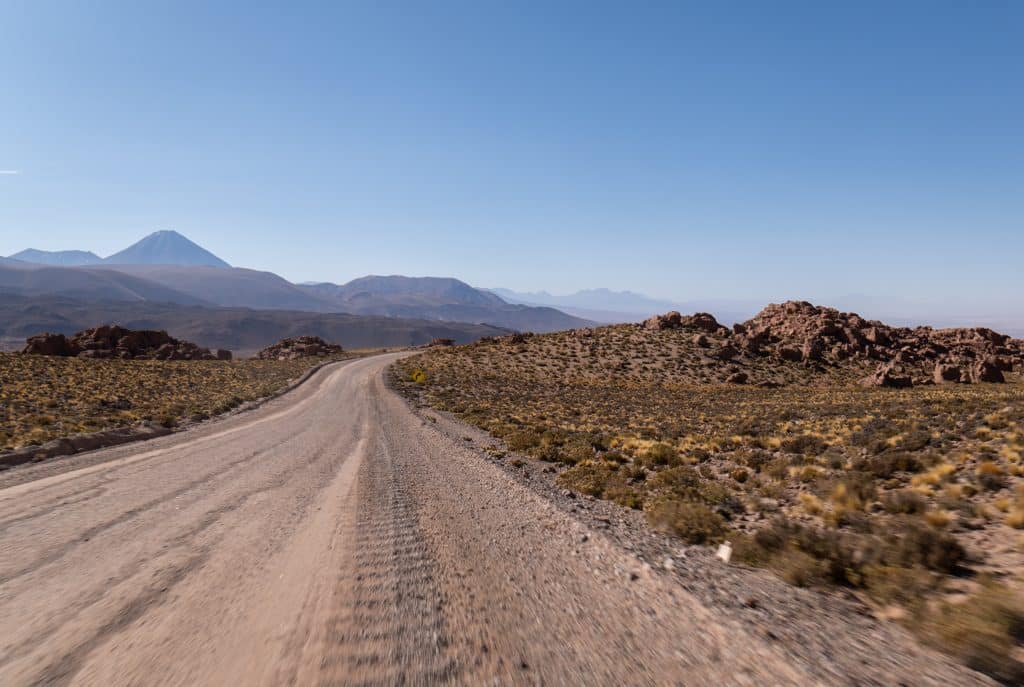
Safety in San Pedro de Atacama
Please don’t skip this section, it’s important!! I’m adding in a section on safety in San Pedro de Atacama because I feel like the dangers of the desert are so underplayed.
First off, the Atacama Desert is a high-altitude desert, which is a tough on your body. You’ll be experiencing the effects of a desert climate (dry eyes, nose, lips, and skin) as well as possibly the effects of altitude (fatigue, dizziness, headaches), especially in highest-altitude places like the El Tatio geysers.
Secondly, you need to decide whether to 1) rent a car and explore independently, or 2) book tours. Charlie and I rented a car, but knowing what I know now about the driving conditions, booking tours is far safer.
There is only one gas station in the area — in the town of San Pedro de Atacama — and if you break down, your situation could quickly turn deadly. There is no phone signal outside the town. Many roads are unpaved and in bad condition. It is incredibly hot during the day and quite cold at night. There are safety trucks patrolling the most traversed roads, and they often have to save stranded tourists.
At one point we realized we had a deflating tire that had to be inflated each morning, and my heart was in my throat until we got back to Calama Airport safely.
If you’re driving on your own, check your tire pressure, keep a full tank of gas, and take water and food with you. Don’t drive on your own if you’re traveling solo. Don’t drive while tired. Drive slowly, take no chances, and keep an eye out for wildlife.
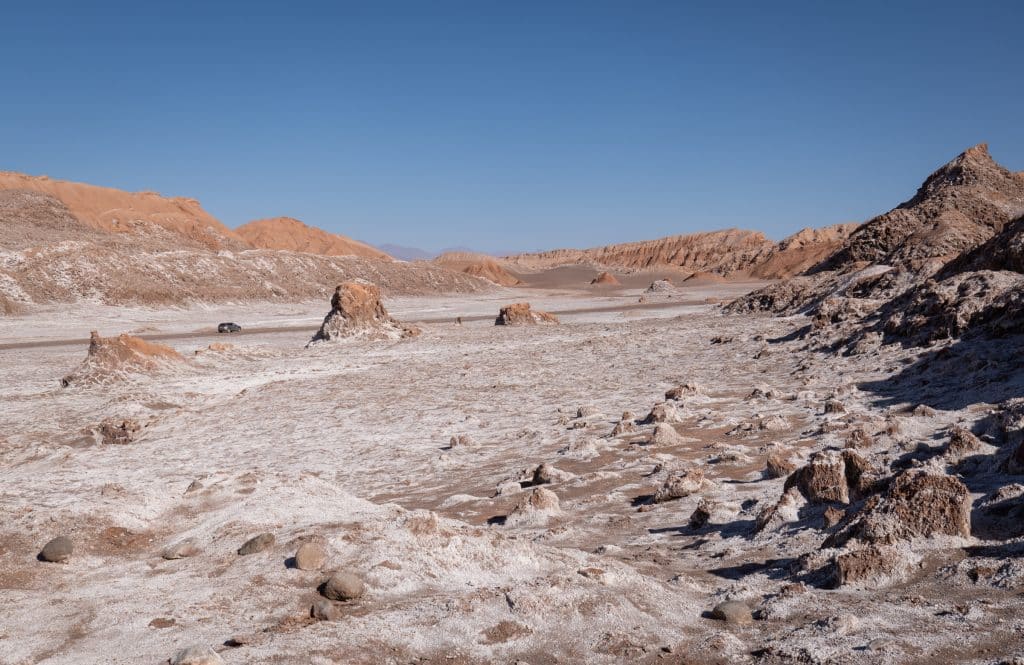
Best Things to Do in San Pedro de Atacama
Visit the valle de la luna.
Valle de la Luna (Moon Valley) is one of the most popular attractions in the Atacama, and I think it’s a good place to visit on your first day in San Pedro de Atacama, as it’s a good afternoon destination. The main activities here include the mysterious Three Marias rocks, an abandoned salt mine, and a 40-minute walk through the colossal dunes.
Valle de la Luna is an easy 25-minute drive from San Pedro (which you will soon learn is EXTREMELY close by Atacama standards). Many tourists cycle there, although you must arrive before 11:00 AM.
Instead, I recommend arriving in the afternoon when the light is softer, and then hanging around for sunset at the La Piedra del Coyote viewpoint. You should buy admission tickets via Punto Ticket — you will need to arrive at a specific time.
Otherwise, you can book a Valle de la Luna tour from San Pedro . This tour brings you to the sites listed and concludes with watching the sunset nearby.
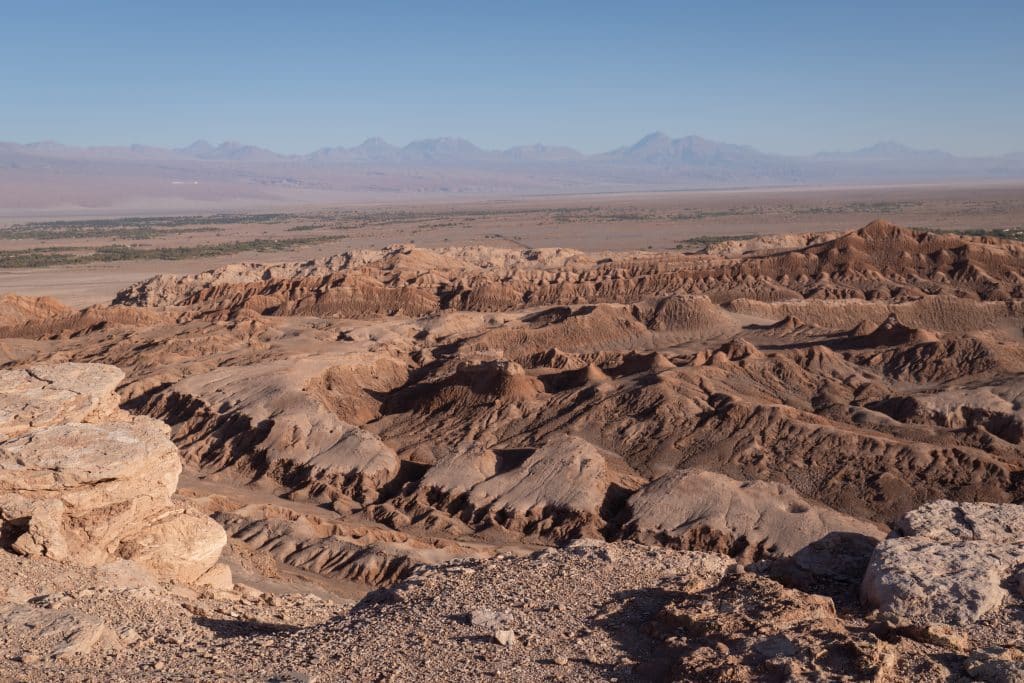
Watch the sunset at La Piedra del Coyote
La Piedra del Coyote (aka Mirador de Kari) is one of the best places to see the sunset in the Atacama. This is one of the most popular photos of the Atacama, and one that you’ve likely already seen: a huge plateau overlooking the Valle de la Luna where the jagged rocks and the Andes mountains light up in different colors as the sun sinks into the horizon.
Note that admission to this point is only possible with a Valle de la Luna ticket and must be on the same day; you can’t visit otherwise. Also, you should know that there isn’t really anywhere comfortable to sit here; there are a few cement blocks you can sit on, but they might all be taken, leaving you to pick out a rock.
Once the sunset wraps, the staff will shoo you out. That’s around 8:30 PM in summer and 5:30 PM in winter.
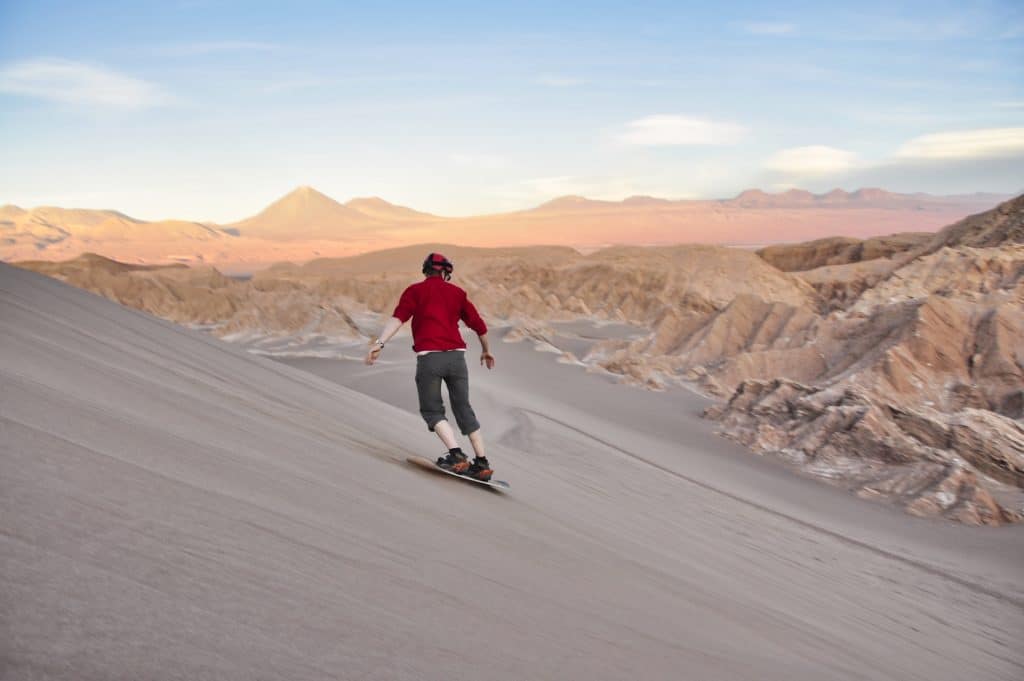
Go sandboarding in the Valle de la Muerte
Sandboarding in Valle de la Muerte (the Atacama’s Death Valley) is one of the most adventurous things to do in San Pedro de Atacama! This valley is only five minutes from town and features dunes ranging from 40 meters to 200 meters.
Valle de la Muerte reopened for sandboarding in 2023 after being shut down. Sandboard San Pedro is one of the best tour operators offering equipment, guides bilingual in Spanish and English, and transport. They run morning, afternoon, and full-moon sandboarding tours.
Note that this region is sometimes referred to as Valle de Marte (Mars Valley).
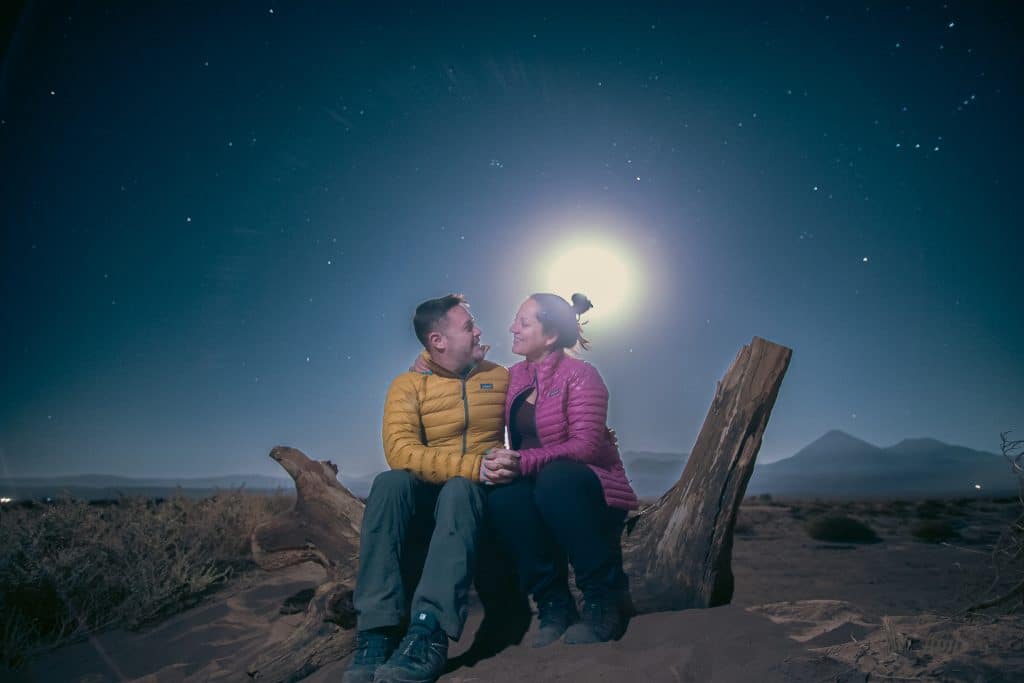
Go stargazing
Did you know that the Atacama Desert is home to the best stargazing on the planet? Seriously! The bone-dry, high-altitude climate allows exceptional visibility.
Astronomical tours are one of the best things to do in San Pedro de Atacama, and allow you to learn about astronomy and view celestial objects through a telescope.
Tours generally cost around $40-45 USD and include a professional astrophoto, like the one you see above. A few options worth checking out are this stargazing tour with an astronomer (the cheapest small-group tour), this astronomical and astrophotography tour (with more emphasis on photographing the stars) and the premium “Under the Atacama Night” (with a cultural focus).
However, don’t make the mistake I did — don’t book a trip to the Atacama during the full moon if you can help it! The light from the moon wipes out the stars. It was a clear night and we were still able to see some stars (as well as Jupiter and Saturn, both very cool), but a night with the new moon would have been infinitely better.
Star-gazing can be done year-round in San Pedro de Atacama. You should know that clouds are rare in the Atacama but tour-canceling cloudy skies are most common in the months of January and February. The Milky Way is visible during the winter months (June, July, and August).
It used to be possible to visit the ALMA Observatory , however, public visits are currently suspended.
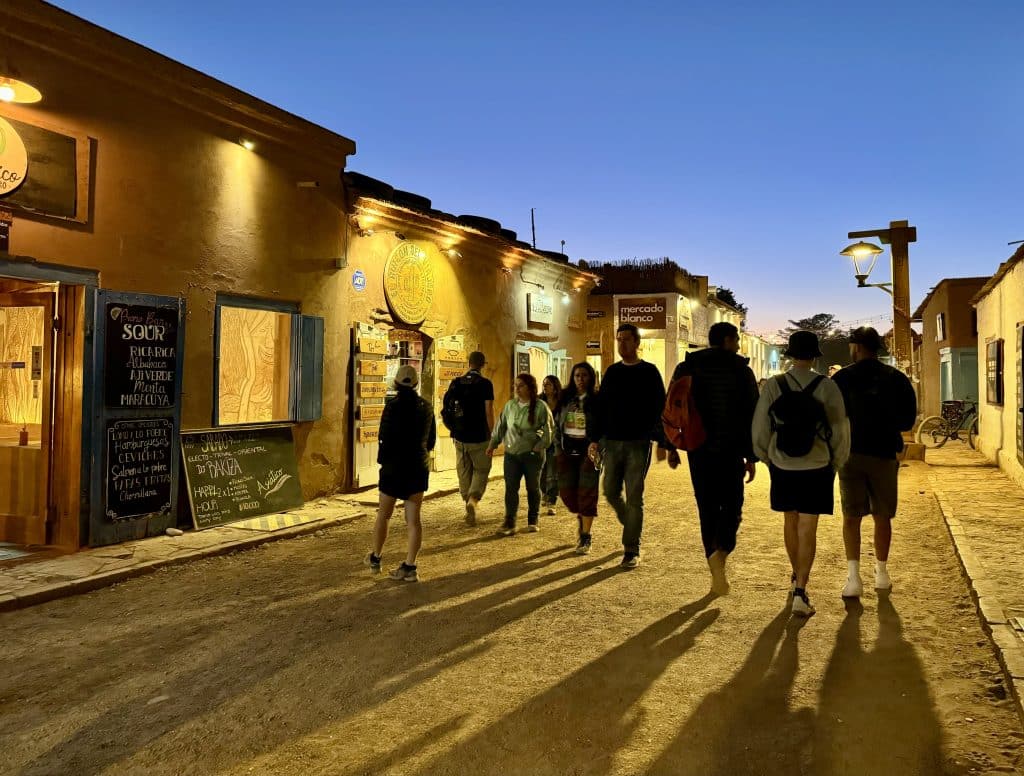
Explore the town of San Pedro de Atacama
The town of San Pedro de Atacama is as touristy as it comes — but that’s a good thing here! The town has a bohemian, hippie feel, and reminds me a lot of places like Pai, Thailand, and Holbox, Mexico. You’ll find a smattering of good restaurants, tons of tour companies, souvenir shops galore, bike rental companies, and impromptu pan flute jams.
Pedestrian-only Caracoles is the central walking street in San Pedro, and it’s especially pleasant around sunset, when the fierce daytime temperatures drop and everyone comes out to stroll. It’s like the passeggiata in Italy!
Here are a few of my favorite spots in San Pedro de Atacama:
ChelaCa bur — This bar has a fun atmosphere, a big beer list, offbeat decor, and great music. Oddly, I felt at home right away! Their chelada — a light beer with lime juice, ice, and salt — hits the spot after a day in the desert, replacing all the electrolytes you’ve lost.
Roots Café & Ba r — This alternative cafe boasts the best coffee in town. It also felt like the coolest people in town happened to be working here! Charlie and I each ordered an iced coffee on a hot day – followed swiftly by a second iced coffee. They were that good.
Emporio Andino — This bakery serves fantastic empanadas and they’re big enough to have one as a meal. So good that we had them for dinner on multiple occasions! I especially loved their caprese empanada with queso mantecoso, tomato, and basil.
Heladería Babalú — Visiting this beloved ice cream shop in San Pedro is practically a rite of passage! Here you can find both classic flavors and some unusual options inspired by the local herbs, like “flor del desierto” and “rica-rica.” My favorite was the maracuya (passion fruit).
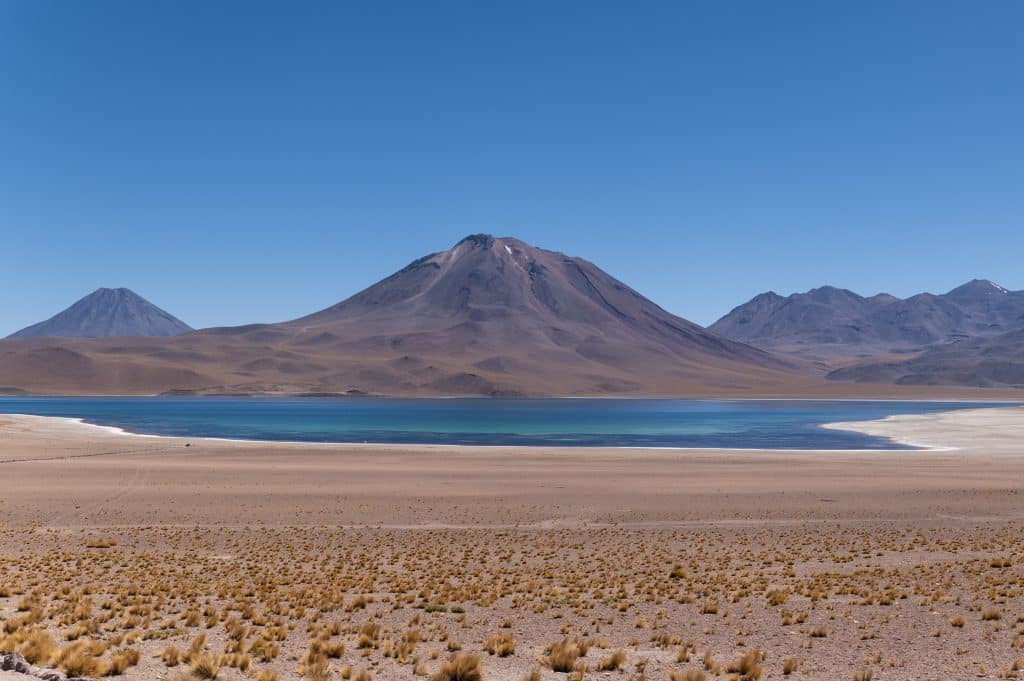
Visit the stunning Lagunas Altiplánicas
Sitting at maximum altitudes of 4,100 meters, the cobalt-blue Lagunas Altiplánicas are individually called Miscanti and Miñiques. These sparkling lakes are linked by a walking trail designed for landscape photography and birdwatching, and I was impressed by their beauty.
If you’re planning to visit Lagunas Altiplánicas independently, you will need to buy timed tickets via the Socaire website . I strongly recommend buying the ticket package that includes both the Lagunas Altiplánicas and Piedras Rojas, as they’re close to each other.
Socaire is about an hour’s drive from San Pedro, so factor this into choosing your time slot. You’ll have to check in at the town of Socaire on the way and collect a paper ticket. Officially, check-in is one hour before your timestamp. We arrived a bit early and it wasn’t an issue, but it’s wise to stick to the time slot.
We had a lot of issues with the site timing out when trying to buy the tickets. It was like pulling teeth. Overall, I recommend going with a tour for this activity rather than going on your own.
This top-rated tour takes you to Piedras Rojas, the Altiplanic Lagoons, and Salar de Atacama . If you book a tour, the entrance fee must be paid separately in Chilean pesos; your guides will collect the fee on the drive.
Another bonus: the turn-off to the dirt road leading to Lagunas Altiplánicas has lots of vicuñas, a llama-like creature! We saw a whole family.
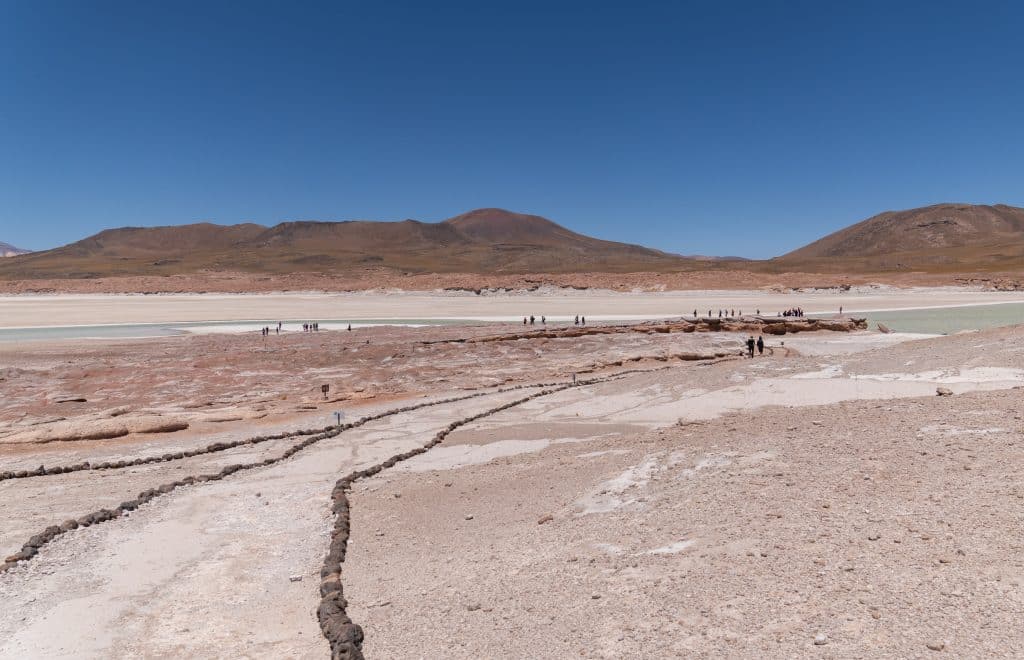
Walk around Las Piedras Rojas
After leaving the Lagunas Altiplánicas, the Piedras Rojas (Red Rocks) are a 45-minute drive further south. Also known as the Aguas Calientes Salt Flat, these rust-colored boulders edge another high-altitude salt lake. The pale blues and greens of the water with the deep pink and red hues of the rocks lead to an otherworldly atmosphere.
There is an easy, mostly flat walking trail taking you around the salt lakes. But you should know that you’re at 3,800 meters above sea level — expect to be a bit out of breath when doing this walk. Dress warmly, as it will be chilly and windy. I was wearing a denim jacket, which wasn’t quite warm enough for this area. My Uniqlo ultra light down jacket would have been a better choice.
The guides said that the walking trail would take around 90 minutes; Charlie and I walked it quickly and did it in 40 minutes.
If you want to visit Piedras Rojas on a tour, I recommend the same Piedras Rojas, the Altiplanic Lagoons, and Salar de Atacama tour listed above.
Note: if traveling independently, by this time you’ll probably be ready for lunch. There are a few places to eat in Socaire.
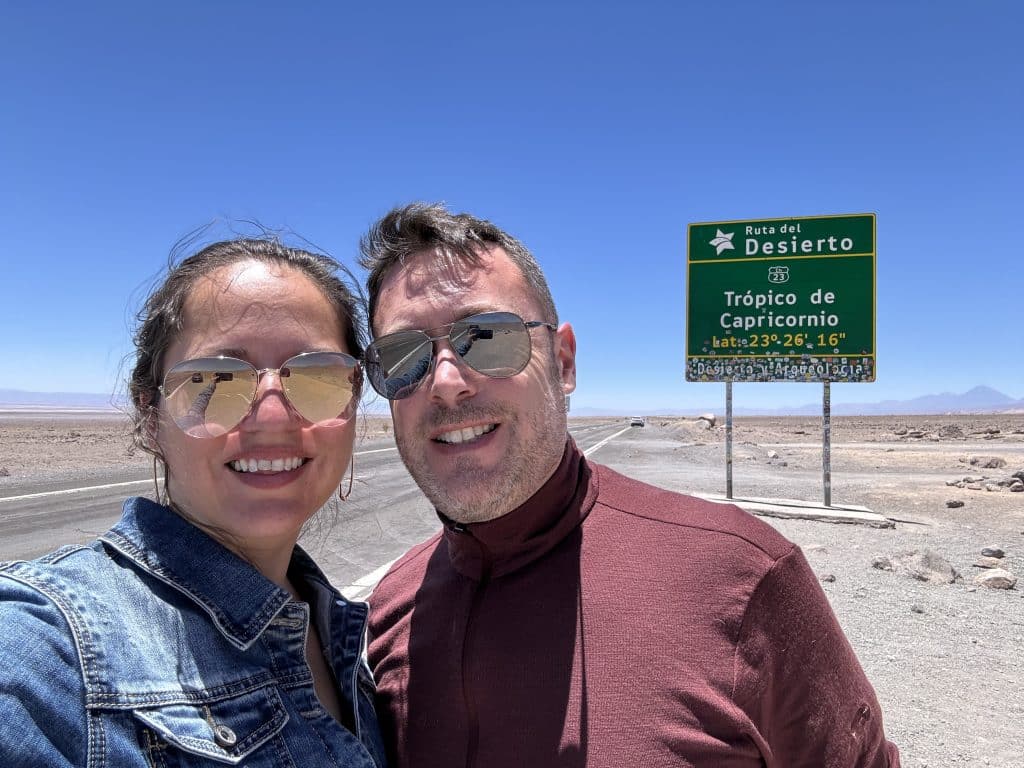

Pose at the Tropic of Capricorn Sign
The Tropic of Capricorn is located just south of San Pedro de Atacama, and there is an Instagram-ready sign marking it! You can find Tropic of Capricorn signs on either side of Highway 23, about 45 minutes’ driving time south of San Pedro de Atacama, just north of Socaire.
There’s nothing else to do here — but it’s definitely worth stopping for a quick photo on your way to or from the Lagunas Altiplánicos and the Piedras Rojas.
This wasn’t my first time at the Tropic of Capricorn — I also drove through it near Shark Bay in Western Australia .
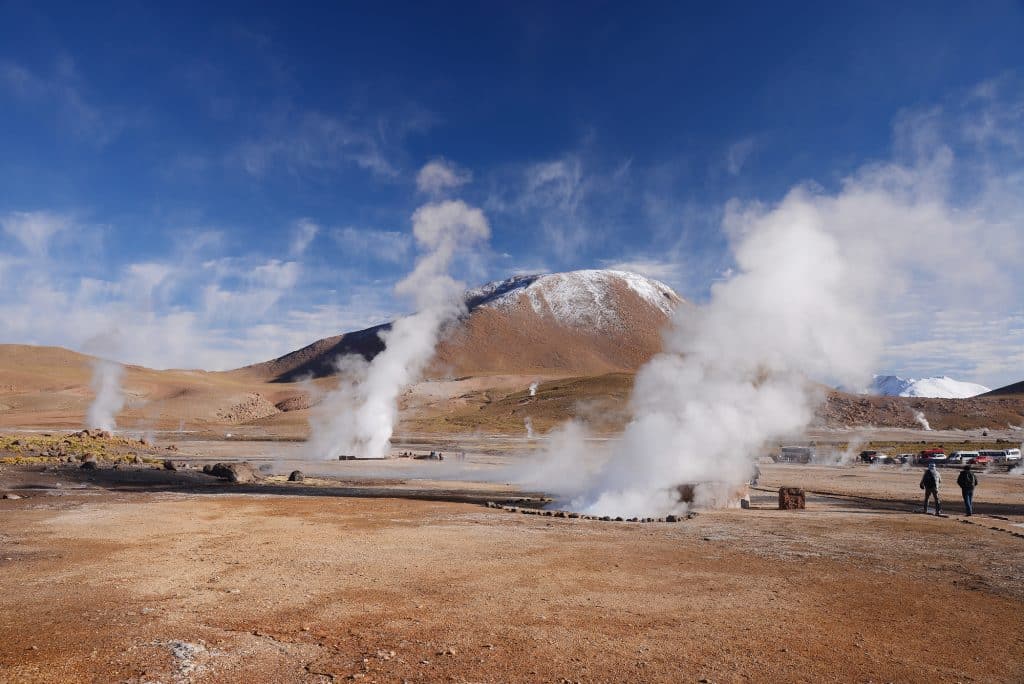
See El Tatio Geysers at dawn
Situated at a sky-high 4,300 meters, El Tatio is the highest geyser field in the world. These 80 hot water and stream eruptions reach heights of 10 meters. But if you want to see the bubbling explosions in action for yourself, you’ll need to visit VERY early in the morning — just before sunrise.
Yes, that means you’ll need to leave San Pedro de Atacama at about 4:00 AM to get there on time. For this reason, I strongly recommend visiting on a tour rather than driving there on your own. The roads are not in great condition and you don’t want to be driving them in the dark — plus the altitude here can lead to headaches and nausea.
Instead, I recommend booking this tour to the El Tatio geysers , on a bus with big windows. You’ll be picked up around 4:00 AM and can snooze the whole drive there. You’ll visit the village of Machuca and the Rio Putana wetlands afterwards.
You should also know that it’s extremely cold at the El Tatio geysers before the sun comes up — below freezing. Wear all of your warmest clothes. It will get better once the sun comes up.
Still intent on driving yourself? Some visitors to San Pedro de Atacama wait for an excursion van and tailgate them all the way to the geysers. Drivers hate this, but it will help you see where you’re going. Allow two hours for the drive (90 minutes if you have a 4X4). But if you’re on your own, you can visit the Puritama Hot Springs on the way back (more on that below).
The entrance fee at the El Tatio geysers is 15,000 CLP ($16 USD) in cash and must be paid by all visitors, regardless of tour.
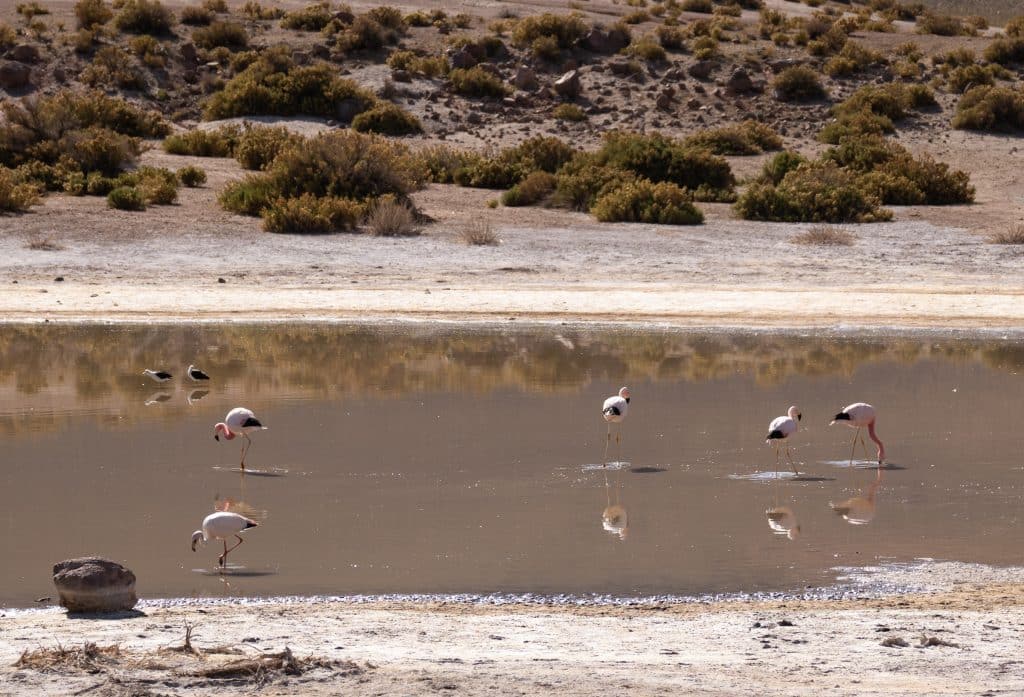
Stop off at Lagunas Flamingos
The Lagunas Flamingos are located just south of Mahuca, on the way back from El Tatio. These lakes are named for the cotton candy-colored birds who wade in the shallows – go figure!
It’s worth stopping for a few photos on the way back from El Tatio Geysers. However, I don’t think it’s worth making a special trip to these lakes. Stick to the Puritama Hot Springs instead. Which brings us to our next item…
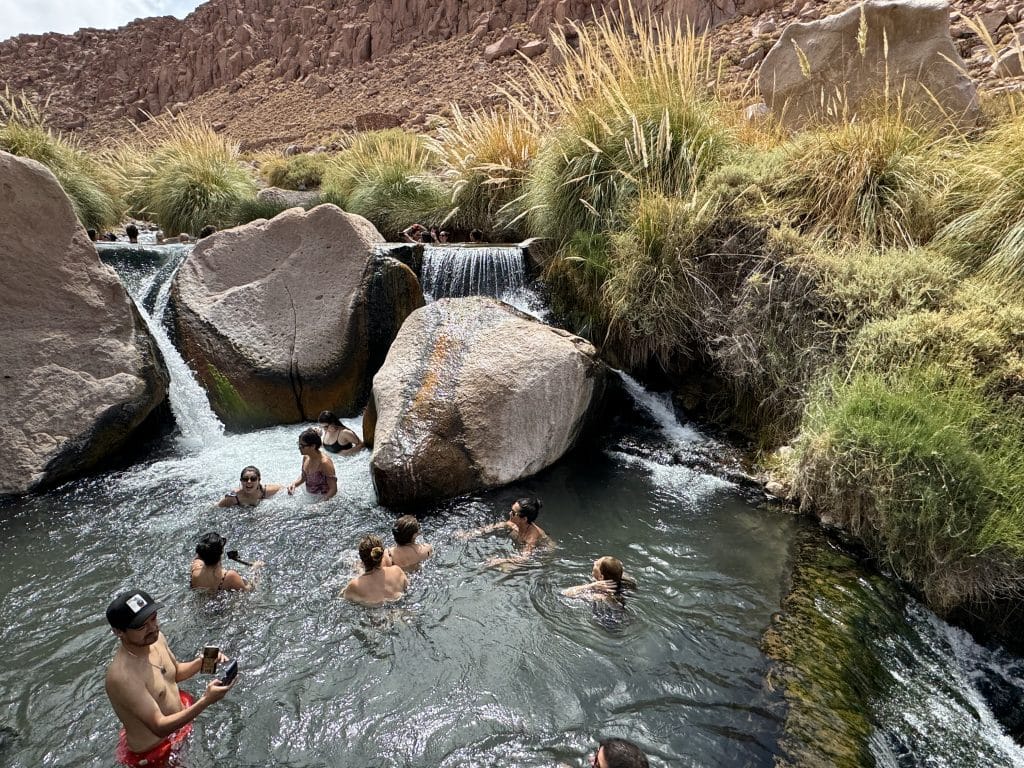
Soak in the Puritama Hot Springs (Termas de Puritama)
Now THIS was my favorite experience in the Atacama Desert! I love visiting hot springs around the world, from Iceland to Italy, but the Puritama Hot Springs might have the most unique setting of all: a verdant canyon in the middle of the desert.
It looks like nothing when you arrive — just a parking lot. But hidden from the road is a pathway that slowly descends into the canyon.
Here you can enjoy a chain of seven pools, all of them linked with waterfalls. The water is warm, not hot, but these pools are absolute PARADISE after spending a few days in the driest place in the world!
There are restrooms and single-sex group changing rooms (no private stalls) at the complex. You’ll need to bring your own lock if you want to use the lockers, and there is no food or drink. I recommend bringing flip-flops for walking the paths between the pools, and take it slowly on the walk out of the canyon — the high altitude makes uphill climbs extra challenging!
It takes 30 minutes to drive to the Puritama Hot Springs from San Pedro. Without a car, you can book this tour to take you.
Tickets cost 35,000 CLP ($38.50 USD) per adult and must be purchased online in advance for either the morning, afternoon, or sunset slot. (Note that there are mid-day closures between the time slots.) Even if you book a tour, you still need to buy admission via this website.
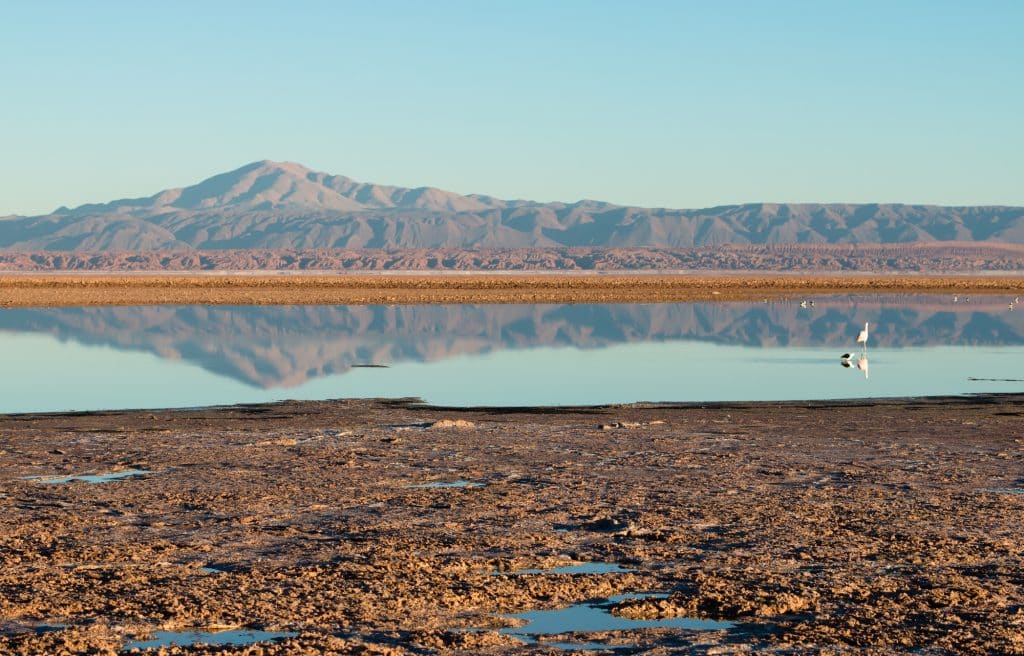
Find flamingos at Laguna Chaxa
Laguna Chaxa is one of the best spots on the Atacama salt flats for seeing flamingos. This shallow lake is the habitat of Chilean, Andean, and James flamingoes.
It takes 1 hour and 40 minutes to drive to the Chaxa Lagoon from San Pedro. Once you leave the main road it switches to gravel, like many of the roads in the region, but it is drivable in a regular car.
I think Laguna Chaxa is best visited on the way back from Lagunas Altiplánicas and Piedras Rojas, as it’s an easy detour from that main road. This Atacama Salt Flat and Piedras Rojas tour is a full day out and stops at all three.
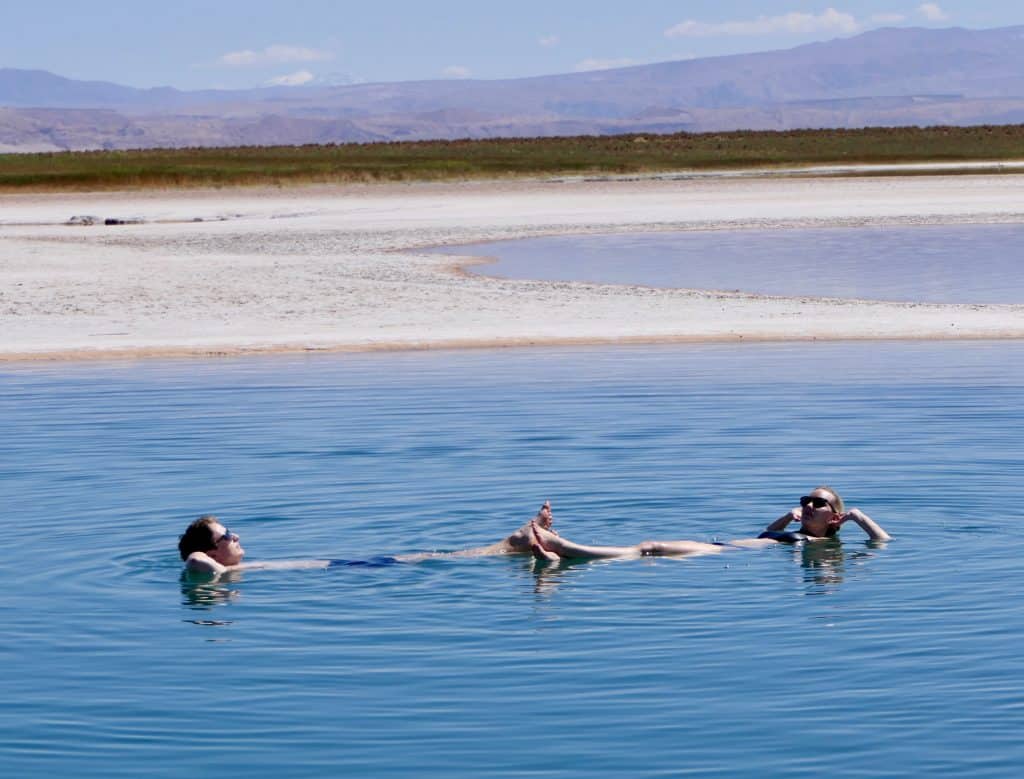
Float in salty Laguna Cejar
Laguna Cejar is another part of the Atacama salt flats where you’ll see flamingos. Plus, you’ll have the chance to float in the saline-loaded waters — this lake is saltier than the Dead Sea!
Cejar Lagoon is the first stop on the short walking path. However, the lake you’ll actually swim in is Laguna Piedra. (Pretty much all locals refer to both lakes as Laguna Cejar, which can be a bit confusing.)
It’s cold when you first enter the water, but you’ll soon warm up. Swimming is capped at 20 minutes for safety reasons, after which you’ll need to shower the salt off before leaving.
Lagunas Cejar and Piedra are an easy 25-minute drive from San Pedro. You can buy an entry ticket for 20,000 CLP ($22 USD) online .
But like all things in this part of the world, random closures can happen. Unfortunately Laguna Cejar happened to be closed when Charlie and I showed up. Oh well — next time!
Want to do it on a tour? This top-rated tour to Laguna Cejar, Ojos del Salar, and Laguna Tebinquinche is available. Admission to the lagoons is payable in cash to the guide, and the outing includes a picnic.
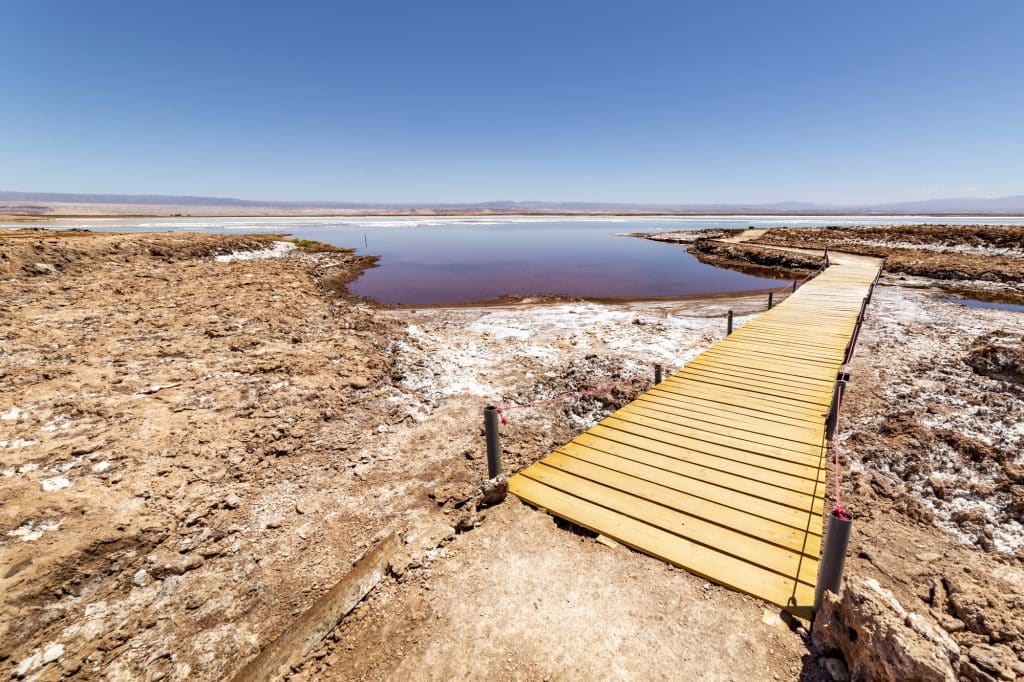
Catch sunset at Laguna Tebinquinche
The Atacama Desert is fascinating from a biological perspective — and Laguna Tebinquinche contains a unique microbial ecosystem that isn’t found anywhere else on the planet. And it’s another visually spellbinding destination.
Touching the water and salt deposits is forbidden, but you can enjoy views of the layers from the footpath. Tourists must leave before sunset, but you should stay as long as possible to enjoy the glorious light and color changes.
It’s a 20-minute drive from Laguna Cejar with a stop at the two sinkholes known as Ojos del Salar (Eyes of the Salt Flats). The aforementioned tour to Laguna Cejar finishes off at Laguna Tebinquinche.
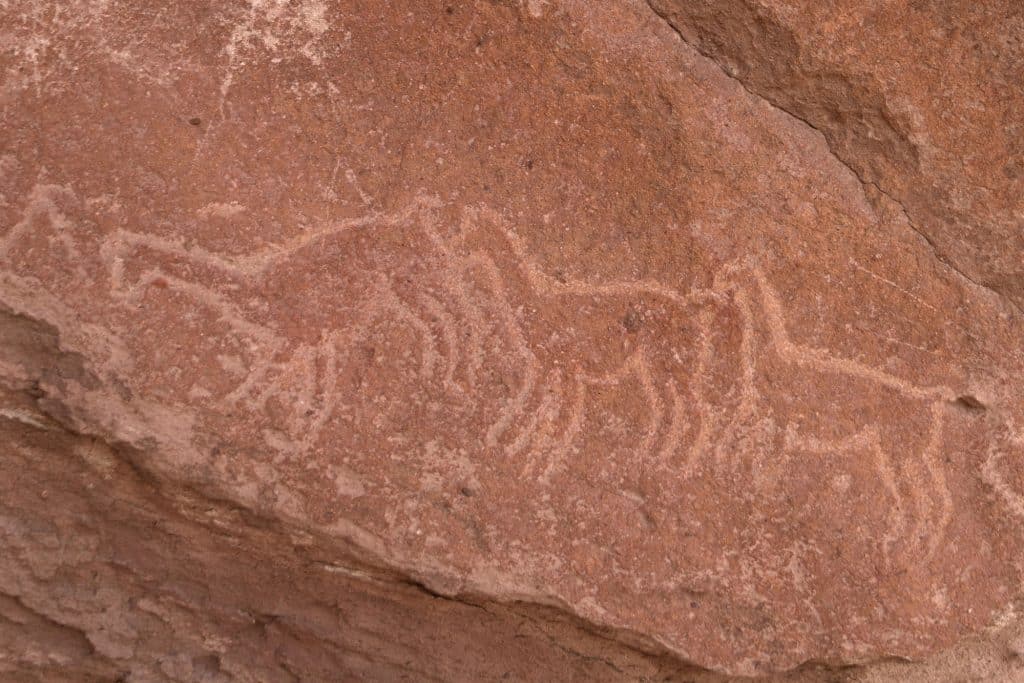
Check out the Yerbas Buenas petroglyphs
Yerbas Buenas is a great place to learn about the human history of San Pedro and the surrounding area. This area is rich with petroglyphs from 10,000 years ago.
This rock art depicts animals of the Atacama, including vicuñas and Andean foxes.
It’s a 50-minute drive from San Pedro de Atacama to the Yerbas Buenas petroglyph. This six-hour tour to Valle del Arcoíris , the Atacama’s Rainbow Valley, includes a stop on the way back. And like any place featuring ancient art, it’s good to have a guide explain it to you.
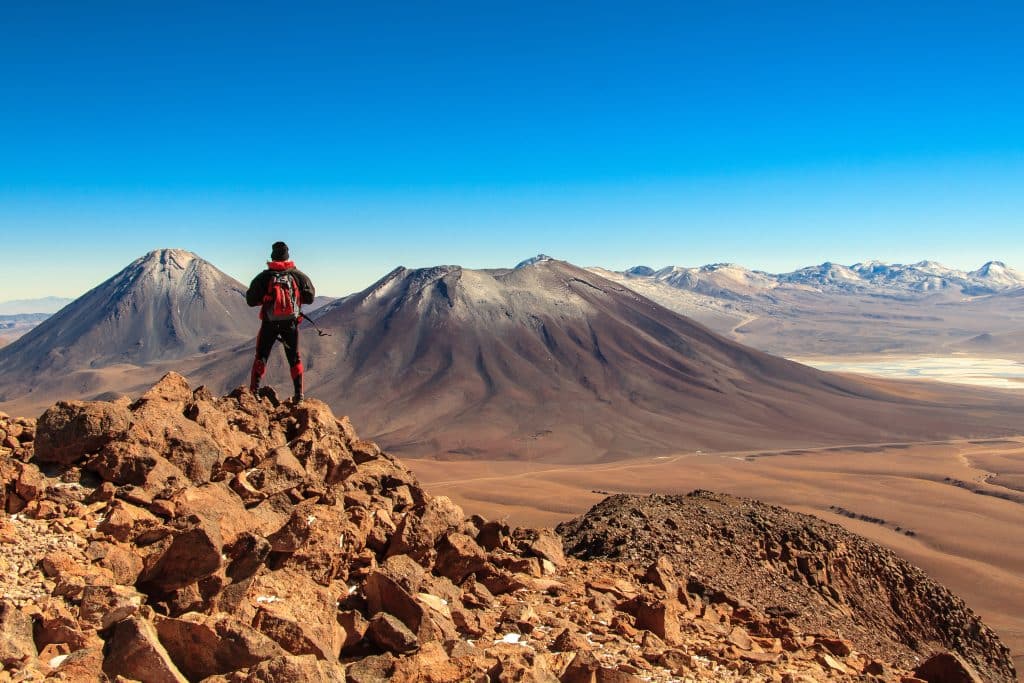
Climb Cerro Toco
If you’re physically fit, acclimated to the altitude, and up for a challenge, climbing a dormant volcano in the Andes mountains is one of the most adventurous things to do in San Pedro de Atacama .
Cerro Toco reaches 5,604 meters and is one of the top places for spectacular desert views (in a region that seems to have spectacular views around every corner!).
You’ll need to book a guided Cerro Toco summit trek with a certificated high-mountain guide. Proper trekking gear is mandatory, and keep in mind that the high altitude makes this far more difficult than if it were at a lower elevation. Do not even think of doing this if you’re not accustomed to hiking in altitude.
View this post on Instagram A post shared by Karina Rocha (@kasrocha)
Visit Museo de Meteorito
Inspecting meteorites collected from the desert is one of the most unexpected things to do in San Pedro de Atacama in the evening before dinner. Museo de Meteorito contains achondrites, chondrites, mesosiderites, and pallasites.
An audio tour is available in multiple languages. At the end, you’ll have a hands-on demo for detecting meteorites from regular rocks.
The Meteorite Museum is open Tuesday through Sunday, 6:00-9:00 PM. Cash-only admission is 5,000 CLP ($5.50 USD).
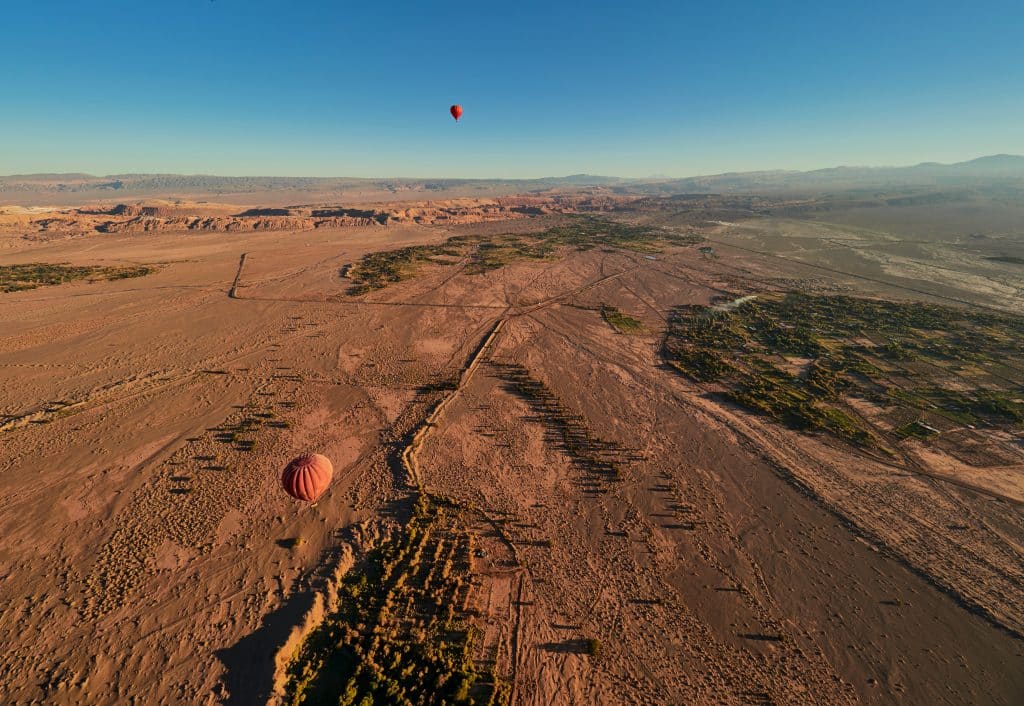
Ride a Hot Air Balloon
Are you a baller? You can’t get much more baller than riding a hot air balloon over the Atacama Desert! And it’s hard to imagine a better view than from the sky.
Yes, it’s expensive — but I would file this under “once in a lifetime” travel experiences.
You can find and book hot air balloon flights in San Pedro de Atacama here, and they take place in the early morning between September and May.
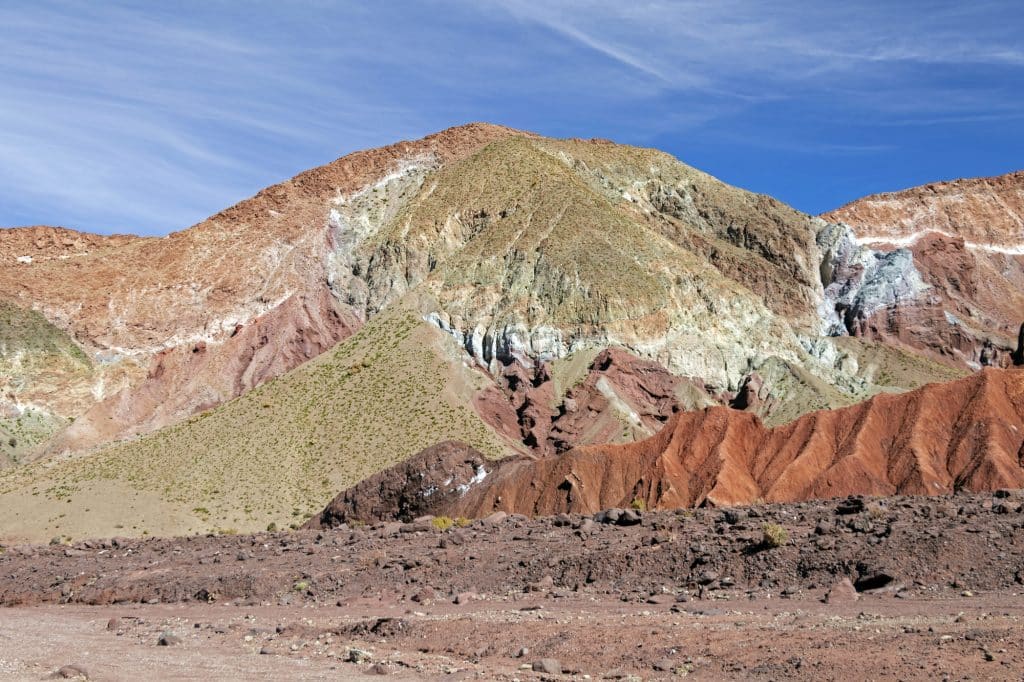
Off the Beaten Path near San Pedro de Atacama
Here are a few more destinations in San Pedro de Atacama worth visiting:
Salar de Tara — Located within the Los Flamencos National Reserve in Northern Chile, this phenomenal salt flat borders both Bolivia and Argentina. Besides flamingoes, you’ll see sand-carved “cathedrals.”
Laguna Baltinache — More salty lakes, you say? Why not! Not a lot of people visit the Hidden Lagoons of Baltinache , preferring Lagunas Cejar and Piedra, which makes them a lovely escape.. Swimming is permitted in two of the seven.
Valle del Arcoíris — The Atacama’s “Rainbow Valley” contains stripey mountains and rock formations formed by wind erosion. It’s the first stop on this six-hour tour to Valle del Arcoíris followed by Yerbas Buenas.
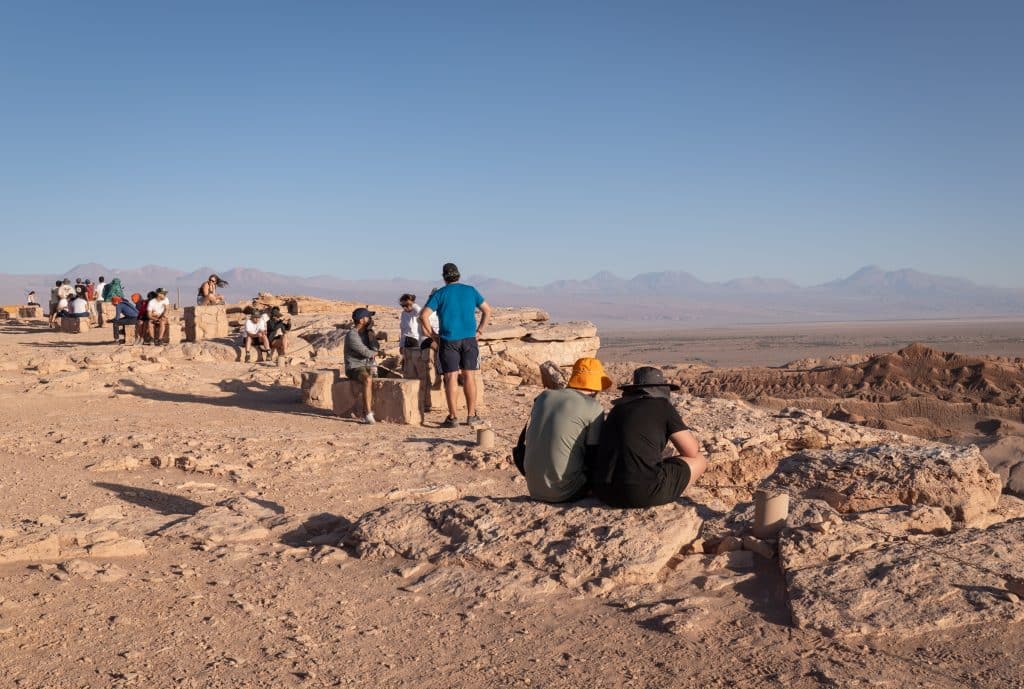
How Much Time to Spend in San Pedro de Atacama
I think three days in San Pedro de Atacama is the perfect amount of time. If you arrive midday on the first day, that’s fine — you still have time for the Valle de la Luna, sunset at La Piedra del Coyote, and even some stargazing.
A four- or five-day itinerary would give you enough time to do everything on this list.
There are a few points of consideration into how many days to spend in San Pedro de Atacama. First of all, it’s in the middle of nowhere, so you’ll probably have to plan flights on either side, and second, the high-altitude desert environment can be tough to get used to.
Be sure to take it easy and slowly increase your elevation. Most guides recommend starting easily with the Valle de la Luna and saving El Tatio geysers for your last day because it’s at a much higher altitude.
Finally — thanks to our crusty noses, dry lips, and a few headaches, Charlie and I were relieved to leave the desert after three days. Our next destination was Puerto Varas in the lush, green Los Lagos region and it felt like paradise!
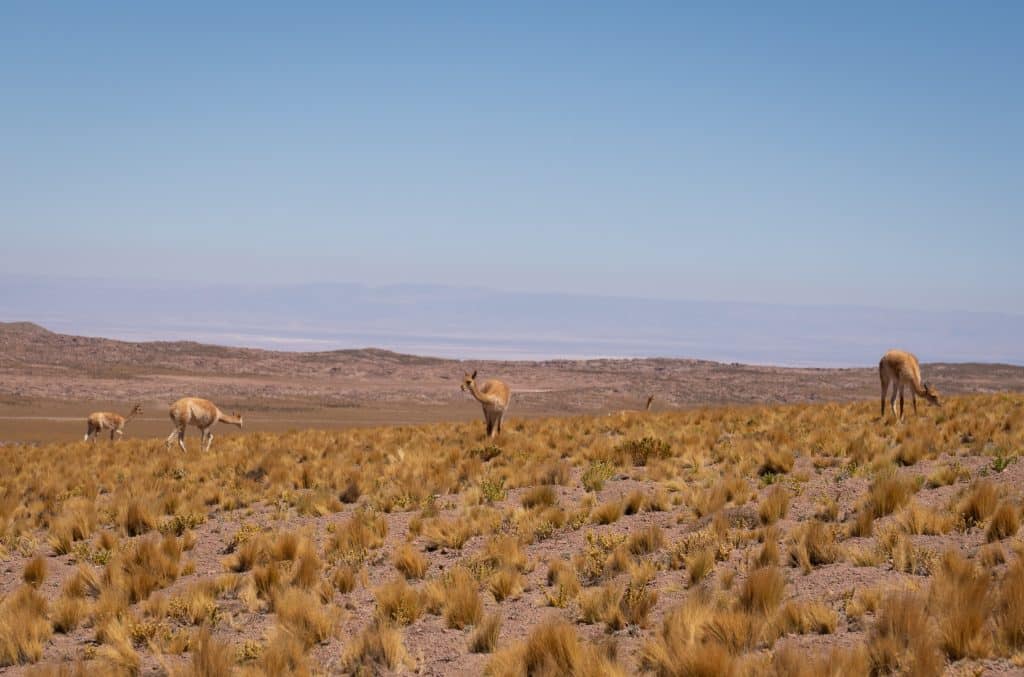
How to get to San Pedro de Atacama
The closest airport to San Pedro de Atacama is in the city of Calama. El Loa Airport in Calama has several flights to Santiago each day, which take about two hours. From Calama it’s a one-hour drive to San Pedro.
There are several kiosks at the arrivals terminal selling bus transfers to San Pedro. A single fare is 15,000 CLP ($16.50 USD). If you’re traveling during the peak travel months (November through March), I recommend you pre-book a shared transfer .
You can also rent a car in Calama and drive to San Pedro de Atacama, as we did.
Not up for flying? There is a bus to San Pedro de Atacama from Santiago, but it takes a whopping 22 hours! Chile is a looooong country.
You can also look at traveling to or from San Pedro by bus from other South American destinations. Tours of the Salar de Uyuni in Bolivia often finish in San Pedro de Atacama, and there are buses from the city of Salta, Argentina, that take 10 hours.
Recorrido and Busbud are the best places to scope out routes and fares.
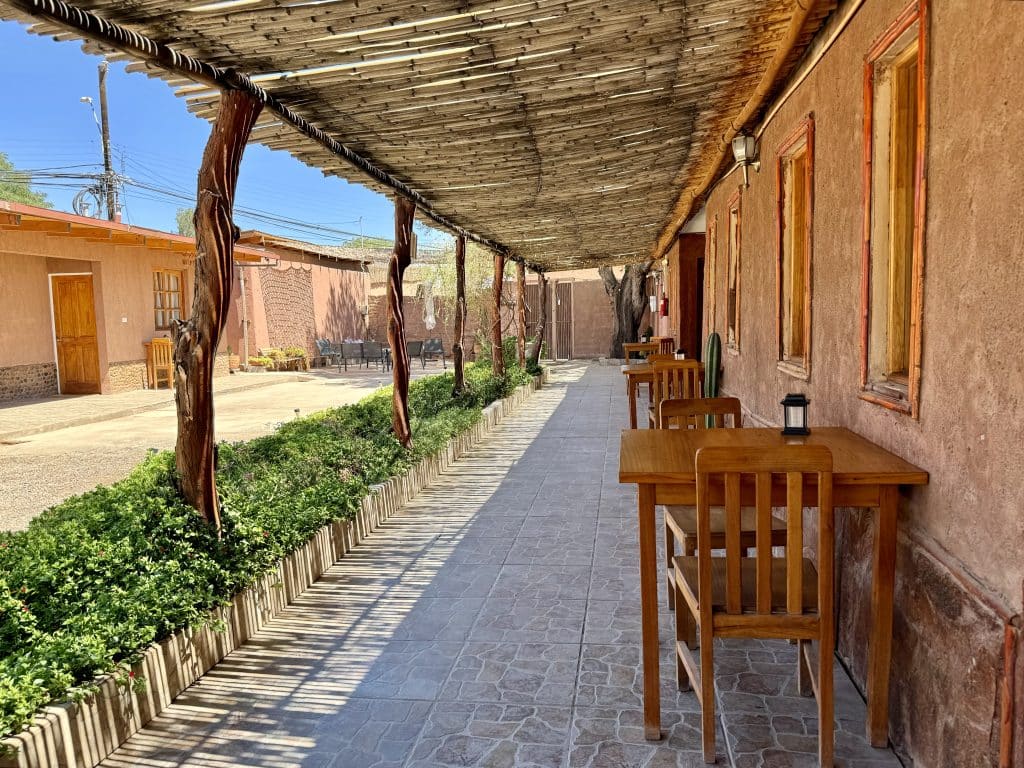
Where to Stay in San Pedro de Atacama
San Pedro de Atacama is a relatively small town. I recommend staying close to Caracoles, the main walking street in town, which is home to lots of restaurants, shops, bars, and tour companies. Everything is close by when you stay near Caracoles.
For that reason, I selected the top-rated hotels in San Pedro that are close to Caracoles:
Top-Rated Luxury Hotel in San Pedro de Atacama: If you’re happy to splash out, you’ll appreciate the exceptional Hotel Desertic a for its pool. Abode rooms are tricked out with natural materials and have swanky private bathrooms.
Top-Rated Mid-range Hotel in San Pedro de Atacama: Cas a Lickana B&B is where I stayed and I’m happy to recommend it based on location, security, and value for money! The rooms aren’t huge, but they have private outdoor patios, and breakfast is included (including hot dishes like scrambled eggs). The staff are lovely and kind, though you shouldn’t expect any of them to know any English (which is not unusual in Chile).
Top-Rated Budget Hotel in San Pedro de Atacama: La Casa del Pueblo Hosta l is a fuss-free budget option that offers economical double rooms and family rooms with either a private or shared bathroom. Breakfast is included in the price and rental bikes are available.
Find deals on places to stay in San Pedro de Atacama here.
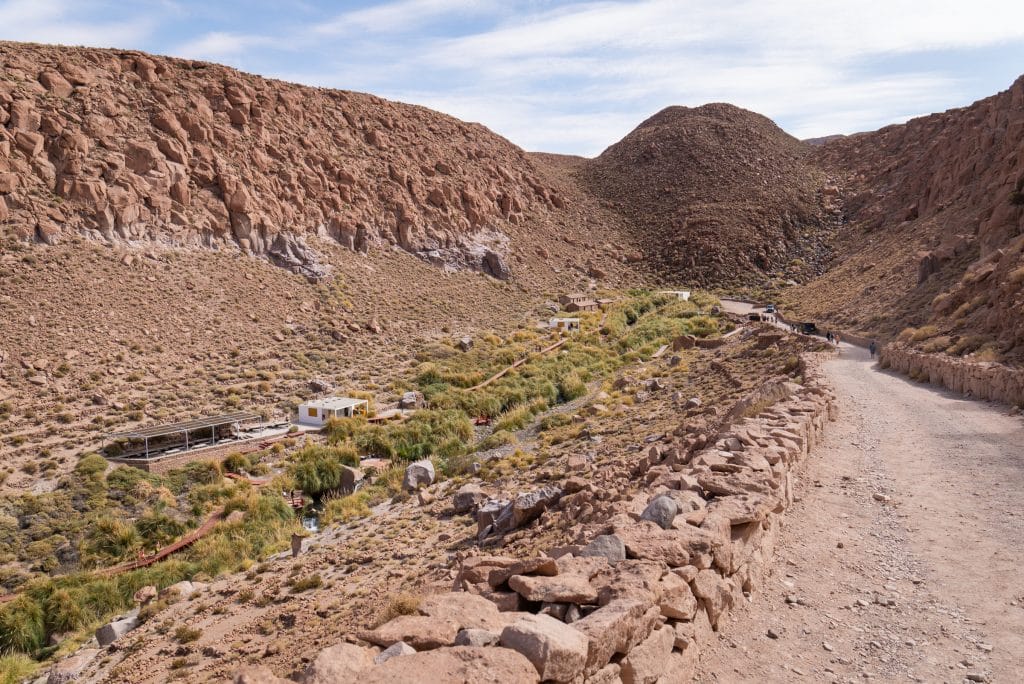
Best Time to Visit San Pedro de Atacama
It’s possible to visit San Pedro at any time of year. It’s warmest during summer: that’s December, January, and February in the southern hemisphere! October, November, and March are best for decent weather, fewer crowds, and lower accommodation rates.
A very short but pretty intense rainy season occurs in February. It brings a heavy onset of rainfall for a week or so near town. However, most parts of the Atacama have never seen a drop of rain. (EVER! Seriously! How does life exist here?!)
The winter months of June, July, and August are bone-chillingly cold at night, although they have the perk of clear skies and minimal crowds. This is also when you can see the Milky Way in the Atacama Desert.
Mornings, evenings, and nights in the Atacama are always cold, but temperatures in San Pedro are blisteringly hot during the early afternoon. Certain tourist spots are subject to colder/windier daytime conditions at all times of the year, like El Tatio before dawn, where temperatures are often below freezing. Bundle up!
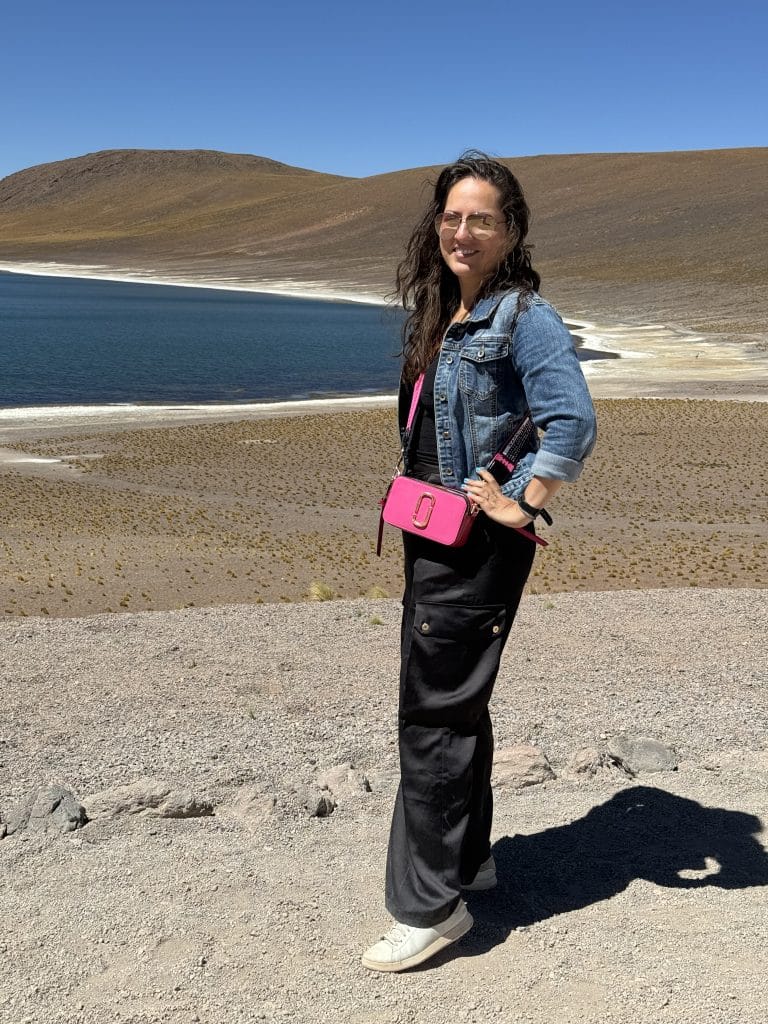
Is San Pedro de Atacama Worth It?
Okay, I’ll be honest with you — San Pedro de Atacama was worth it for me personally, but I don’t think it’s for everyone. The environment is visually spectacular, but visiting this area involves a lot of long distance drives on rough roads to “just look at things,” as my husband put it.
The Puritama Hot Springs and stargazing tour were much more interactive, but he was right — besides those things, there was a lot of “drive two hours to a thing, take a photo, and there’s nothing else to do there, so you leave.” That, on top of the dryness, peeling lips, and altitude fatigue.
San Pedro is quite a far distance from everything else in Chile, so if you’re not 100% set on visiting, you may want to consider whether your limited time in Chile would be better spent hiking in Patagonia, exploring towns in the Lakes region, or enjoying art and culture in Valparaíso .
But if you love deserts, unusual landscapes, photography, and star-gazing, I think you’ll love the Atacama! This truly is a special part of the world, and I’m so glad I got to experience it.
More on Chile:
- Staying at Ecocamp Patagonia: A Sustainable Resort in Chile
- 17 Best Things to Do in Santiago, Chile
- 15 Best Things to Do in Puerto Varas, Chile
- 11 Cool Day Trips from Santiago, Chile
- 17 Colorful Things to Do in Valparaíso, Chile
More on South America:
- Solo Female Travel in Colombia: Is it safe?
- What’s it really like to travel to Guyana?
- 16 Epic Things to Do in Ushuaia, Argentina
- 25 Epic Things To Do in El Calafate, Argentina
- 18 Wild Things to Do in El Chaltén, Argentina
- El Calafate vs. El Chaltén: Which Town in Argentine Patagonia Better?
- 32+ Fun Things To Do in Buenos Aires, Argentina
Have you been to San Pedro de Atacama? Share away!
San Pedro de Atacama
Book your individual trip , stress-free with local travel experts
Select Month
- roughguides.com
- South America
- el-norte-grande
- san-pedro-de-atacama
- Travel guide
- Itineraries
- Local Experts
- Travel Advice
- Accommodation
Plan your tailor-made trip with a local expert
Book securely with money-back guarantee
Travel stress-free with local assistance and 24/7 support
The little oasis village of San Pedro de Atacama, with its narrow dirt streets and attractive adobe houses, has transformed itself, since the 1990s, into the tourism centre of Chile. Sitting at an altitude of 2400m between the desert and the altiplano, or puna (the high basin connecting the two branches of the cordillera), this has been an important settlement since pre-Hispanic times, originally as a major stop on the trading route connecting the llama herders of these highlands with the fishing communities of the Pacific. Later, during the nitrate era, it was the main rest stop on the cattle trail from Salta in Argentina to the nitrate oficinas , where the cattle were driven to supply the workers with fresh meat.
Tours from San Pedro
Alma observatory, around san pedro.
The large numbers of Chilean tourists and hordes of gringos here can come as quite a shock if you have just arrived from more remote parts of northern Chile. San Pedro has recently begun to lose some of its charm and is lined with overpriced, trendy-looking hotels with poor service. Luckily, you will find exceptions.
Travel ideas for Chile, created by local experts

11 days / from 4896 USD
Luxurious Chile - Atacama Desert & Easter Island
Explore two of Chile's extraordinary highlights: the Atacama desert with its salt flats and lagoons and Easter Island. The island is famous for its stone monoliths and source of mystery for many. Your stay will be complemented in the best hotels, making this trip even more special.

10 days / from 2650 USD
Chile Explored: From Santiago to Torres del Paine
The vast expanse of Patagonia is home to extreme landscapes, from jagged mountains, stark glaciers, clear blue lakes, and grassy fields. You will find them all in Torres del Paine, a huge contrast to the start of the trip in the historical, bustling city of Santiago.

14 days / from 3800 USD
Self-Drive Santiago, Wines & Lakes
Discover the beauty of Chile independently in your own rental car. Start in Santiago before heading to Pucon, Huilo Huilo and Puerto Varas. As you'll be in your own car, you can plan each day at your liking - hikes, relaxing or cultural exploration? Decide spontaneously.
San Pedro has a high concentration of tour operators offering excursions into the surrounding altiplano, all broadly similar and all at pretty much the same price. This can, of course, be a curse as well as a blessing, for it increases tourist traffic in the region to the point where it can be difficult to visit the awe-inspiring landscape of the puna in the kind of silence and isolation in which it really ought to be experienced. Some of the tours are responsibly managed but many are not; the astounding environmental damage of late has finally, if belatedly, forced local communities (but not the national authorities) to take action; they now charge entrance fees to each site and do their best to clean up after visits. The tourist office keeps volumes of complaints registered by tourists (usually concerning reliability of vehicles or lack of professionalism) and they are worth consulting to find out which operators to avoid.
Tours usually take place in minibuses, though smaller groups may travel in jeeps. Don’t necessarily choose the cheapest tour, as some companies cram passengers in and offer below-par services, so it may be worth paying a couple of thousand pesos more. Do visit several companies – or their websites, where available – to get a feel for how they operate and to work out which one you prefer. If you don’t speak Spanish, check that they can offer guides who speak your language (French, German and English are most common languages on offer).
The Atacama Large Millimeter Array (ALMA), a joint North American, East Asian, European and Chilean venture, started scientific observations in 2011 and is the largest, most powerful astronomical project in existence. Positioned at a staggering 5000m above sea level at a site east of San Pedro de Atacama called the Chajnantor plateau, this is the highest astronomical observatory of its kind on the planet. The ALMA uses state of the art technology, initially comprising 66 giant high-precision antennae working together at millimetre and submillimetre wavelengths. These can be moved up to 16km across the desert, but act as a single giant telescope. ALMA’s slogan – “ in search of our cosmic origins ” – gives an exciting sense of what this project is really about.
For the first time in history, astrologers will be able to study new stars being born, watch planetary systems and galaxies with unprecedented clarity, and, with time, be able to answer big questions about the origins of life itself.
The spectacular landscape around San Pedro includes vast, desolate plains cradling numerous volcanoes of the most delicate colours imaginable, and beautiful lakes speckled pink with flamingoes. You’ll also find the largest salt flat in Chile, the Salar de Atacama, a whole field full of fuming geysers at El Tatio, a scattering of fertile oasis villages, and several fascinating pre-Columbian ruins.
The otherworldliness of this region is reflected in the poetic names of its geographical features – Valle de la Luna (Valley of the Moon), Llano de la Paciencia (Plain of Patience), Garganta del Diablo (Devil’s Throat) and Valle de la Muerte (Valley of the Dead), to mention but a few. You might prefer to explore these marvels by yourself (there’s no public transport, so you’d have to rent a 4WD), but several companies in San Pedro trip over themselves to take you on guided tours, often a more convenient option (see Casa Incaica). There is a fee to pay at each of the park entrances, ranging from CH$2000 to CH$11,000. With the exception of the Puritama thermal baths that are controversially owned by the luxury Hotel Explora, the entrance fees go straight back to the local community and help maintain the parks.

Moon Valley, Atacama Desert, Chile © sunsinger/Shutterstock
Valle de la Luna
The Valle de la Luna, or Valley of the Moon, really lives up to its name, presenting a dramatic lunar landscape of wind-eroded hills surrounding a crust-like valley floor, once the bottom of a lake. An immense sand dune sweeps across the valley, easy enough to climb and a great place to sit and survey the scenery.
The valley is at its best at sunset, when it’s transformed into a spellbinding palette of golds and reds, but you’ll have to share this view with a multitude of fellow visitors, as all San Pedro tour operators offer daily sunset trips here. A more memorable (but more demanding) experience would be to get up before day breaks and cycle to the valley, arriving at sunrise. Note that the valley is part of the Conaf-run Reserva Nacional Los Flamencos, and camping is not permitted.
Salar de Atacama
The northern edge of this 3000-square-kilometre basin covered by a vast crust of saline minerals lies some 10km south of San Pedro. The largest salt flat in Chile, Salar de Atacama is formed by waters flowing down from the Andes which, unable to escape from the basin, are forced to evaporate, leaving salt deposits on the earth. It’s not a dazzling white like the Salar de Surire, or Bolivia’s Salar de Uyuni, but it’s fascinating all the same – especially when you get out and take a close look at the crust, which looks like coffee-coloured coral reef, or ice shards, and clanks when you walk on it. The salar contains several small lakes, including Laguna Chaxa, home to dozens of flamingoes, and the beautiful Laguna Salada, whose waters are covered with floating plates of salt.
Many tour companies also take you for a float in the saline waters of Laguna Cejar, 19km from San Pedro. This emerald green lagoon contains even more salt than the Dead Sea. Your guide will warn you to wear shoes when walking on the banks, as very sharp salt crests can cut your feet. Remember to bring bottles of water to wash the salt off afterwards.
The Tatio geysers
A trip to the Tatio geysers is quite an ordeal: first, you drag yourself out of bed in the dead of night with no electric lights to see by; then you stand shivering in the street while you wait for your tour company to come and pick you up at around 4am; and finally, you embark on a three-hour journey on a rough, bumpy road. Added to this is the somewhat surreal experience of finding yourself in a pre-dawn rush hour, part of a caravan of minibuses following each other’s lights across the desert.
But hardly anyone who makes the trip regrets it. At 4300m above sea level, these geysers form the highest geothermal field in the world. It’s essentially a large, flat field containing countless blowholes full of bubbling water that, between around 6am and 8am, send billowing clouds of steam high into the air (strictly speaking, though, geysers spurt water, not steam). At the same time, the spray forms pools of water on the ground, streaked with silver reflections as they catch the first rays of the sun. It’s a magnificent spectacle. Take great care, however, when walking around the field; the crust of earth is very thin in some parts, and serious accidents can happen.
You should also remember that it will be freezing cold when you arrive, though once the sun’s out the place warms up quite quickly. There’s also a swimming pool near the geysers, visited by most tour companies, so remember to take your swimming gear. It’s worth noting, however, that tour guides will refuse to take you if you’re visibly hungover when they come to pick you up at 4am, so it’s best to have a quiet one the evening before.
Top image: Church of San Pedro de Atacama, Atacama Desert, Chile © Jose L. Stephens/Shutterstock
Discover more places in Chile

- Travel Guide Morocco
- Travel Guide Namibia
- Travel Guide South Africa
- Travel Guide China
- Travel Guide India
- Travel Guide Indonesia
- Travel Guide Japan
- Travel Guide Laos
- Travel Guide Malaysia
- Travel Guide Myanmar (Burma)
- Travel Guide Nepal
- Travel Guide Philippines
- Travel Guide Singapore
- Travel Guide South Korea
- Travel Guide Sri Lanka
- Travel Guide Taiwan
- Travel Guide Thailand
- Travel Guide Australia
- Travel Guide Fiji
- Travel Guide New Zealand
- Travel Guide Belize
- Costa Rica Travel Guide
- Travel Guide Cuba
- Travel Guide Guatemala
- Travel Guide Honduras
- Travel Guide Jamaica
- Travel Guide Nicaragua
- Travel Guide Panama
- Travel Guide Puerto Rico
- Travel Guide Trinidad and Tobago
- Travel Guide Albania
- Travel Guide Austria
- Travel Guide Belgium
- Travel Guide Bosnia-Herzegovina
- Travel Guide Bulgaria
- Travel Guide Cyprus
- Travel Guide Czechia (Czech Republic)
- Travel Guide Denmark
- Travel Guide England
- Travel Guide Estonia
- Travel Guide Finland
- Travel Guide France
- Travel Guide Germany
- Travel Guide Greece
- Travel Guide Hungary
- Iceland Travel Guide
The Rough Guides to Chile and related travel guides
In-depth, easy-to-use travel guides filled with expert advice.

Find even more inspiration here

Planning your own trip? Prepare for your trip
Use Rough Guides' trusted partners for great rates
written by Rough Guides Editors
updated 26.04.2021
Ready to travel and discover Chile?
Get support from our local experts for stress-free planning & worry-free travels.
- Where to stay
- Travel advice
- Search Please fill out this field.
- Manage Your Subscription
- Give a Gift Subscription
- Newsletters
- Sweepstakes
- Destinations
- Central & South America
How to Plan the Perfect Trip to Chile's Atacama Desert
It's like nowhere else on the planet.
Best Things to Do
Where to stay, best time to visit, how to get there, how to get around.
Tatsiana Volskaya/Getty Images
Traveling to the Atacama Desert feels like stepping onto a different planet. There’s a reason for that — the soil here is similar to that on Mars. It’s the driest desert in the world and almost always voted as one of the best places in the world to go stargazing . If you want to experience breathtaking nature, this is the place for you. The town of San Pedro de Atacama sits at almost 8,000 feet above sea level, which is partially why it’s so dry. Other visitable parts of the desert go up to 17,000 feet — the same altitude as the Mount Everest base camp.
This area of Chile is significant for several reasons. It’s millions of years old and has ruins from around 10,000 years ago. Since there’s no light pollution, it’s one of the best places in the world to see the night sky. The most powerful telescope on Earth operates here and is crucial to research. Visitors to the desert have unparalleled access to the stars and planets of our solar system. From the local culture and Incan history to the salt flats and volcanoes, there’s no shortage of opportunities to engage with nature.
We spoke with Alain Maury, an astronomer at San Pedro de Atacama Celestial Explorations (SPACE); Jéssica Senna, B2B manager at Pukarumi Travel Agency; and Jonathan Rojas, marketing manager at Nayara Resorts to compile a complete guide to visiting the Atacama Desert.
Top 5 Can’t Miss
- You can tackle four separate hikes while visiting the Valle de la Luna (Moon Valley), which appears as if you’re actually walking on the moon.
- El Tatio is the third largest geyser field in the world, with more than 80 geysers and 100-plus fumaroles (spaces where volcanic gas is emitted).
- The ALMA telescope is the largest and most powerful in the world and beyond — even more than the Hubble Space Telescope.
- Pukará de Quitor is an archaeological site north of San Pedro de Atacama with incredible views and one of the most popular attractions in the city.
- Cerro Toco, a dormant volcano near San Pedro de Atacama, is accessible for beginner hikers.
Chris VR/Travel + Leisure
Join an astronomical tour.
Astronomical tours are one of the most popular things to do in the Atacama Desert. Although you can simply look up and see the sky at any given moment, it’s best to learn more from an astronomer or tour guide.
Explore Piedras Rojas and Altiplanic Lagoons.
This full-day tour picks you up from your hotel at 6:30 a.m. and has you home by 5 p.m. “You'll visit Piedras Rojas, Altiplanic Lagoons, and Laguna Chaxa,” says Senna. “There's a flamingo reserve in the heart of the Salar de Atacama. This is a classic and must-[do] tour because you visit many special places.”
Explore the salt flats.
You can take a tour of “three salt flats (Ruta de los Salares) and a caldera where volcanoes exploded millions of years ago,” says Senna. The salt flats in this region are like nowhere else on Earth .
Visit the seven hidden lagoons of Baltinache.
These lagoons contain so much salt that it makes floating easy. This tour brings visitors to seven different lagoons, but for conservation reasons, you can only swim in the first and last ones. However, the half-day tour has fantastic reviews.
Go sandboarding in the Death Valley.
For adventure lovers, sandboarding is a great option. Companies like Sandboard San Pedro de Atacama arrange group tours and can accommodate a variety of skill levels.
Courtesy of Tierra Atacama Hotel
The Atacama Desert is more than 40,000 square miles, so travelers have plenty of options when it comes to accommodations. “There are about 400 places, from camping [sites] to Airbnbs to high-end hotels,” says Maury.
Tierra Atacama Hotel & Spa
Tierra Atacama Hotel & Spa , the first solar-powered property in South America, has a spa, dining area, and curated excursions. It's also one of the most popular resorts in the desert, due to its elevated atmosphere and ease of visiting the region.
Explora Atacama
This hotel is one of the best in the world for stargazing as it has its own private observatory for guests. Explora Atacama is an all-inclusive adventure hotel, which means all your food and excursions are included in the nightly rate.
Awasi Atacama
Awasi is home to 12 private suites inspired by pre-Inca ruins, with thatched roofs and private solariums. Guests also have a personal guide to help them explore the wonders of the Atacama Desert.
Milodge Elqui Domos
If you’re looking for a unique experience, Elqui Domos has seven geodesic domes with retractable ceilings to see the sky from your bed. It’s in the Elqui Valley, which is located on the southern end of the desert and an important area for producing carmenère and syrah wines.
Our Habitas Atacama
This boutique property houses 51 rooms plus a pool, a wellness area, and a communal gathering space. It has six pillars — art and culture, wellness, adventure, learning, food and beverage, and music — and daily programming is centered around these, in addition to the activities you can discover in the desert.
Rory Fuller/Travel + Leisure
The best time to visit the Atacama Desert is September through December as there are fewer tourists, warmer temperatures, and plenty of stargazing opportunities. “[It's] a year-round destination,” says Rojas. “During winter, you have clearer skies; during summer, more flora and fauna and much more colorful sunsets.”
“Remember, when it comes to deserts, the thermal range is quite large,” says Senna. “In the summer period, which runs from September to March, it's quite hot during the day — 86 to 95 degrees Fahrenheit — and 50 degrees at night. In winter, from April to August, the temperatures are lower, varying between 50 and 59 degrees Fahrenheit during the day and 32 or 23 degrees at night.”
Watch out for the rainy season in January, February, and March. “When it rains in San Pedro de Atacama, all the parks close,” says Senna.
“January [and] February, which is the austral summer, is also known as altiplanic winter and may be cloudier than the rest of the year,” notes Maury. If the primary reason you’re visiting is stargazing, you’ll be disappointed to see nothing but clouds on your visit.
It’s surprisingly simple to reach the Atacama Desert. Most people choose to fly into Santiago, the capital of Chile. You can fly from New York (JFK) to Santiago (SCL) nonstop in under 11 hours on LATAM. Then, take a roughly two-hour flight from Santiago to Calama (CJC). It’s about an hour and 15 minutes by car from the airport to San Pedro de Atacama. You can take a bus, taxi, or arrange a pickup with your hotel. Renting a car and road tripping from Calama is also an option. Senna recommends Transvip for arranging an airport transfer. San Pedro de Atacama is on the border of Chile and Bolivia, which makes it easy to drive from the desert to Bolivia’s salt flats , the largest in the world.
There are three main options for getting around the Atacama Desert, each with pros and cons. You can rent a car, take a taxi, or go on an organized tour. “There is no public transport in San Pedro de Atacama and no service or app like Uber,” says Senna. “Getting around the city is done on foot or by bicycle.”
The airport in Calama has Avis, Rent a Car, and Europcar, to name a few. This option is helpful if you want to see multiple parts of the desert. However, as Maury explains, “Many touristic places, controlled by the local communities, tend to only admit people coming with a tour agency.” Senna adds, “Take into account that some roads are very bad, and it's common to see broken-down cars where there's no signal, so the recommendation is not to go by car on your own to the hidden lagoons of Baltinache and El Tatio.”
If you rent a car, you need to be sure it has good tires and can go off-road. With a regular city car, you must stay on the paved roads, making it difficult to visit many of the most popular places. Senna adds that even if you rent a car, you should hire a tour guide so they can give you all the information about the desert. After all, you'll want to learn about your surroundings.
“There are taxis, but there is no organized system for them,” says Senna. “So, if you want a taxi, you should get the phone numbers of local drivers.” Then, when you need to go somewhere, you can message the driver to pick you up. This is common in other parts of South America — I did the same thing when I went to San Carlos de Bariloche in Patagonia.
Organized Tours
The most common option is booking an organized tour where the company arranges your transportation. This area has several operators like Pukarumi Travel Agency . You can book tours through your hotel or separately via the agency. Not only is it easier to do this, but you get to learn all about the sites you’re visiting rather than researching them on your own.
Related Articles

14 Incredible Things to Do In San Pedro de Atacama and the Atacama Desert
By Author Steph Dyson
Posted on Last updated: 19th December 2023
The Atacama Desert is one of northern Chile’s most exciting places to visit, comprising as it does incredible landscapes of salt flats and saline lakes, high-altitude geysers, softly smoking volcanoes, and lunar rock formations.
However, when I visited San Pedro de Atacama in Chile, I struggled to find much information about how to see the region’s main highlights without paying for costly tours.
But it is possible: read on and I’ll show you how with this guide to the top things to do in San Pedro de Atacama and the Atacama Desert.
IMPORTANT: From March 2023, many of the Atacama Desert’s main attractions must be booked in advcance. For the Lagunas Altiplanicas here , for Piedras Rojas here and Laguna Chaxa here . You also must book the Valle de la Luna at least 24 hours in advance; you can do it here .
Click to navigate this article:
Why you should hire a car and go self-guided around the Atacama Desert
Although most backpackers in San Pedro de Atacama march the streets looking for the best deals on the Atacama Desert tours being offered along the high street, one of the easiest (and most affordable) means of visiting the region’s main sites is by renting a vehicle.
We found that having our own wheels made access to the region’s top attractions cheaper, but also that venturing to the remotest sections of the Atacama Desert easier and considerably more fun.
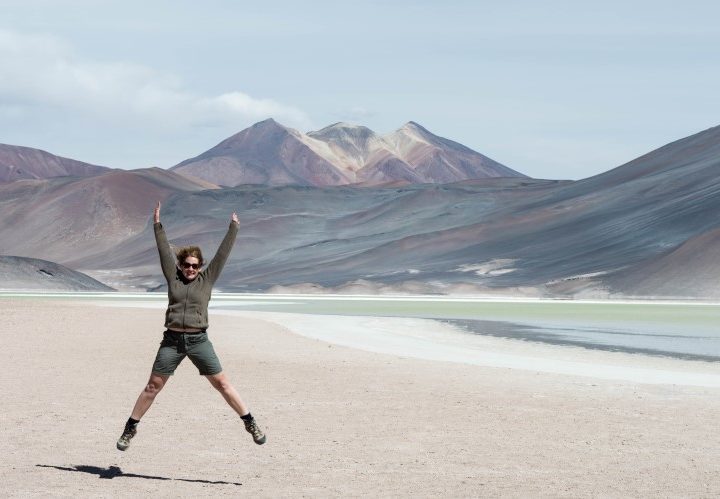
How to rent a car in San Pedro de Atacama
Plan ahead and instead rent a car in Calama, the biggest town in the region and about an hour’s drive from San Pedro de Atacama.
It’s also the main transport hub for visitors to the region, so you’ll likely fly into Calama El Loa Airport or arrive at its bus terminal.
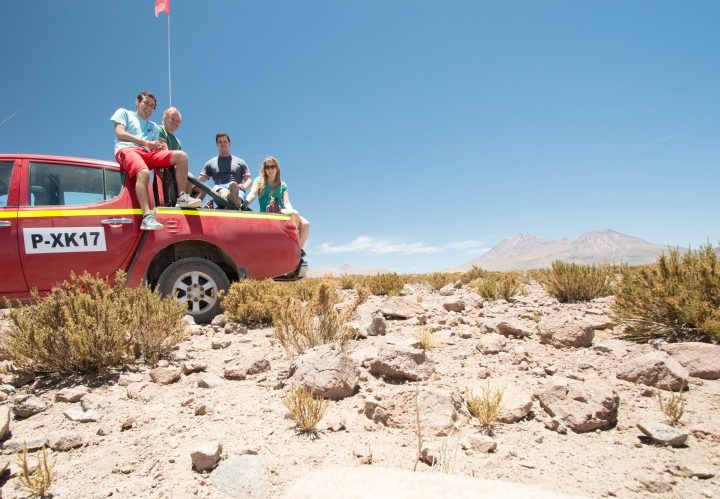
There are at least three international car rental companies in the city and I recommend using Rental Cars as they hook you up with the cheapest provider in the area – and all your insurance information is in English.
Make sure you book at least a month in advance if visiting during high season (December through February).
We found almost all of the vehicles to have been booked when we were there in early January and instead ended up renting very last minute with the Europcar office in San Pedro which charged us over $70,000 CLP ($113 USD) per day – hardly the cheapest way of doing it.
Expect to pay upwards of $300,000 CLP ($485 USD) for a one-week rental of a 4×4. Although it is possible to tour in a 2×4 (just don’t try and go off-road, we actually had to pull someone out of a sandbank who had), a 4×4 allows for more of an adventure, if at a higher price.
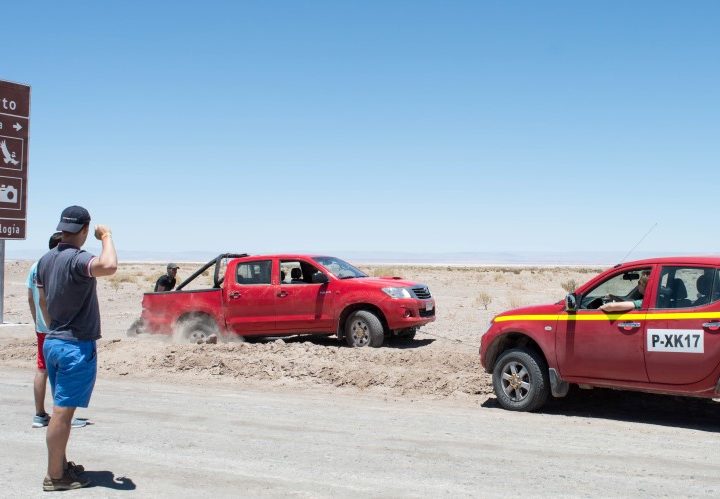
From Europcar we received a useful (but hand-drawn) road map of San Pedro de Atacama and its surroundings. This allowed us to plan where we were going as it included additional information about the various attractions, as well as distances between them.
I’ve tried to include as much of this information in this article. However, I would also suggest you download maps.me (and the other free apps that recommend for travel in South America ) as having an actual map and using GPS is always advisable.
FAQs about visiting San Pedro de Atacama
San Pedro de Atacama lies at the heart of the Atacama Desert and is known for its remarkable high-altitude landscapes, which are often compared to Mars. Home to vast salt flats, saline lagoons, and the third-highest geysers in the world – all of which are surrounded by a ring of volcanoes – the Atacama Desert is famed as a truly otherworldly place to visit.
Tours can take you out to the region’s top attractions, including the Valle de la Luna (Moon Valley), Géiseres EL Tatio (El Tatio Geysers), Laguna Chaxa (Chaxa Lagoon), and the Lagunas Altiplánicas (Altiplanic Lagoons). San Pedro de Atacama is also known for its clear night skies – on average, they number 320 per year – which makes it one of the best places in the world for stargazing.
Yes! While it gets exceptionally busy with tourists, particularly during the months of January and February, San Pedro de Atacama is worth visiting for the remarkable natural landscapes that surround the town and is considered one of the unmissable things to do on a trip to Chile .
Photographers and those who thrive on beautiful scenery will love the Atacama Desert, while those seeking high-adrenaline adventures such as sandboarding and horseback riding will find plenty to do here.
The best way to visit is by hiring a rental car to explore the region independently. Alternatively, you can book tours through one of a whole host of operators based in San Pedro de Atacama.
You need a minimum of four days in San Pedro de Atacama. It’s a two-hour flight from the Chilean capital, Santiago, to Calama, the nearest city to San Pedro de Atacama. From here, it’s a one-and-a-half-hour drive to reach the town itself, from where trips out to various natural landmarks within the Reserva Nacional Los Flamencos and the wider Atacama Desert begin.
There are plenty of activities in the Atacama Desert that you can do from San Pedro de Atacama. With four days, you’ll be spending half a day at each end getting to and from San Pedro de Atacama, which leaves you around three days in total. This should be with enough time for a dawn tour to see the Géiseres EL Tatio (El Tatio Geysers) and an afternoon tour to see the flamingos in Laguna Chaxa (Chaxa Lagoon), swim in the salty waters of Laguna Cejar (Cejar Lagoon) and see the sunset at Laguna Tebinquinche (Tebinquinche Lagoon).
You’ll also be able to spend a day exploring the Salar de Tara, plus a day seeing the beautiful Lagunas Altiplánicas (Altiplano Lagoons) and the vast red scenery of Piedras Rojas (Red Rocks). You can also catch the sunset at Valle de la Luna (Moon Valley) and go stargazing at one of the observatories surrounding San Pedro de Atacama.
Top things to do in San Pedro de Atacama and the Atacama Desert
1. visit piedras rojas (red rocks) and the salar de talar, ruta 23.
This was actually one of our final day trips and definitely my highlight from this list of things to do in the Atacama Desert. Surrounded by a ring of volcanoes, Las Piedras Rojas (Red Rocks; enter between 9am-4pm; site closes at 6pm; $18,000 CLP entrance fee; book in advance here ) are an expanse of red-hued rocks that look like a set of huge natural cobblestones.
You can walk on top of this weird natural formation while watching the gentle lapping of the neighboring saline lake and the blinding white of the Salar de Talar , a much smaller and cleaner salt flat than you will have seen previously in the Atacama Desert.
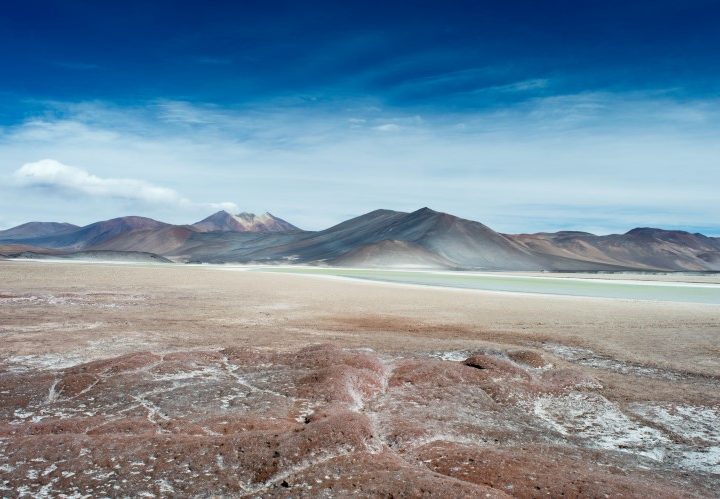
How to get to Piedras Rojas and the Salar de Talar
By rental car.
Ruta 23 leaves San Pedro de Atacama heading towards the south and is paved right until Socaire, 90 kilometers (56 miles) away, where you are now required to check in with a pre-purchased ticket (buy it here ) one hour in advance of the time you’ve booked. I’m not entirely sure how long this gives you at the state, but I imagine it’s a one-hour slot.
Yes, that seems insane, but Chileans love beauracracy. From Socaire, the road is a dirt track until you arrive at Salar de Talar and Piedras Rojas.
In total, the journey should take around two and a half hours. You can combine a visit here with sunset in Valle de la Luna or at Laguna Tebinquinche.
It’s also possible to continue along Ruta 23 as Laguna Tuyajto, 10 kilometers (6.2 miles) further along the road, often contains large groups of flamingos feeding in the shallows.
Don’t go too far along this road as you’re right on the Argentine border and you need special insurance to legally drive across.
Tours to the Piedras Rojas and Salar de Talar generally also include the Lagunas Altiplánicas (below) and Laguna Chaxa (also below), both of which are on the same road out from San Pedro de Atacama. Expect to spend around $55,000 CLP for a tour to all of these destinations.
2. See the dawn at El Tatio Geysers
With 80 active geysers on 10 square kilometers (2,470 acres), the El Tatio geyser field (5am- 5pm daily, $15,000 CLP entrance fee; more information here ) is the third largest in the world, and at 4,320 meters elevation (14,170 feet), it’s also the highest.
Rising before dawn is the prerequisite to see them at their most photogenic – which is worth the bone-rattling two-hour journey on an unpaved road.
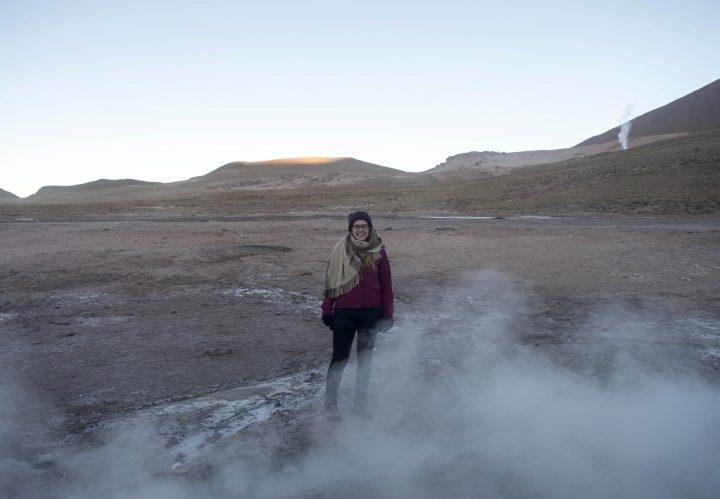
If you time it right, as the early light of dawn saturates the night sky, the fumaroles (steam from the geysers) are visible as they escape the earth in huge puffy columns, some of which can reach six meters in height. Get here too late and the steam doesn’t contrast as noticeably, making it less impressive.
The prime attraction is the spurting steam, but wildlife is also plentiful, and more observable after the deluge of tourists has departed. Vicuñas, viscachas, Andean foxes, and birdlife such as Andean gulls, black-billed shrike tyrants, and the bright yellow black-hooded sierra finch are found here.
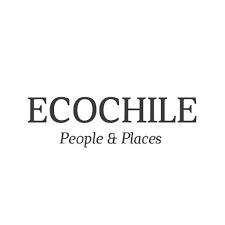
Want to avoid the hassle of organizing your flights, accommodation, and tours to San Pedro de Atacama?
EcoChile Travel is a brilliant local tour operator with whom I’ve traveled on several occasions and I love their commitment to sustainability and supporting local communities. Their four-day San Pedro de Atacama itinerary costs from $1,895 USD per person and takes you to some of the region’s top attractions, as well as to meet local weavers in a traditional adobe village to learn more about the culture of the Atacama. You’ll get 5% off if you mention Worldly Adventurer.
There’s also a rustic thermal bath that’s heated by the geysers, albeit at a cooler temperature. The hot water arrives through shafts in the bottom of the pool, meaning the water is not a consistent temperature, nor is the ambient air particularly warm.
Bring plenty of warm clothing for after your swim and wrap up warmly anyway, as temperatures are well below 0°C before dawn.
How to visit El Tatio Geysers
It can be difficult to find the route in your own vehicle in the dark, but since all the traffic leaves San Pedro at the same time to reach the geysers for dawn, it’s not too hard to follow the line of vehicles.
The road is unpaved, so a high-clearance vehicle is essential. Experience driving in high altitude conditions is recommended, as the road weaves up into the mountains and gains significant altitude.
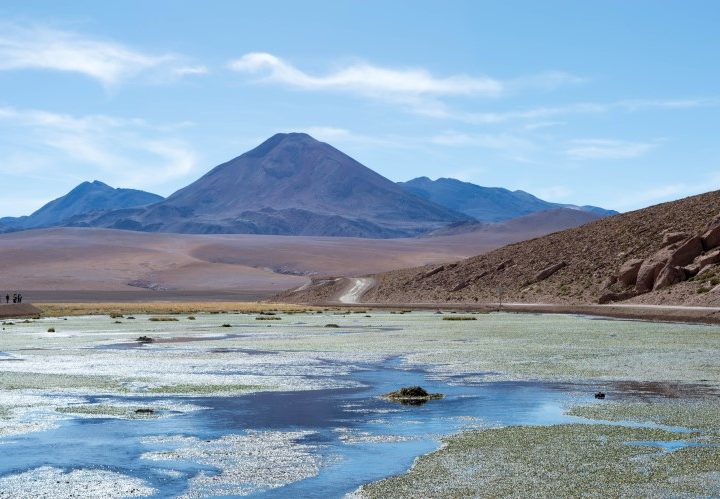
With a tour
Tours to El Tatio generally leave around two hours before dawn in order to be at the site for its most photogenic period. You can expect to pay around $40,000 CLP for a tour, which won’t include the entrance fee for the site.
Bring something soft to act as a pillow on the ride there (although you’ll need to be a heavy sleeper to snooze through the rough drive) and travel sickness medication if you experience motion sickness.
Planning Your Trip to Chile?
Save time, stress & money with a customized travel itinerary planned for you by a Chile expert
What previous clients have said:
“It’s refreshing to find someone with insider knowledge that can take you off the beaten track, away from the mainstream. I particularly liked the detail you give; where to stay and your favourite places. We stayed in some lovely places because of your knowledge, places that we would probably never have found. I also liked the fact that we could ask you questions whilst on the move. Lots to like Steph!”
3. Visit Laguna Miscanti and Laguna Miñiques
Located only a short distance from Piedras Rojas and the Salar de Talar are two gleaming lagoons, Miscanti and Miñiques (enter between 9am-4pm; site closes at 6pm; $10,000 CLP adults and $8,000 CLP children entrance fee; book in advance here ).
Salt-rimmed and flanked on all sides by gently undulating rusty-colored volcanoes and rough, sun-baked shrubs, these lakes (also known as the Lagunas Altiplánicas) are perhaps the most beautiful in the whole of the Atacama Desert.
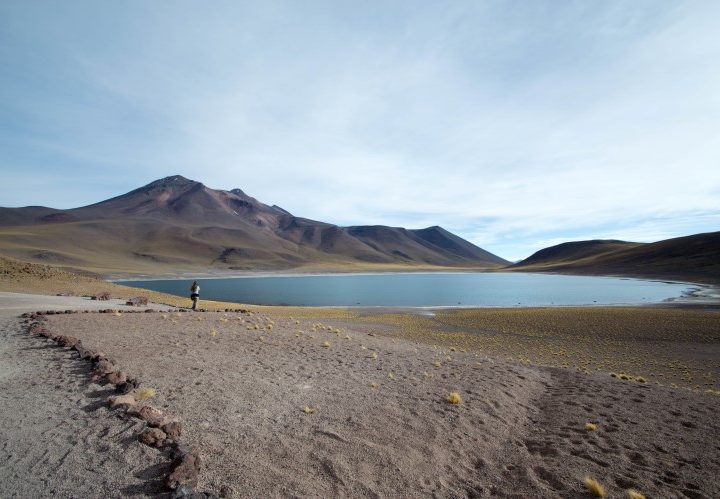
It is a true introduction to the barren landscapes of the Andean altiplano but the combination of motionless water and the brightest blue sky you will have even seen more than make up for the stark, inhospitable nature of the surrounding area.
How to get to Laguna Miscanti and Miñiques
From San Pedro de Atacama, it’s 90 kilometers (56 miles) to Socaire (around one hour). As with the Piedras Rojas, you are now required to check in with a pre-purchased ticket (buy it here ) in Socaire, one hour in advance of the time you’ve booked. I’m not entirely sure how long this gives you at the state, but I imagine it’s a one-hour slot.
From Socaire, it’s a further 20 kilometers (12.5 miles) to reach the turn-off to the lakes (which I think is signposted).
Be aware that they’re located at an altitude of 4,320 meters (14,170 feet) above sea level so make sure you bring plenty of water to stay hydrated on the trip.
Tours to the Lagunas Altiplánicas also tend to include Laguna Chaxa (below), the Piedras Rojas, and Salar de Talar. Expect to pay around $60,000 CLP for a tour to all of these destinations or just $35,000 CLP without the latter two.
4. Go off the beaten path at the Valle del Arcoíris (Rainbow Valley) and the petroglyphs of Hierbas Buenas
Perhaps the least visited of the places on this list of things to do in the Atacama Desert, Valle del Arcoíris ($5,000 CLP entrance fee) and the nearby Yerbas Buenas petroglyphs ($5,000 CLP entrance fee) are two other places that I strongly recommend, particularly if you’ve rented a car.
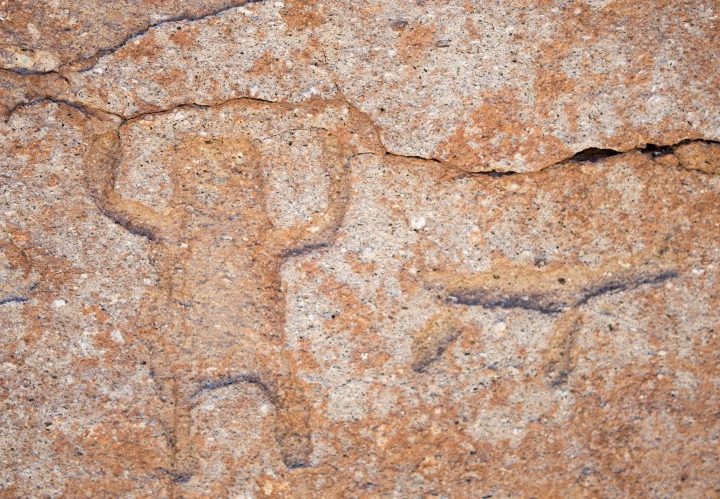
Your first stop will be the petroglyphs, where a series of rocky outcrops house carvings that have left relief images of guanacos, foxes, men, and cross-legged shaman.
It’s the best site for seeing cave paintings in the whole region and it’s not hard to see how these carvings have been so well-preserved – the fierce dryness of the desert is excellent at keeping things in place – and it’s worth considering the indigenous groups who survived in such a hostile place when you’re admiring these incredible etchings.
Valle del Arcoíris (Rainbow Valley) is next: an aptly named tapestry of multicolored rocks that weave through a series of hills through the river basin of Río Grande. They are hued in mint green, dusty red, and even splashes of white, caused, no doubt, by the mineral content of the rock.
We arrived for sunset and the shadows cast over the valley added an extra sense of magic. We didn’t see any other tourists during our visit – if you want to find things to do in the Atacama Desert far away from the gringo trail then a trip to Valle del Arcoíris definitely fits the bill.
How to get to Valle del Arcoíris (Rainbow Valley) and the petroglyphs at Yerbas Buenas
Take Ruta 23 north-west out of San Pedro de Atacama until at around 35km (30 minutes) you reach a right-hand turning onto a dirt road which is signposted towards Río Grande.
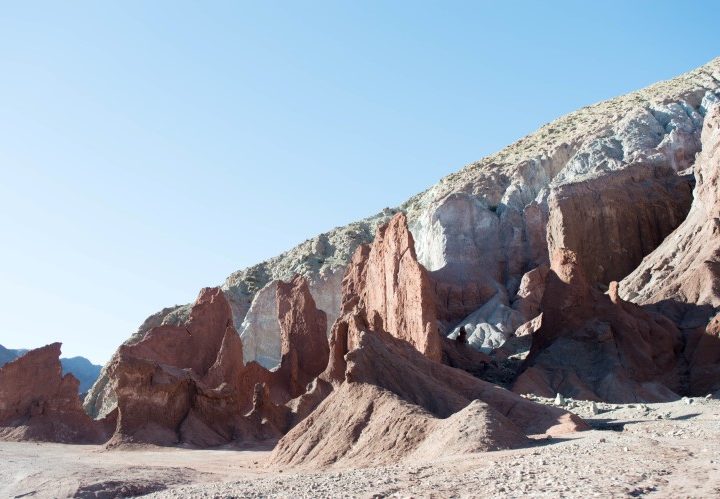
After around another half an hour you should arrive at Yerbas Buenas and the petroglyphs where you must pay $5,000 CLP entry. From there, continue along the main road and take the left turning towards Lican before you reach the bridge.
All of this is unpaved and only suitable for vehicles with high suspension. Continue along this road and after about 15-20 minutes you should start seeing the colors of the valley. They now charge $5,000 CLP for entrance to the valley; I’m not sure where you pay this, but there will likely be a booth by the side of the road.
Again, I would strongly recommend you download maps.me (literally my favorite adventure travel app) on your phone before you leave as it’s not the easiest place to find and there’s also the possibility of getting lost in the valley as there are several dirt tracks that pass through.
An easier way to reach Valle del Arcoíris and the petroglyphs is with a tour from San Pedro. This should cost around $35,000 CLP for a half-day tour.
5. Go stargazing in the Atacama Desert’s remarkably clear skies
Because of the lack of light pollution and the average 330 clear nights that the region experiences annually, the Atacama Desert is one of the best places on the planet to appreciate the night sky .
Not only will you be able to see various constellations visible from the Southern Hemisphere, but you’ve got a very strong chance of seeing the Milky Way in all its glory. For the best opportunity, you’ll find the most favorable stargazing conditions are in October-November; avoid January-February, which can see electric storms and clouds, and August-September, when high winds cause dust storms.
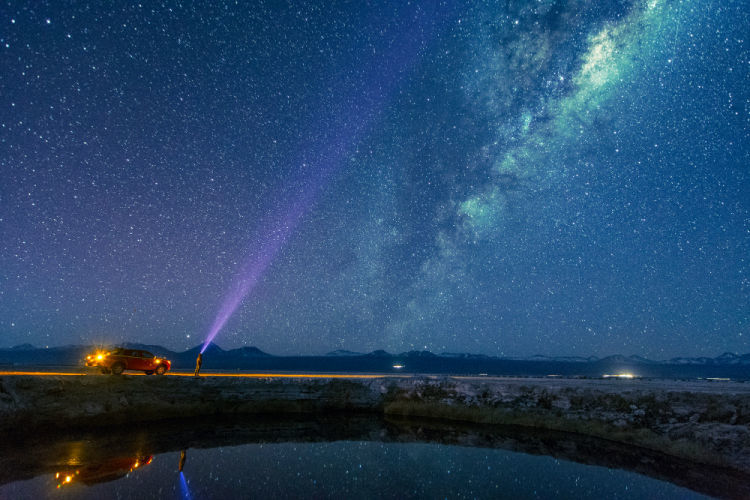
I’ve both driven out into the desert for some independent stargazing and taken a tour and, if you want to learn about the stars and get a really good view of them, I highly recommend the latter.
How to go stargazing in the Atacama Desert
Stargazing tours.
San Pedro de Atacama Celestial Explorations (SPACE) are regarded as the best in San Pedro de Atacama as they have 15 telescopes on-site, including a 720-centimeter telescope, the largest public telescope on the continent.
They conduct tours in English, Spanish, and French and are so popular that you will need to book; they’re often fully reserved a week or so in advance.
However, if you are traveling on your own then it’s possible to visit the office about 5/6pm to see if there have been any cancellations.
This happened to me for a Spanish-speaking tour on the same evening and a guy I met got on an English tour using the same method.
After leaving San Pedro (Domingo Atienze and Caracoles) and a 15-minute journey to the observatory, six kilometers (four miles) south of town along Ruta 23, the tour starts beneath the stars with an informative and entertaining overview, including beliefs of our ancestors and how stars got their names.
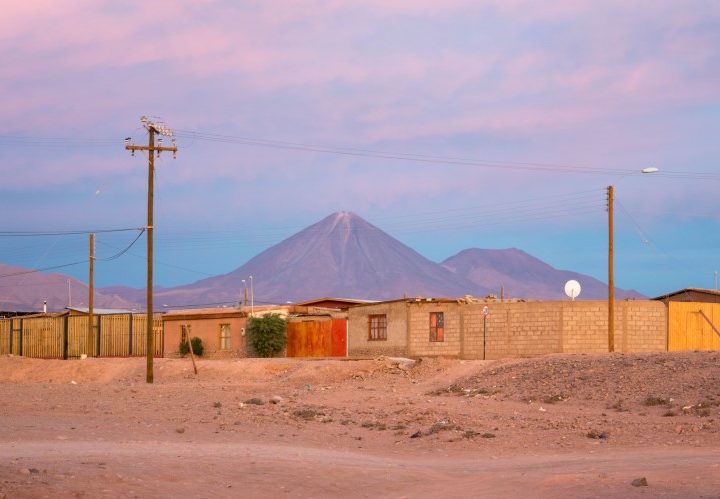
You’ll then be shepherded toward the telescopes and told about what they’re trained on and given a cup of hot chocolate and a Q&A session, before being driven back to San Pedro.
One of the best parts of hiring a car to visit the Atacama Desert is the freedom it gives you to drive off into the wilderness. Not only did we spend an afternoon taking tiny dirt roads just to see where they went, but we drove out of San Pedro and to a spot a few kilometers away where we could enjoy some stargazing .
Although I would certainly recommend taking a proper tour (see below), it was still a lot of fun taking the truck out, finding a spot without any light pollution, and enjoying the stars.
The police did come and ask us what we were doing (I think a person in a nearby house had alerted them to our vehicle) but “estamos viendo las estrellas” (“we’re watching the stars”) was enough explanation.
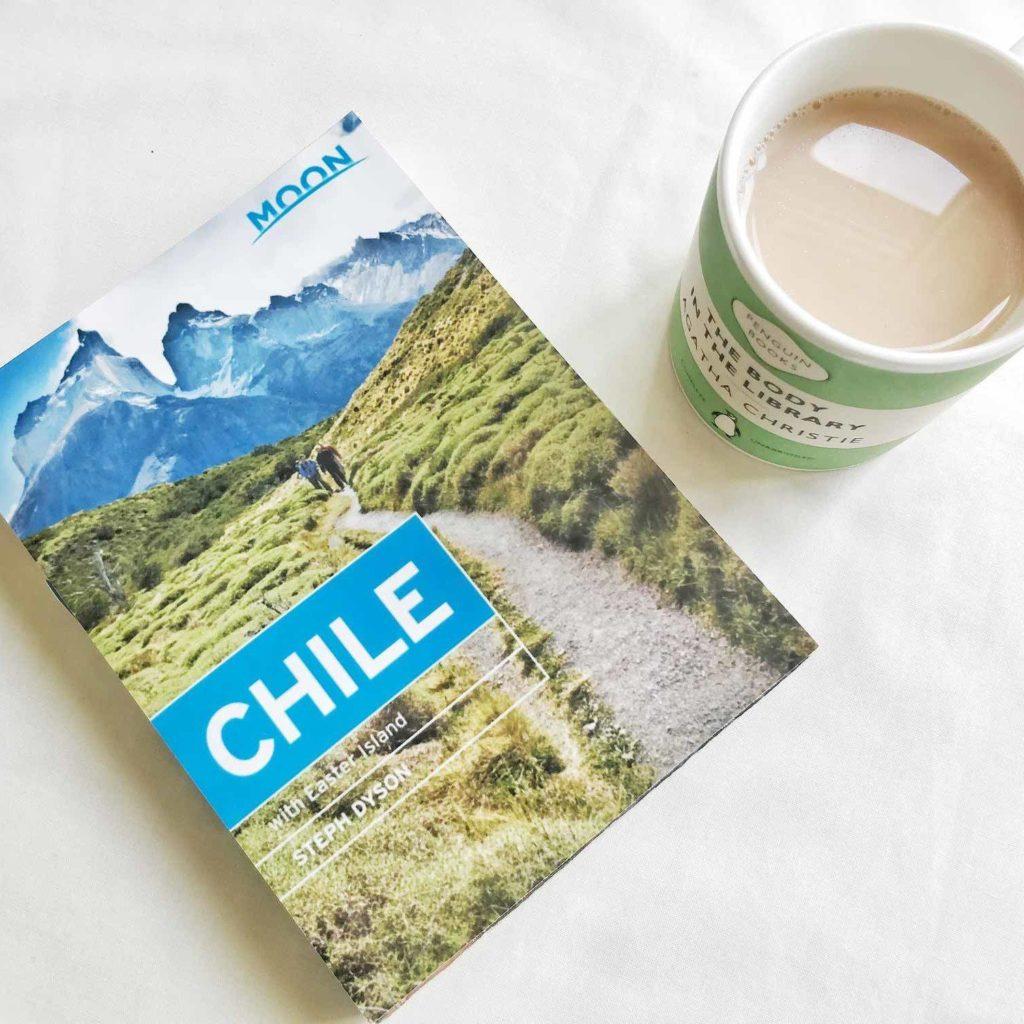
Need more inspiration?
You’ll find even more detailed itineraries, off-the-beaten-path gems, hiking routes and accommodation, restaurant and tour recommendations to suit your travel style in my brand-new guidebook, Moon Chile.
We took the road off towards El Tatio Geysers and pulled off down a dirt track and parked up by the side of the road.
You don’t have to get far away from the town to escape the light pollution and to realise why the Atacama Desert is one of the globe’s most spectacular places for admiring the constellations.
6. See the sunrise or sunset over the Mars-like Valle de la Luna
Ten kilometers west of San Pedro de Atacama, the Valle de la Luna (Moon Valley; 9am-7pm Sun.-Fri., $10,000 CLP adults, $5,000 CLP children entrance fee; book at least a day in advance here ) is a jarring set of red and white rock formations created by tectonic forces four million years ago. This is easily the most popular of the region’s attractions, thanks to its proximity to San Pedro.
These canyons are special at dawn or dusk when the shadows lengthen and the soft light paints this bizarre lunar landscape and the Andes beyond in hues of pale pink. Take plenty of layers as the temperature drops rapidly at night.
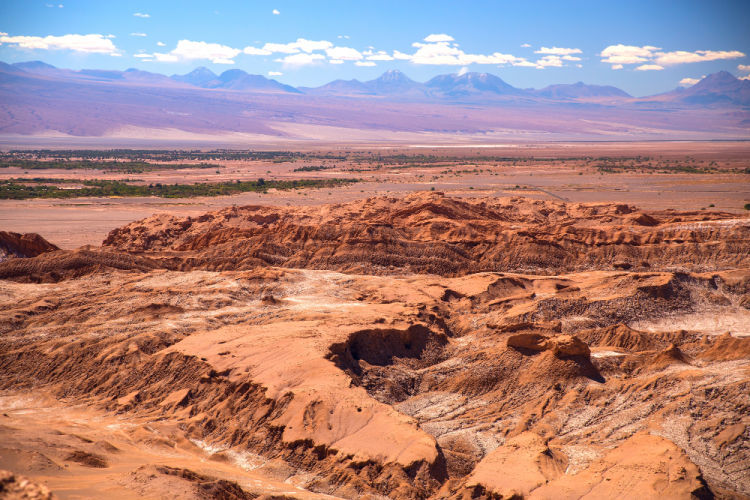
How to explore the Valle de la Luna
To explore the salt caverns and climb the sand dunes, take Ruta 23 toward Calama on the northwest edge of town and turn left 600 meters after the bridge over the Río San Pedro. Follow the signs to Valle de la Luna and a toll booth where you show your ticket.
Hiring a bicycle and pedaling to the valley is a low-cost alternative, possible during the day (bring plenty of water) or, better still, on nights with a full moon, as the main highway lacks street lamps. From San Pedro, it’s a 30-minute ride to the ticket booth and another 15 minutes to the caverns.
Rent a bike from one of the agencies in San Pedro (along Toconao, south of Caracoles). Rentals cost $10,000 CLP for the whole day; ask to keep the bike overnight for an additional $15,000 CLP.
The popularity of this location means you’ll be sharing the sunset with at least a few other travelers. It’s relatively quiet during the day, so consider visiting earlier to avoid the crowds.
Tours normally involve walking through the valley, visiting some of the vast salt caverns, and sitting atop a sand dune to watch the sunset.
You can expect to pay around $20,000 CLP for a tour, which typically leave in the afternoon around 3pm to catch the moment the sun drops behind desert.
7. Drive out to the bewitching and remote landscapes of the Salar de Tara
Although we were told at the time that visiting the Salar de Tara was among the things to do in the Atacama Desert that you can only experience with a tour, it is actually possible to reach this huge stretch of salt flats and lagoons using your own vehicle.
As one of the least visited places in the Atacama Desert, you’re unlikely to spot any other tourists during your day trip and have this whole unique landscape all to yourself.
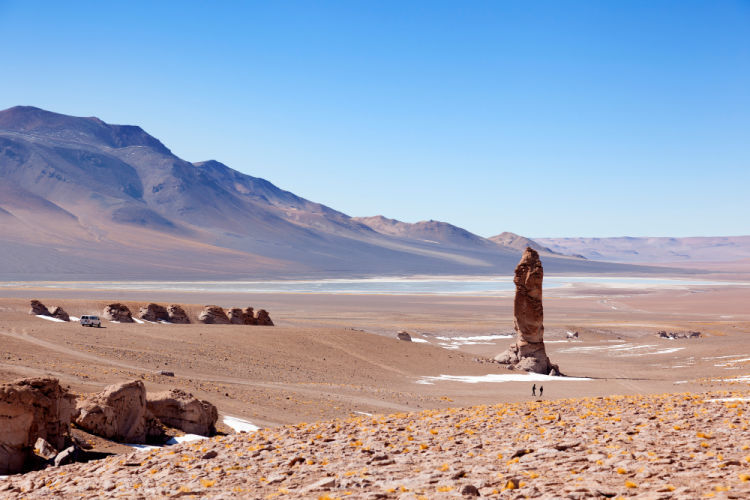
At the center of the salt flats is a vast salt-rimmed lagoon, home to an array of wildlife, including breeding flamingos, vicuñas, Andean foxes, and birds such as the puna plover and Andean goose.
Don’t miss the Monjes de la Pakana (the Pakana Monks), a series of rock pillars weathered by wind erosion to resemble the silhouettes of monks, although they are also known as the Moais of Tara, a reference to their similarity to the monolithic moai statues found on Rapa Nui.
How to visit the Salar de Tara
Most people visit the Salar de Tara with a tour, as the lack of defined roads to reach it makes it a hazardous journey if you’re not familiar with the area. Tours typically cost around $70,000 CLP and leave San Pedro at 8am and return by 4pm.
Groups visit Salar de Tara as an independent destination, as it’s not easy to combine with the region’s other attractions in the same day.
Part of the issue with visiting the Salar de Tara is that there are no clearly defined roads on the map and you definitely do need a 4×4 to arrive. I would recommend that you speak to the owner of your hostel and see if they can provide you with a map for how to get there.
From Ruta 27 from San Pedro de Atacama, it’s about 100 kilometers (62 miles) to reach Monjes de la Pacana and then from here it’s off-road – at which point you will need instructions to get to the Salar de Tara.
8. Try sandboarding
Two kilometers north of Valle de la Luna, the undulating Cordillera de la Sal continues before it becomes Valle de la Muert e, a name derived from confusion over a French accent.
It was originally named Valle de Marte – Mars Valley – by a Belgian man living in the region. His accent was misunderstood and it became known as Valle de la Muerte.
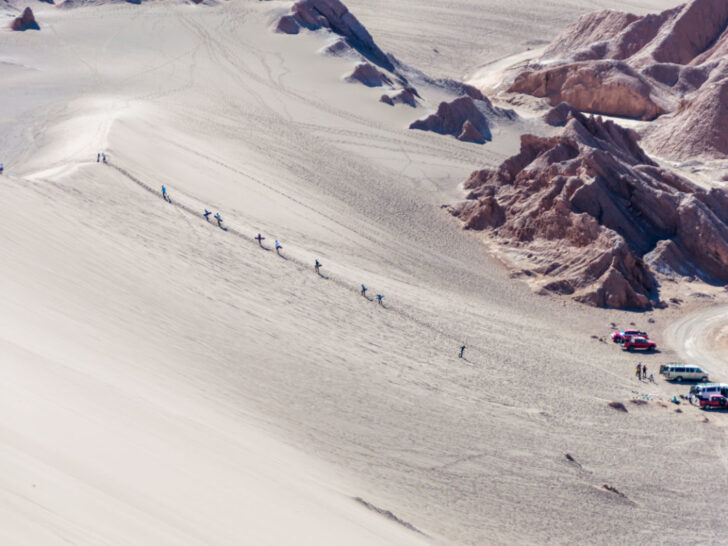
With its slopes of golden sand and strips of red rock, it’s as otherworldly as Valle de la Luna, but significantly quieter, with fewer visitors. Most come as part of sandboarding tours from town, with the rippling waves of sand providing an adventure playground for adrenaline seekers.
How to visit the Valle de la Muerte
Because you’ll need to hire equipment, it’s not possible to go sandboarding without a tour. You’re unlikely to be whizzing down the dunes as fast as the pros, but a 3.5-hour tour with Sandboard San Pedro is excellent cardio and a brilliant way of seeing the desert from a new perspective.
Tours are for beginners and upwards and for CH$45,000 you get equipment that includes a helmet, an English-speaking guide, a souvenir video, and transport to the sand dunes from their office. Tours leave at 9am and 4pm daily, but you will need to reserve in advance. (reservation required).
During the full moon and occasional Saturdays, they run nighttime excursions at 9pm ($50,000 CLP). Tours focus on the dunes in Valle de la Muerte; those to Valle de la Luna have been suspended due to erosion.
9. Catch the sunset at pink-hued Laguna Tebinquinche
The ultimate destination for sunset, Laguna Tebinquinche (4pm-8.30pm summer, 3pm-8.30pm winter, $5,000 CLP entrance fee) is a large saline lake bordered by stretches of hardened salt that turn a soft pink as the light drops.
The view is made even more magical by the orange hue of the mountains in the east, making this one of the most unique places to catch the sunset in the Atacama Desert.
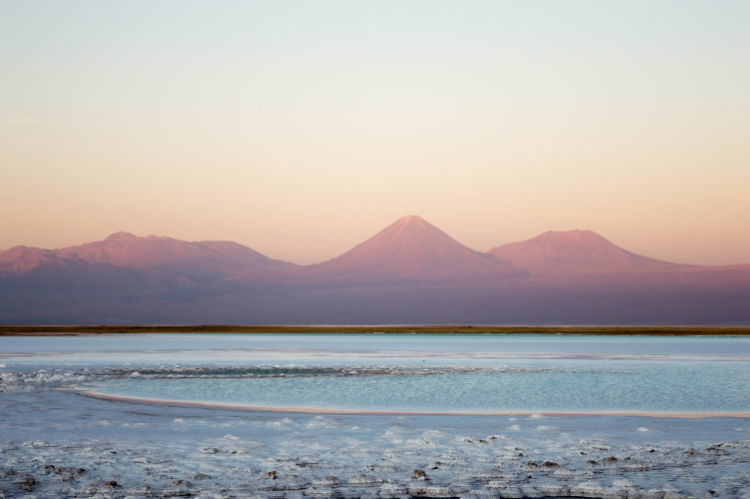
While there are plenty of tour groups catching the very same view at the very same time, it was still my favorite place to see the sun go down – and a pisco sour (which is normally included in the tour) only added to the enjoyment!
How to visit Laguna Tebinquinche
Laguna Tebinquinche is very easy to reach independently. Turn left off Ruta 23 16 kilometers (10 miles) south of San Pedro de Atacama and head east and then due south along the dirt road to reach Laguna Cejar and then, a couple of kilometers further, Laguna Tebinquinche.
Most tours continue from Laguna Cejar south for a couple of kilometers to spend sunset on the lake’s pastel-hued shores. For $33,000 CLP, you’ll see get a pisco sour and nibbles to toast the dusk, but remember to wrap up warm when the sun finally sinks behind the Cordillera de la Sal.
10. See all three species of flamingos at Laguna Chaxa
When it comes to the region’s most famous water-loving residents – flamingos – there’s one place to head. Laguna Chaxa (8am-1pm, 2pm-6pm daily, $8,000 CLP adults, $4,000 CLP children entrance fee; book in advance here ) is one of the best destinations for spotting flamingos in the Atacama Desert as it’s home to large colonies of all three altiplano species: James’s, Andean, and Chilean.
It’s located within Reserva Nacional Los Flamencos (Los Flamencos National Reserve) and the vast Salar de Atacama, which stretches south from San Pedro de Atacama for over 100 kilometers (62 miles) and is the third largest salt flat on the globe.
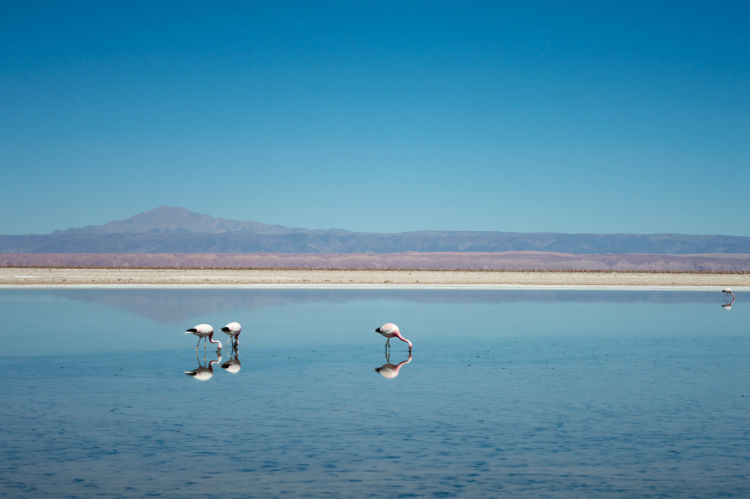
It was formed by water deposits from the Andes Mountains collecting in this natural basin and evaporating to leave a crust of salt; bear in mind that the sediment – dirty and resembling dead coral – is significantly less impressive than El Salar de Uyuni, the world’s largest salt flat across the border in Bolivia.
The best time to see the flamingos at Laguna Chaxa is when they’re most active. At sunrise, you’ll see them busy slurping the water for algae, but whatever the time of day, you’ll find this lake picture-perfect, with their pink bodies reflected in the water against a backdrop of pastel-hued mountains.
How to visit Laguna Chaxa
Laguna Chaxa is reached by taking Ruta 23 out of san Pedro south to the settlement of Toconao; continue 3.5 kilometers (two miles) south of the town and take the dirt B-355 west for another 20 kilometers (12.5 miles).
You’ll generally find that tours visiting Piedra Rojas and the Lagunas Altiplánicas stop at Laguna Chaxa on the way to or from San Pedro de Atacama. It should cost around $60,000 CLP to see all three destinations.
11. Find out what it feels like to be weightless at Laguna Cejar
Going to space might not be an option for most of us, but if you’re wondering what it feels like to be weightless then head out to Laguna Cejar ($15,000 CLP adult, $5,000 CLP children, 9am-1pm open to the public; 2pm-6pm open to tour groups; book in advance).
This sinkhole has a salt concentration of 28 percent, which means that when you enter, you can float weightlessly. The water is cold, but it’s refreshing in the blazing heat of the desert and the feeling of bobbing around on the surface of this tranquil lake is more than worth the discomfort.
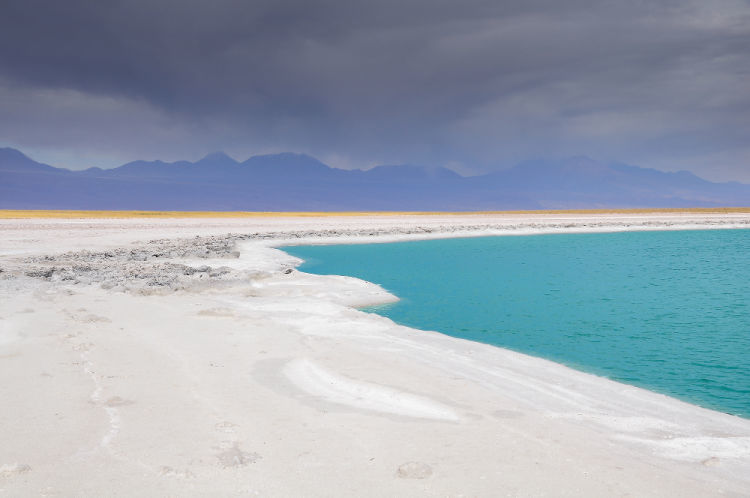
Bear in mind that the chemicals in sunblock have done damage to the fragile ecosystem of the water, so you’re not allowed to enter the water with any chemicals on your skin – so you’ll want to be careful about how long you spend in the water to prevent getting sunburn.
How to visit Laguna Cejar
To reach Laguna Cejar on your own, take Ruta 23 south from San Pedro for 17 kilometers (10.5 miles), then take a sharp right along the dirt track. It’s around a 30-minute drive from town.
It’s only open to the public between 9am and 1pm and you’ll need to book tickets in advance through this website . It’s also possible to persuade the people at the gate to let you enter for free for 30 minutes to take photos.
Organized tours typically start mid-afternoon from San Pedro de Atacama, stopping at the Ojos del Salar (one saltwater and one freshwater pool, the latter of which you can swim in) before heading to Laguna Cejar around 4pm and onwards to sunset at Laguna Tebinquiche.
Expect to pay around $33,000 CLP for this tour.
12. Take a dip in the Termas de Puritama hot springs
The Atacama Desert isn’t known for its cool daytime temperatures, so you might be surprised to learn that one of the most popular things to do here is to visit a series of natural hot springs in the Rio Puritama, a 30-minute drive north of San Pedro de Atacama.
The eight, crystal clear hot springs at the Termas de Puritama (9am-6:30pm daily, $30,000 CLP, $16,000 CLP 5.30pm-6.30pm; book in advance) have temperatures of between 25°C and 30°C, with the purportedly relieving rheumatism and arthritis due to the high concentration of sodium sulfate. However, when the air temperature is warm, they can feel less than refreshing.
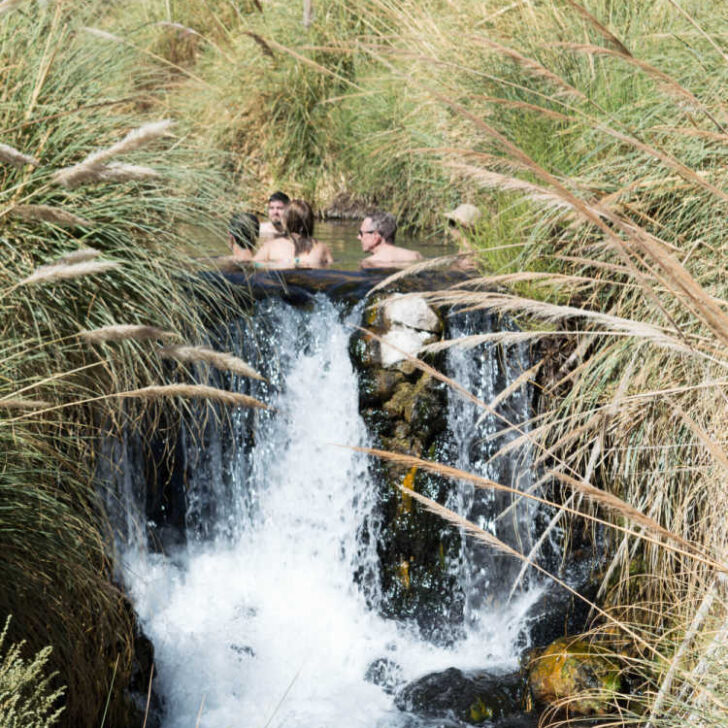
The pools are in graduated sections of the valley and connected by small waterfalls. Each pool is accessible via a wooden walkway. The entrance fee is steep and gives you three hours in the pools; so it’s worth spending an entire morning or afternoon to get your money’s worth – or arrive for the sunset swim at 5.30pm instead.
How to visit the Termas de Puritama
The springs are 30 kilometers (19 miles) north of San Pedro on the road toward Géiseres del Tatio and are clearly signposted from the road. The road from Guatin is bumpy to say the least, so drive slowly. You must book your tickets in advance here .
Tours to the Géiseres del Tatio typically stop at the thermal springs on the way back from San Pedro de Atacama for no additional cost.
13. See meteorites from space at the Museo del Meteorito
While stargazing is a highly recommended activity in San Pedro, it’s also worth looking a little bit closer to home to learn more about space.
The Museo del Meteorito (6pm-9.30pm Tues.-Sun., $5,000 CLP adult, $4,000 CLP child) is housed in two large geodesic domes and offers fascinating insights into the arrival of objects from space.
It was born from the passion of two local brothers and now displays 77 of a collection of over 3,200 meteorites that have landed in the Atacama Desert; some have been dated to 4.5 million years old.
A free 45-minute audio guide, available in five languages, provides technical descriptions of the meteorites but most of the fun is admiring the rocks on display.
Ever touched something millions of years old? You’ll have the chance here, as two plastic cases with holes allow you to inspect the rocks close up and even touch them.
How to visit the Museo del Meteorito
Independently.
The museum is just north of the main streets of San Pedro de Atacama, making it within easy walking distance.
14. Sample wine from one of the highest-elevation wineries in the world
A desert – and the world’s driest nonpolar desert in the world – probably doesn’t sound like a likely place to grow vines. At least, that’s what I thought until I visited the indigenous Toconao community and their vineyards.
At 2,468 meters (8,097 feet) elevation, the vineyards of Viña Santa Romina (10.30am-5.30pm summer, 9.30am-4.30pm winter), are the highest in Chileand among the highest in the world. But one of the most remarkable features is seeing how neat rows of vines grow out of parched sand – all against the backdrop of the arid Salar de Atacama.
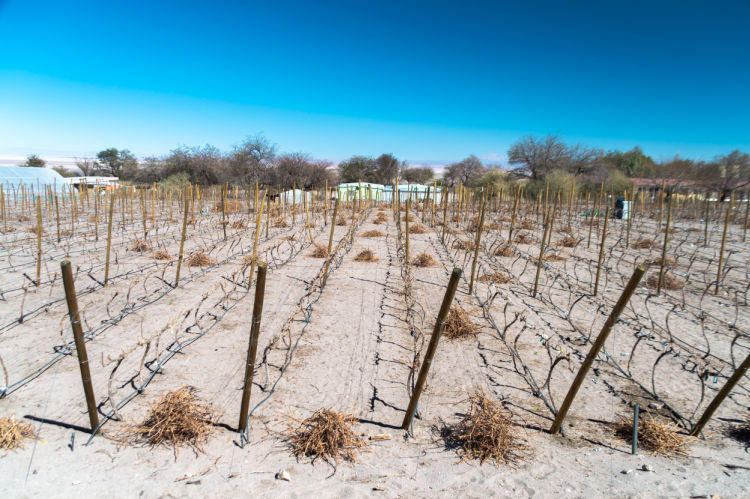
Visiting Santa Romina is a chance to learn about how exactly you grow grapes in a desert, before sampling their Ayllu wines, which have taken on the unique climatic conditions and volcanic soils of Atacama to produce bold flavors.
The vineyard itself is operated by a cooperative of indigenous Lickanantay people from the community, who have been cultivating wine since the 16th century. It’s a very unusual place, but still one of my favorite wineries in Chile !
How to visit Viña Santa Romina
No tour operators currently run trips to Viña Santa Romina, so you need to have your own transport. Book a tour directly here , which includes a tour of the vineyard and winery, plus a tasting of three of their wines for $44,990 CLP.
Useful information about visiting the Atacama Desert
Comprising more than 73,000 hectares in seven sections south and southeast of San Pedro, the spellbinding Reserva Nacional Los Flamencos contains many of the sights mentioned above
Most of the reserve’s seven sections have their own entrance station and there is no general park admission fee, so you’ll need to bring cash with you to pay for individual entry fees at the CONAF ranger station at the entrance.
Altitude is one of the biggest challenges of exploring the Atacama Desert, as many of the attractions are situated at elevations above 3,000 meters (9,850 feet). To avoid contracting altitude sickness, it’s best to work your way from the lowest- to the highest-elevation sights, particularly if you’re driving, as the effects of altitude can cause accidents.
If you’re planning on cycling to the Valle de la Luna or around San Pedro de Atacama itself, take plenty of water, sunscreen, and a hat to avoid heatstroke.
Where to stay in San Pedro de Atacama
Accommodation in San Pedro de Atacama is very expensive, even by Chilean standards.
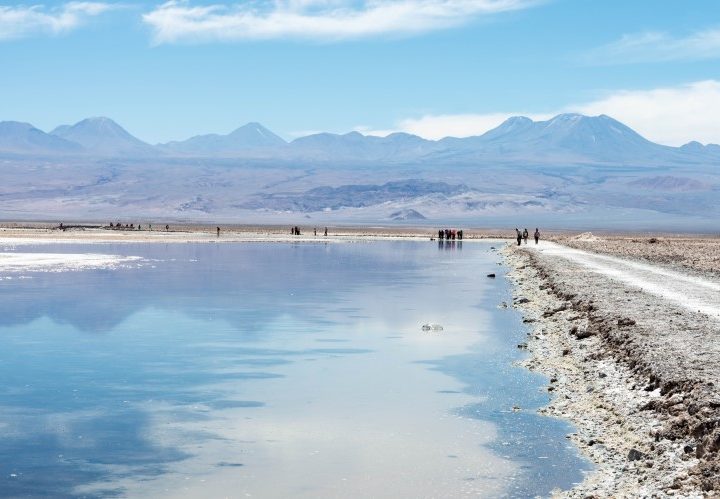
Following my visits to San Pedro de Atacama, the following places are my top picks.
I stumbled upon Ckuri Atacama ($80 USD) double) online and this is definitely the nicest place you will find in San Pedro. They only have three rooms and it’s best if you’re a couple (they’re only double rooms), but they all include a bathroom with shower, large double bed and a small dining area with fridge, cutlery and plates.
Breakfast isn’t included but you can easily buy what you need and eat in your own personal dining area! The owner, Edgar, is really really friendly and can help you out booking tours or with suggestions for dinner. They also have bikes that are free of charge to borrow and are in the process of building an upstairs terrace where they’ll have a telescope for star gazing.
If you’re looking for more space and facilities, the ten large bedrooms, decorated with thatch ceilings, adobe walls, and beautiful Andean textiles, make up the gorgeous Hotel Pascual Andino ($219 USD double). It’s situated just outside of the center of San Pedro de Atacama, making it within a stone’s throw of all of the town’s restaurants but without the unwelcome noise pollution.
Each room has a shady outdoor patio with rattan furniture as a place to relax during the cool evening, although each has access to an outdoor lounge and a small pool, which will likely become your go-to location during the heat of the day.
The hotel’s free bikes are also handy if you fancy heading out to Valle de la Luna for a spectacular sunset, or just as a means of exploring the town on two wheels.
Where to stay in San Pedro de Atacama on a budget
Just a short, 10-minute walk from the main street in San Pedro de Atacama lies one of the town’s best budget choices: Hostal Pablito ($85 USD double). With its large, year-round swimming pool and comfortable, impeccably clean bedrooms, this guesthouse feels like a real bargain. The staff are very welcoming and can be flexible with early breakfasts where required for pre-dawn tours.
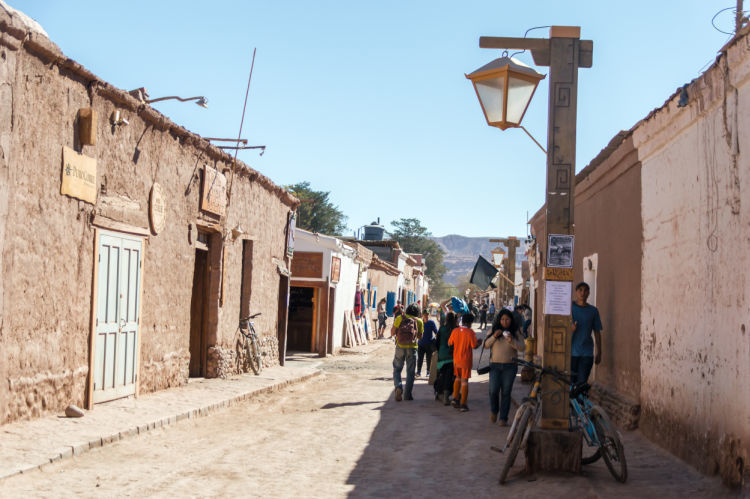
Another option is Backpackers San Pedro Hostel ($14,000 CLP ($16 USD) dorm, $33,000 CLP ($38 USD)). It’s clean and had plenty of communal space (including two large kitchens) but is a little out of town (which shouldn’t be too serious but it is hot and difficult walking at 2,400 meters above sea level in a desert!). It’s a more relaxed option than many of the other hostels in town, although noise can still be an issue here.
Remember that, as in most of South America, there are a lot more hostels on the ground than you’ll find on the internet, so be prepared to take a wander around looking for accommodation that you might otherwise have missed.
Transportation to and from San Pedro de Atacama
From San Pedro de Atacama, buses leave for Salta, Argentina (11 hours). These generally only depart in the morning and as this is a popular crossing for backpackers, it’s recommended to book a couple of days in advance.
From nearby Calama (one hour’s drive from San Pedro), you can find buses to Bolivia (eight hours) (again only leaving in the morning and not necessarily every day) as well as buses to Santiago (24 hours).
Flights from Calama de Santiago can often be only a little bit more expensive than buses and take a tenth of the time. Flights start from $57,000 CLP ($92 USD) but it’s worth booking a few weeks in advance.
Compare prices on Skyscanner.com and try Jetsmart (super budget) or Sky Airline (budget) for the cheapest flights.
From Calama, minibus transfers leave directly after flights arrive and cost a fixed rate of $15,000 one-way and $28,500 return:
- TRANSVIP (tel. 55/2267 7300)
- Transfer Pampa Expedition (tel. 9/5256 0722 or tel. 9/5226 0720, [email protected] )
They all offer shared transfers to and from hotels in San Pedro, one and a half hours away.
You can organise for them to pick you up from your hostel if you have a flight back from Calama. An easier way is to rent a car directly from Calama Airport through Rental Cars .
Other inspiration for places to visit in Chile
While there are plenty of adventure travel destinations in Chile , particularly in the north of Chile, no trip here would be complete without heading to the far south and Patagonia – a true adventure playground for travelers!
From the ultimate Chilean road trip along the Carretera Austral to penguin colonies and wild Patagonian scenery , there are plenty of reasons to head south after your trip to the Atacama Desert. Get inspired with these four Patagonia travel itineraries for short trips !
Tuesday 5th of December 2023
Hi, thanks for your very useful website. Can you please tell if Piedras Rojas is a separate ticket or I am covered if I have the ticket to Aguas Calientes Salt Flats + Miscanti and Miñiques Lagoons? I couldn't tell if Piedras Rojas is simply the name of the road or a separate point of attraction. If it's a separate ticket, can you please re-post the link?
Steph Dyson
Sunday 14th of January 2024
Hi Pushkar, it's the same ticket as far as I'm aware. Steph
Giselle Valdeiro
Wednesday 1st of November 2023
Hello Steph - I am visiting Atacama in January and used the link in your post to book tickets to Piedras Rojas... The Socaire Chile website had a tab for 'visit SALAR DE AGUAS CALIENTES SUR "Red Stones". Is that the same as Piedras Rojas?
Best regards Giselle
Thursday 23rd of November 2023
Hi Giselle, yes it is! Steph
Tuesday 18th of July 2023
Hi there nice blog thanks for the tips! But some info is not correct and should be updated. >It is not possible to visit ALMA anymore (closed for 3 years already). >Also SPACE does not have an office anymore, you can only reserve by e-mail, the response is slow and tours will get full quickly, so plan at least 1-2 weeks in advance. Both were disappointments for us, so hope this update will help other travelers.
Thursday 18th of May 2023
Do you still need to prebook things in the Atacama desert during the off season? We are going the 20 of May. Ww are considering renting a car (which I know is your recommendation) but don’t want to prebook. Someone told me that if you go by car you can only visit places in the morning as the afternoons are reserved for tours. Please let me know. Thanks
Monday 5th of June 2023
Sorry I didn't respond to this earlier Sue. I hope you got it sorted!
Sunday 13th of March 2022
You can book the "Valle de la Luna" tickets on https://www.puntoticket.com/ ..just type in valle de la luna to find it!
Monday 21st of March 2022
Thank you Victoria! Steph
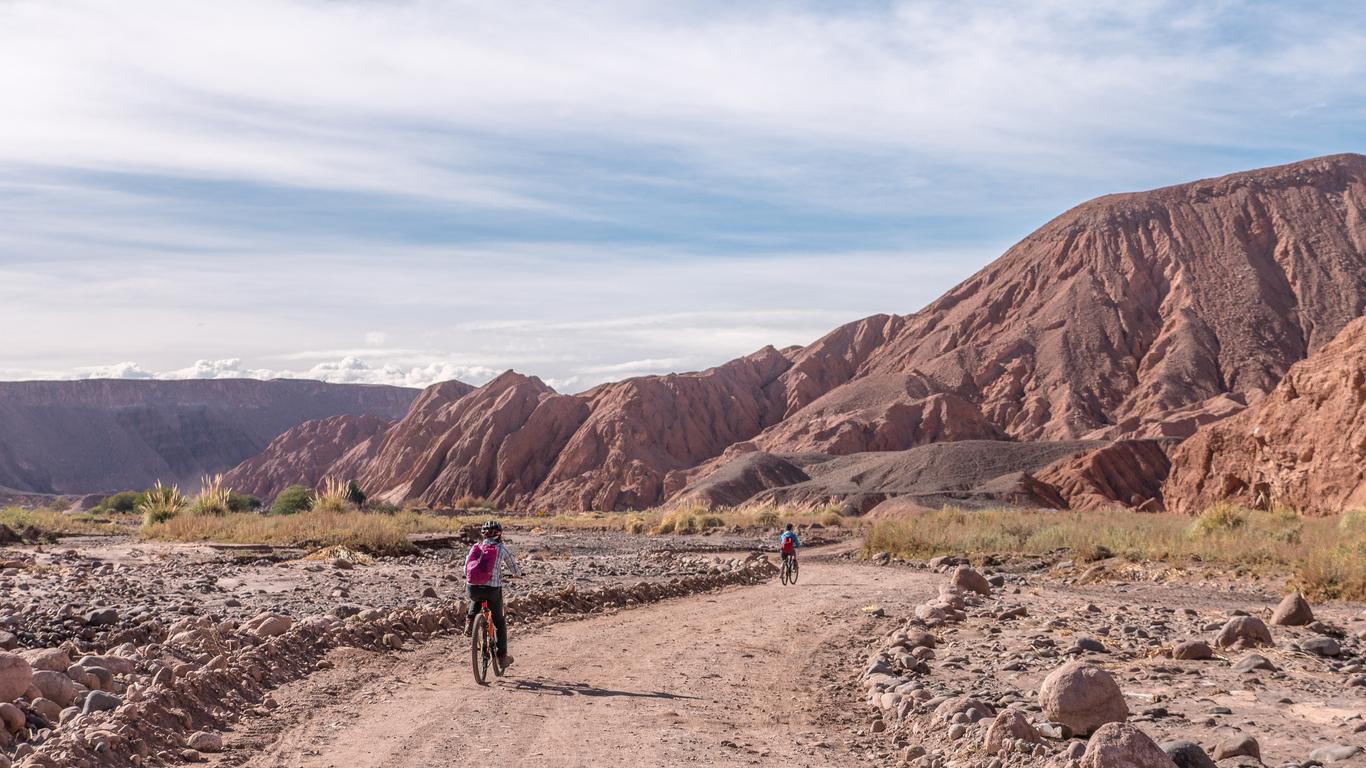
San Pedro de Atacama travel guide
San pedro de atacama tourism | san pedro de atacama guide, you're going to love san pedro de atacama.
San Pedro De Atacama is a town in the north of Chile. It is one of Chile's most popular tourist destinations, with visitors attracted by the stunning landscapes in the area and the many archaeological sites.
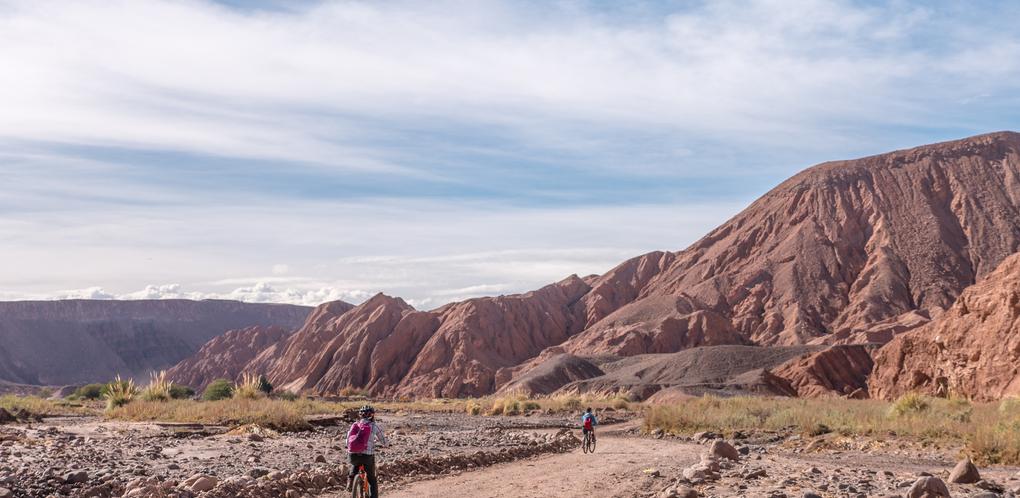
Top 5 Reasons to Visit San Pedro de Atacama
1. museo del meteorito.
This museum has a fascinating collection of meteorites and information on how to hunt them in the desert.
2. Los Flamencos National Reserve
The reserve is known as Chile's most diverse and is a haven for nature lovers.
3. Geysers del Tatio
Located 12,000 feet above sea level, here you'll find the third-largest geyser site on earth, with more than 80 active geysers.
4. Valle de la Luna
The "Moon Valley" is an otherworldly landscape of caves, craters, gorges, and salt mines.
5. Church of San Pedro De Atacama
This church is a national monument and a fine example of colonial architecture using adobe.
What to do in San Pedro de Atacama
1. breathtaking sunrises.
At nearly 14,000 feet above sea level, the Geysers del Tatio are among the highest in the world. The ideal time to visit is sunrise, when the light is at its most breathtaking. Along the way, visitors can observe the wild vicuñas, an endangered Andean camel. Also on the route is the Putana river with its numerous bird species, as well as vizcachas, similar to rabbits or squirrels. Other highlights include the Machuca with its sulfur mines and flamingos.
2. Ride Through The Canyon
A breathtaking outlook, the Valle de la Luna can be accessed by car or bike. A magnificent place to watch the sunrise or sunset, the valley is formed in a salt mountain range, featuring clinal and anticlinal formations, as well as stone canyon walls and rock salt strata. Other highlights include the Grand Crater, the Salt Canyon, the Salt Caves and the Cari Viewpoint. Bike rides are usually 10 miles, though drivers are usually willing to lend a hand if you get stuck or tired. Also, bike rental shops will offer headlights, tail reflectors and helmets, as well as emergency kits.
3. Local Fauna And Fare
Located in the village of Toconao, known for its church and bell tower, Lagunas Altiplanicas features Laguna Chaxa, a national park that boasts three species of flamingos, as well as the Miscanti and Miñiques lagoons, which features a variety of local fauna. In Socaire, a small hamlet, visitors are welcome to enjoy lunch or breakfast, which includes home-grown potatoes, big beans, carrots, and quinoa. Visitors are advised to wear long sleeves and pants, as well as sunglasses since the light reflects brightly off the salt pan.
4. Relaxing Saltwater Swim
On the northern tip of the Atacama salt pan, Laguna Cejar offers spectacular views of the Andes, as well as the chance to bathe in the salt water lakes. Tours includes visits to the Cejar and Piedra lagoons, as well as Ojos del Salar and Lake Tebinquinche. Guests can enjoy a cocktail or pisco sour at the end of the visit, as well as admire the sunset over Lake Tebinquinche, which reflects the changing colors of the surrounding mountains. Again, guests are advised to wear protective gear to guard against the sun and lower temperatures. Also, the high alcohol content of the pisco sour can be deceiving, so guests are encouraged to drink slowly.
5. Natural Hot Springs
Known as the Hot Springs, the Puritama is actually a warm river with temperatures at around 91ºF. Clear and clean, the river is home to colorful rainbow trout. Located at Hotel Explora, a luxury establishment with elegant accommodations, the site offers spectacular views of the ancient agricultural terraces, enormous stone walls and cacti. With eight artificial pools made from volcanic rocks, visitors can enjoy a hydro-massage in the waterfall or simply a soak in the crystalline water.
Activities & attractions in San Pedro de Atacama

Where to Eat in San Pedro de Atacama
La Pica Del Indio on Tocopilla serves local dishes and is renowned as one of the best restaurants in town. La Estaka on Caracoles specializes in Latin dishes and is vegetarian friendly.
When to visit San Pedro de Atacama
San Pedro De Atacama has a cold desert climate, with average daytime temperatures ranging from 47 to 62 degrees. It can get very cold at night during winter and visitors should be aware that mild altitude sickness is a possibility due to the town's 8,000ft elevation.

How to Get to San Pedro de Atacama
There is no airport in San Pedro De Atacama. The nearest airport is El Loa Airport (CJC) at Calama, around 70 miles to the northwest. The airport has regular flights from Santiago and some services from other cities in Chile. A minibus transfer to San Pedro De Atacama will cost CLP$12,000.
San Pedro De Atacama lies on the main road from Argentina, which crosses the Paso de Jama. The road is paved as is the road from Santiago, but inexperienced drivers should take care when driving at altitude.
San Pedro De Atacama has good bus services from cities across Chile and also connections from Jujuy and Salta in Argentina. The fare from Calama is CLP$2,500.
Airports near San Pedro de Atacama
Airlines serving san pedro de atacama, where to stay in san pedro de atacama.
Tierra Atacama Hotel and Spa is a luxury hotel on Camino Sequitor. The Hotel Diego de Almagro offers a budget option in a good downtown location.
Popular Neighborhoods in San Pedro De Atacama
Centro - San Pedro De Atacama is a small and compact town, with the center comprising 12 small blocks. Caracoles is the main street and is pedestrianized. Here, you will find the town's main shopping areas, attractions like the Iglesia San Pedro De Atacama, and the Museo del Meteorito.
Calama - this is a larger town to the northwest, which has an interesting frontier feel and more shopping and accommodation.
Toconao - this is a small, quaint village with a pretty square, just south of San Pedro De Atacama.
Where to stay in popular areas of San Pedro de Atacama
Most booked hotels in san pedro de atacama, how to get around san pedro de atacama, public transportation.
San Pedro De Atacama has no public transport system but is small enough to comfortably explore on foot.
Taxis in San Pedro De Atacama are rare but can be booked from your hotel. Expect to pay an initial fare of CLP$400 and then CLP$3,000 per mile, but you can also negotiate a fixed fare based on your destination.
Roads in and around San Pedro De Atacama can be in poor condition. Driving into the mountains or the desert also requires care. Car rental is available from El Loa Airport from CLP$34,000.
The Cost of Living in San Pedro de Atacama
Shopping streets.
There is basic shopping on Caracoles and local crafts can be purchased in the museum shop.
Groceries and Other
A quart of milk in San Pedro De Atacama costs CLP$717 and a loaf of bread is CLP$867.

7 Awesome Things to Do in San Pedro de Atacama, Chile @PostcardsAnna
Atacama desert is not only the driest place on Earth but also a place that can surprise you quite a bit. If you imagine sandy lands as far as you can see, you will be disappointed as the Atacama is a feast for the eyes. From the mountains, salt flats, volcanoes, pink flamingoes, blue lagoons to many different shades of blues, pinks, and purples at sunset, Atacama will make a trip hard to forget. The most popular place full of attractions is a little rustic town San Pedro de Atacama. Here you have a few amazing things to do in San Pedro de Atacama :
- Backpacker’s Guide – Uyuni, Bolivia to San Pedro Atacama, Chile
- CheapOair Booking Experience – How We Find the Cheapest Flight Deals
- List of the Best Hostels in Chile
- List of the Best Luxury Hotels in Chile
- DIY Travel Guide to Puerto Natales, Patagonia, Chile
Table of Contents
1. Watch the sunset over Moon Valley
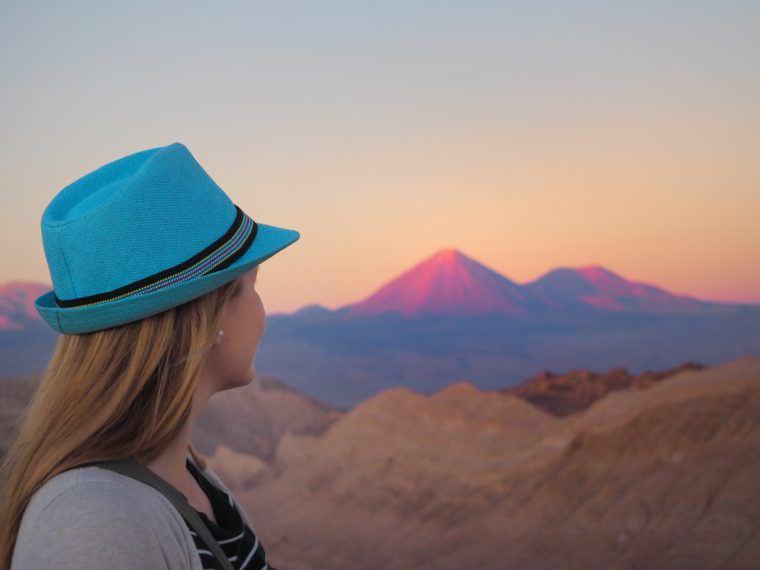
You wonder where the name of the valley comes from? There will be no surprises once you see it with your own eyes. Apparently, the landscape is very similar to the surface of the Moon. It is really like transporting yourself to a different world. I went there a few times, and without any hesitation, I must admit that it is most beautiful at sunset. The evening sun creates the view of the desert full of pastel colors that change moment to moment. Of course, you can go there much earlier to do some excellent hiking or cycling since the valley is quite big. The valley is rather close to San Pedro so you can easily go on your own by car or cycling, but be prepared for the heat if you choose the two-wheel option.
A quick tip:
- Depending on the season the last time to enter the valley is 5 pm in winter and 6 pm in summer. You won’t be able to enter after that. It involves a fee, which changes too depending on your time of entering the park. The highest fee is approx. $4.
- Wear comfortable shoes; best would be hiking boots.
- Wear a hat and bring sunscreen.
2. Go to see the high-altitude geysers
The geysers are located at the feet of the volcano Tatio. It is one of the biggest highlights of the trip to San Pedro de Atacama, I would say. To be able to go on the trip, whether you go on your own or with a tour provider, prepare yourself to get up long before the sun comes up. It takes around 90 minutes to get to the geysers from San Pedro de Atacama, and the road is not the easiest. I can assure you, however, that all the pain of getting up at 4:30 am and any possible discomfort caused by altitude and cold will be hugely rewarded the second you see the sun rising from behind the volcano. If you come with a tour, they will cook nice breakfast for you that will include a hot chocolate straight from a boiling hot geyser. There is also a thermal pool for the perfect end of the visit.
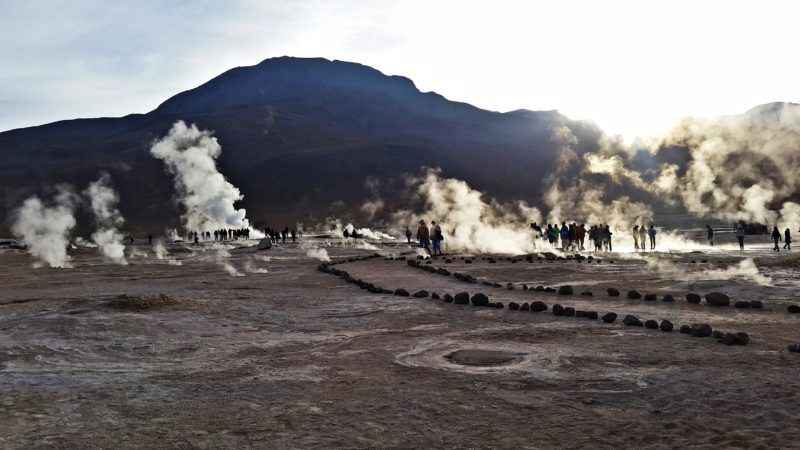
A quick tip: Since the geysers are at high altitude, you might suffer from altitude sickness. To minimize it go to sleep early the previous night, avoid drinking alcohol and heavy meals. If you must eat breakfast before the trip, eat something light. It is also very cold there early in the morning, so prepare yourself for below zero temperatures.
3. Eat homemade empanadas in an Andean village
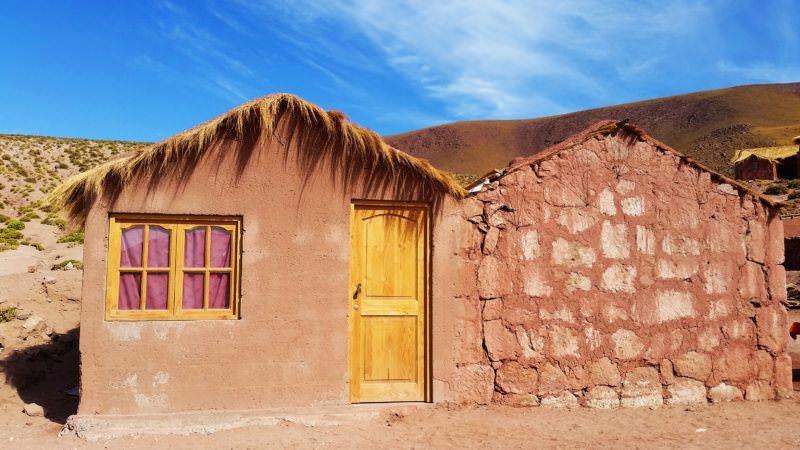
In a little village, and by little I mean around ten houses, on the way back from the geysers make a stop in Machuca. If you go with an organized group, the stop in the village will be most likely included as it is surely a nice experience. The locals living there wait every day with freshly made empanadas for tourists heading back to San Pedro. The fry them in front of you so it cannot get any fresher. You can see the real life of Andean people, who mostly live from the income from llamas.
4. Watch pink flamingoes
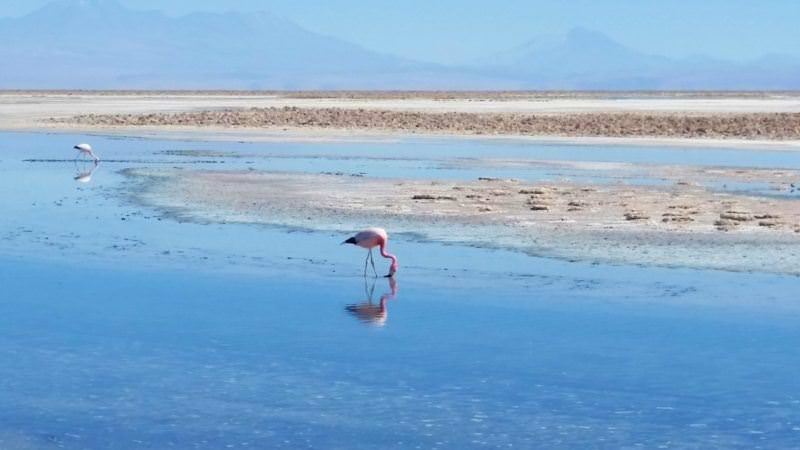
There are a few places to watch flamingoes near San Pedro de Atacama, but the most common one with the biggest chances to see those pretty birds is lagoon Chaxa. It is located near a town called Toconao around 50 km south of San Pedro. It is on the way to Miscanti and Miniques, so during one day, you could combine those two places.
5. Take an astronomic tour
It is widely known that some of the clearest skies are in the Atacama. There are few cities that are mostly located on the shore, so the light pollution is minimal. It does not rain almost at all and clouds are not that common. No wonder there are some biggest observatories in the world in the Atacama. To get an ultimate ‘starry’ experience, you can visit ALMA Observatory near San Pedro or go on a night excursion to watch the sky with a glass of hot wine. Or even better do both if you have time.
6. Lose perspective at salt flats
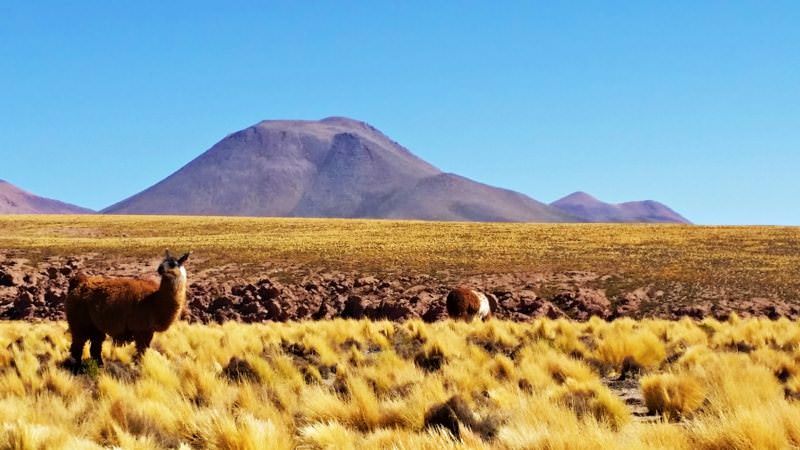
The salt flats in the Atacama are not that well known amongst tourists, mostly because not so far away there is the famous Uyuni, but they are also beautiful. If you plan on excursions to altiplanic lagoons, you are most likely to visit Salar Tara or Salar de Atacama. The snow-white ground will make a lovely background for your photos.
7. Discover turquoise lagoons in the middle of a desert
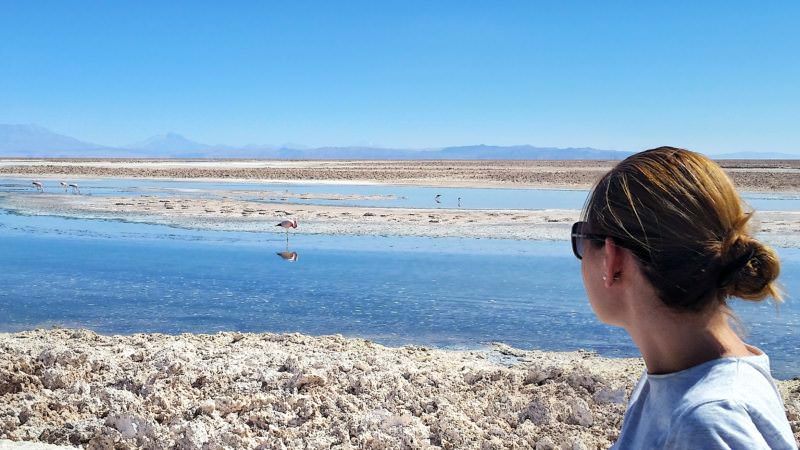
Atacama is many things, but boring is not one of them. I cannot remember how many times if was surprised by its beauty and finding turquoise lagoons in the middle of the desert was one of those times. The most beautiful, in my humble opinion, are the lagoons Miscanti and Miniques, around 28 km from the town Socaire. Mirror-like lakes and mixture of colors make quite a picture-worthy view. The lagoons will make a full day excursion whether you go on your own or together with a group as it takes over two hours to get there.
8. Find accommodation in San Pedro de Atacama, Chile
General tips for San Pedro de Atacama:
- Always carry a bottle of water with you.
- Wear a hat.
- Use high filter sunscreen.
- Bring some warm clothes for the night.
- If you hire a car to make sure that you put gas at every available occasion as there are not many petrol stations in the region.
- Most places involve a small fee.
The sun in Atacama is very strong, and even if you normally don’t burn easily, it is not the same there. Make sure you always have the mentioned items with you to avoid any unpleasant effects of heat and sun. Nights are usually cool so that you will need a warm hoodie or a jacket.
Cash: What I had learned from living in Chile for long is that you always need some cash with you. There are cash machines in San Pedro, and many places accept cards but come with some cash in pesos.
Tours: There are many tour operators in San Pedro. There are some tours however that you can do on your own, like Moon Valley for example. You can also hire a car and do the other tour on your own, but joining a group will save you some time and effort.
When to go: The weather is San Pedro de Atacama is good all year round. Of course in autumn and winter months (April until October) it will be cooler (with snow at times, but rarely), but it does not make that much difference. In January or February, altiplanic winter might occur, which means heavy rain for a day or two.
How long to spend there: I would say that 3-5 days is enough to see all the attractions near San Pedro de Atacama.
Petrol stations: There are not many petrol stations in the Atacama. There is one in San Pedro, which is quite difficult to find. It is located in a yard of a hotel. Go along the street called Toconao and look for a small sign ‘combustible’ showing directions to the station and if you ask locals for directions use ‘benzinera’ or ‘gasolinera’ words. Have cash with you.
Where to Stay in San Pedro de Atacama, Chile
Hotel Tierra de Atacama
One of the best hotels in San Pedro de Atacama and one of the most expensive. It is a cute boutique spa hotel with a lovely view of the famous Licancabur volcano. It is an all inclusive hotel with tours included in the price.
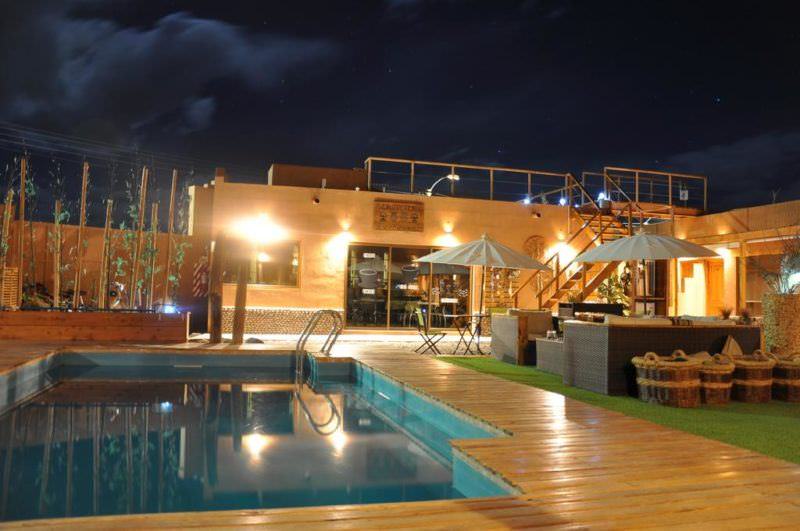
They offer excursions to all the attractions and horse riding. If you are not in the middle of adventures and sightseeing, you can relax in one of the swimming pools, sauna or hot tub.
Hotel Pascual Andino
Pascual Andino has cozy rooms in San Pedro de Atacama. Only 100 m from Caracoles, the town’s main street. A daily buffet breakfast is offered. Wi-Fi and private parking are free.
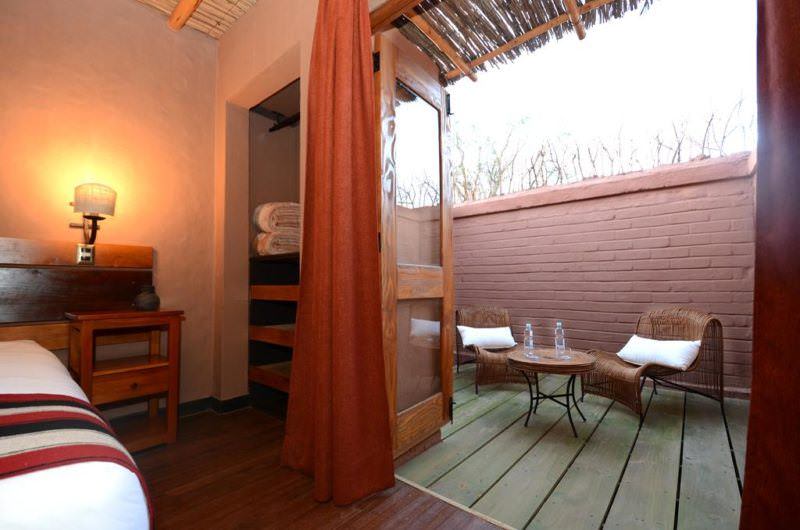
Comfortable rooms are equipped with private bathrooms with showers. Extras include a safety deposit box. At Hotel Pascual Andino you will find a 24-hour front desk and a garden. Guests can stop by Padre Le Paige Museum, 150 m away.
Hostal Kirckir
Located only 700 m from Caracoles Street, Hostal Kirckir offers accommodations in San Pedro de Atacama. A complimentary breakfast is available daily, and guests will find a mini-market steps away from the hostel. Guests staying at Kirckir are offered bicycle rental for a discount with all the equipment necessary.
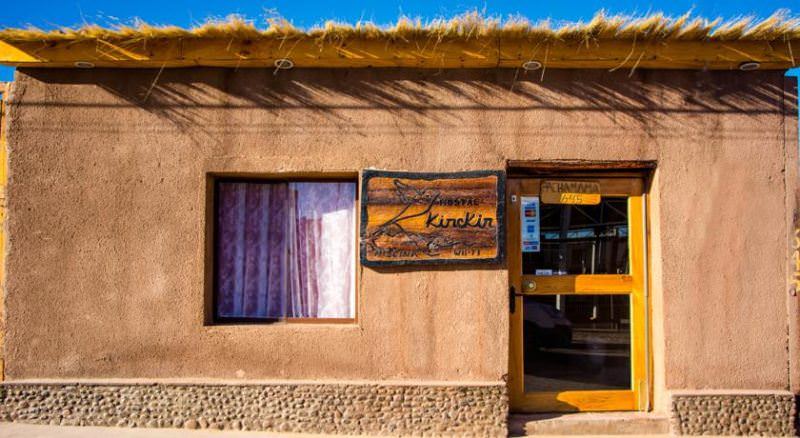
At Hostal, Kirckir guests are welcome to use the fully-equipped shared kitchen. Additionally, the hostel offers handy tourist information including free maps and brochures, as it features a travel agency on-site. Other facilities include a 24-hour front desk, a shared lounge, and laundry facilities.
Where to Eat in San Pedro de Atacama, Chile
Restaurant Adobe
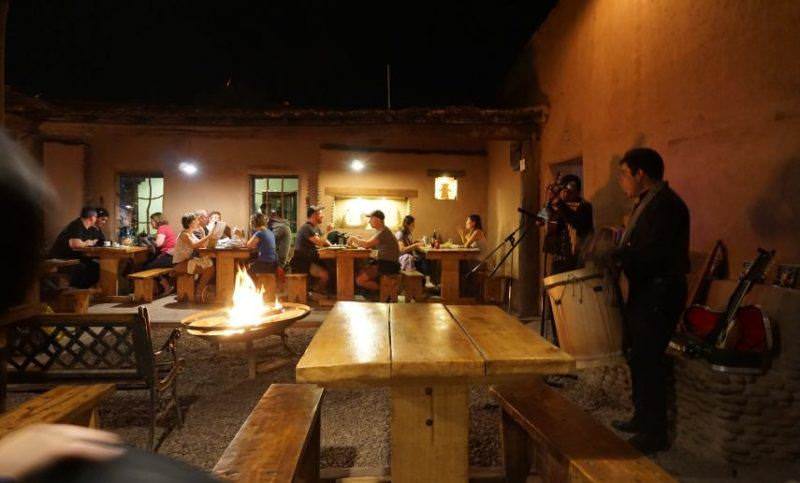
It is probably the most crowded place to eat in San Pedro, and it is actually not surprising: the atmosphere is good, and the food is good. A big restaurant with a fire in the middle and occasional live bands create a wonderful atmosphere to have a perfect evening after a whole day of adventures in the desert.
Restaurante Todo Natural
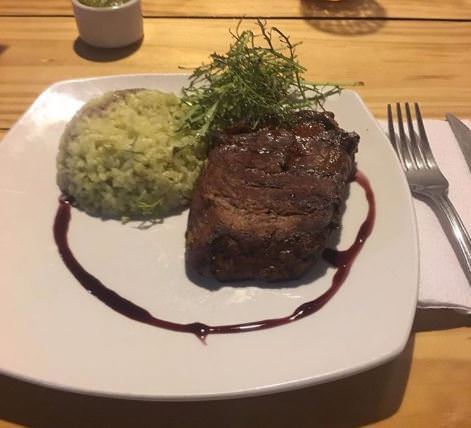
This place is excellent for breakfast and lunch. They serve simple, natural food and make most delicious mango shakes and quite decent crepes.
About the Writer
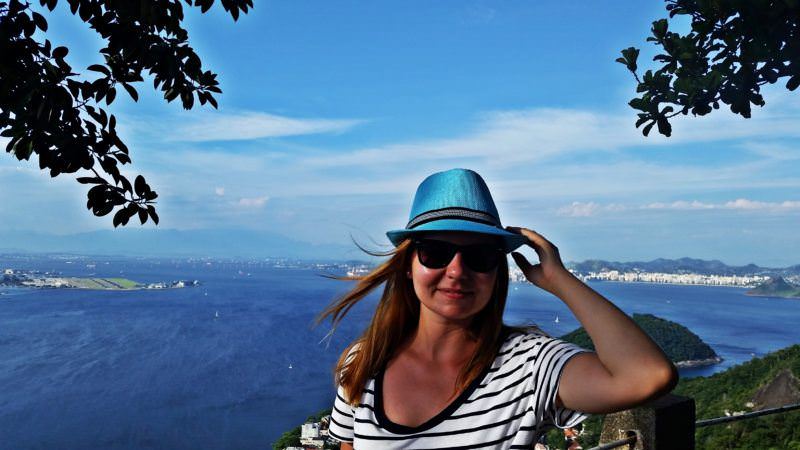
Social Media: Facebook: Postcards from the World Instagram: postcardfromtheworldexpatlife Twitter: PostcardsAnna
Are you on Pinterest? Pin these!
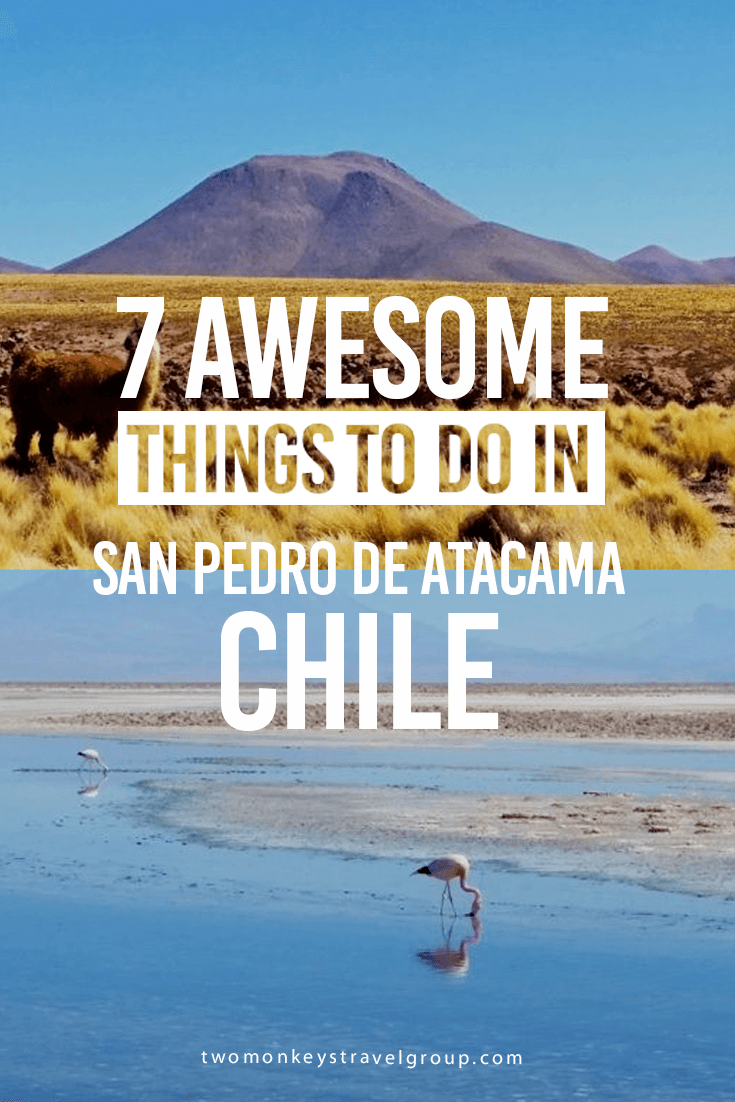
Leave a Reply Cancel reply
Your email address will not be published. Required fields are marked *
This site uses Akismet to reduce spam. Learn how your comment data is processed .
3 thoughts on “ 7 Awesome Things to Do in San Pedro de Atacama, Chile @PostcardsAnna ”
Thank you for sharing. Super helpful!!!
what tour operator did you use that offers hot chocolate from a geyser?
Great article and amazing tips! Thank you for sharing all this information with us. Chile is an amazing country to know, with a variety of landscapes to fall in love with.
COPYRIGHT DISCLAIMER: Many of the articles on Two Monkeys Travel Group are guest posts by a number of Approved Contributors and are hosted by Two Monkeys Travel Group. Approved Contributors control their own work and post freely to our site. This includes all text and images that they use within their own work. All contributors are instructed to follow internationally recognised copyright and intellectual property guidelines. Two Monkeys Travel Group takes its own responsibilities very seriously, so if you feel that any part of this work is abusive in any way, please send us an email so that we can investigate - [email protected]
DISCLOSURE: Please note that some of the links above are affiliate links. So when you make a purchase we sometimes make a small commission, at no extra cost to you. The cost to you remains the same, sometimes even cheaper if we have negotiated a special deal for our readers.We use all of the companies we have listed here and that’s why they are in this list, but of course we need to keep Two Monkeys Travel Group running as well as it can, which is exactly what you’re helping with if you do decide to buy or book something through an affiliate link! If you have any more questions about the companies we use or any other companies you’re looking at, just email us and we’ll be happy to help. Please see our full disclaimer page for more information.
Written by Two Monkeys Travel - Contributor
Two Monkeys Travel Group – Community Travel Blog is a travel blog and website. We quickly grew into a valuable source of inspiring travel stories, advice, itineraries and travel guides, with the aim of demonstrating how to live a sustainable life of travel, whilst living your own definition of success. If you'd like to contribute and write a guest post, contact us at [email protected]
Discover Turkey’s Lesser-Known Gems For The Adventurer
The lesser-known beaches of the aegean coast: relaxing on pristine stretches of sand away from the crowds of popular resort towns, 48 hours in tokyo – exploring japan’s vibrant capital, navigate the skies and sheets: how to book flights and hotels, how to find the best hotels in new york, related posts, list of the best hotels in mississippi, usa – from cheap to luxury hotels, trip to thailand with my grandmother and our luxurious staycation at ramada plaza by wyndham bangkok menam riverside, travel guide to jeita, lebanon [things to do & places to visit], 10 things to do in bhutan – our bhutan travel guide to thimpu, paro & punakha, previous post, guide to luang prabang and vang vieng, laos – 6 day itinerary @phenomenalglobe, your complete do-it-yourself (diy) travel guide to azerbaijan, subscribe to our newsletter.
Receive tips on how you can live a sustainable long-term travel lifestyle!
- First Name *
- Comments This field is for validation purposes and should be left unchanged.
The Partying Traveler
Survival of the littest.

The Backpacker’s Guide to San Pedro de Atacama, Chile
Wow. Where do I even begin with San Pedro de Atacama? This remote village in the heart of the desert is one of the most incredible destinations that I have ever traveled to. The natural beauty of this region can feel otherworldly at times, and is almost unfathomably beautiful at times. The small town feels like something out of the Wild West, with the dirt roads, adobe buildings, and desert setting thrusting you back into a bygone era.
San Pedro de Atacama has a vibe that is difficult to describe. As I roamed through the streets, you could feel the dusty aura of an oasis for travelers. Whether you were biking, hitchhiking, van-lifing, or backpacking your way through, this village called and the travelers answered.
This post contains affiliate links. That means that I may earn a commission if you make a purchase through these links.
Table of Contents
- How To Get To San Pedro De Atacama
Where To Stay in San Pedro de Atacama
The best things to do in san pedro de atacama, nightlife in san pedro de atacama.
- Budget Travel Tips for Atacama
How to Get to San Pedro de Atacama
There are several different ways to get to San Pedro de Atacama. The usual gateway is through the larger city of Calama about an hour away. Buses to and from Calama leave nearly every half hour during the day, and it is easy to catch one from the Calama terminal. If you flew to Calama, you can also catch a shuttle bus from one of the several companies offering them. The standard fare for a one-way ticket from the airport is $10-12,000 Chilean pesos, or about $12-15 U.S. dollars.
For backpackers that had been traveling through Bolivia, a popular way to get to San Pedro de Atacama is to go through Uyuni. Most tours of the Uyuni Salt Flats will offer the option to get dropped off at San Pedro de Atacama instead of back in the small town of Uyuni. For backpackers taking the Gringo Trail and working their way south from Bolivia, I cannot think of a more convenient option. Definitely take advantage of this if you have the opportunity.
For travelers heading in from Argentina, you will have to take a bus from Salta or Jujuy to get to San Pedro. The bus is about 10 hours from Salta or 8 hours from Jujuy. It involves a border crossing about 2 hours before you reach San Pedro, but it is one of the smoothest border crossings I have ever had. A few different bus companies offer this route, and I went with Andesmar. Buses in Argentina and Chile are unfortunately significantly more expensive than elsewhere in South America, and I paid about $45 U.S. (35,000 Chilean pesos) for the 10 hour journey. Hey, at least we got a muffin and instant coffee to keep us alive during the journey.
And before you go, make sure you have good travel insurance handy while you’re off adventuring across the world. I use SafetyWing to keep me covered throughout my travels for as low as $40 a month.
For backpackers, there are a wide variety of hostel options in the area. You’ll find quite a few closer to the center of town but those tend to be a bit more expensive. Places like Hostel Pangea , Hostal Rural , and ANKA Hostel are great options for people who want to be centrally-located and have all of the amenities. However, these are closer to $20-25 per night for a shared dorm.
I roughed it during my few days in San Pedro de Atacama. The tours were quite expensive so I had to get stingy in other aspects, mainly food and accommodation. If you are in the same boat as me, make sure that you get a hostel with a kitchen. I stayed 3 nights at Backpackers San Pedro and 2 nights at Hostal Ckappin . Both were cheap and a lot better than I expected for their price. Backpackers San Pedro had two kitchens, surprisingly good Wi-Fi (when it worked), and always had a social vibe to it. Hostal Ckappin had a huge outdoor common area, a big kitchen, and spacious rooms with big lockers. However, the Wi-Fi was painfully unreliable. Both of these hostels were about a 10 minute walk outside of town.
In San Pedro de Atacama, I don’t think it is crucial to be in town at all. The village is so small that you can walk anywhere within 15 minutes. For budget travelers, it is definitely worth walking a bit longer into town to pay half the price for a hostel.
View all hostels in San Pedro de Atacama on Hostelworld
Ooh boy, where do I even begin. Pictures are worth a thousand words and I took a lot of pictures, so here we go.
Valle de la Luna
This is one of the things that you absolutely cannot miss while in San Pedro de Atacama. Since it is one of the closer attractions to town, it is possible to do this on your own either by car or even by bike. If you choose to go with a tour, make sure that you take the afternoon tour that allows you to climb up Duna Mayor for one of the most incredible sunsets that you will ever see.

Valle de la Muerte
Also close to town is the Valley of Death where you will find surreal Martian landscapes. You can visit this place on your own although it is typically packaged with most Valle de la Luna tours.

Piedras Rojas
Piedras Rojas or Red Rocks is an incredible viewpoint overlooking some ethereal landscapes. Unfortunately, you can’t get the iconic picture on the red rocks anymore but the view is still absolutely stunning.

Laguna Baltinache
A giant field of salt in the middle of desert boasting seven vibrantly colored blue lagoons, including two that you can swim in. Just another day in Atacama, I guess.

Oh yeah, and the abandoned bus that some tour operators will take you to afterwards. I mean, it’s a rusty old bus in the middle of the desert, so don’t expect too much. However, it does make for some great photo opportunities, kinda like the train graveyard in Uyuni but to a lesser degree.

Lagunas Altiplanicos

Laguna Miscanti

Salar de Laro

Unfortunately, I didn’t have enough time or money to do nearly everything I wanted to do. I’m definitely going to come back here one day with a bigger budget and a car and just adventure through the desert and altiplano for a few weeks. For now, here are the other things that I would have loved to do, as seen by people who have actually done them.
Rainbow Valley (Valle del Arcoiris)
Laguna cejar.
View this post on Instagram A post shared by Isadora Pedroso (@isafpedroso)
ALMA Observatory
View this post on Instagram A post shared by Babak Tafreshi (@babaktafreshi)
Geysers del Tatio
Volcan lincancabur.
View this post on Instagram A post shared by Topito Voyage (@topitovoyage)
Volcan Laskar
At first glance, this small village seems like the furthest thing from a party town. There are few establishments that seem like they could keep a party going, and there is some fact to that. If you are looking for the party, you don’t look into the town. You look to the desert. What little nightlife there is within the village itself shuts down relatively early.
However, once the stars come out and everything shuts down, the desert is the place to be. It’s hard to tell whether these nightly desert parties happen because the police don’t know about it or because they turn a blind eye, but they are basically the only party that you will find past midnight. And it is a legit party, too. There are multiple music types, from electronic to reggaeton, and there will be people selling alcohol (and more). This rave-like atmosphere can get wild closer to the weekend, but it happens nightly. I mean, who wouldn’t want to be partying beneath the stars in what is renowned as one of the top stargazing destinations in the world?
I can’t reveal too much on my blog but ask your hostel or any of the hippie locals and they’ll give you the down low on this get-down.
Budget Travel Tips For San Pedro de Atacama
Cook your own damn food.
My last day in San Pedro, I decided I would splurge and treat myself to a meal after having cooked every meal for 5 days in a row. After seeing the prices in town, I bought a $2 empanada and went home. Food in San Pedro is expensive, especially if you eat out. Although grocery shopping is significantly cheaper, it is still more expensive than most places I’ve been to in South America. I lived off of bananas, eggs, rice, and yogurt for five days. I spent a grand total of $10 in 5 days on food, which was worth it because I spent over $100 on tours over a 3-day span.
Book A Hostel Outside of Town
Most of the hostels right in the heart of the village will charge you double the price of a hostel outside of town. I really don’t know why, considering that San Pedro is as small of a town as it gets. Some good budget hostel options that I’ve found are Backpackers San Pedro , Hostal Ckappin , and Sol Atacama . Aji Verde is also good but more on the outskirts than the others.
Volunteer At A Hostel
Volunteering at hostels is definitely not for everyone, but in a place like San Pedro de Atacama, it can be a great way to save money. It would be exhausting to try and go on adventures every day, so alternating between shifts and adventures is a good way to stretch your money out and be able to go on more adventures. With free accommodation, you could easily limit your budget to $1-2 a day on food, allowing the rest to go towards tours and excursions while living in a beautiful place like San Pedro for a while.
Book Tours in Packages
It helps to do some research. Know what you want to do and use that to your advantage. I usually show up to a place and go to a tour agency, ask them what’s good, and then book it there. That worked a lot in Peru when tours were $10, and I wouldn’t feel too bad about going on a crappy tour when I barely spent any money. However, when tours can crack close to $100, that’s when you have to start paying a little more attention.
I did a bit of research and picked three things that I thought seemed like the must-do’s of San Pedro. Although the geysers and thermal pools are the ones that agencies try to sell first, I honestly couldn’t care less about hot water and less impressive Old Faithfuls. I chose my three and haggled a good price for booking all of them at once. Valle de la Luna, Piedras Rojas, and Laguna Baltinache would have cost me a painful $89,000 Chilean pesos, and entrance fees would push that over the 100k mark. Thats about $130 U.S., but I managed to get it down to $66,000 pesos, or a more reasonable $95 after entrance fees. It’s still a lot of money, but that $35 could go a long way when all you eat is rice and eggs.
Seriously, when you see how much there is to do in San Pedro, then food and accommodation becomes secondary. You will want to put as much of your money as possible into seeing everything that this incredible region of the world has to offer. There are few places like this out there. Combined with the neighboring Bolivian Altiplano and Uyuni Salt Flats, you might not even believe you are on the same planet anymore.
I loved everything about San Pedro de Atacama, from the nature to the laid-back vibe and abundance of friendly travelers. And of course, desert raves. I’ll be back soon, SPdA.
If this post helped you out, show some love and support for the blog and help keep my adventures going by buying me a beer ! My adventures are entirely self-funded, so any show of support is greatly appreciated, and allows me to keep writing helpful travel guides and creating travel content to help you all travel the world on a budget.
Share this:
14 thoughts on “ the backpacker’s guide to san pedro de atacama, chile ”.
Lovely images! Thanks for sharing!
It is absolutely a different type of holiday. An adventure that goes beyond travel. Moreover, it is incredible how Chile offers landscapes that I would never have imagined! Very beautifull.
Wow what a beautiful post and I am all about this stunning photos you have here! I for sure would ,love to sim in one of those watering holes and would love to visit Chile! Thank you for sharing and what a post!
Wow these pictures are amazingly beautiful. And matches your description of the place. I love the wonders of nature.
I’ve never been to Chile before, I would love to go one day…The country is gorgeous. Thank you for sharing.
I’ve always wanted to visit Chile. I’ve heard it’s absolutely beautiful!
Wow! What a magnificent destination. I’ve never heard of San Pedro de Atacama. Chile has been my all time bucket list.
There is now no way I could go back to Argentina and not do this. The blue lagoons are to die for!
Your photos are spectacular!! I’d love to visit Chile one day, but not sure when that will happen. The Atacama is breathtakingly beautiful.
What beautiful photography. It looks like a wonderful trip. Places I have never even heard of.
Laguna Baltinache seems like an interesting place, located in the middle of desert. I hope it is not too pack with tourist.
Good guide for traveling to Chile. I like the pictures of the mountain terrains and the blue lagoons. – Dan “Jay” Reyes
Sounds like a great adventure! The scenery is gorgeous I would love to travel here!
Wow! This place looks so surreal. The landscape seems to be from outer space.
Leave a Reply Cancel reply
Discover more from the partying traveler.
Subscribe now to keep reading and get access to the full archive.
Type your email…
Continue reading

- Inca Trail Tours
- Machu Picchu Tours
- Amazing Galapagos Islands
- Amazon Jungle Tour in Peru
- Amazon River Cruises
- Salar de Uyuni
- Argentina Tours
- Colca Canyon Tours
- Cusco Local Experiences
- Best Peru Vacation Packages
- Top Rated Tours
- Puerto Maldonado
- Buenos Aires
- Patagonia – Argentina
- Esteros de Ibera
- Patagonia – Chile
- Santiago de Chile
- San Pedro de Atacama
- Local living
- Experiences
- Women retreats
- CUSTOMIZE HERE
- Booking conditions
- Accommodations

Ultimate San Pedro de Atacama Travel Guide in Chile
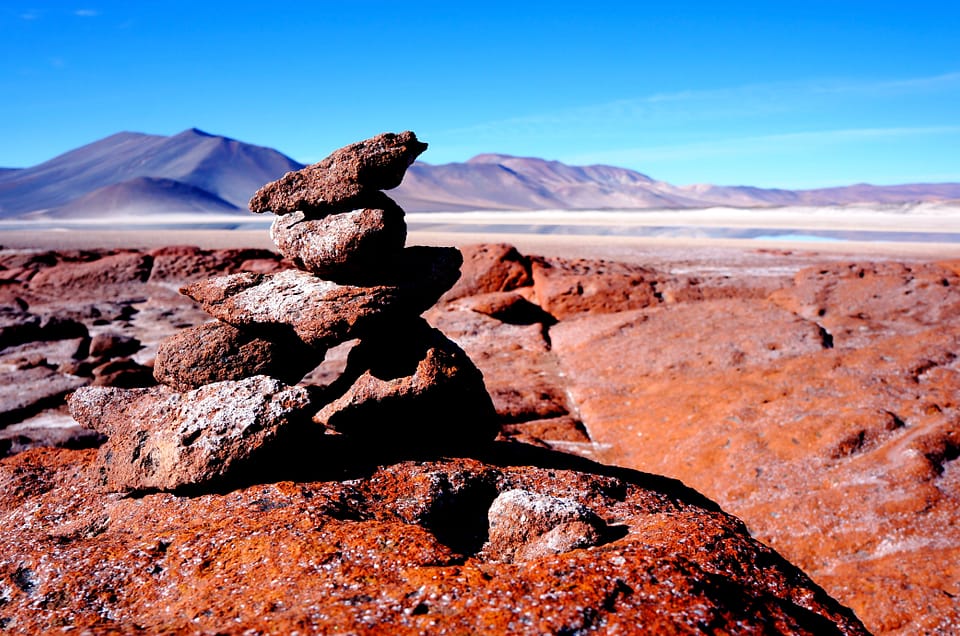
Welcome to our San Pedro de Atacama Travel Guide, to make the most of your trip to this truly breathtaking array of natural wonders.
From the magic of stargazing in pristine skies, to mesmerising views of salt flats scattered with flamingos, to the turquoise of the Lagunas Altiplánicas , there are so many trips to capture the imagination in the Atacama Desert.
Plan your stay in the town of San Pedro de Atacama. The perfect base for exploring the enchanting landscapes of the surrounding desert that this San Pedro de Atacama Travel Guide offers.
Table of Contents
Why is the Atacama Desert so special?
A Desert Fox near San Pedro de Atacama. Picture by Giacomo Russo.
The Atacama Desert is in the north of Chile between La Serena on the Pacific coast and Arica on the northern border with Peru.
While the desert takes up about 105,000 km2 (40,541 sq mi), you can marvel at the beauty in the area that surrounds San Pedro de Atacama.
This is driest desert in the world, with just 15 mm (0.6 in) of rainfall on average. The unique conditions in this harsh environment means it is used by NASA to test for Mars missions. It is also a centre for world excellence in astronomy.
The landscape is made up of salt flats, mountains, volcanoes and lagoons. The desert is full of flora and fauna to enjoy. Unusual wild native herbs, flowers and cacti grow in abundance. In addition you can see animals such as flamingos, desert foxes, vicuñas (a kind of wild llama) and viscachas (wild chinchillas).
San Pedro de Atacama Travel Guide
– how to get there.
From Santiago
There are eight flights a day from Santiago therefore plane is your most convenient way to travel to San Pedro de Atacama.
It is noteworthy that there is no airport in tiny San Pedro de Atacama. Even so, it is still easy to arrive in the heart of the desert. The nearest airport is in Calama and it takes just two hours to fly there. San Pedro de Atacama is then an hour and half away by road.
However if you have more time and prefer a more leisurely trip then there are a few different bus companies to choose from.
All of these run about 24 hours of travel time and leave in the late afternoon.
The bus company Tur Bus is our recommendation as it offers the only non-stop journey from Santiago to San Pedro de Atacama without a change in Calama.
LATAM runs three flights a day to Calama. All flights leaving Lima stop first in Santiago and then land in Calama, taking seven hours in total.
To get from Lima to San Pedro by bus requires a change in Arica and can take in excess of 30 hours. As a result catching a flight is our recommended option.
From Buenos Aires
As with Lima, all flights from Buenos Aires run through Santiago in Chile. The flight time is approximately 5 hours overall and is by far the most convenient option.
Another option is to fly to Salta from Buenos Aires and then catch a bus for 12 hours to San Pedro de Atacama.
– When to Visit
As the Atacama Desert is always dry and sunny there is no need to time your trip around the weather. However the best times to visit, when there are fewer tourists are in October and November or from March to April.
If you are a stargazer then you might wish to avoid travelling around the full moon. The darker the skies the better!
– What to Do
Wander amongst the otherworldly tatio geysers.
The Tatio geyser field at dawn. Picture by Giacomo Russo.
Experience one of the world’s highest Geyser fields at over 4,000 metres (11,000 feet).
Although in order to see the geysers in their full glory it will be a very early start before sunrise, it’s more than worth it. Witness the power of the earth firsthand as you stroll near the bubbling and steaming geysers.
Following the walk a much-need breakfast is usually served next to the field. The smell of sulphur fills the crisp morning air as you enjoy hot toast and coffee.
Visit the awe-inspiring Valley of the Moon
The Valley of the Moon at sunset. Picture by Ounie Christianson.
Valle de la Luna is the perfect introduction to the extraterrestrial landscapes of the desert.
During the day explore the valley itself on foot, viewing the craggy rock formations fashioned by millennia of wind and water.
Afterward, as the sun begins to set, take in the valley at dusk as the golden sun highlights the salt rocks and sand dunes. You will find it hard not be impressed by this incredible natural show.
Discover the majestic flamingos at the Atacama salt flats
Flamingos on Laguna Chaxa, in the Salar de Atacama. Picture by Giacomo Russo.
Visit the largest salt flat in Chile, the Salar de Atacama. Spot the shy and pretty pink flamingoes that stalk the waters of Laguna Chaxa, at its heart.
A flat expanse that is surrounded on all sides by huge volcanoes, the Salar de Atacama is 3,000 km2 (1,200 sq mi). It stretches as far as the eye can see!
At the visitors centre learn all about the different types of flamingo and other animals that inhabit this colourful landscape.
Soar over the dessert in a hot air balloon
For an exhilarating and unrivalled vantage point of all that the desert has to offer, enjoy a three-hour hot air balloon flight.
Relax and take in the stunning vistas in safety and luxury. Before the ride, there are pastries and juices for breakfast. Afterwards beverages including champagne are served. There is no better way to reveal the secrets of the Atacama Desert.
Explore shimmering lagoons in the shadow of volcanoes
Laguna Miscanti overlooked by the Miñiques peak. Picture by Ounie Christianson.
The Altiplano Lagoons, Lagunas Altiplanicas of Miscanrti and Mistique are colours of blue you won’t ever has seen before.
To add to this, towering over the heart-shaped Laguna Miscanti are two giant volcanoes. They add extra drama to the uniquely beautiful vista. Then you can lunch next to the one of the Lagunas, drinking in the view as you revitalise.
Enjoy stargazing in the desert after dark
Staring up the sky, rather than down at it’s landscapes is another way to get under the skin of this incredible place.
The Atacama desert boasts the clearest skies on earth so don’t hesitate to take a midnight trip and prepare for the dazzling array of stars in the heavens to amaze you. You can see galaxies, Milky Ways and constellations not normally visible to human eyes.
In addition you can take a tour of the Alma observatory, the largest astronomical project in the world.
– Where to Stay
Terrantai lodge andino.
This charming lodge located right in the heart of San Pedro de Atacama has comfy and clean rooms for two.
Furthermore, this peaceful place has a plant-filled patio and sustainably run outdoor pool for your enjoyment.
Kimal Hotel
The rooms in this beautifully designed hotel are for couples and small groups, which all lead out onto a terrace area.
As well as the usual amenities Kimal Hotel also boasts an onsite restaurant serving local gourmet food, swimming pool and jacuzzi.
Tierra Atacama
Tierra Atacama is a convenient drive away from the main plaza. Peaceful gardens surround the hotel, making it the perfect space for both contemplation and work.
The in-house spa offers a wide range of treatments to all visitors for maximum relaxation in a tranquil environment.
Alto Atacama Luxury Hotel
Located in the lush Catarpe Valley this ecologically harmonious lodge has something for everyone, from spa to restaurant and excursions.
A popular choice in San Pedro de Atacama, whilst there are many rooms to choose from, it’s an advantage to book your room here early.
Awasi Atacama Luxury Hotel
Stay in one of just ten gorgeous luxury suites, where the design is inspired by pre-Incan ruins, with thatched roves and al fresco showers.
In addition to enjoying the delicious food in the restaurant you can take part in a cooking class with the resident chef.
– Where to Eat
Offering a fresh modern take on Chilean classic cuisine, Blanco is restaurant and sushi bar rolled into one. Enjoy the serene surroundings whilst tucking into some seriously delicious food.
Right in the heart of town this old favourite serves up a vital mixture of international and local food. Enjoy the fresh seasonal ingredients prepared here, for a tasty experience.
The Restaurant at the Awasi Atacama
Enjoy a real gourmet experience at this eaterie situated inside the Awasi Atacama hotel. Promising to use the best ‘tasty and healthy ingredients’ the food here is a real treat for the tastebuds.
– What to Pack
The desert can be a tricky place to pack for. We suggest preparing for various climates.
For high temperatures and strong sun during the day: Cap Sunglasses Sunblock Bathing Suit Flip flops
For low temperatures and exposure to the elements on early starts and at night: Warm Hat Gloves Warm and waterproof layers Walking boots
So, you can now plan your trip of a lifetime with our San Pedro de Atacama travel guide and discover the allure of the desert for yourself.
Contact us for more information, or to customise your unique Chilean tour.
Like it? Pin it!
Leave A Reply Cancel reply
Your email address will not be published. Required fields are marked *
Save my name, email, and website in this browser for the next time I comment.
- Search for:
- Adventure Travel
- Amazing Hikes in Peru
- Arequipa articles
- Argentina Travel
- Best accommodation in South America
- Best Hikes in South America
- Bolivia Itinerary ideas
- Culture sud-américaine
- Cusco articles
- Dernières nouvelles
- Expérience culinaire en Amérique du sud
- Food & Beverage of South America
- Jungle Amazon
- Local Experiences in Peru
- Local Experiences in South America
- Luxury Travel
- Machu Picchu
- South America Luxury Travel
- South American culinary experience
- South American Culture
- Sustainable travel & tourism
- Tourisme et tourisme durable
- Turismo sostenible y turismo
- Últimas Noticias
- Unique places to stay in Bolivia
- Unique places to stay in Peru
- vegetarian food peru
2 Day Tour from Lima to Paracas and Huacachina: A Journey of Dreams Unveiled
Salkantay trek | trailblazing adventure for hikers seeking uncharted beauty and thrills, reconnect with nature at tambopata research center in puerto maldonado.
Pie Experiences is a trusted South America tour operator offering local activities and authentic tailor-made holidays in Peru, Argentina, Bolivia, and Ecuador.
- Philippines

Guide to San Pedro de Atacama PC
My Trip Guide
Download Guide to San Pedro de Atacama on PC With GameLoop Emulator
Guide to san pedro de atacama on pc.
Guide to San Pedro de Atacama, coming from the developer My Trip Guide, is running on Android systerm in the past.
Now, You can play Guide to San Pedro de Atacama on PC with GameLoop smoothly.
Download it in the GameLoop library or search results. No more eyeing the battery or frustrating calls at the wrong time any more.
Just enjoy Guide to San Pedro de Atacama PC on the large screen for free!
Guide to San Pedro de Atacama Introduction
S.P. Atacama is the app that you need to discover and plan your trip to San Pedro de Atacama, Chile. With this complete guide you can have an unforgettable experience. It is free to download and can be used offline at the destination, you will only need to carry your cell phone.
It includes practical information to plan your trip, an interactive map, geolocation, all the tourist attractions, tours and activities you can do. In addition, you can access a complete business directory, with accommodations, restaurants, tour agencies, transfers, shopping, special offers, discount coupons and much more.
Download the app and start organizing your trip!
+ All the tourist attractions you can visit
+ A range of activities
+ Geolocation
+ Directory of services, where to sleep, where to eat, excursion agencies, transport, health, shopping, events and parties
+ Practical facts and recommendations that you can review before arrival
+ Destination information, how to get there, weather, history, climate, flora and fauna and much more.
+ Discount coupons and special offers.
+ All accompanied with the wonderful images and directions for each place.
+ 100% offline, updated and free.
Discover and travel San Pedro de Atacama with our APP

Information
Latest Version
Last Updated
Travel-local
Available on
How to play Guide to San Pedro de Atacama with GameLoop on PC
1 . Download GameLoop from the official website, then run the exe file to install GameLoop
2 . Open GameLoop and search for “Guide to San Pedro de Atacama” , find Guide to San Pedro de Atacama in the search results and click “Install”
3 . Enjoy playing Guide to San Pedro de Atacama on GameLoop
Guide to San Pedro de Atacama
Minimum requirements.
Windows 8.1 64-bit or Windows 10 64-bit
1GB available space
Recommended requirements
More similar apps.
- Google Maps Go Download
- FlixBus: Book Bus Tickets Download
- Wallet Cards | Digital Wallet Download
- Google Street View Download
- BlaBlaCar: Carpooling and Bus Download
- Gacha Want Download
- TUI Holidays & Travel App Download
- Lime - #RideGreen Download
- easyJet: Travel App Download
- TfL Oyster and contactless Download
Google Maps Go
FlixBus: Book Bus Tickets
Wallet Cards | Digital Wallet
Google Street View
BlaBlaCar: Carpooling and Bus
Relevant News
Wild rift patch 4.4d notes: ziggs rework, new skins, events, and balance updates.
Last patch of the year, are you ready?! We got a Ziggs rework coming your way, plus new skins, new event, and of course, your regularly scheduled bala
Call of Duty: MWIII Season 2 Patch Notes - New Weapons, Maps & Gameplay Updates
Season 2 Update for Call of Duty: Modern Warfare III Detailed OverviewThe eagerly awaited Season 2 of Call of Duty: Modern Warfare III, brought to you
Wild Rift Patch 5.0 Notes - New Champion, Items, and Major Updates
First new patch of the year and it’s gonna be a big one! Hold on to your hats because we got new items, a new champion, new skins, and a TON of gamepl

IMAGES
VIDEO
COMMENTS
Step 1: Fly to Calama. The closest airport to San Pedro de Atacama is in the city of Calama which has a population of over 140,000 compared to over 5,000. The airport is known as El Loa Airport and has the code CJC. Currently, there are 3 airports that offer direct flights to Calama:
7. Hidden Lagoons of Baltinache. 25 miles south of San Pedro de Atacama, the Hidden Lagoons of Baltinache are an undiscovered gem in the Atacama Salt Flat. You're allowed to go in the water, so bring your swimsuit and prepare to feel light as a feather while floating in this salty, salty lagoon.
The distance between the Santiago and San Pedro de Atacama is 1,000 miles (1,629 km). And the fastest way to travel between Santiago and San Pedro de Atacama is by plane from Santiago to the city of Calama. From there, there is a shuttle bus that can take you to San Pedro de Atacama for a fee.
Plan your perfect visit to San Pedro de Atacama. Popular travel plans. 3-day trip 5-day trip 7-day trip + Or see all activities in San Pedro de Atacama. Featured activities. Valle de Jere. Active. The streams flowing through the Valle de Jere create an unusual oasis, where the people of Toconao cultivate crops including peaches, plums, and ...
Backpackers often travel by bus to the Atacama from neighboring countries. Common points of departure include Salta (Argentina), Tacna (Peru), La Paz (Bolivia) and Uyuni (Bolivia). If traveling by bus from Santiago, expect a journey of up to 24 hours to reach places like San Pedro. The Atacama is on our 2022 Best of
El Tatio Geysers. The most popular place to visit in the Atacama Desert, outside of San Pedro, is the El Tatio Geysers. Located a few hours north from San Pedro de Atacama, at an altitude of 4300m, the geysers are constantly shooting jets of water and clouds of steam into the air in spectacular visual displays.
San Pedro de Atacama. Chile, South America. It is said that the high quantities of quartz and copper in the region gives its people positive energy, and the good vibes of northern Chile's number-one tourist draw, San Pedro de Atacama, are sky high.
To get to San Pedro de Atacama, you have to take a flight to El Loa de Calama airport and from there travel the 100 kilometers (90 minute drive) that separate the town by bus, public or private transportation. You can also get to San Pedro de Atacama by bus from Santiago. The trip lasts 20 hours and covers more than 1600 kilometers.
Travel Time: 3 days. Frequency: Daily from Uyuni. Cost: Our 4-day round trip Salar de Uyuni tour, which started and finished in San Pedro de Atacama, cost around £150 GBP ($180 USD) It's worth noting that the border crossing between Bolivia and Chile can be time-consuming.
San Pedro de Atacama is a town of 3,899 (2012) in Northern Chile. San Pedro is a very popular destination among Chilean tourists and international visitors. ... This city travel guide to San Pedro de Atacama has guide status. It has a variety of good, quality information including hotels, restaurants, attractions and travel details. Please ...
San Pedro de Atacama is the best access point to the Atacama Desert, one of the most unique places on earth and certainly one of the nicest places to visit in Chile.. Located in the north of Chile, close to the border with Bolivia and Argentina, and pushing all the way into Peru, Atacama is known to be one of the driest places on earth (it has an average rainfall of around 2 cm per year).
El Tatio Geyser Field. El Tatio is a geyser field located at 4 320 meters above sea level, about an hour away from San Pedro de Atacama in Chile. You will have to wake up at dawn (around 4 am) to reach the geothermic fields as early as possible, as the geyser eruptions are the most spectacular before the sun rises.
Things to Remember: 1 - You will save money by shopping around and being flexible with your dates. 2 - Only rent a hire car if you are a confident driver. Most roads are fine, but it is a desert after all. 3 - San Pedro town is a pain in the ass to drive around. It's full of one way streets. No one has a clue.
San Pedro de Atacama in Chile is one of the most unique places on the planet. Uncover the main attractions & things to do in this guide. Plus planning tips! ... (Travel Guide) 9 Reasons to Add San Pedro de Atacama to Your Bucket List. Table of Contents. 9 Reasons to Add San Pedro de Atacama to Your Bucket List. 1. Termas de Puritama (3500m/11 ...
Go sandboarding in the Valle de la Muerte. Sandboarding in Valle de la Muerte (the Atacama's Death Valley) is one of the most adventurous things to do in San Pedro de Atacama! This valley is only five minutes from town and features dunes ranging from 40 meters to 200 meters. Valle de la Muerte reopened for sandboarding in 2023 after being ...
The little oasis village of San Pedro de Atacama, with its narrow dirt streets and attractive adobe houses, has transformed itself, since the 1990s, into the tourism centre of Chile. Sitting at an altitude of 2400m between the desert and the altiplano, or puna (the high basin connecting the two branches of the cordillera), this has been an ...
The town of San Pedro de Atacama sits at almost 8,000 feet above sea level, which is partially why it's so dry. Other visitable parts of the desert go up to 17,000 feet — the same altitude as ...
Ten kilometers west of San Pedro de Atacama, the Valle de la Luna (Moon Valley; 9am-7pm Sun.-Fri., $10,000 CLP adults, $5,000 CLP children entrance fee; book at least a day in advance here) is a jarring set of red and white rock formations created by tectonic forces four million years ago. This is easily the most popular of the region's ...
Estimated hotel price. $38. 1 night at 3-star hotel. San Pedro De Atacama has a cold desert climate, with average daytime temperatures ranging from 47 to 62 degrees. It can get very cold at night during winter and visitors should be aware that mild altitude sickness is a possibility due to the town's 8,000ft elevation.
No wonder there are some biggest observatories in the world in the Atacama. To get an ultimate 'starry' experience, you can visit ALMA Observatory near San Pedro or go on a night excursion to watch the sky with a glass of hot wine. Or even better do both if you have time. 6. Lose perspective at salt flats.
The standard fare for a one-way ticket from the airport is $10-12,000 Chilean pesos, or about $12-15 U.S. dollars. For backpackers that had been traveling through Bolivia, a popular way to get to San Pedro de Atacama is to go through Uyuni. Most tours of the Uyuni Salt Flats will offer the option to get dropped off at San Pedro de Atacama ...
While the desert takes up about 105,000 km2 (40,541 sq mi), you can marvel at the beauty in the area that surrounds San Pedro de Atacama. This is driest desert in the world, with just 15 mm (0.6 in) of rainfall on average. The unique conditions in this harsh environment means it is used by NASA to test for Mars missions.
2. San Pedro de Atacama: El Tatio Geysers Tour. Discover the third largest geothermal field in the world and the largest in the southern hemisphere in the Atacama Desert. At 4,200 meters (13,780 feet) above sea level, the Tatio Geysers are a natural marvel that will take your breath away, in more ways than one.
Meet at Mal de Puna in the city center of San Pedro de Atacama and climb aboard a comfortable van. Relax on the drive to the Atacama Desert in a climate-controlled van. Stop at a location that is far from the light pollution of the city, allowing you to experience the incredible night sky.
Download and play Guide to San Pedro de Atacama android on PC will allow you have more excited mobile experience on a Windows computer. Let's download Guide to San Pedro de Atacama and enjoy the fun time. ... Discover and travel San Pedro de Atacama with our APP. Show More. Preview. Information. Developer. My Trip Guide. Latest Version. 1.0.2 ...